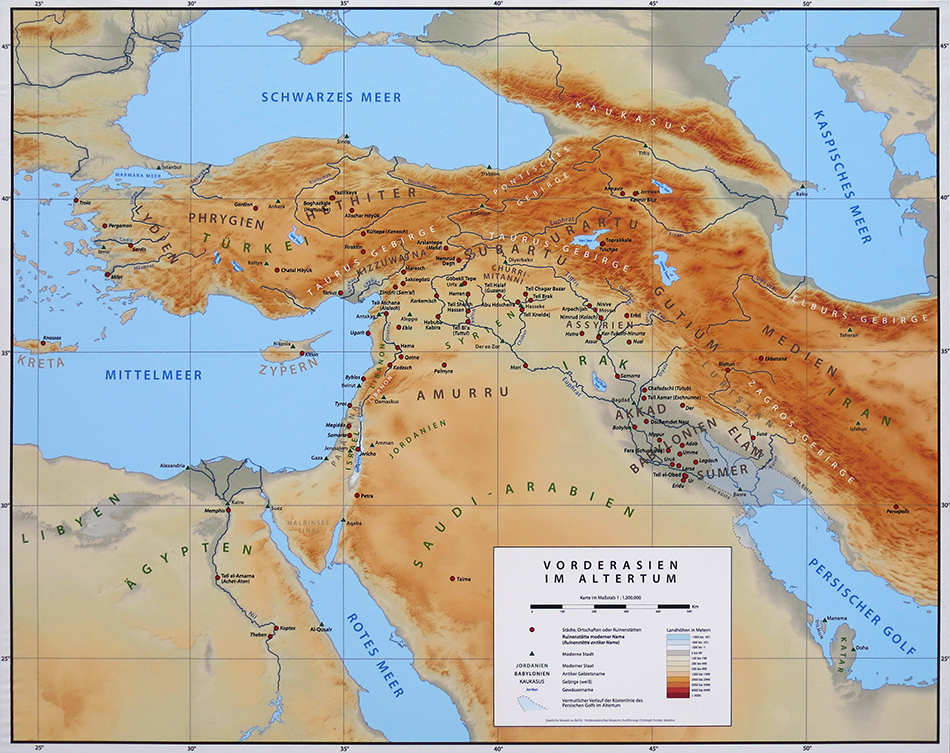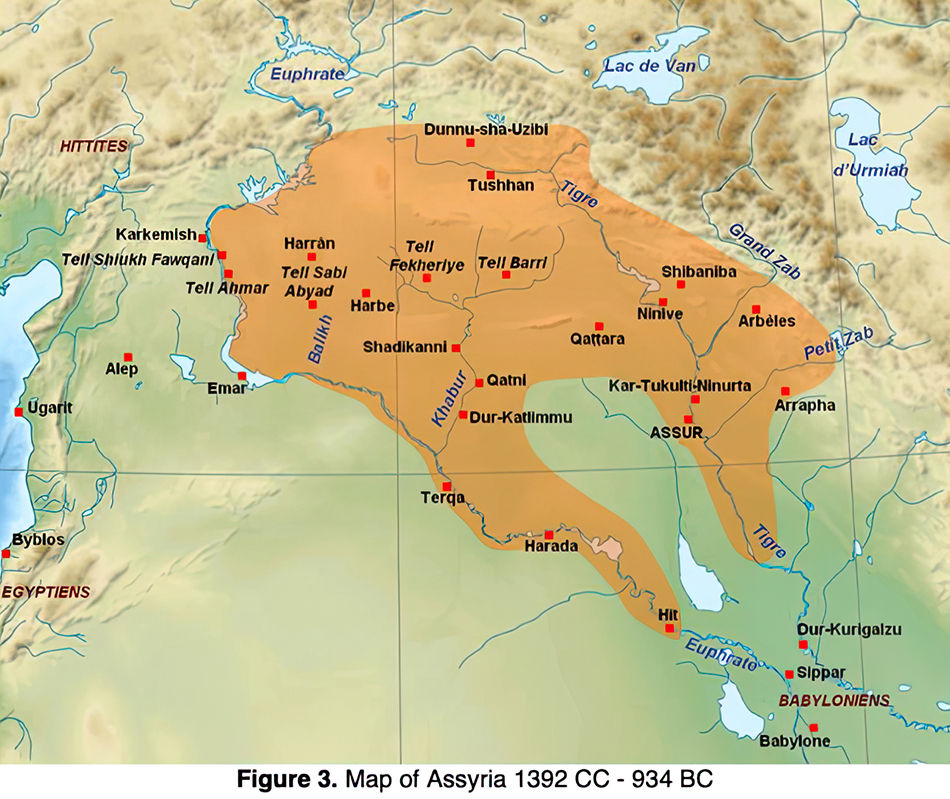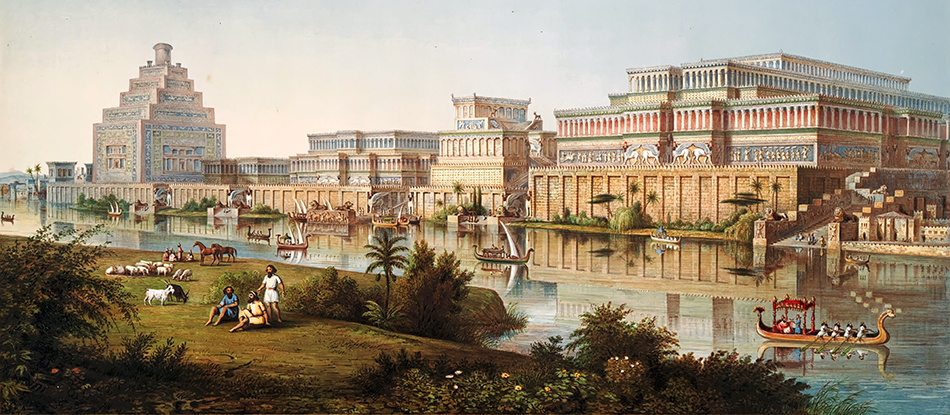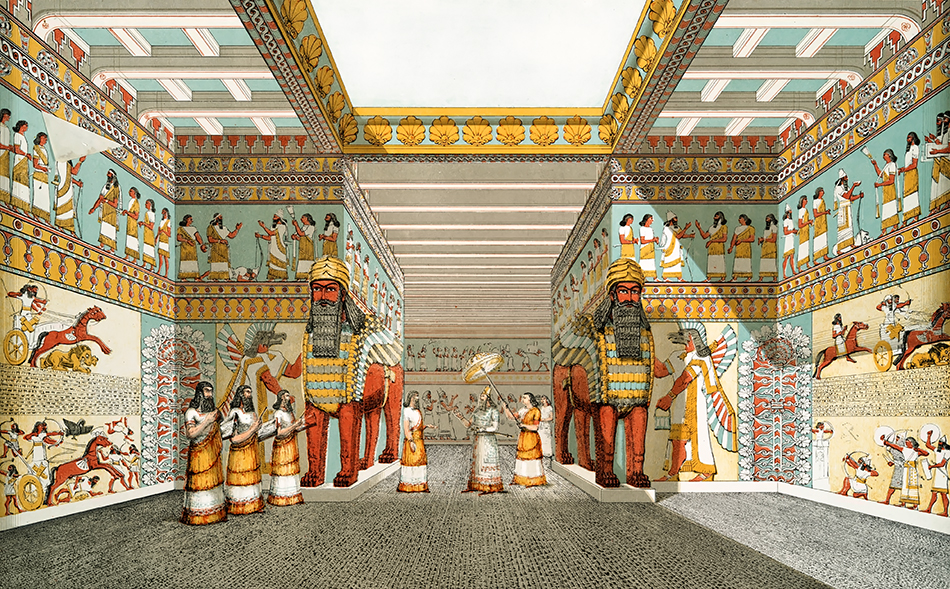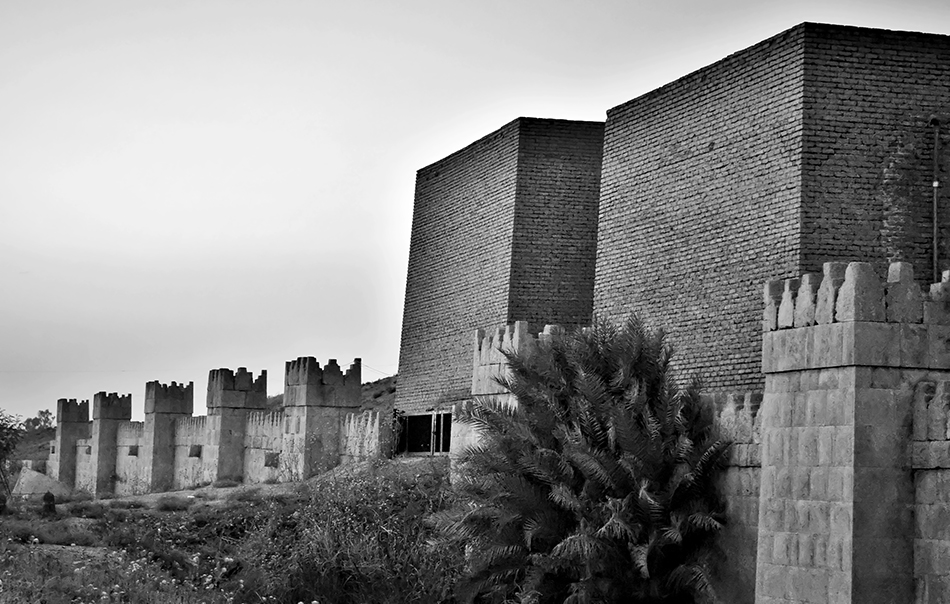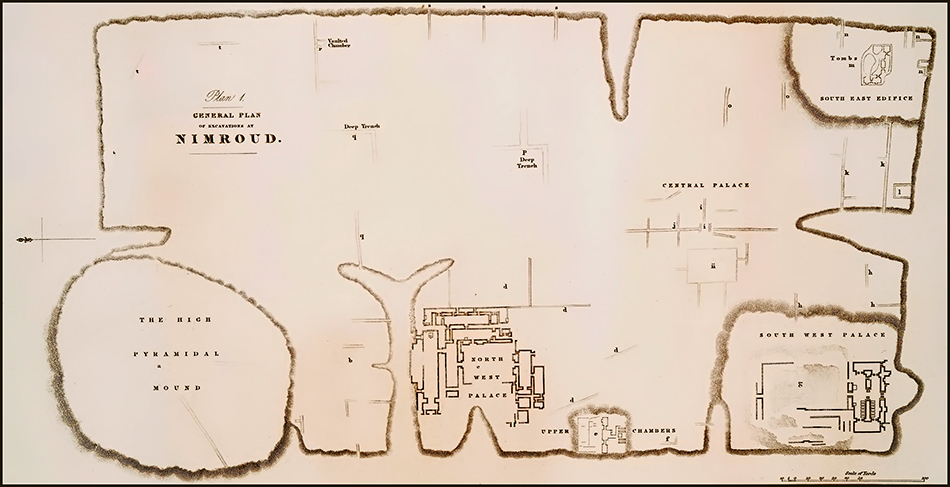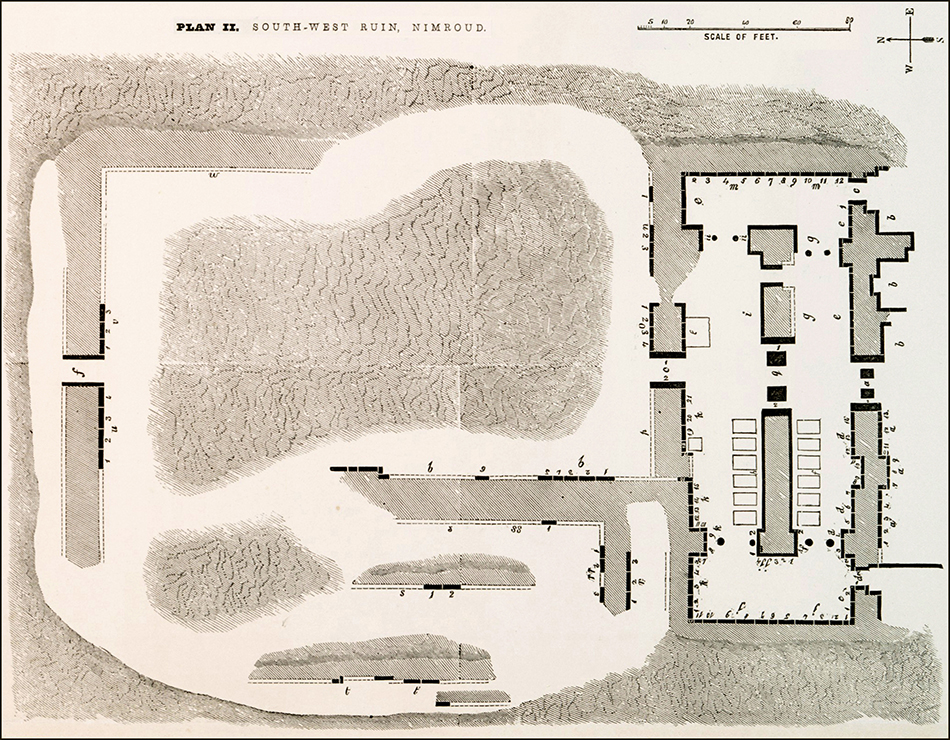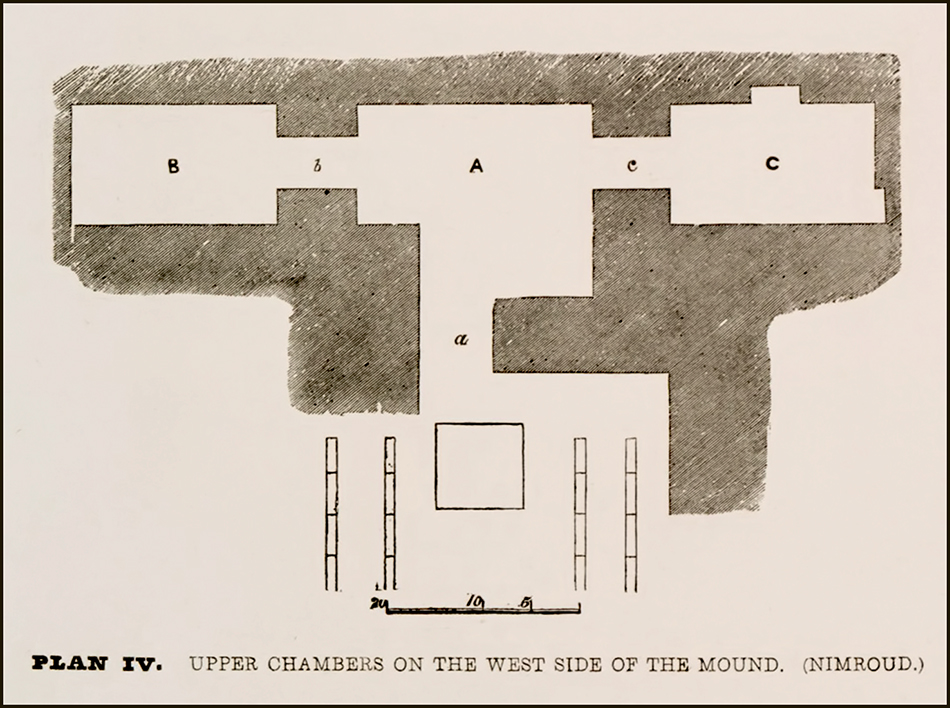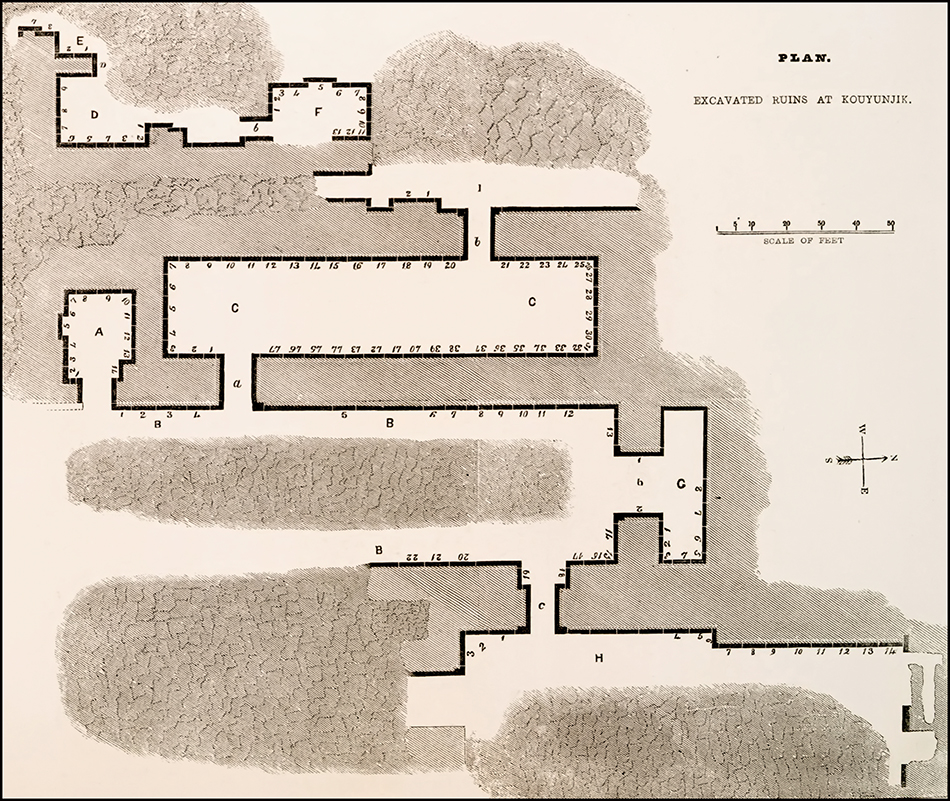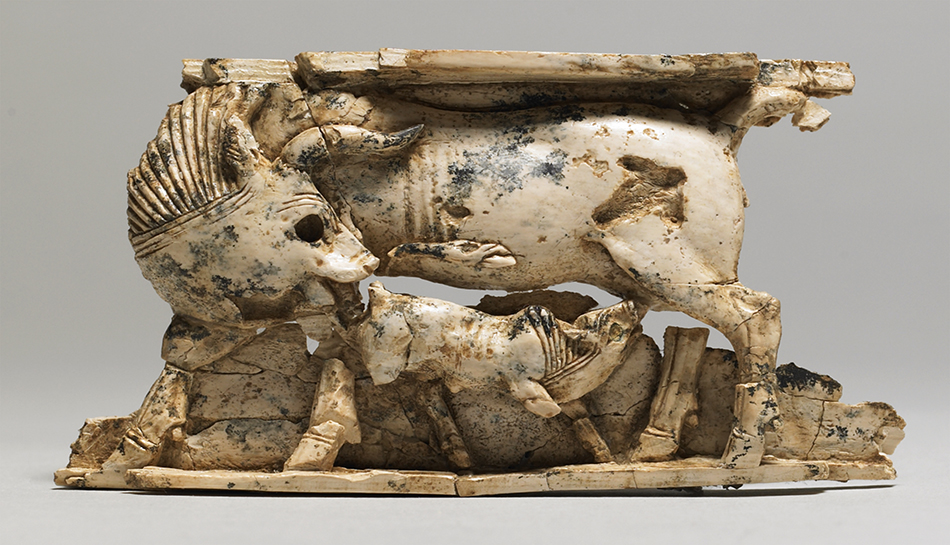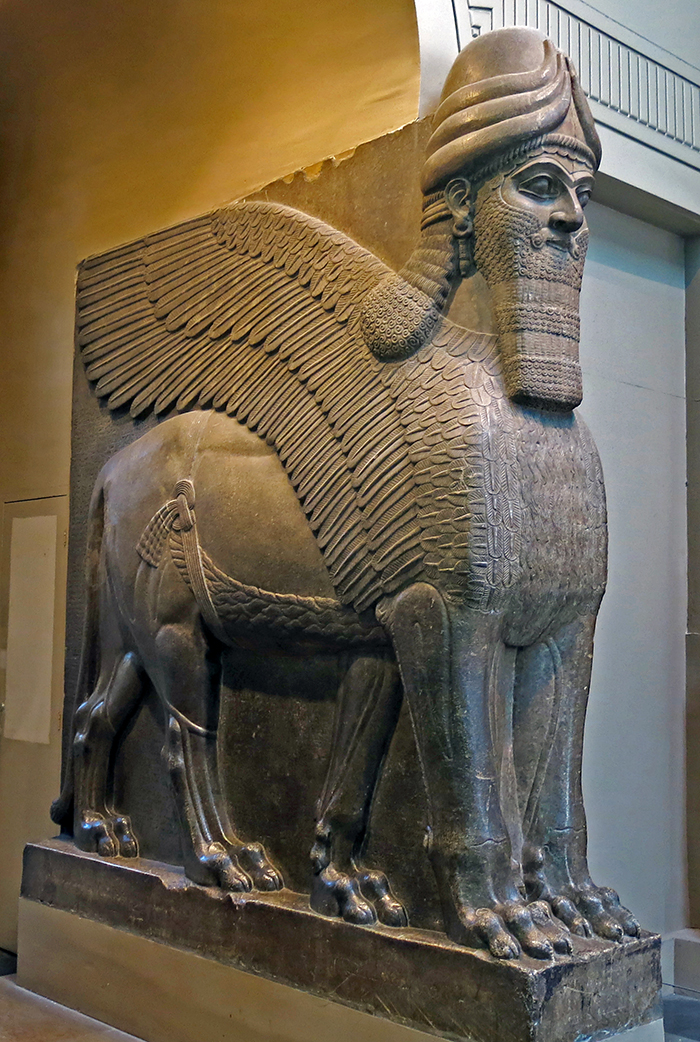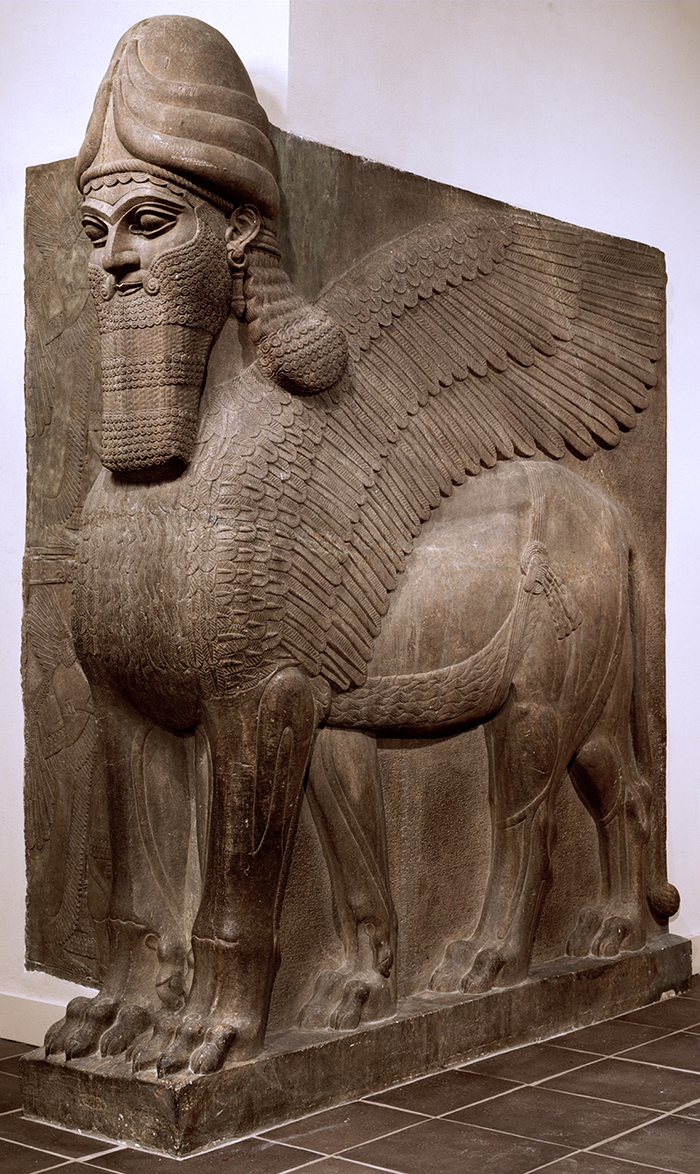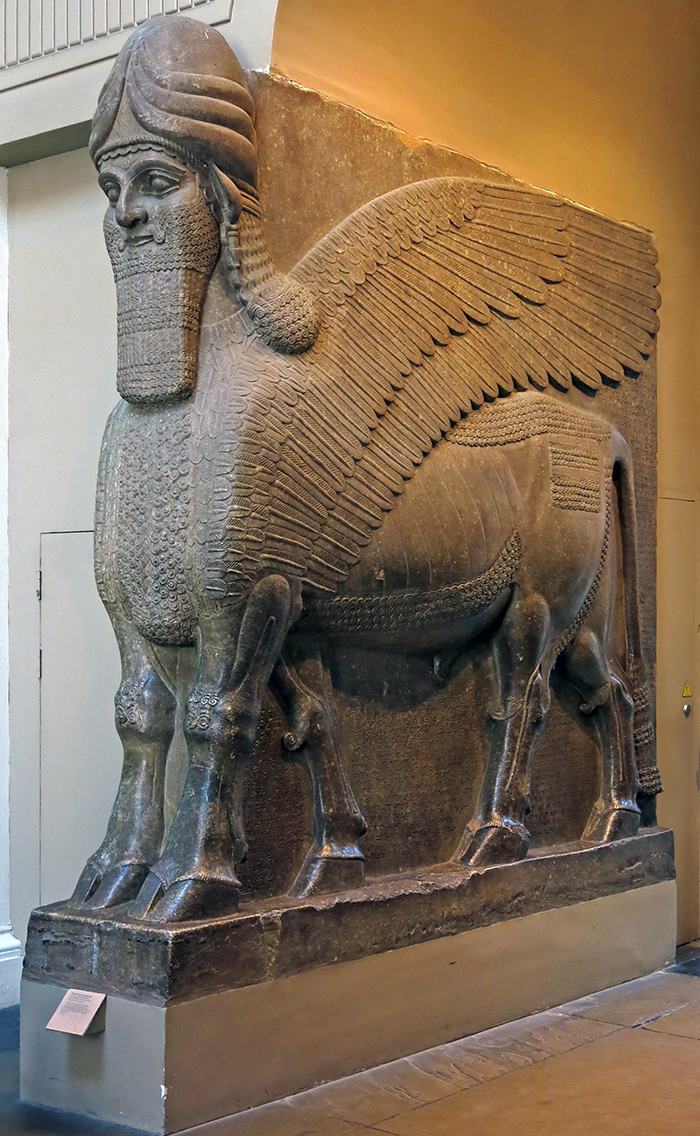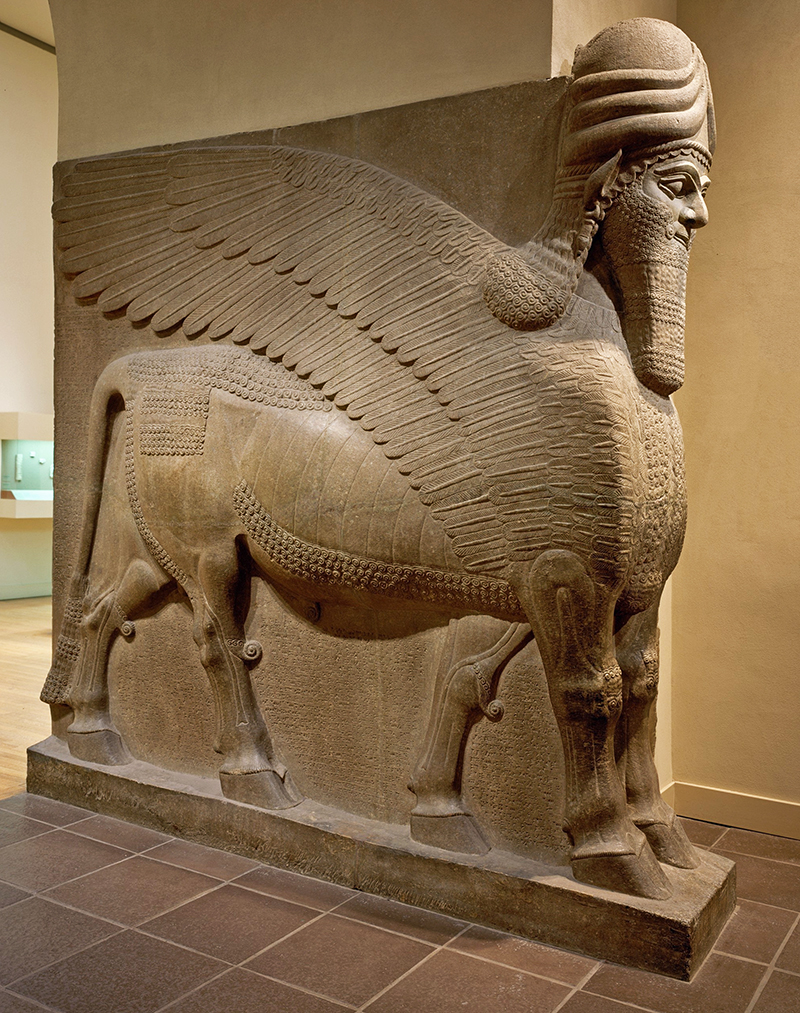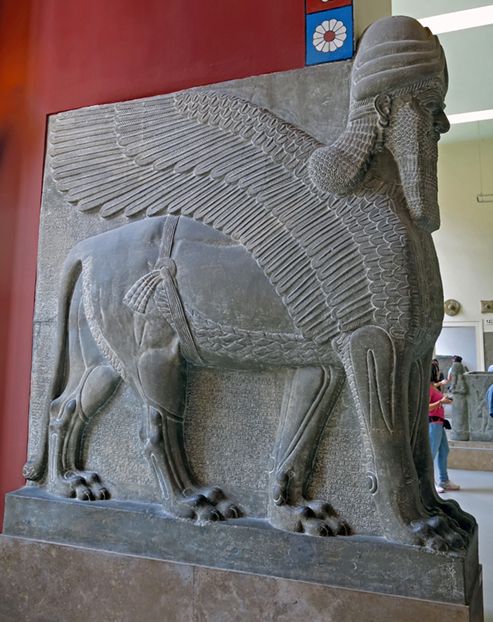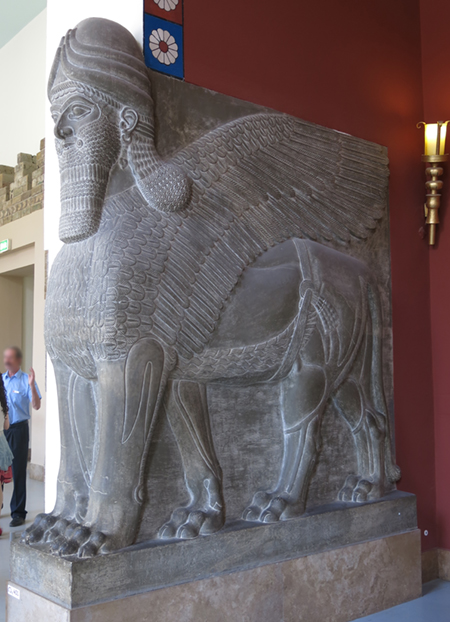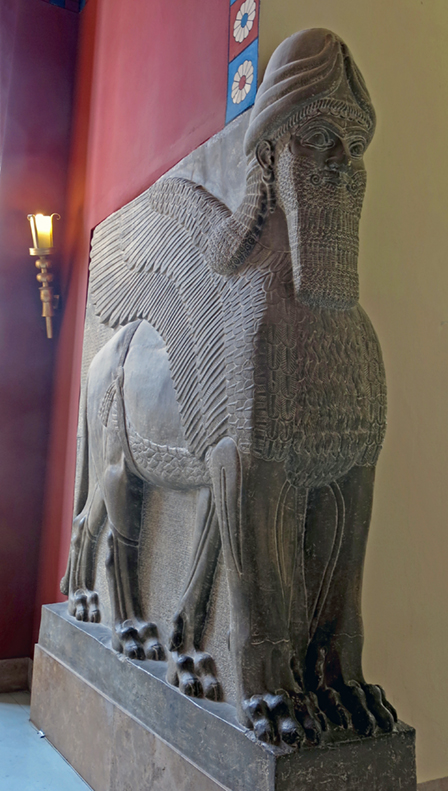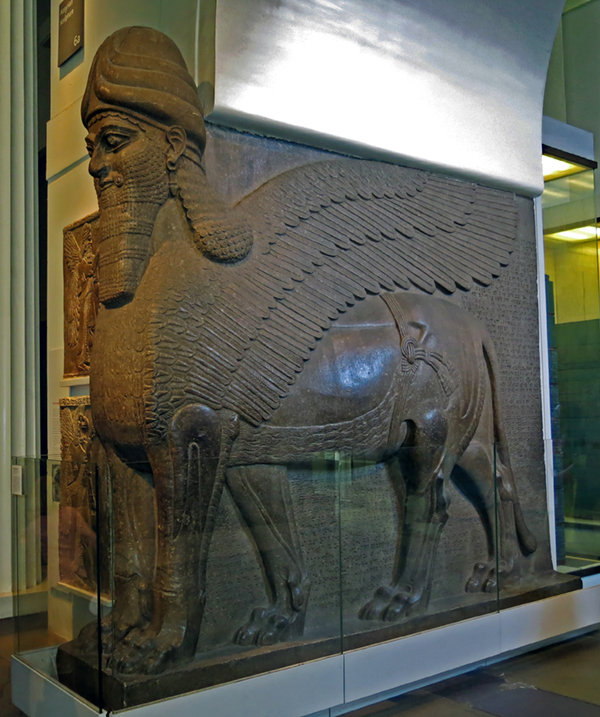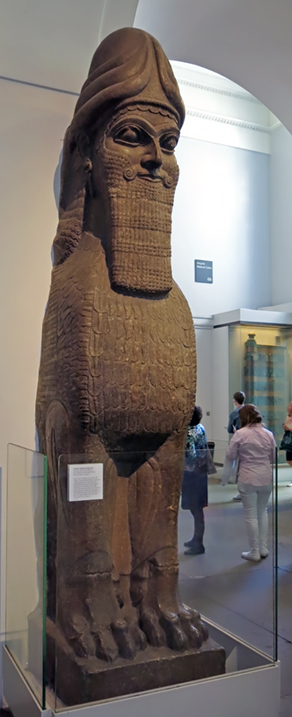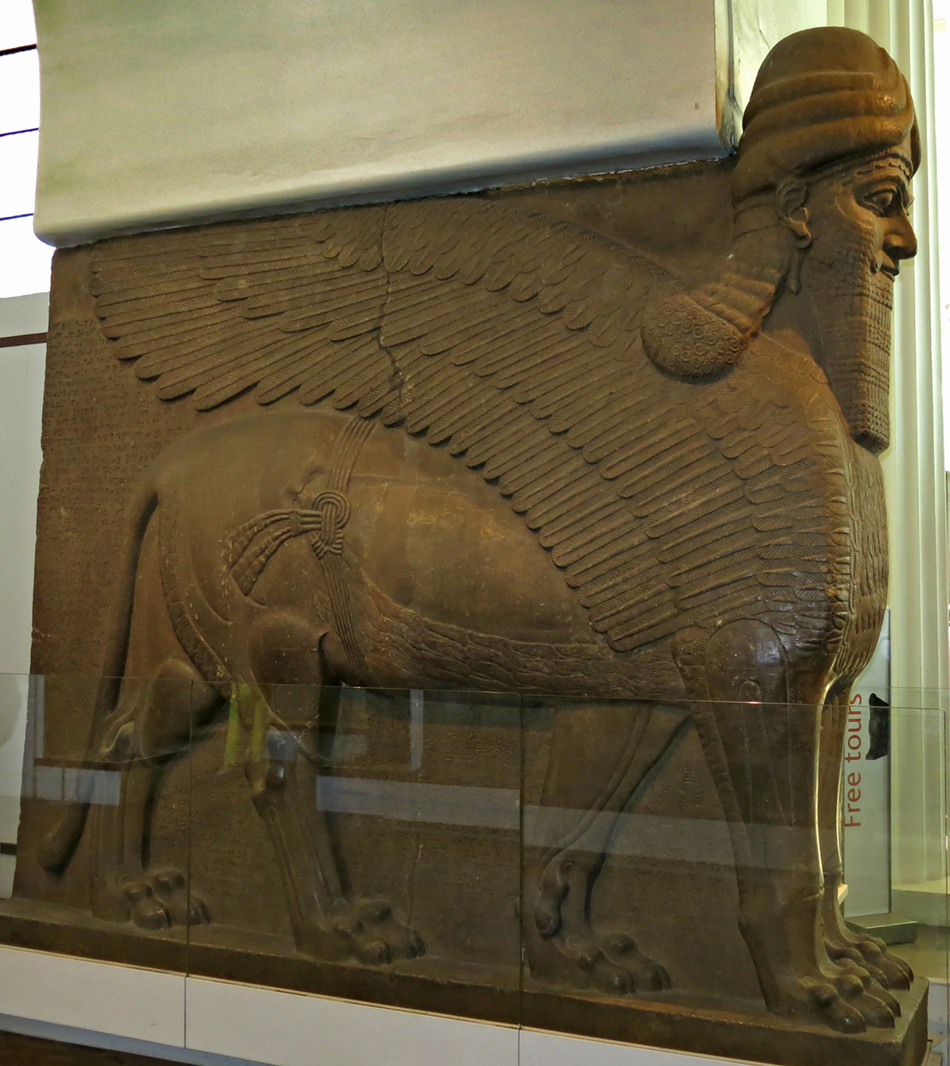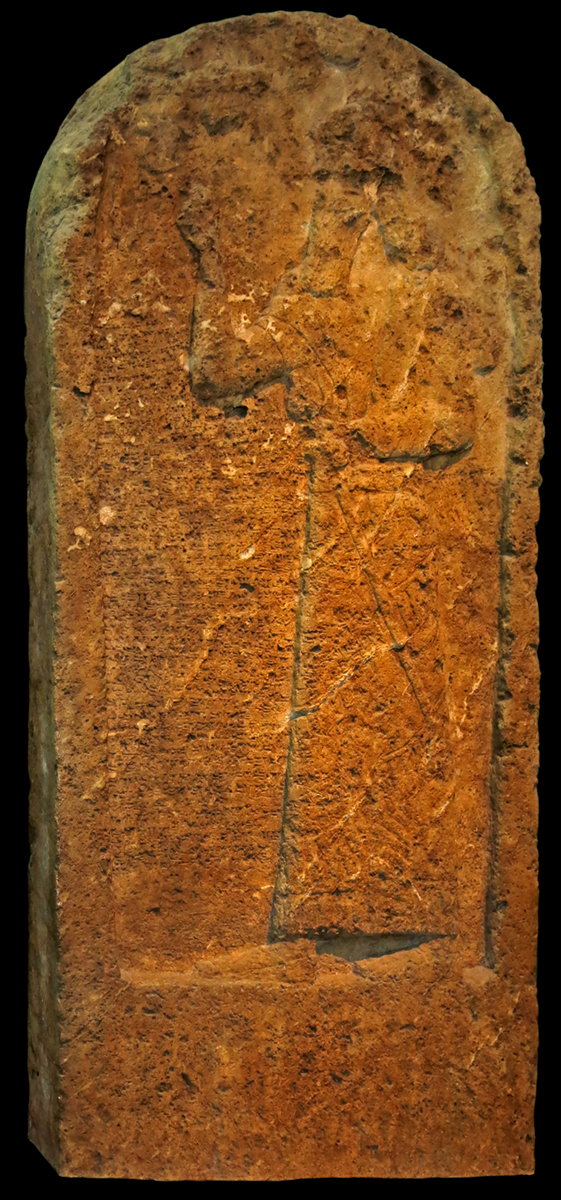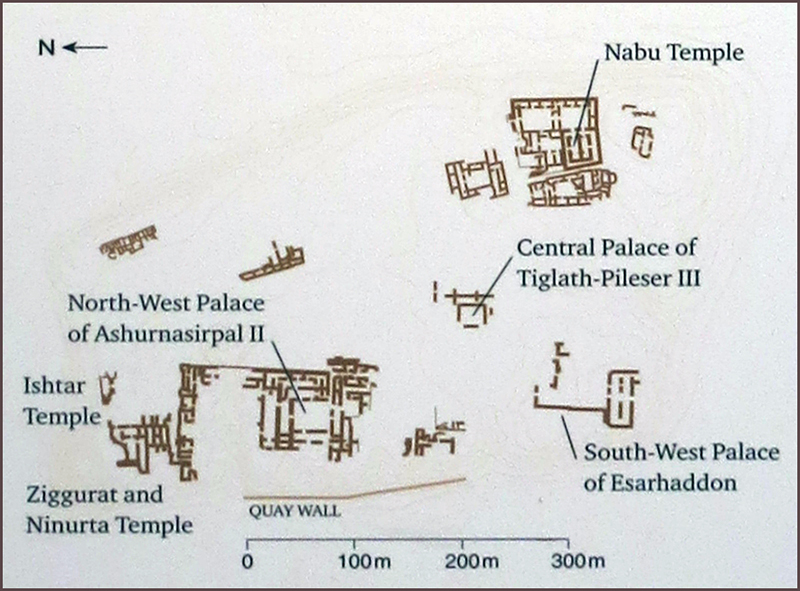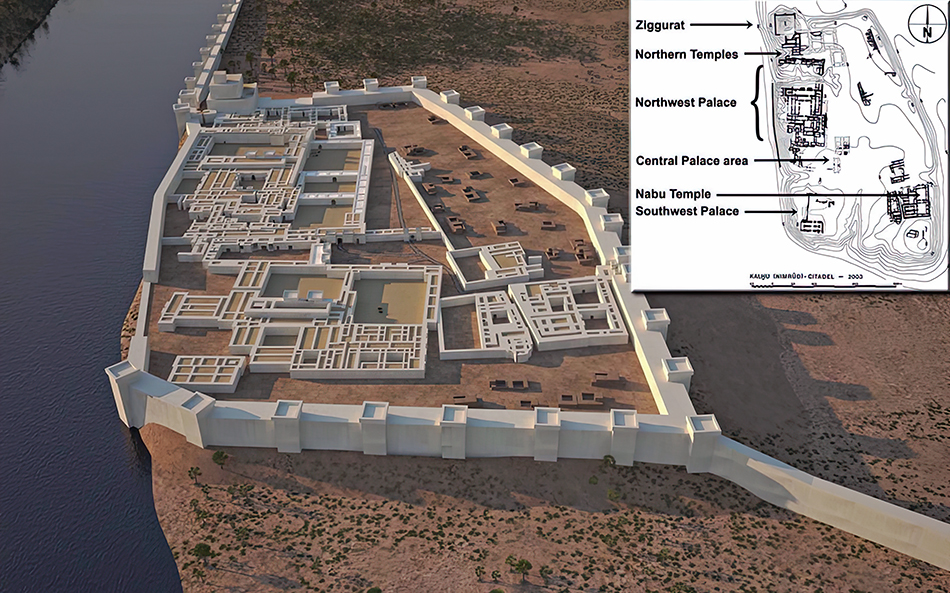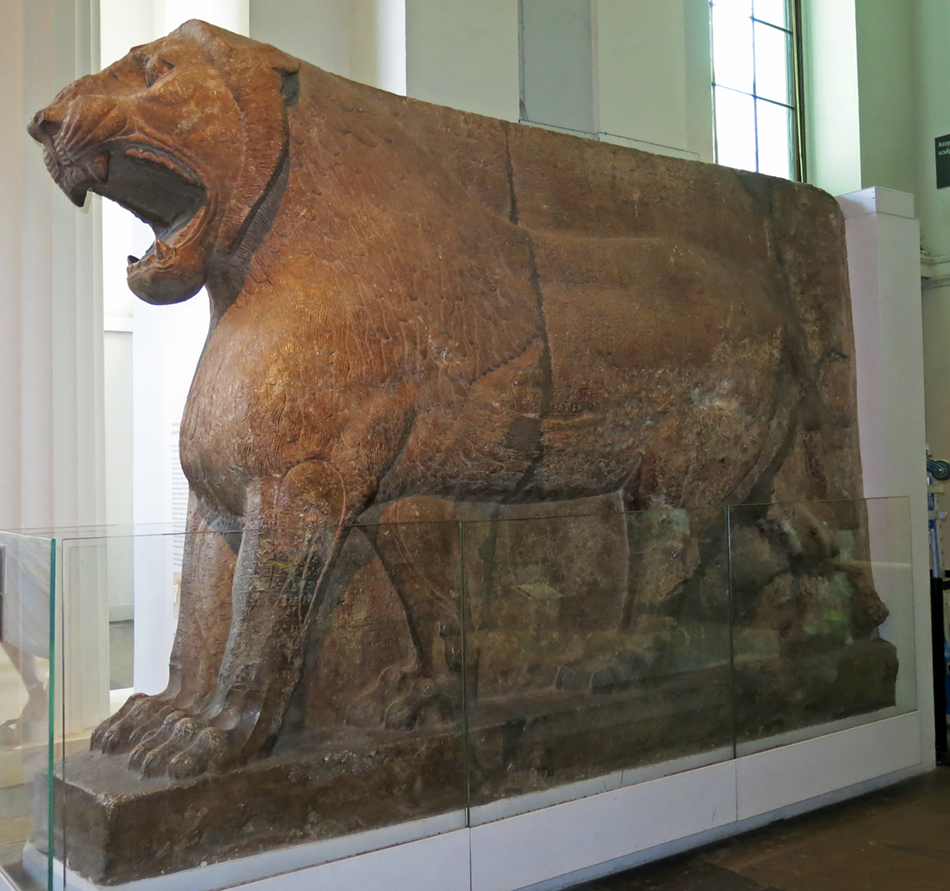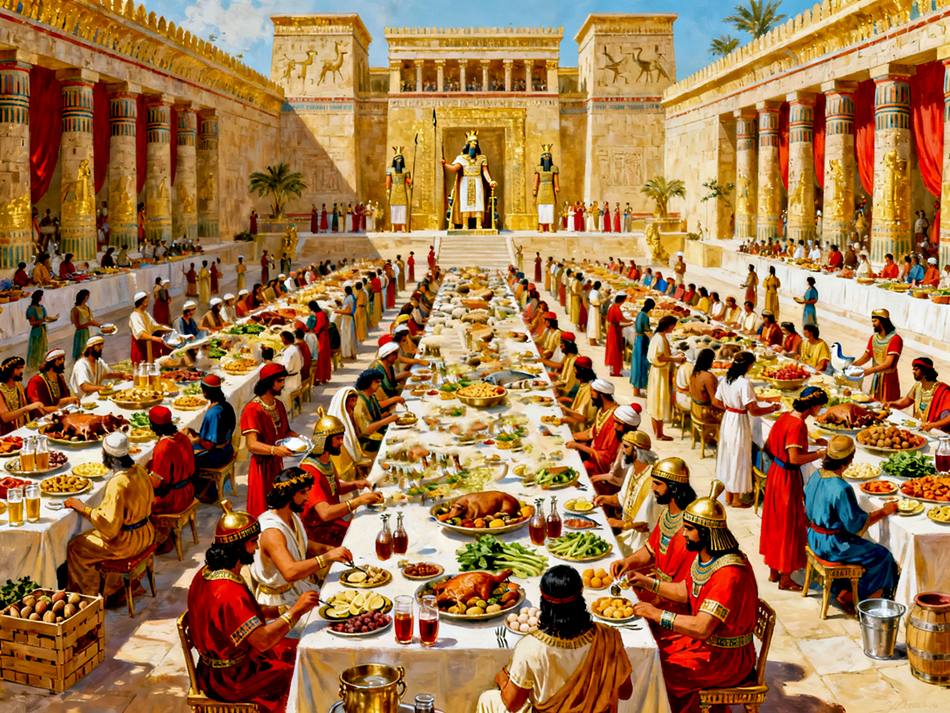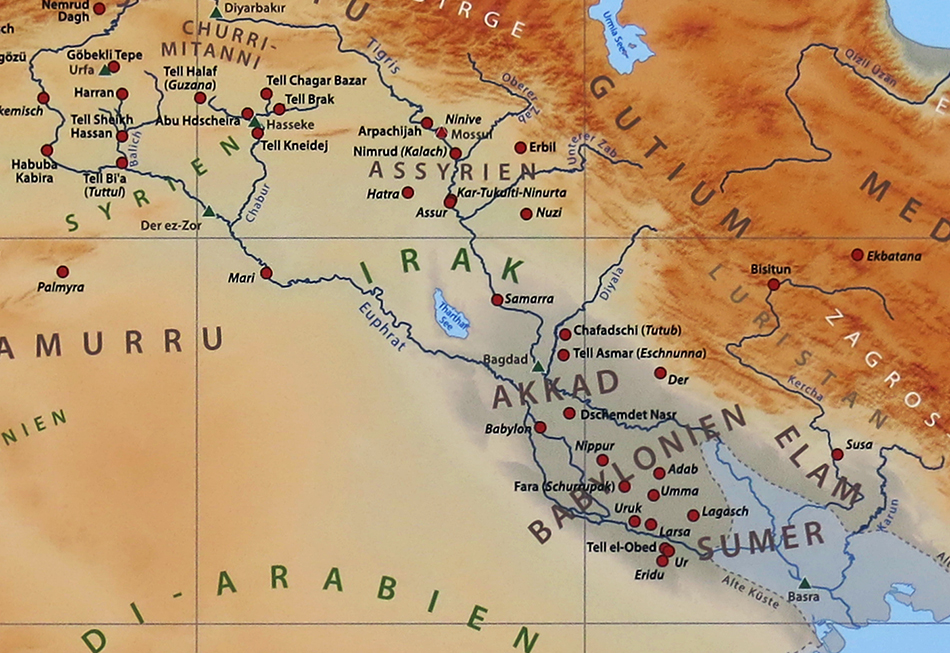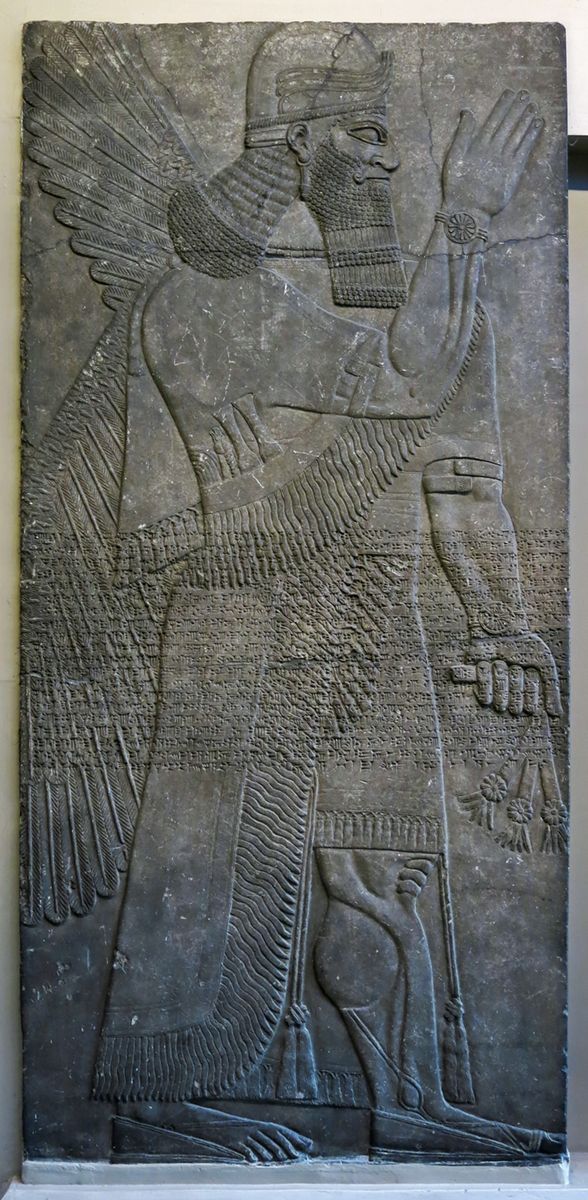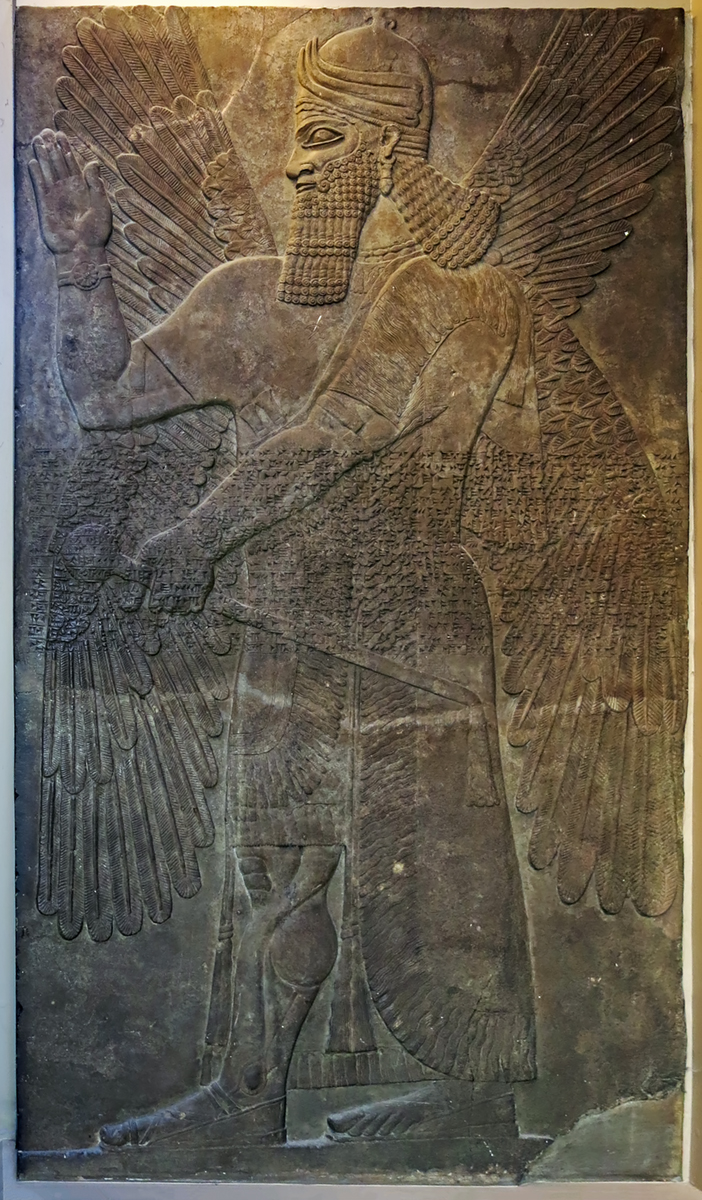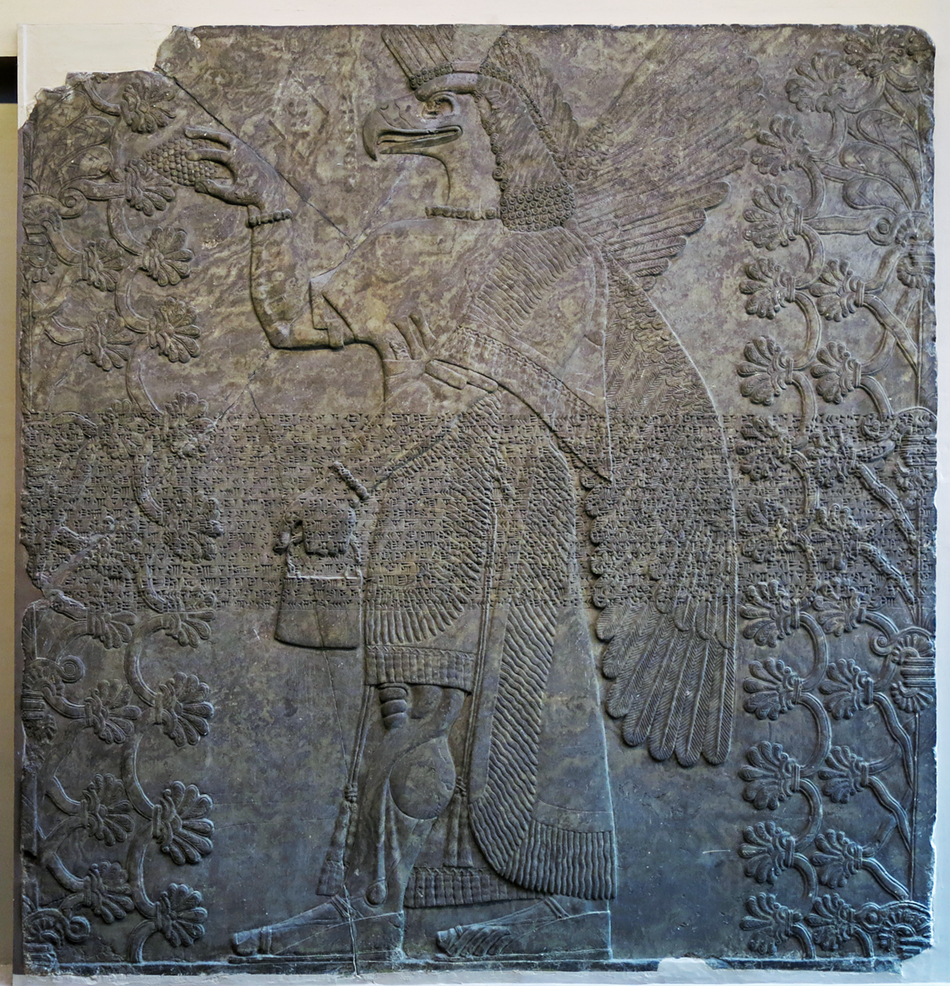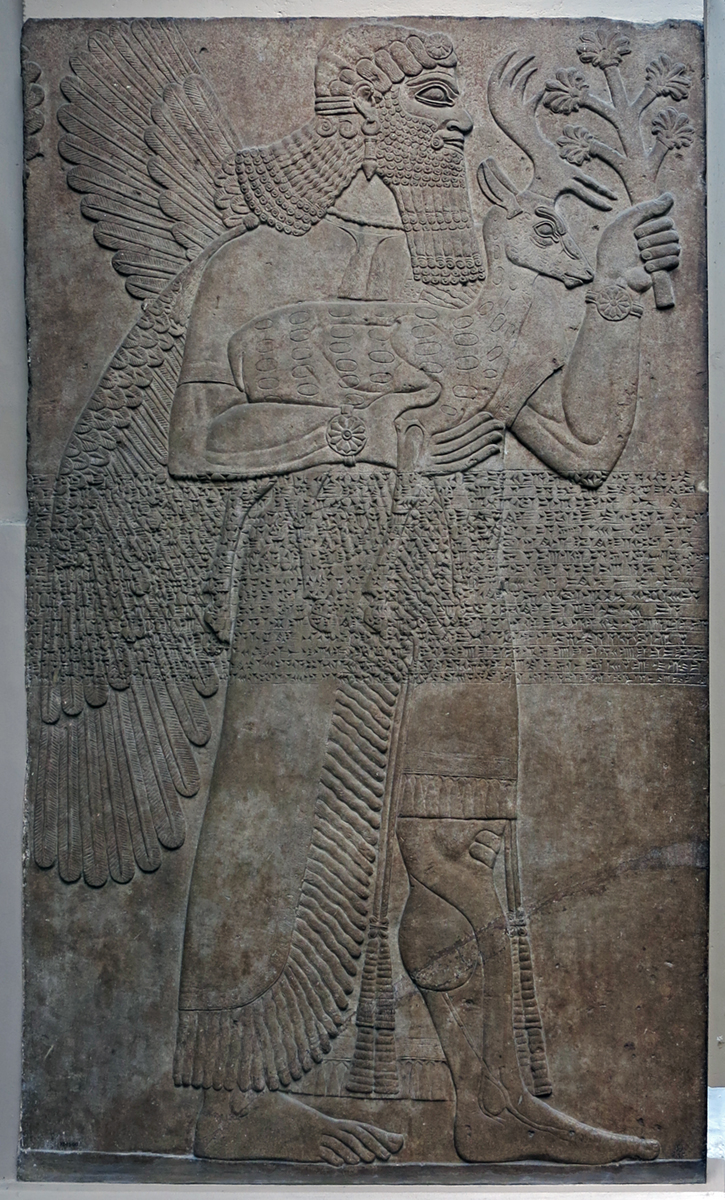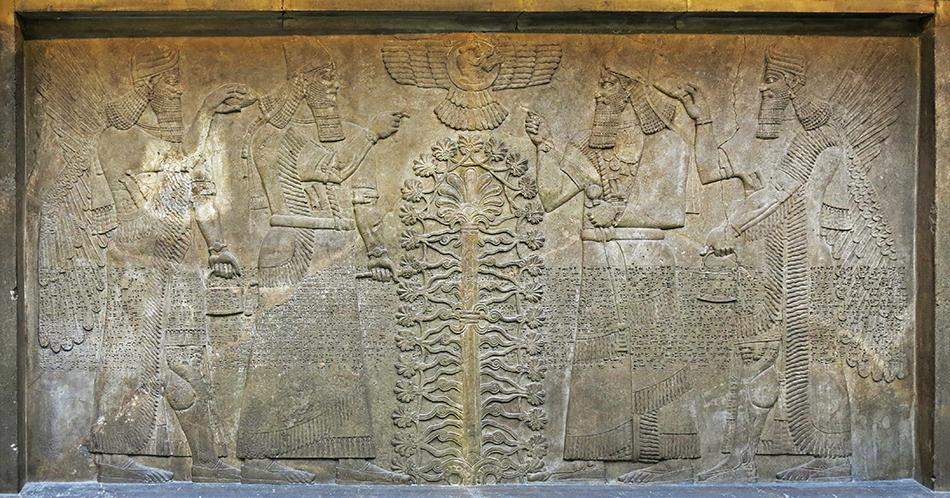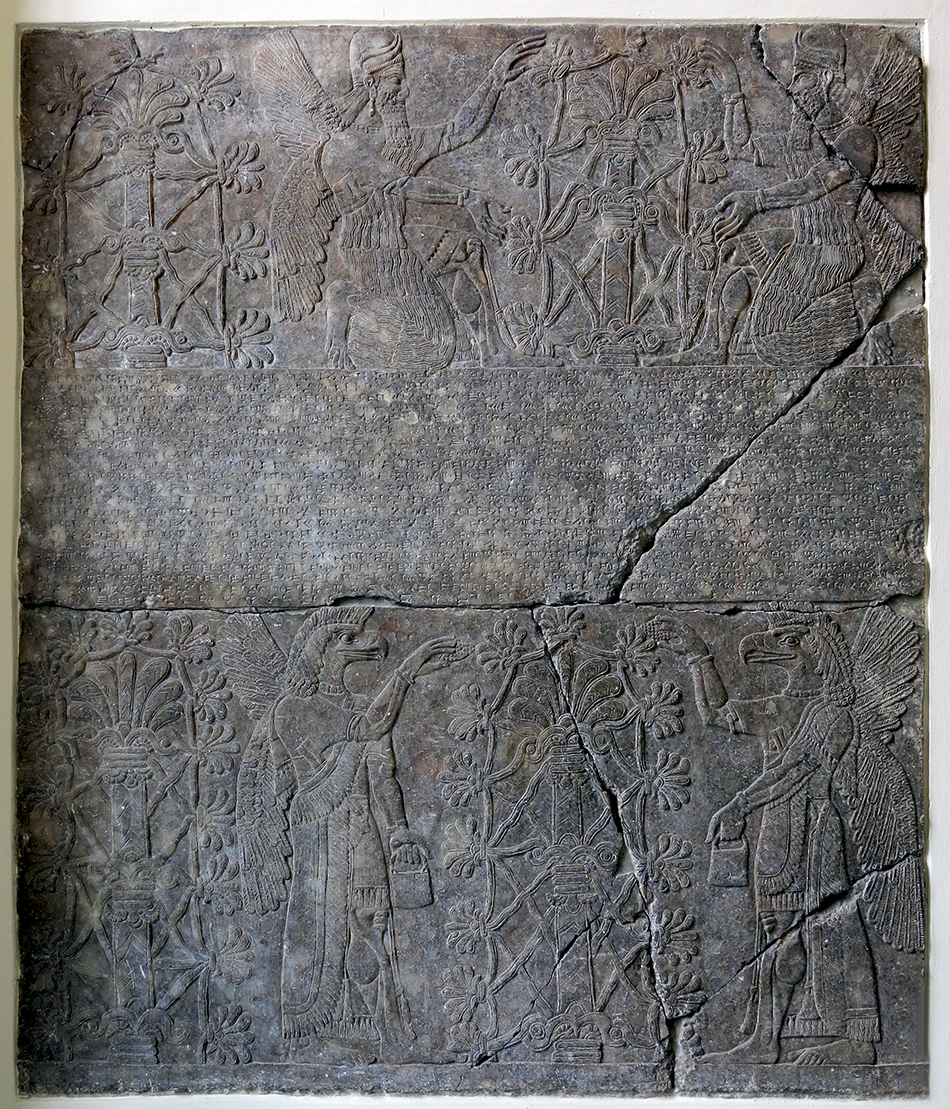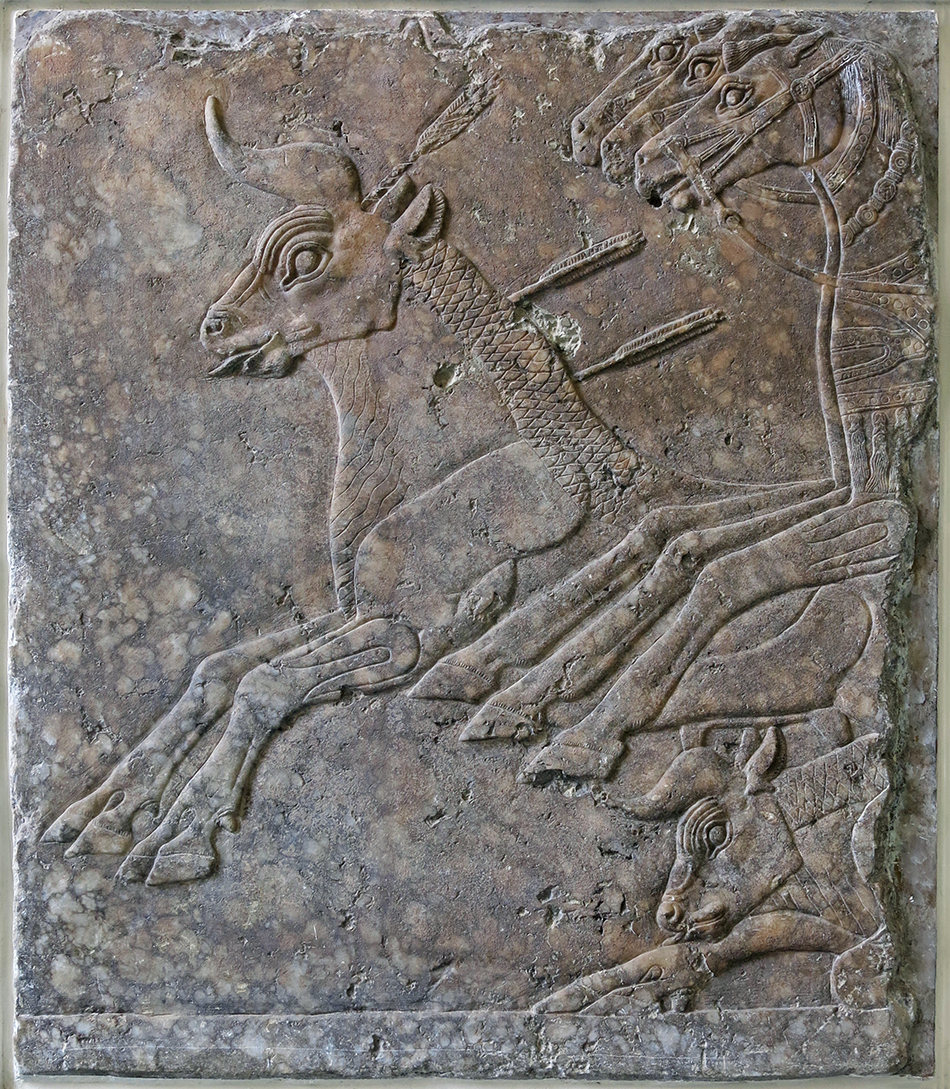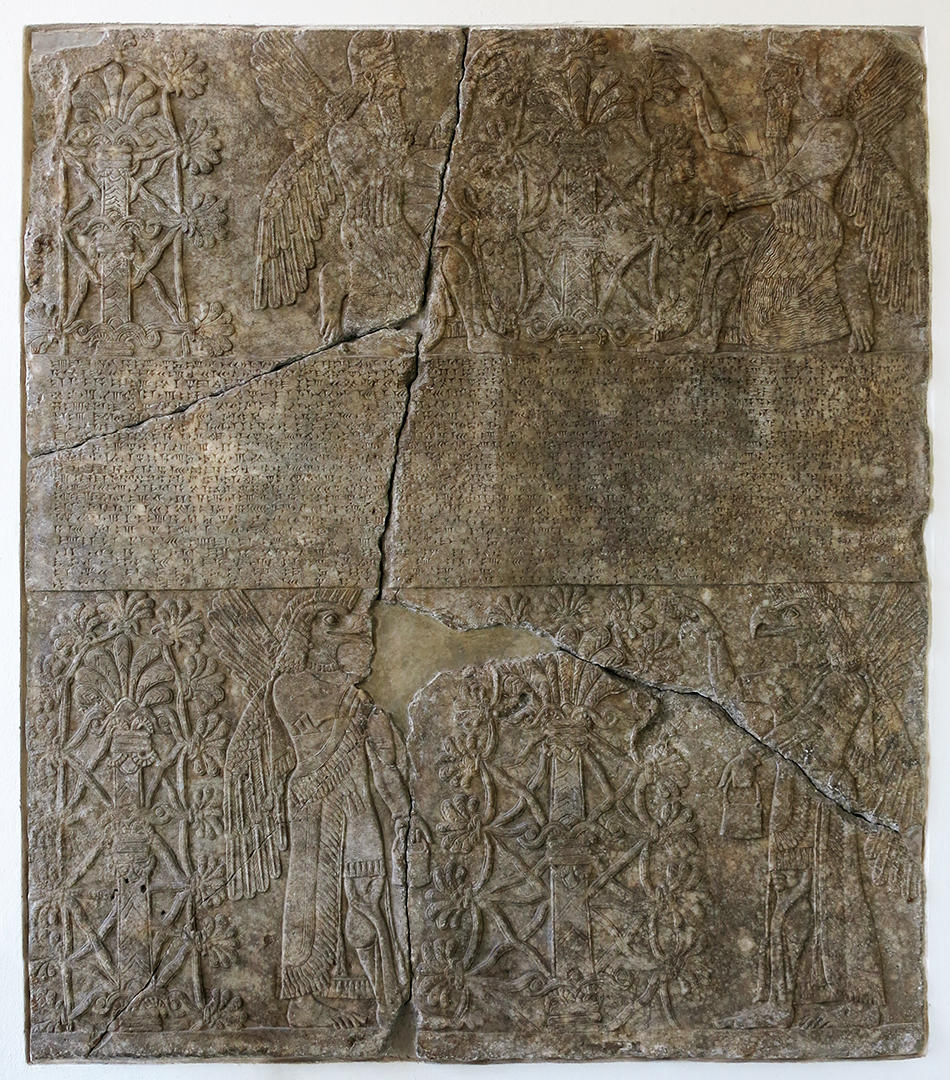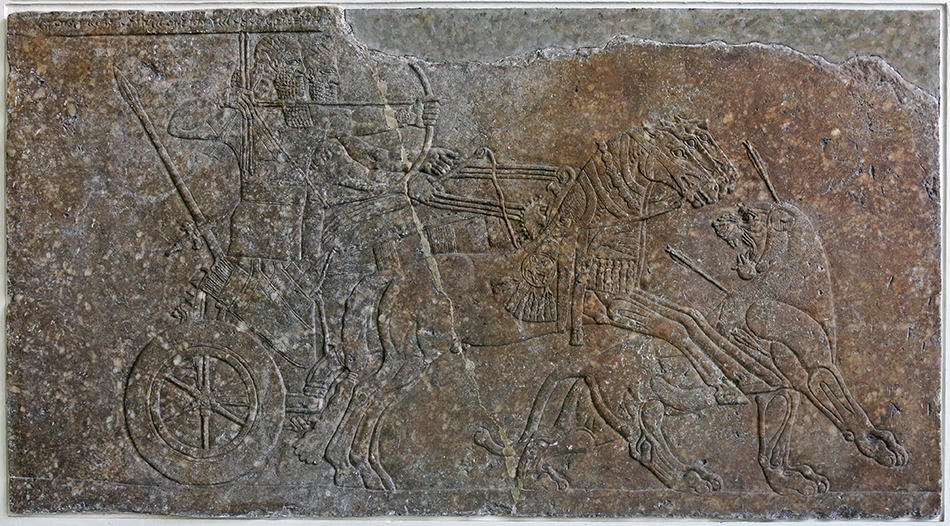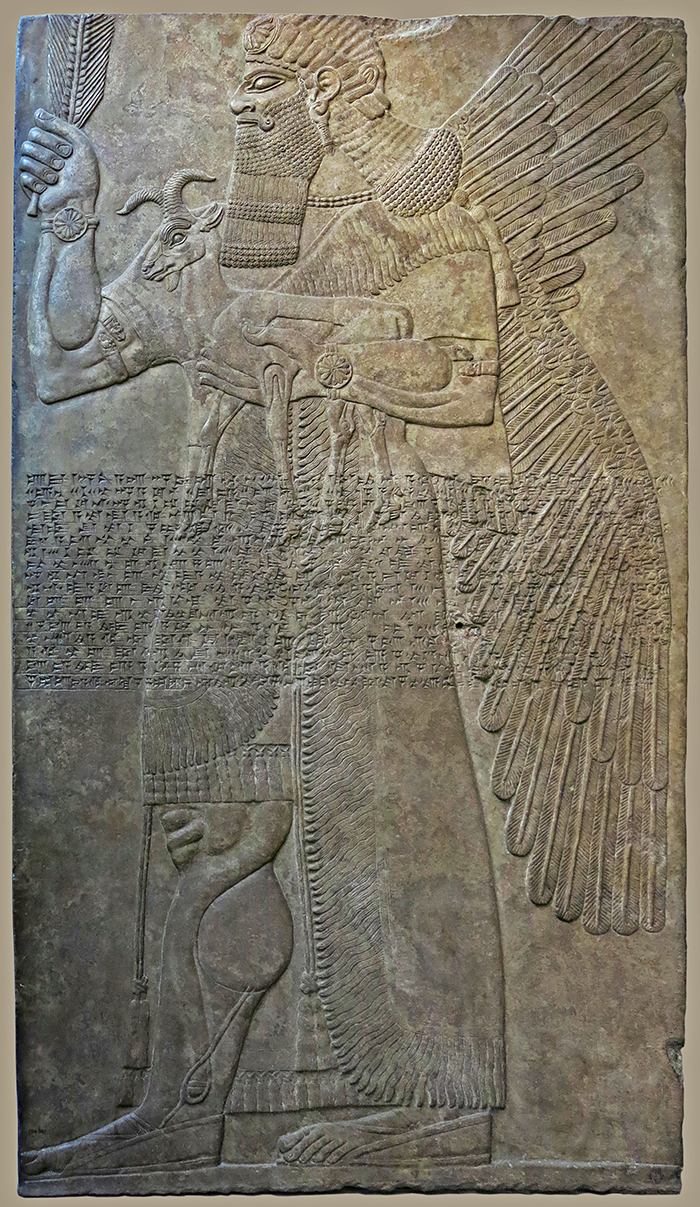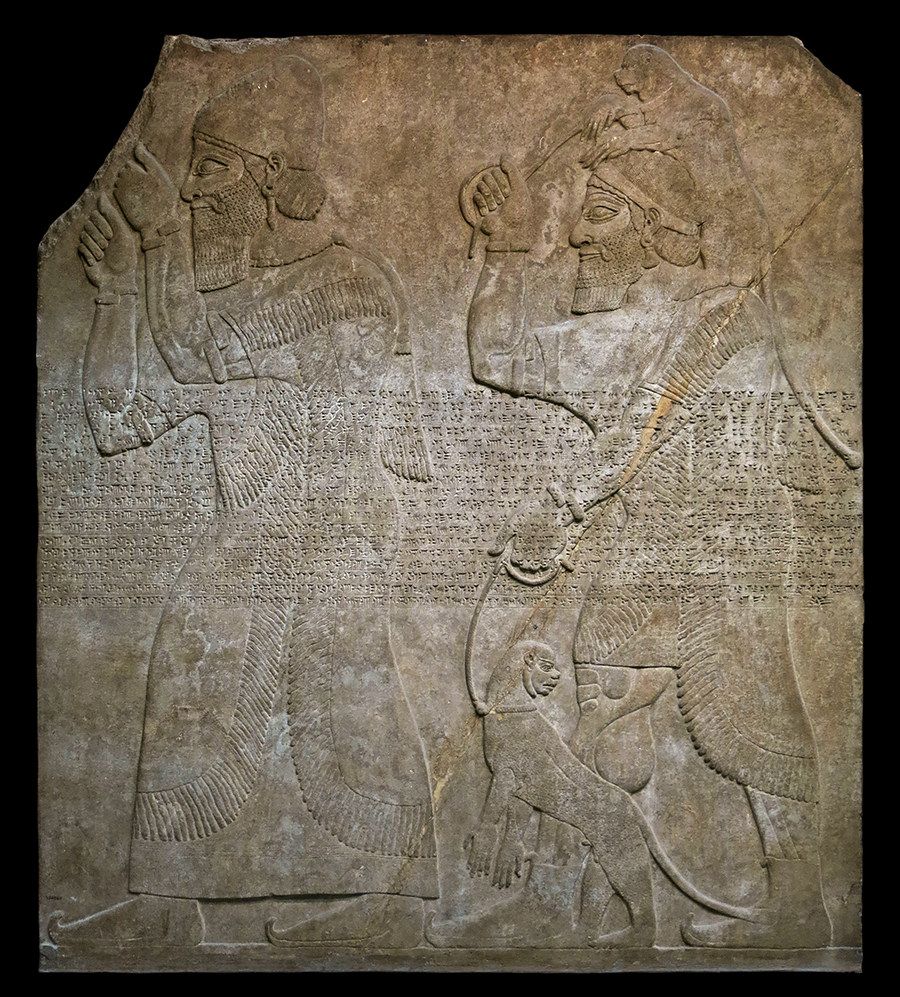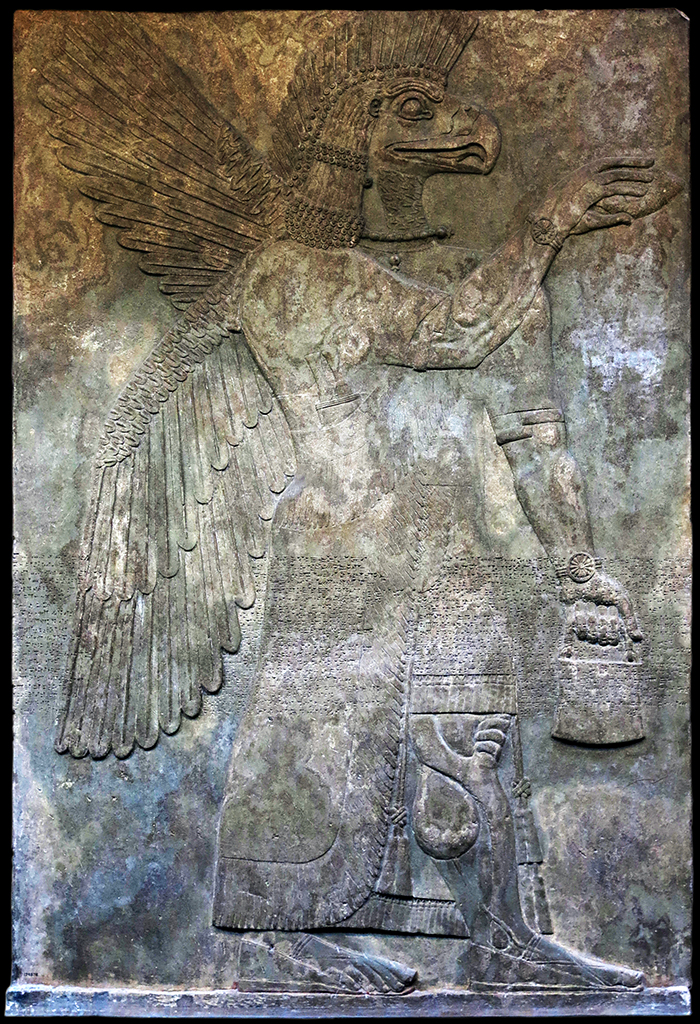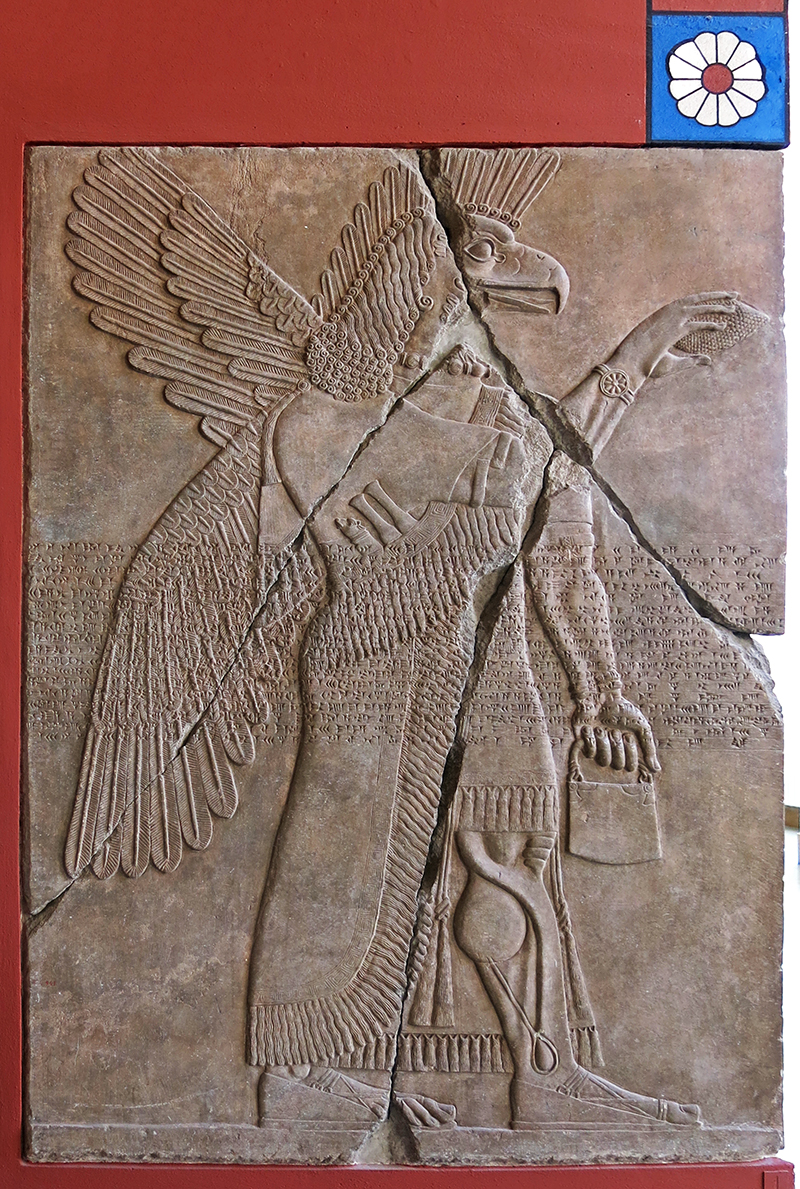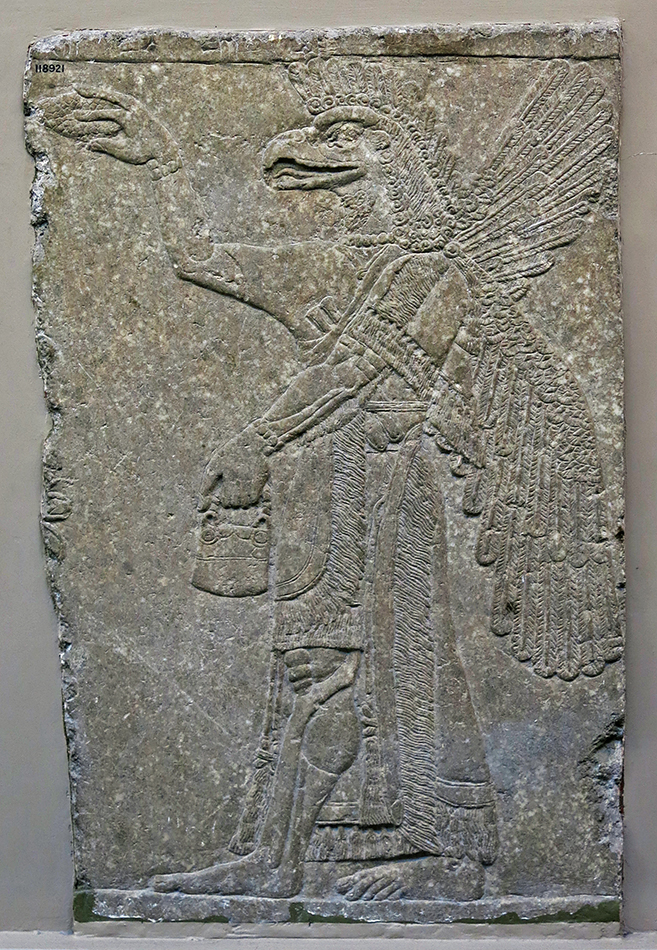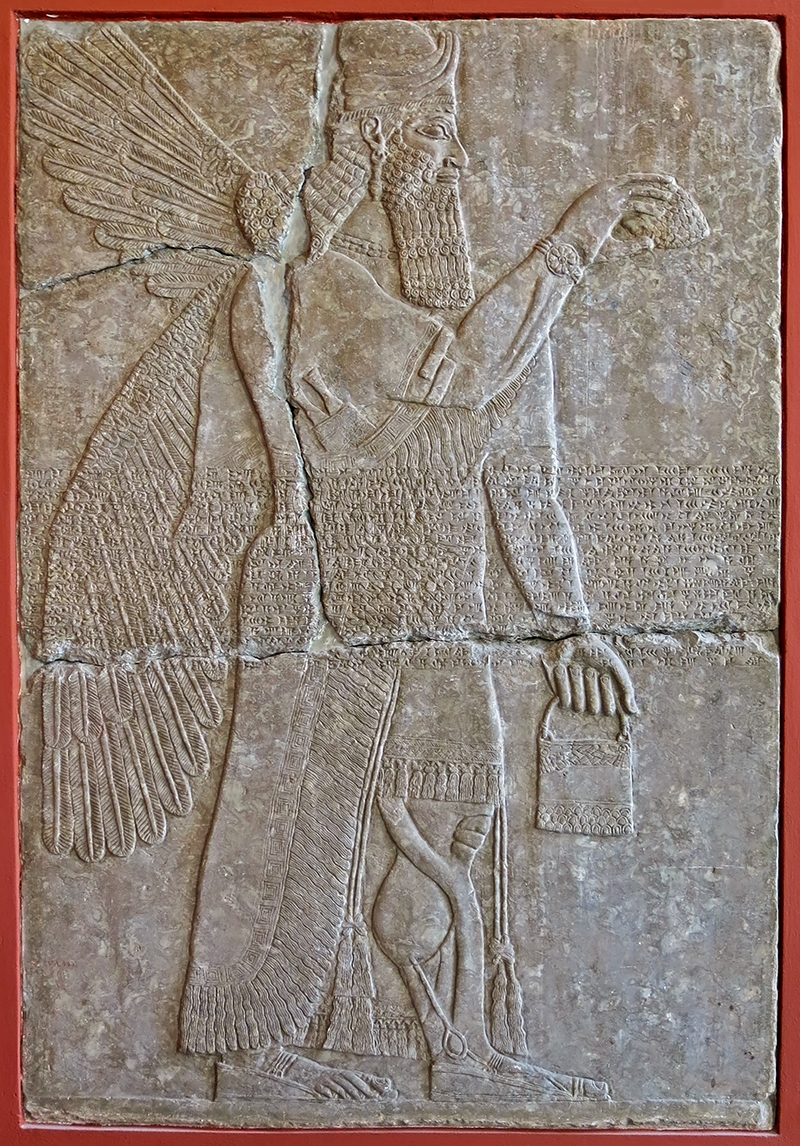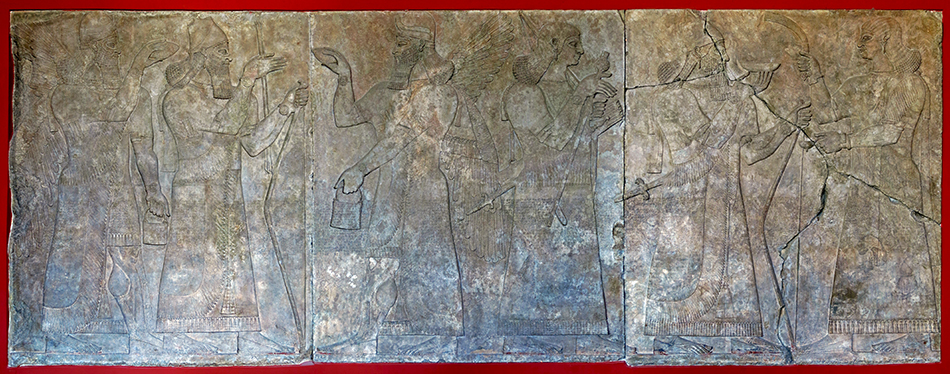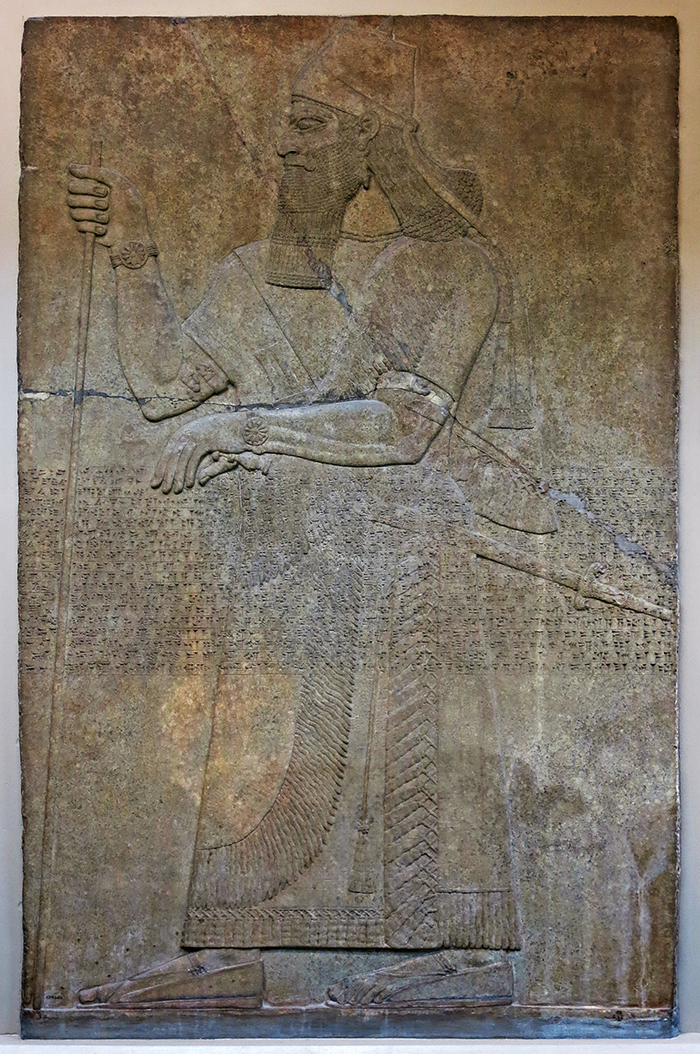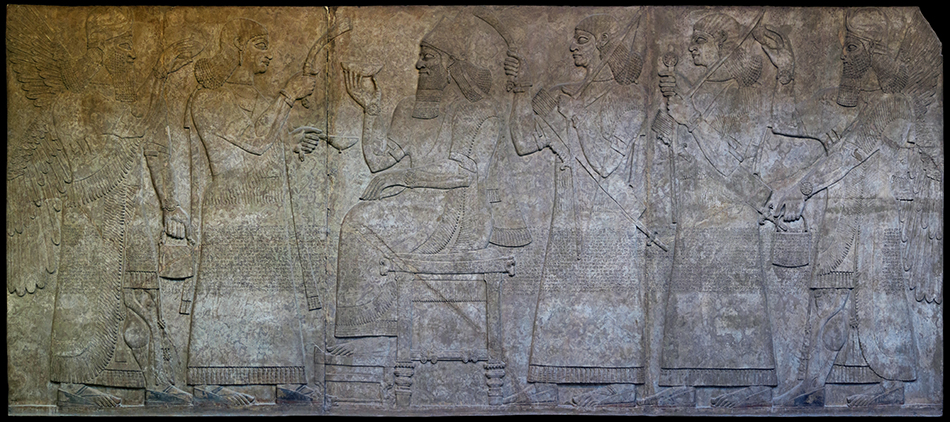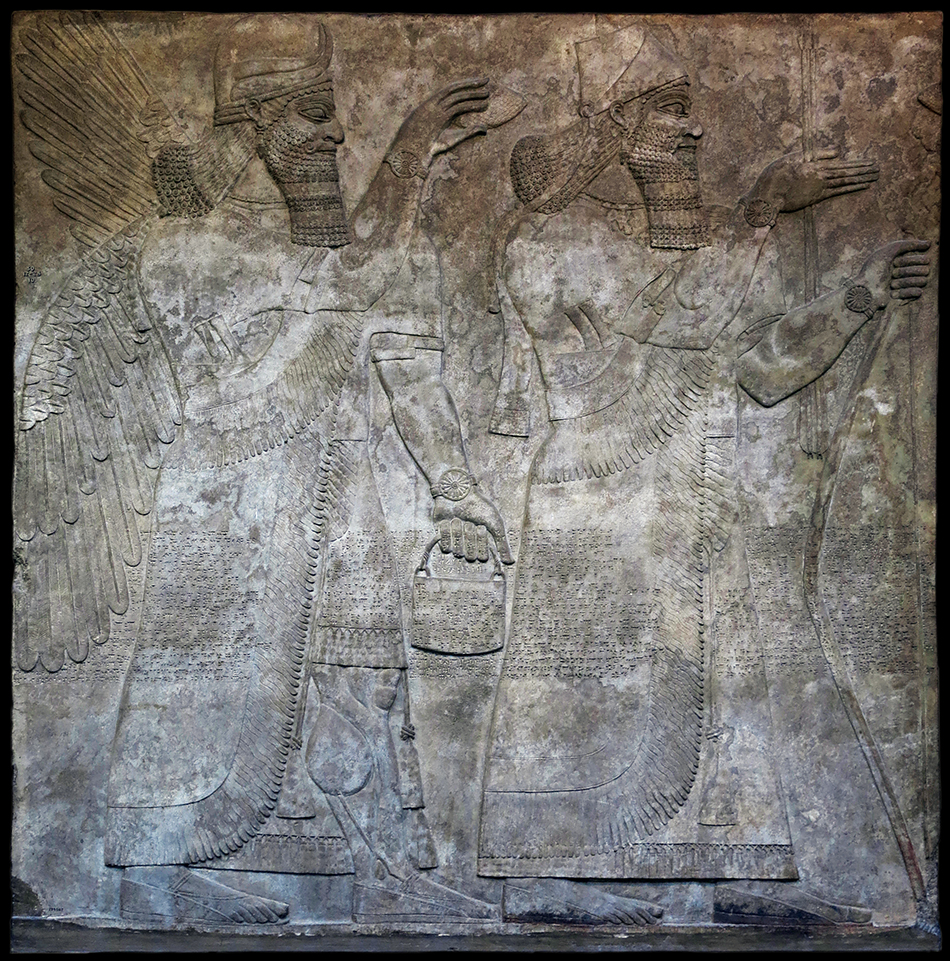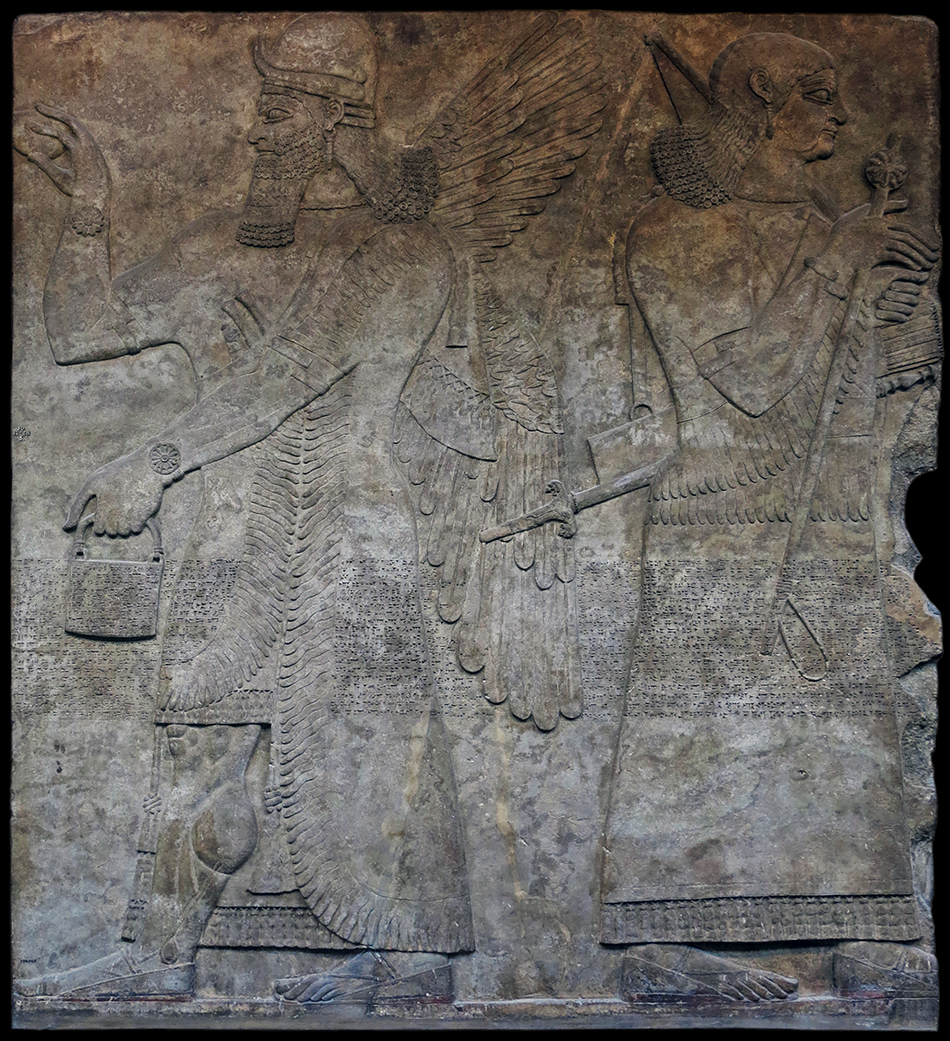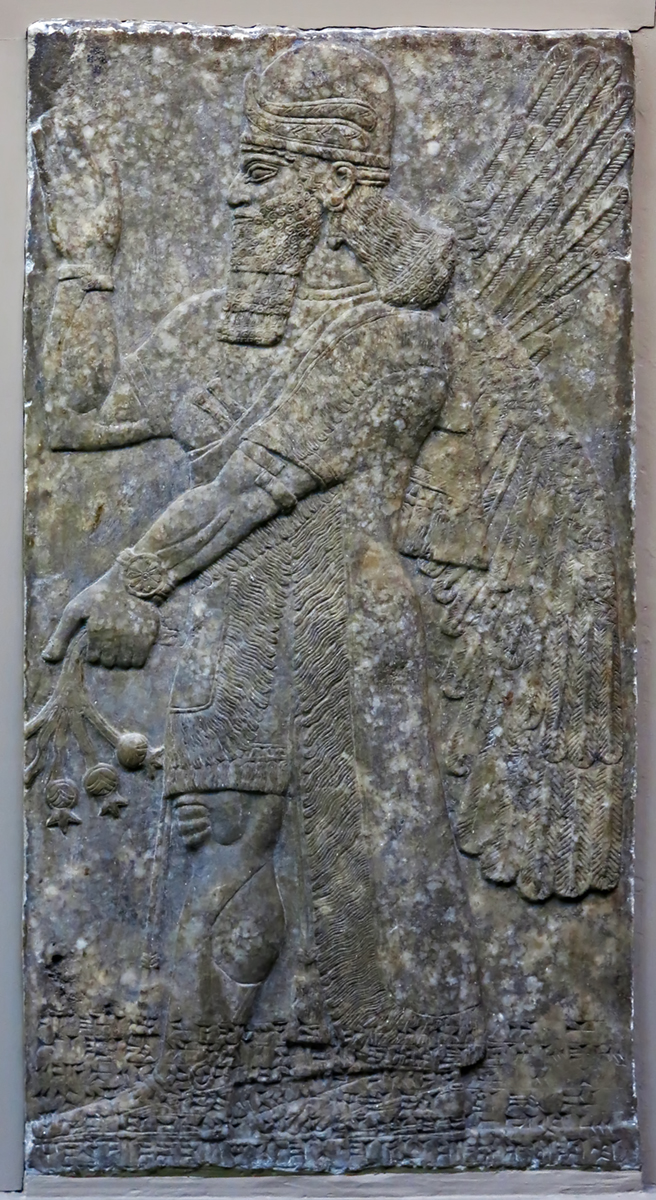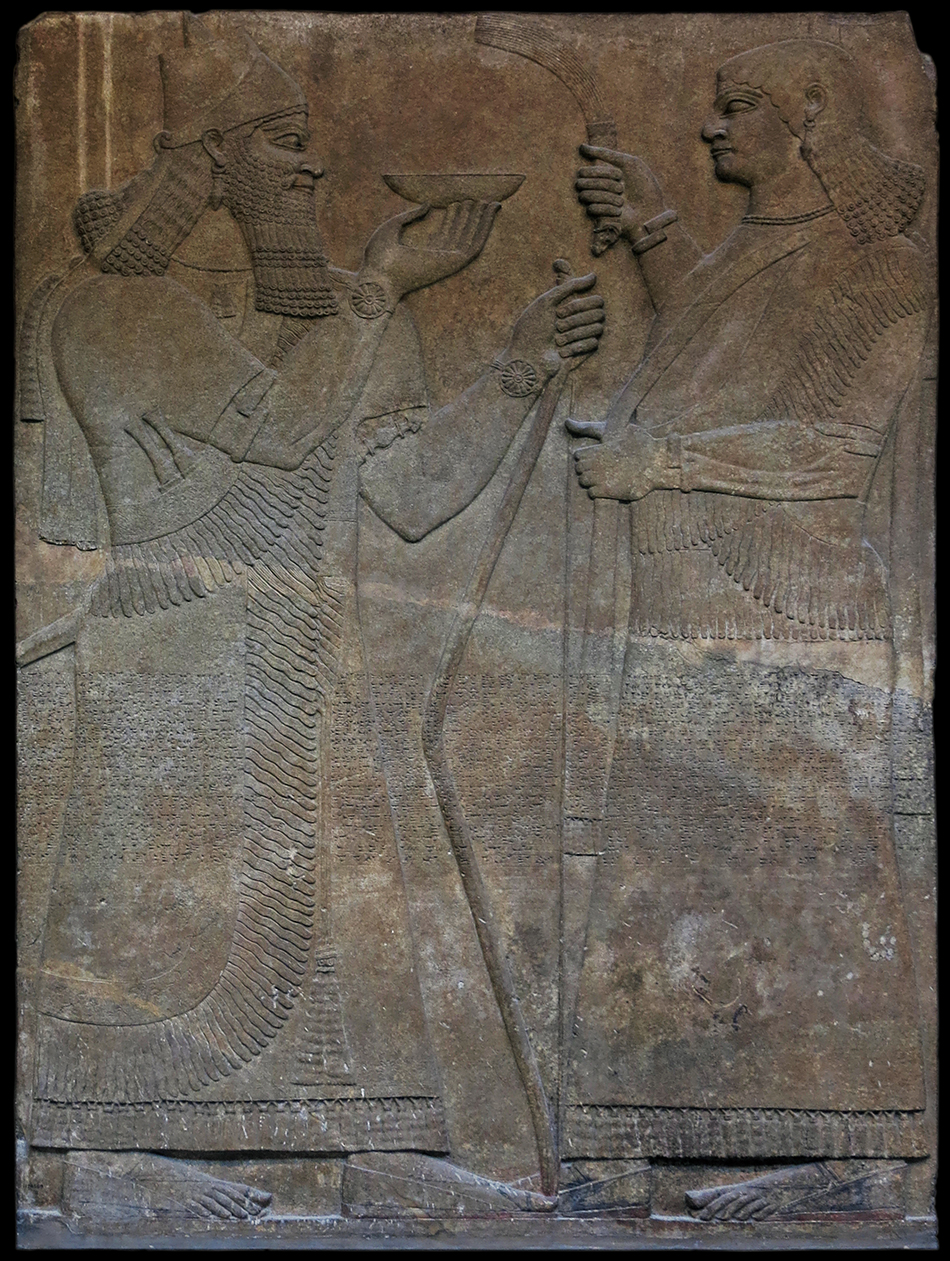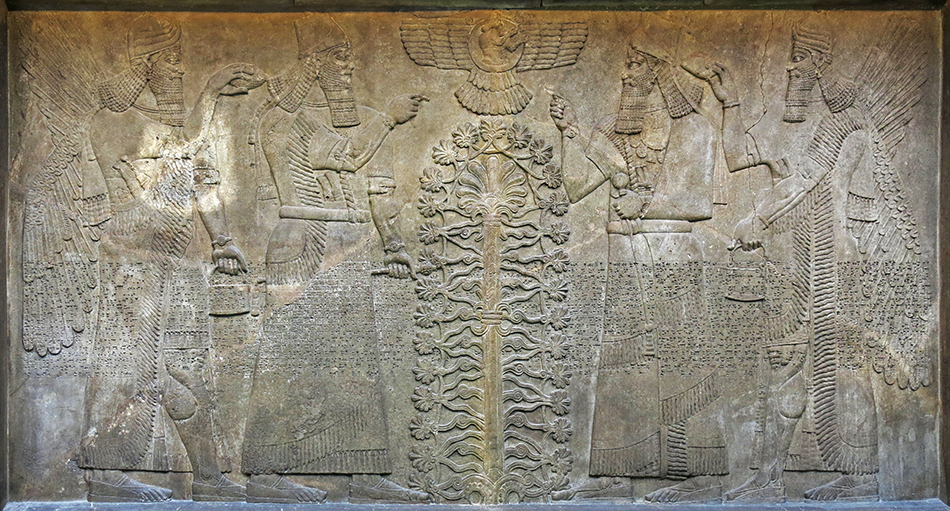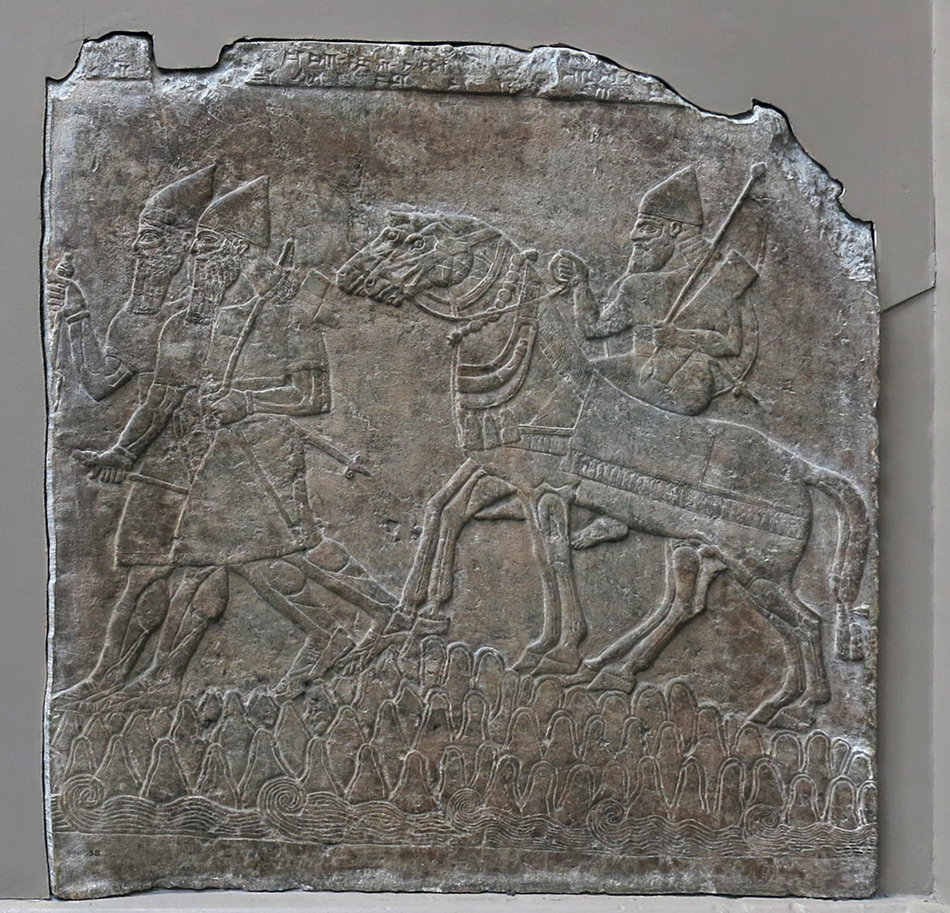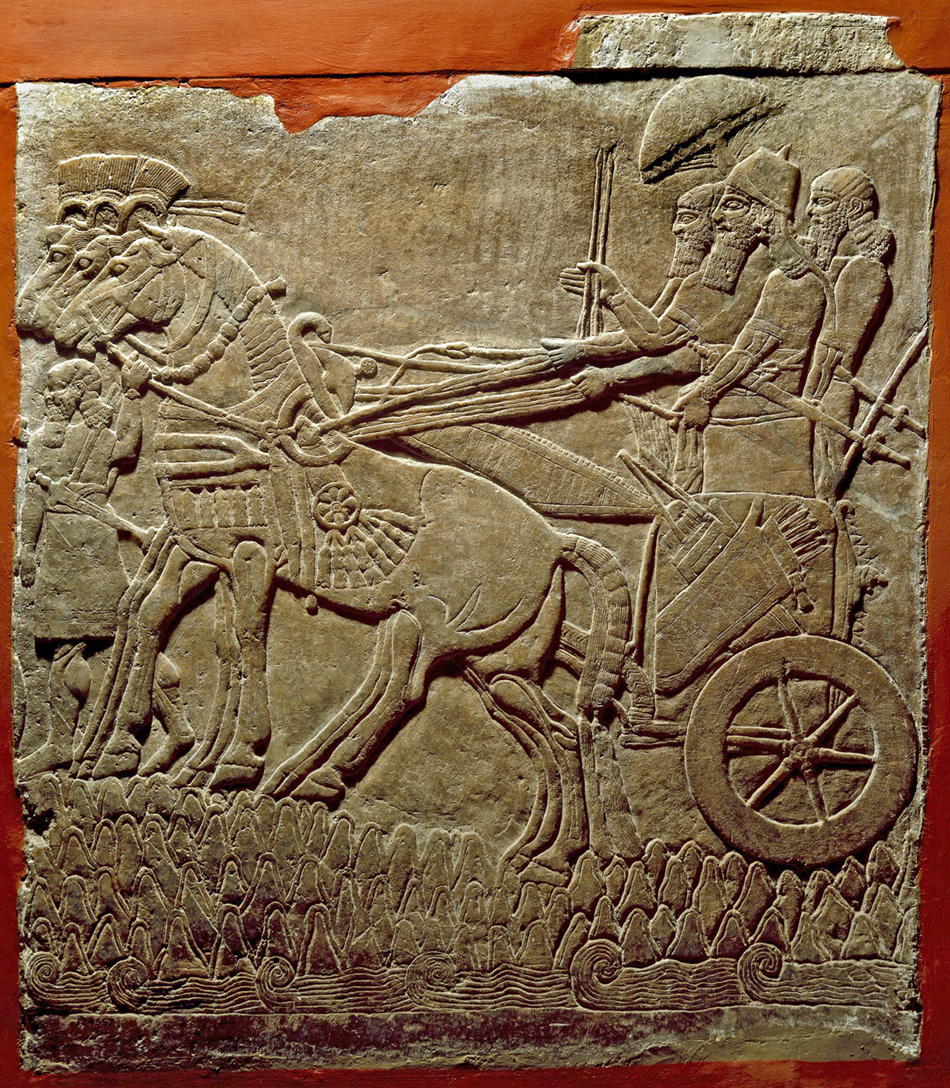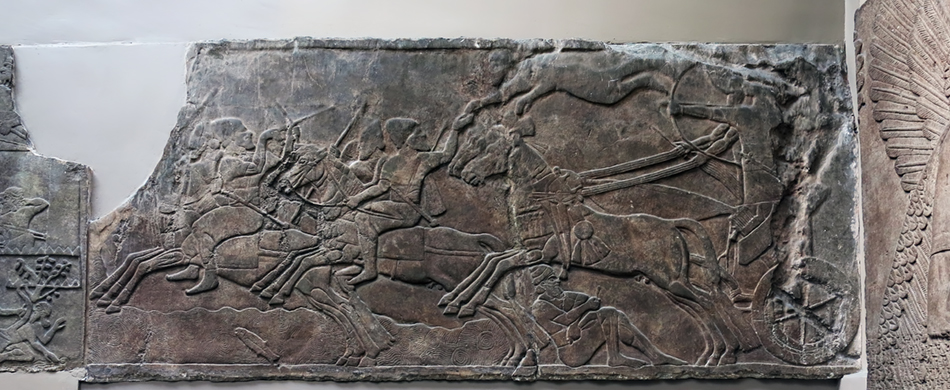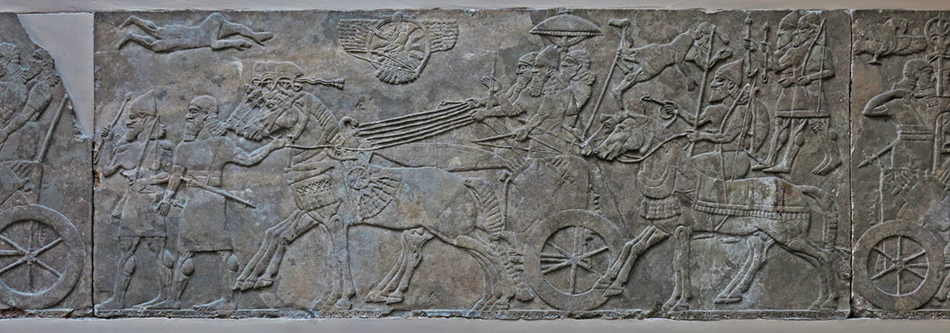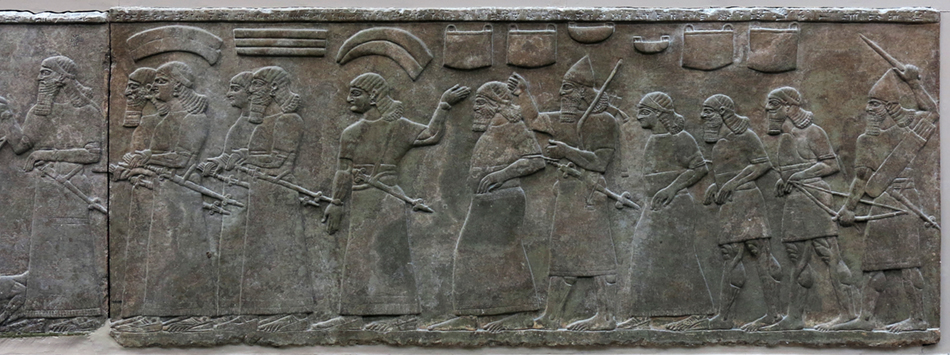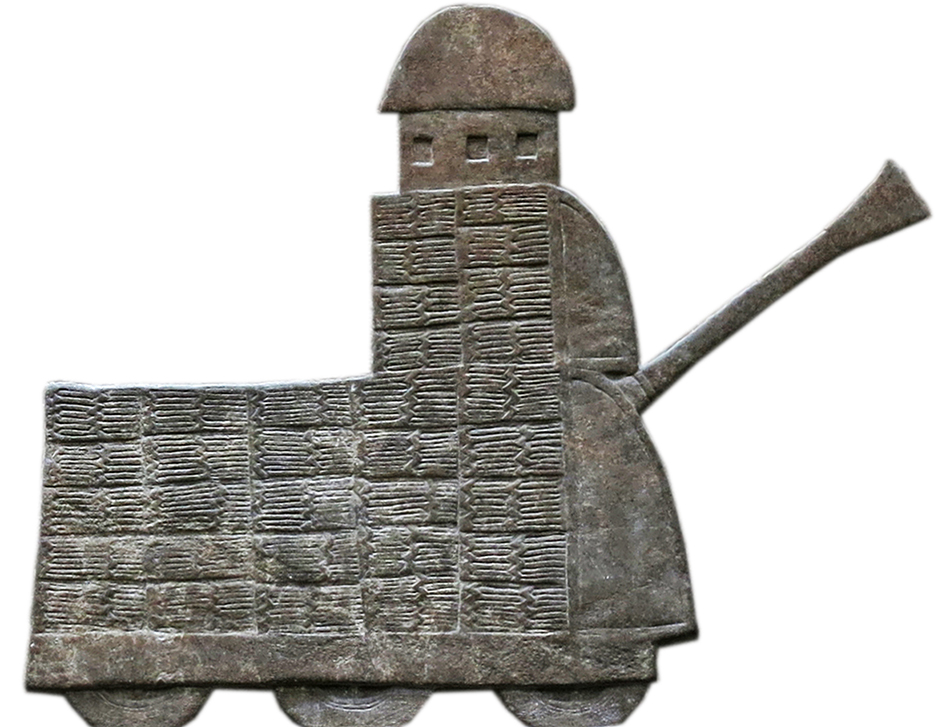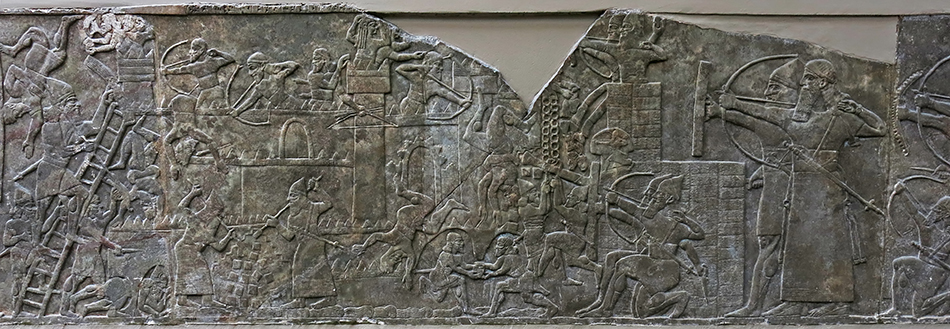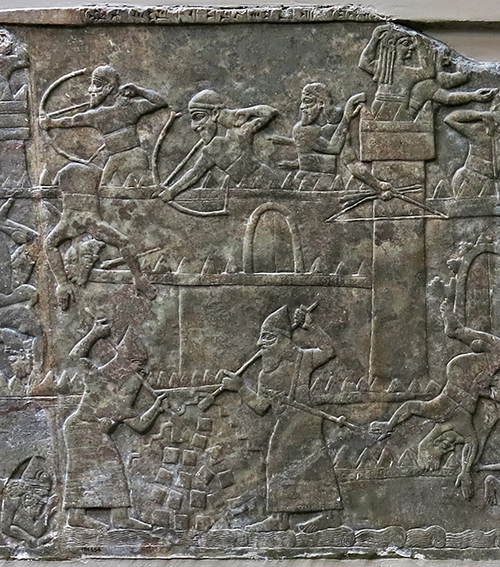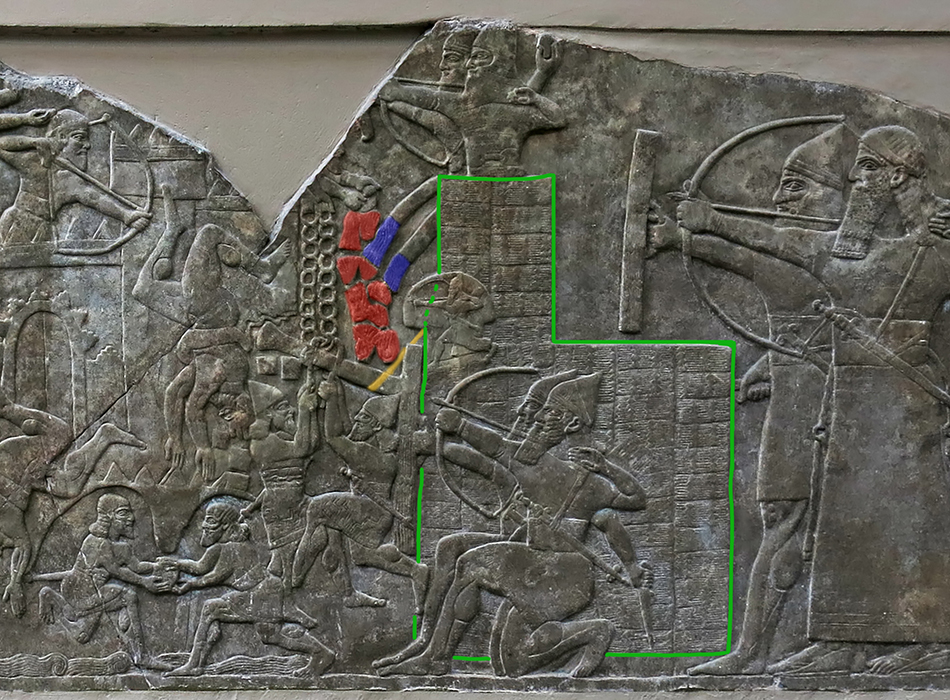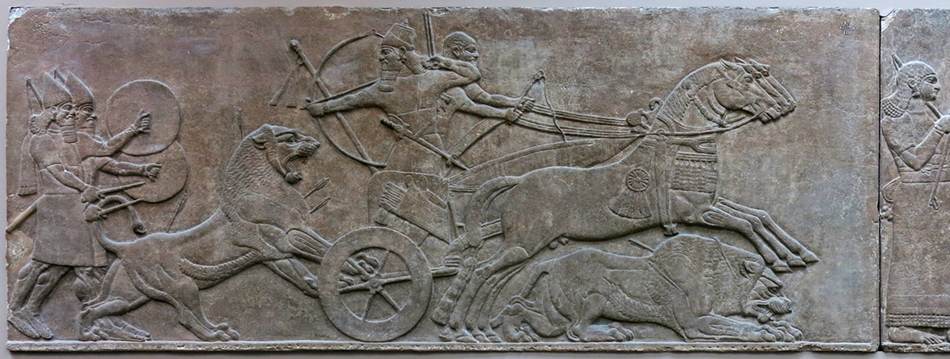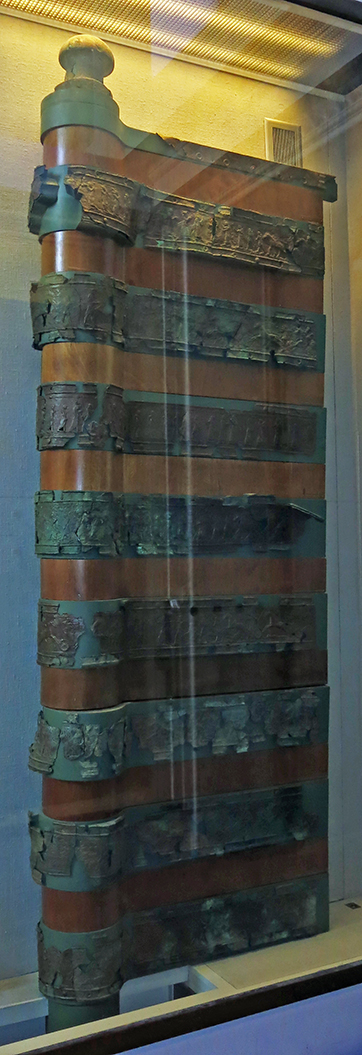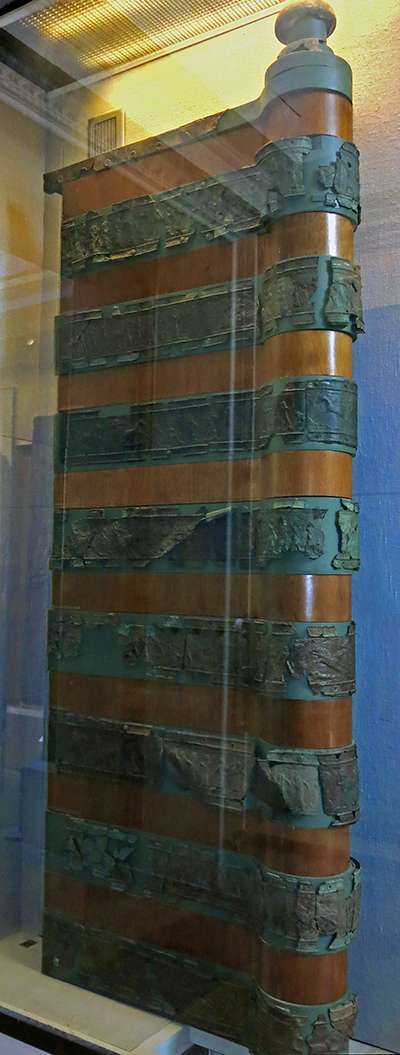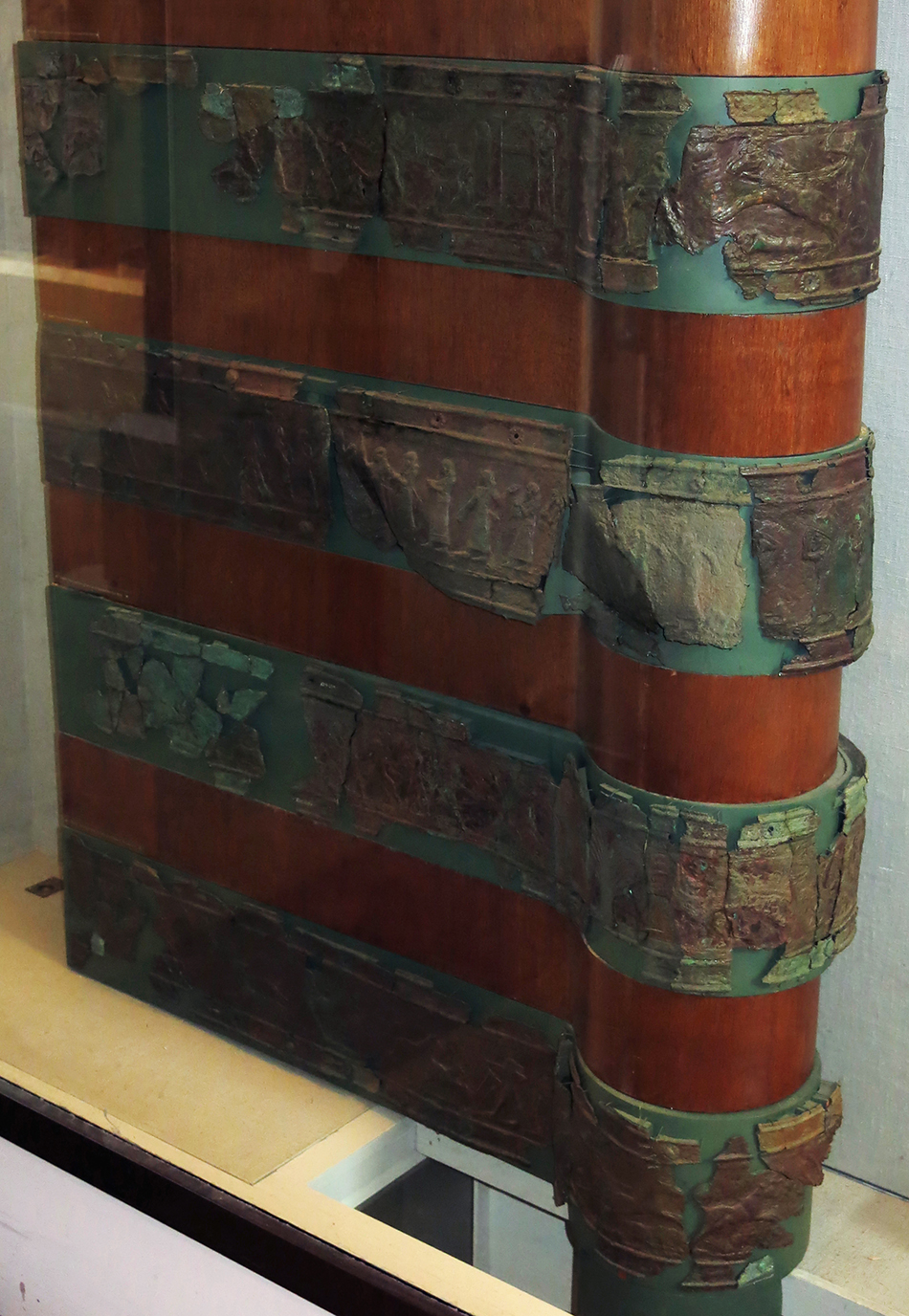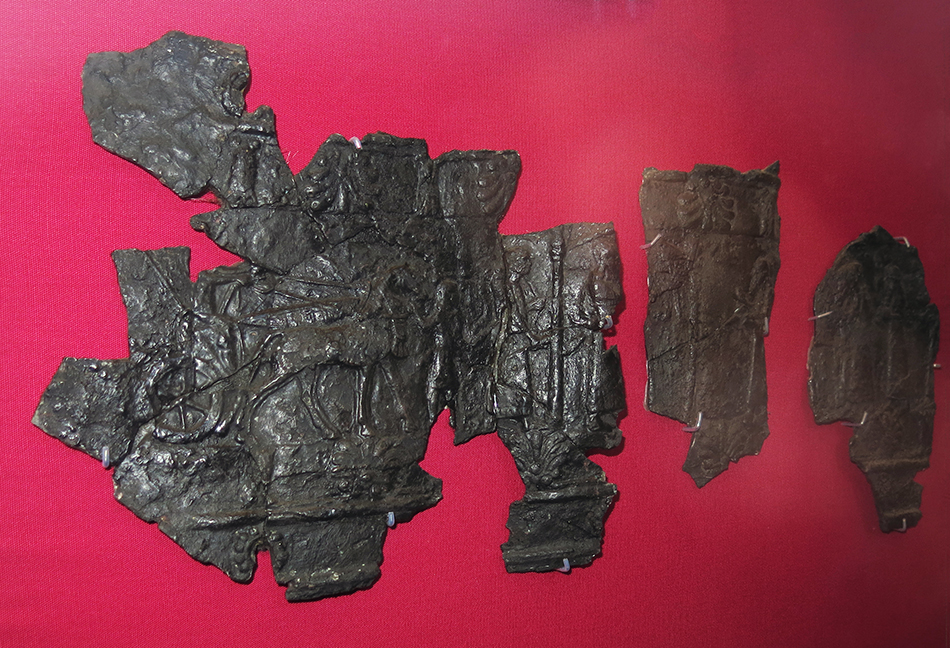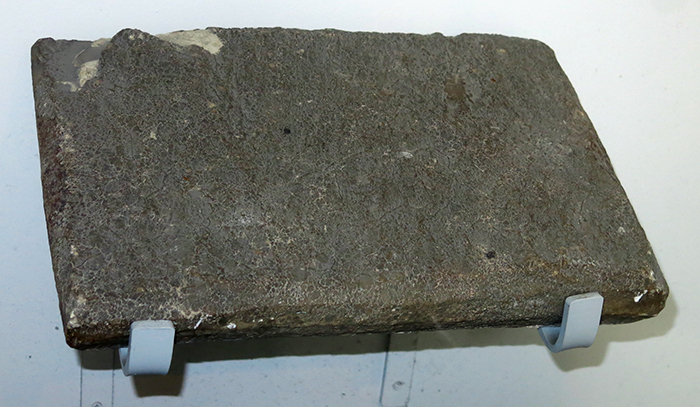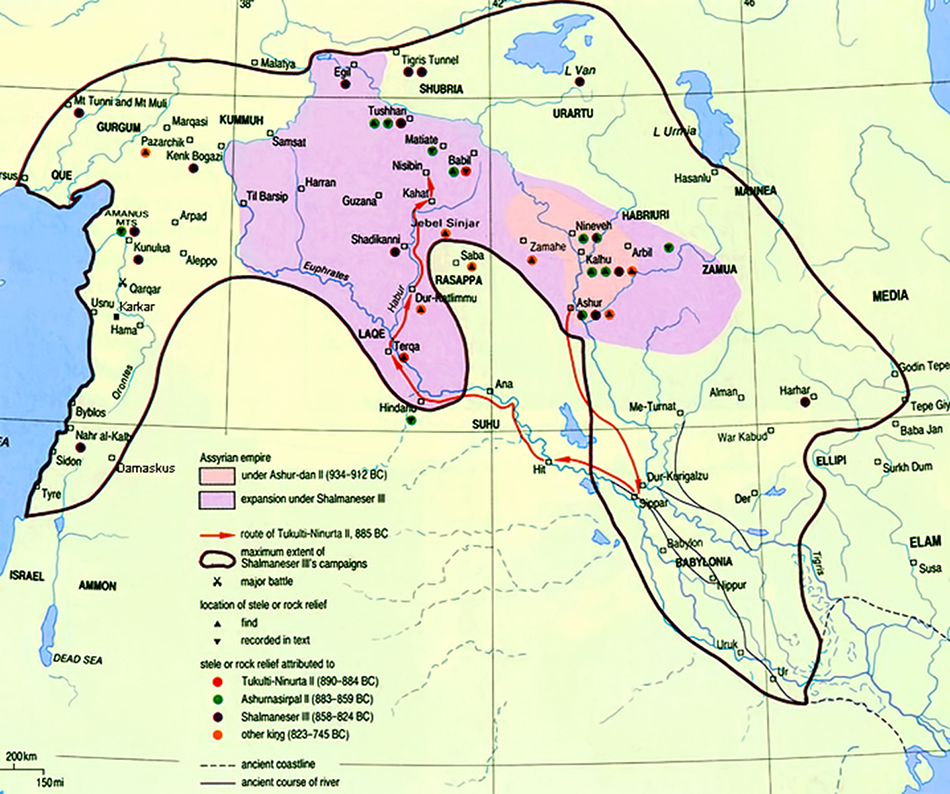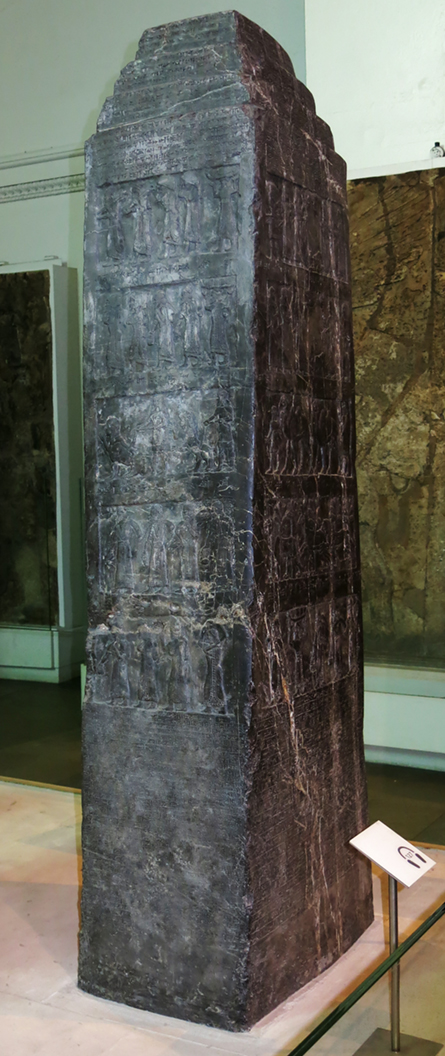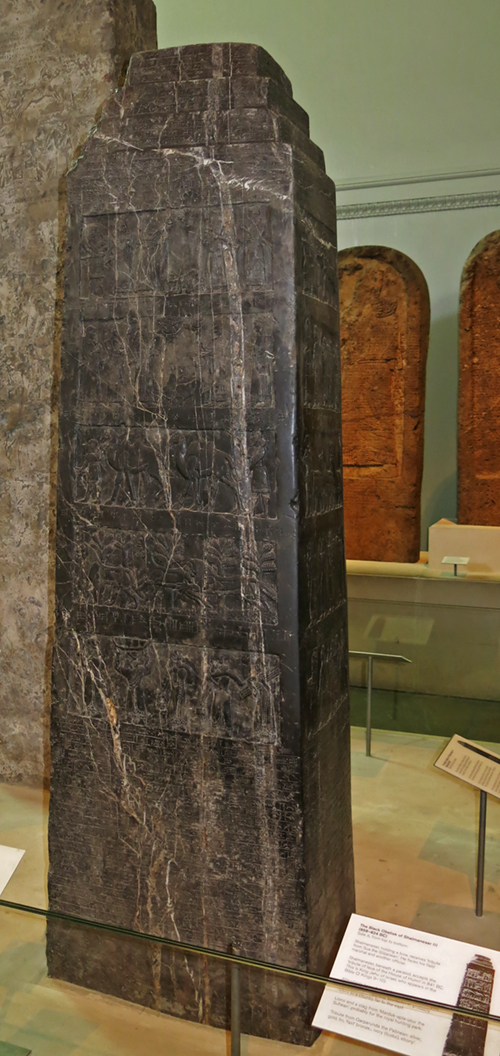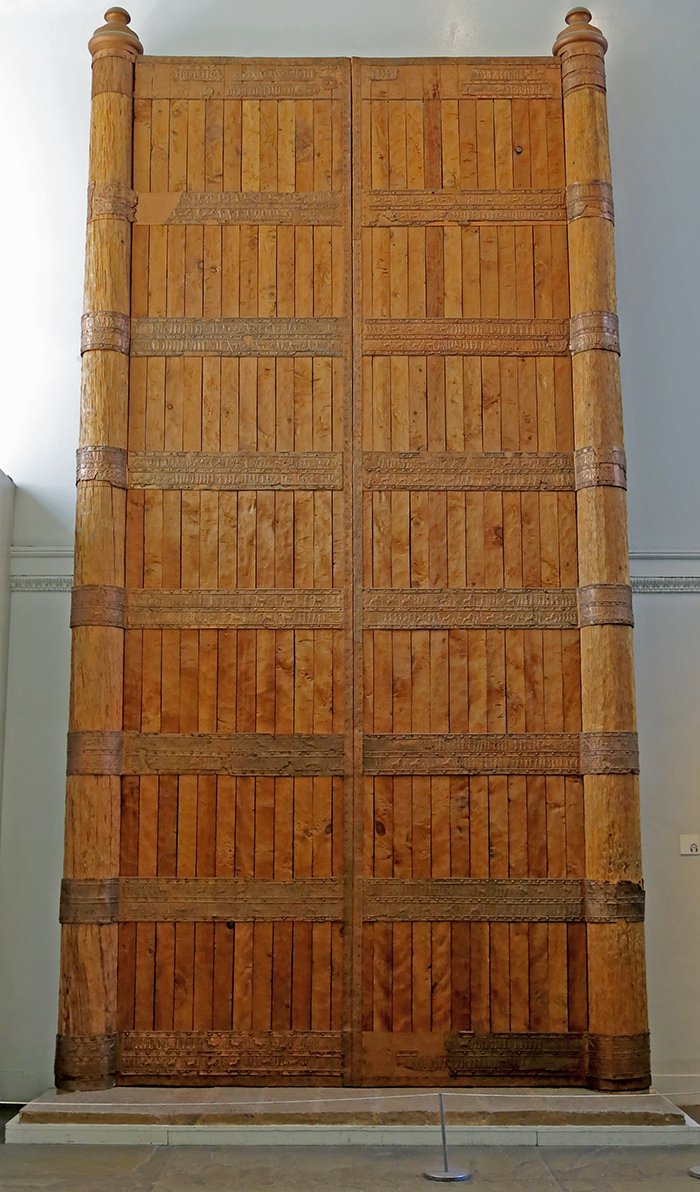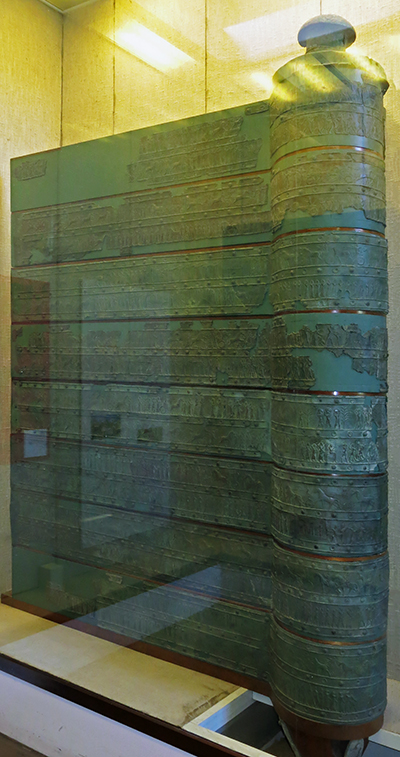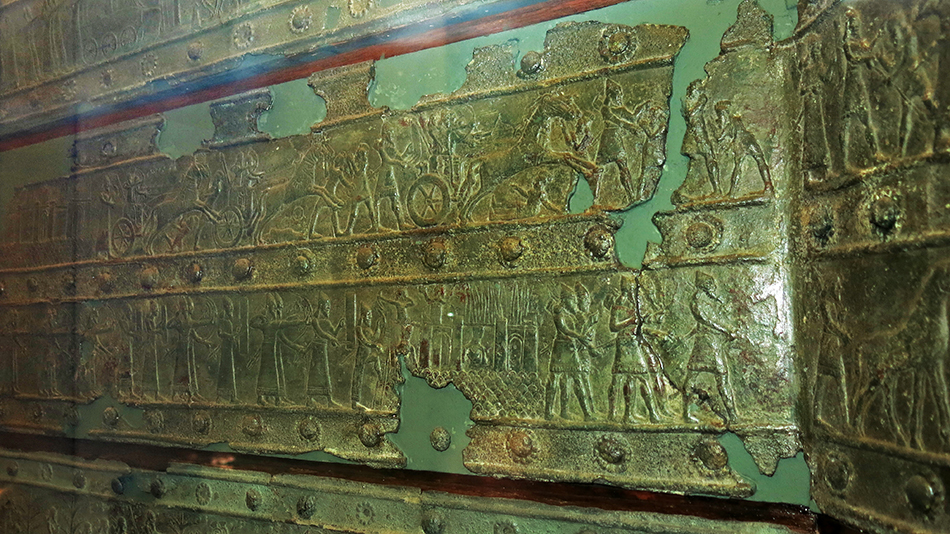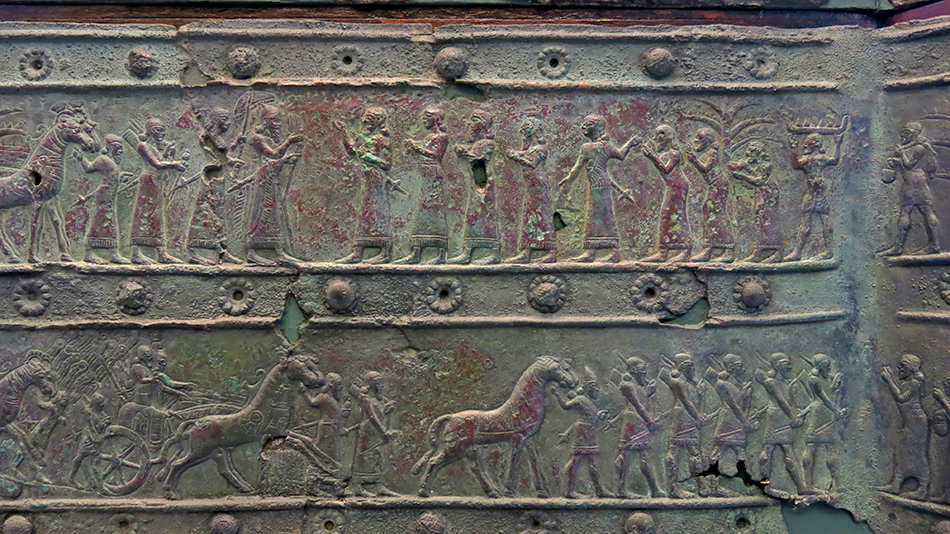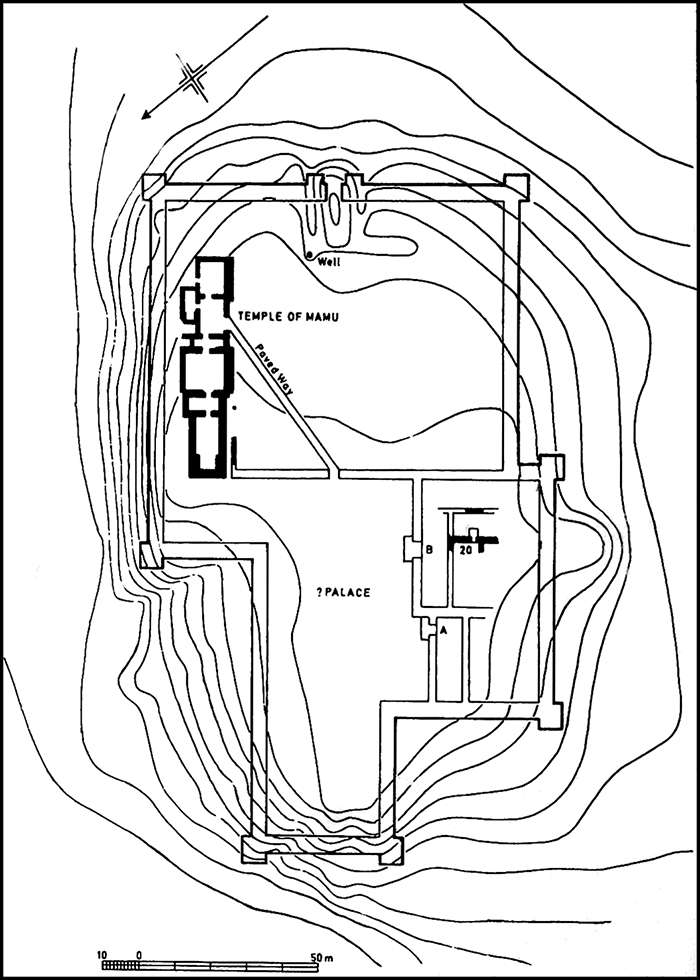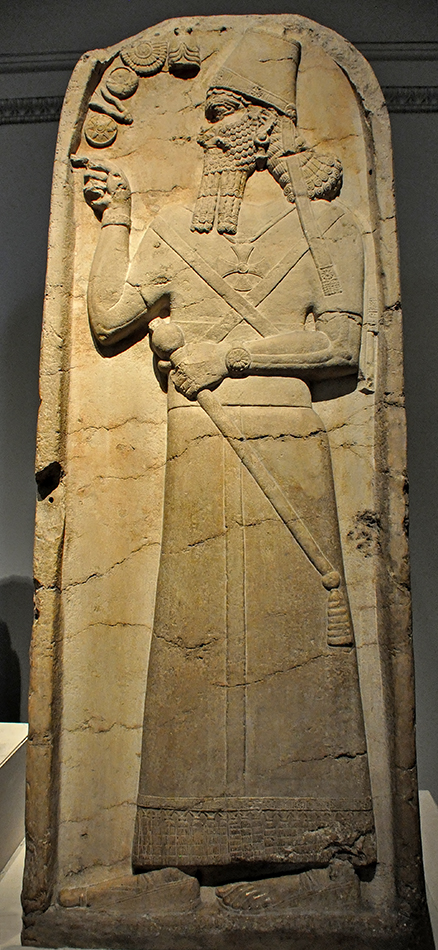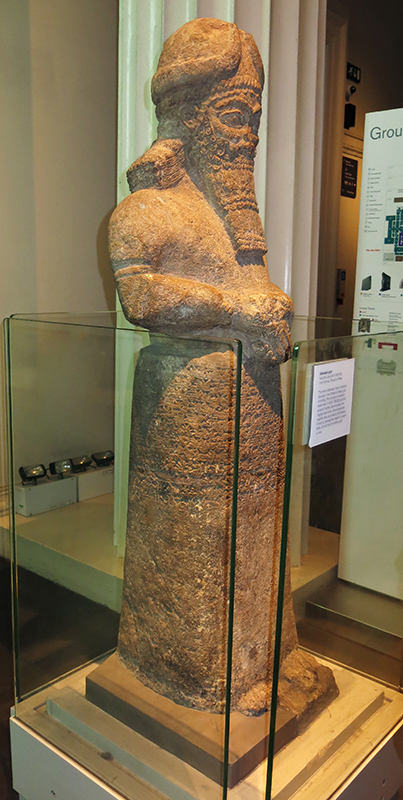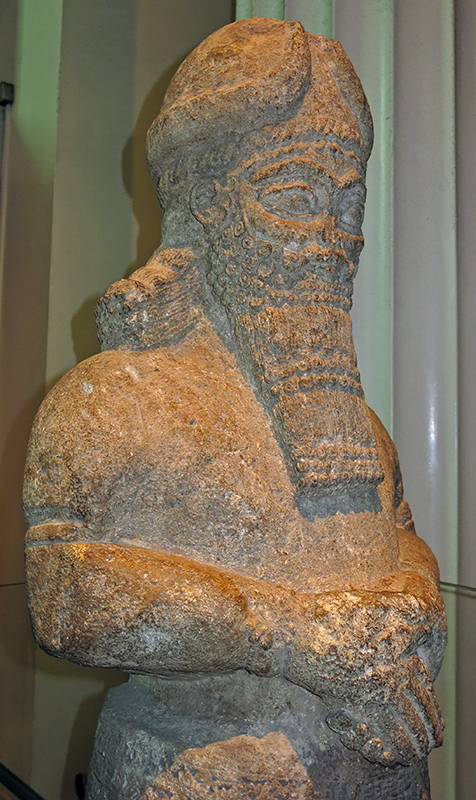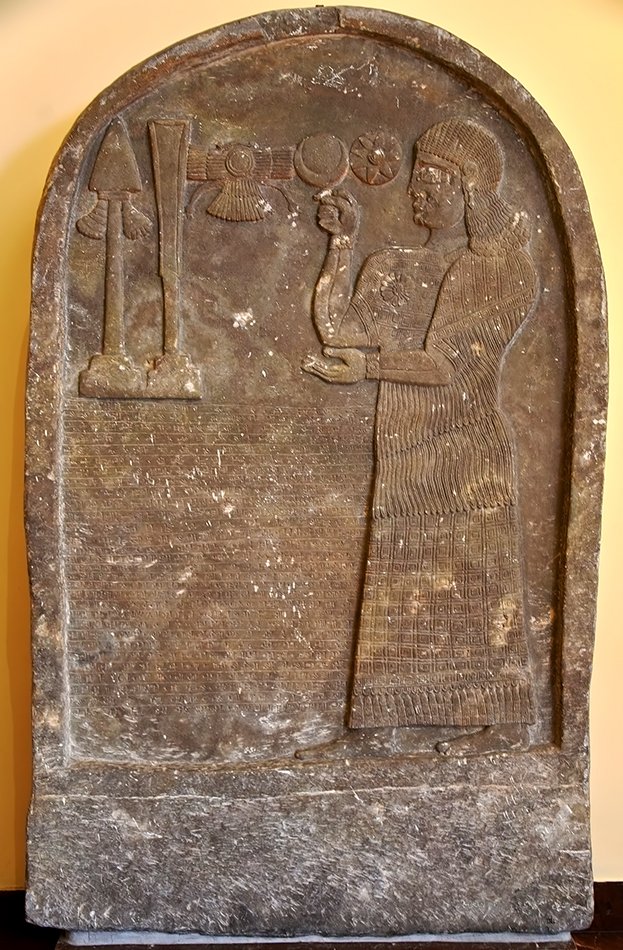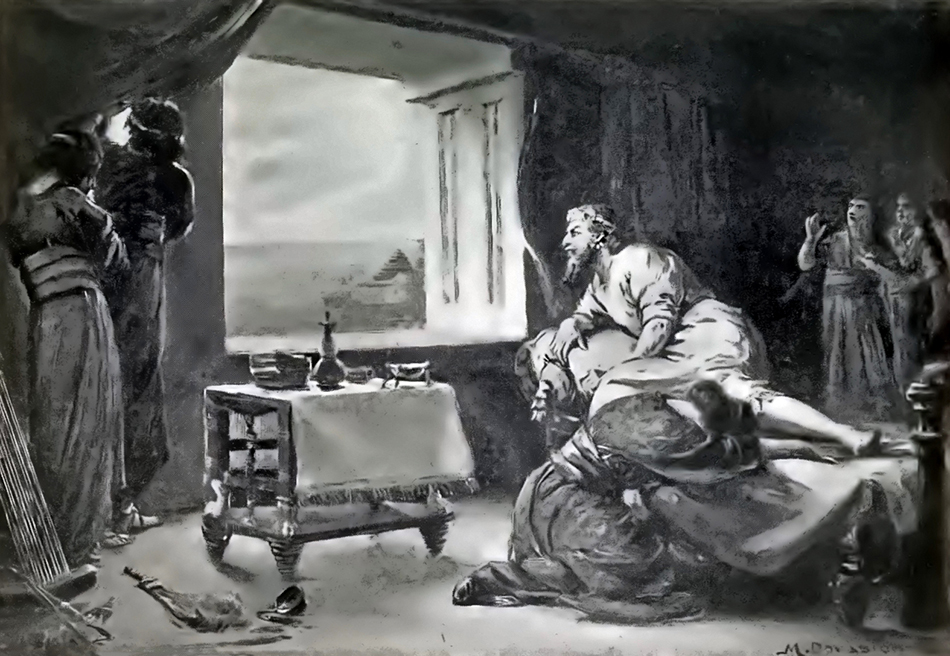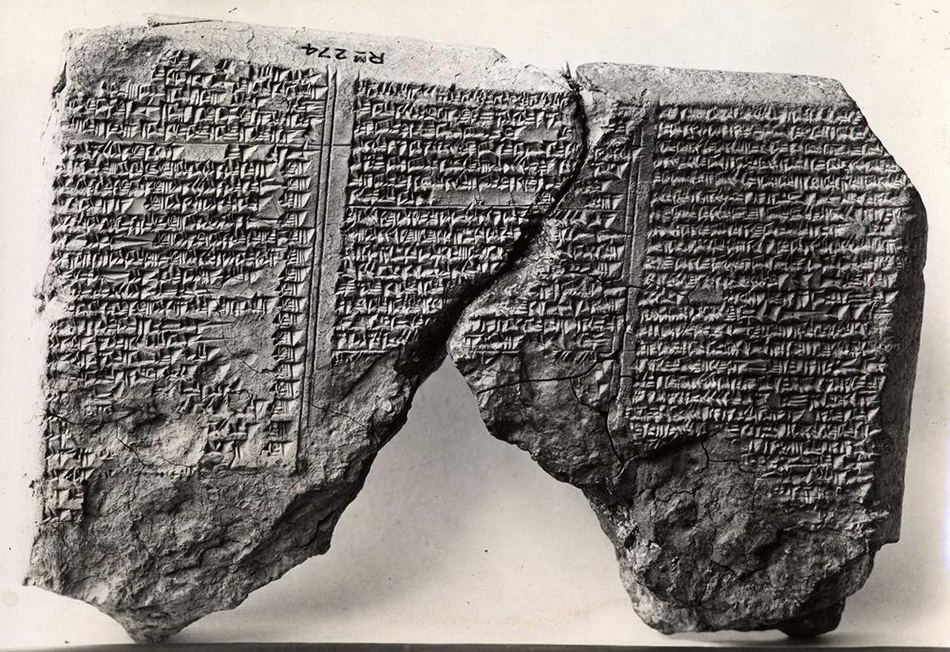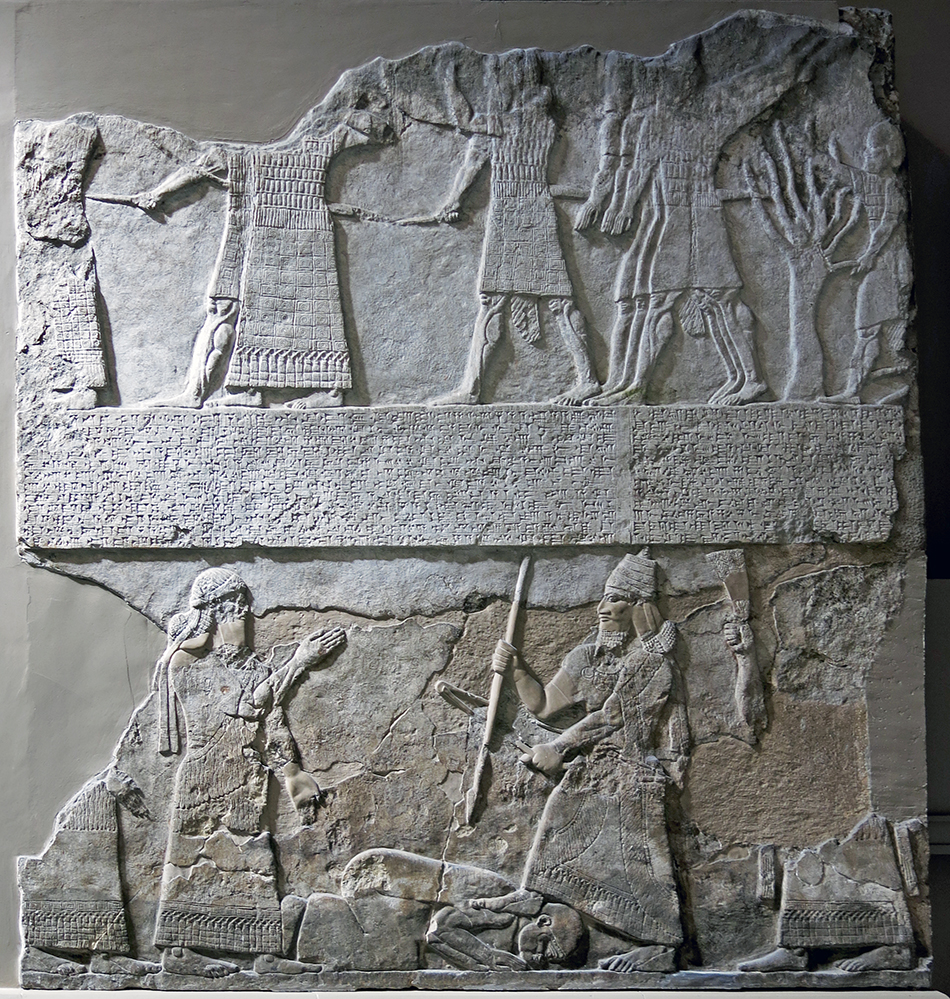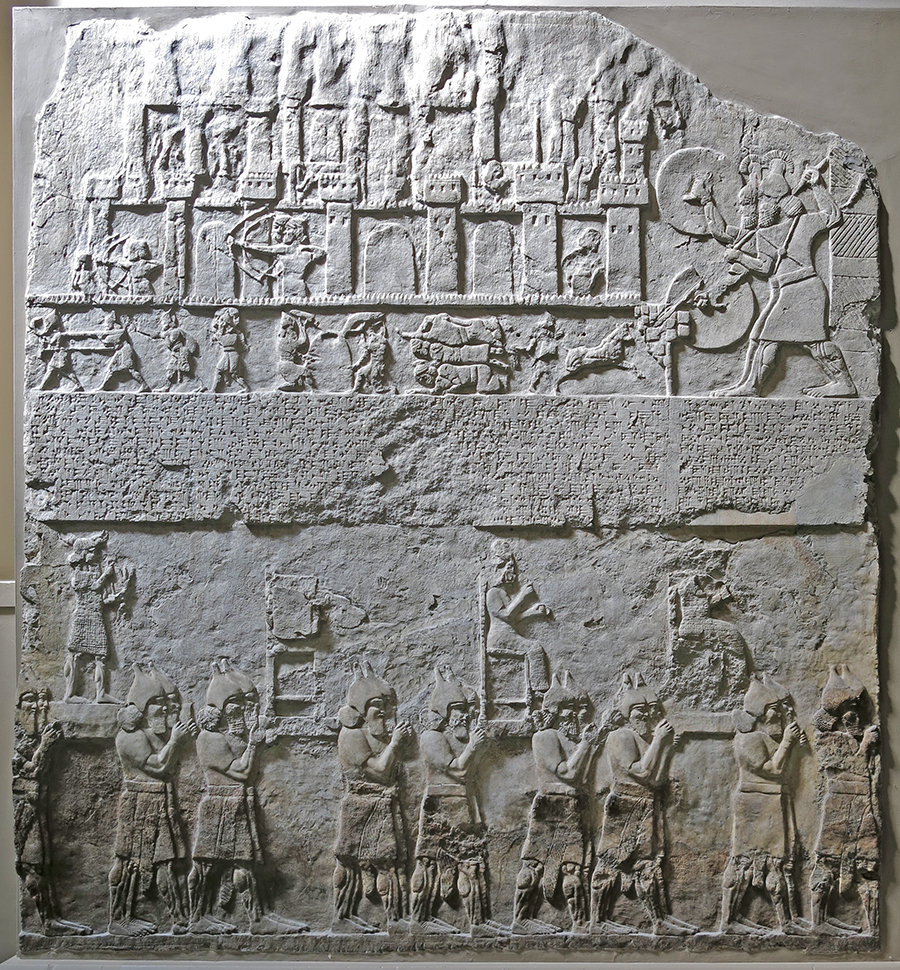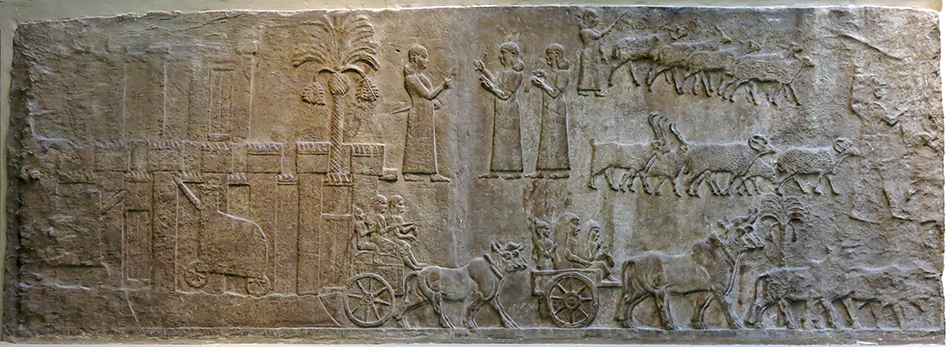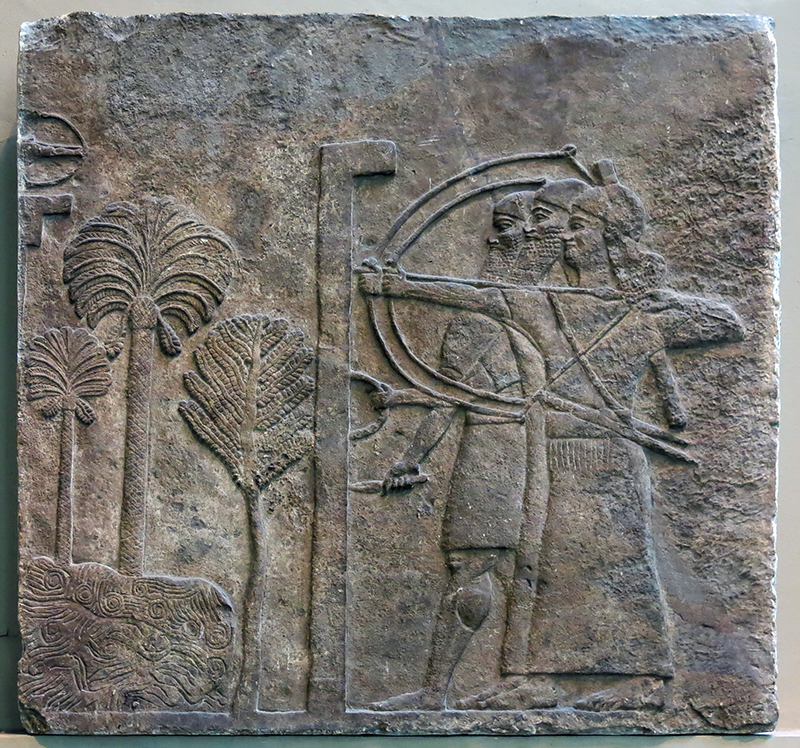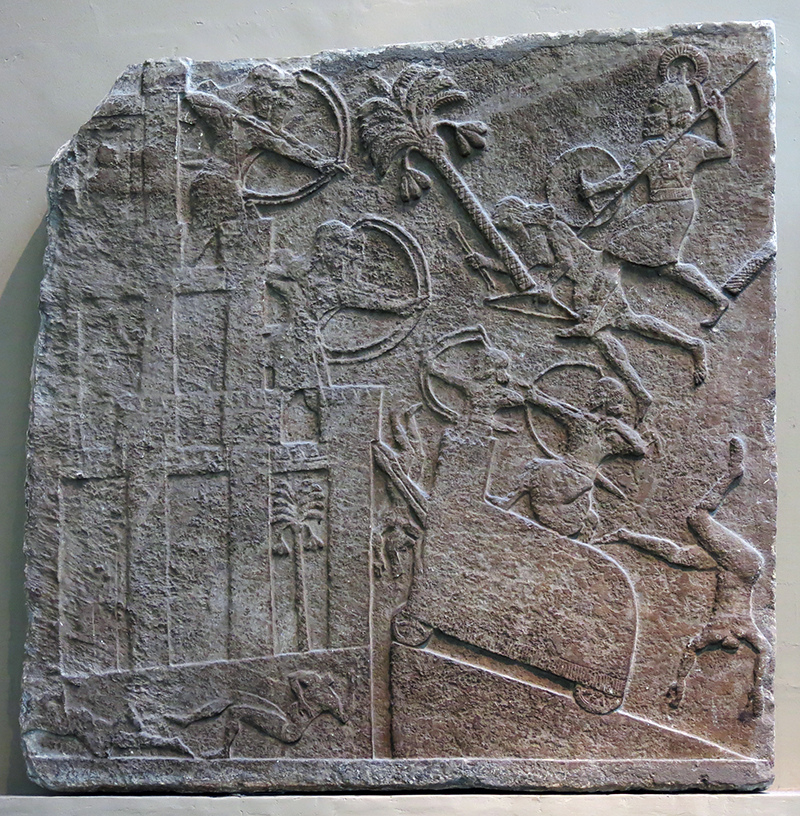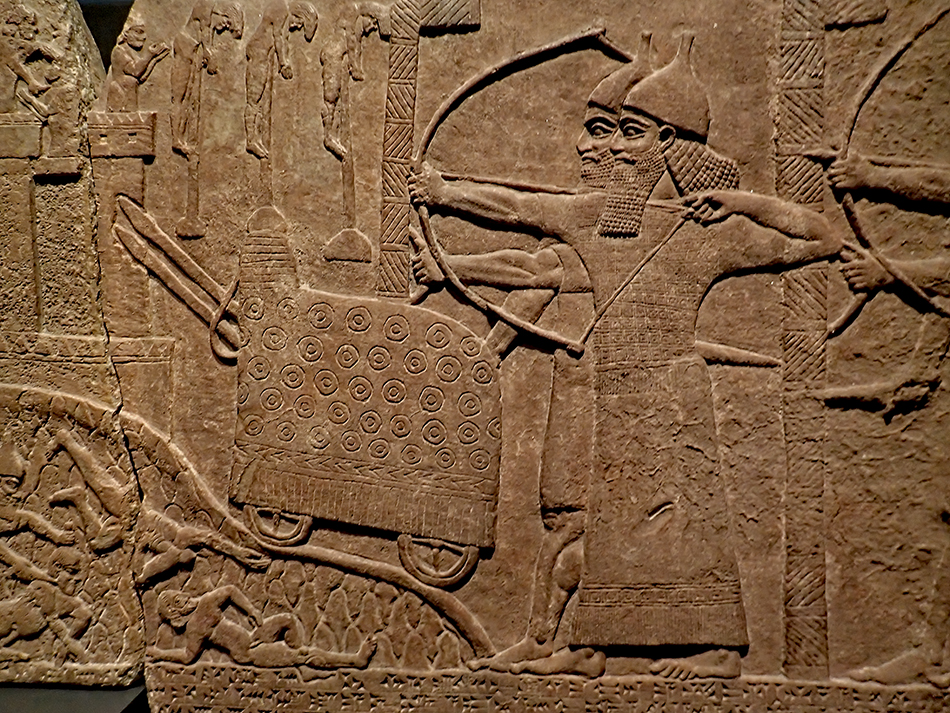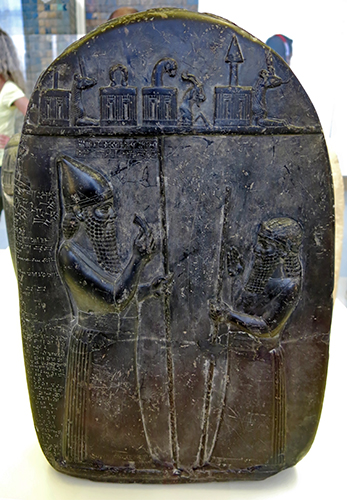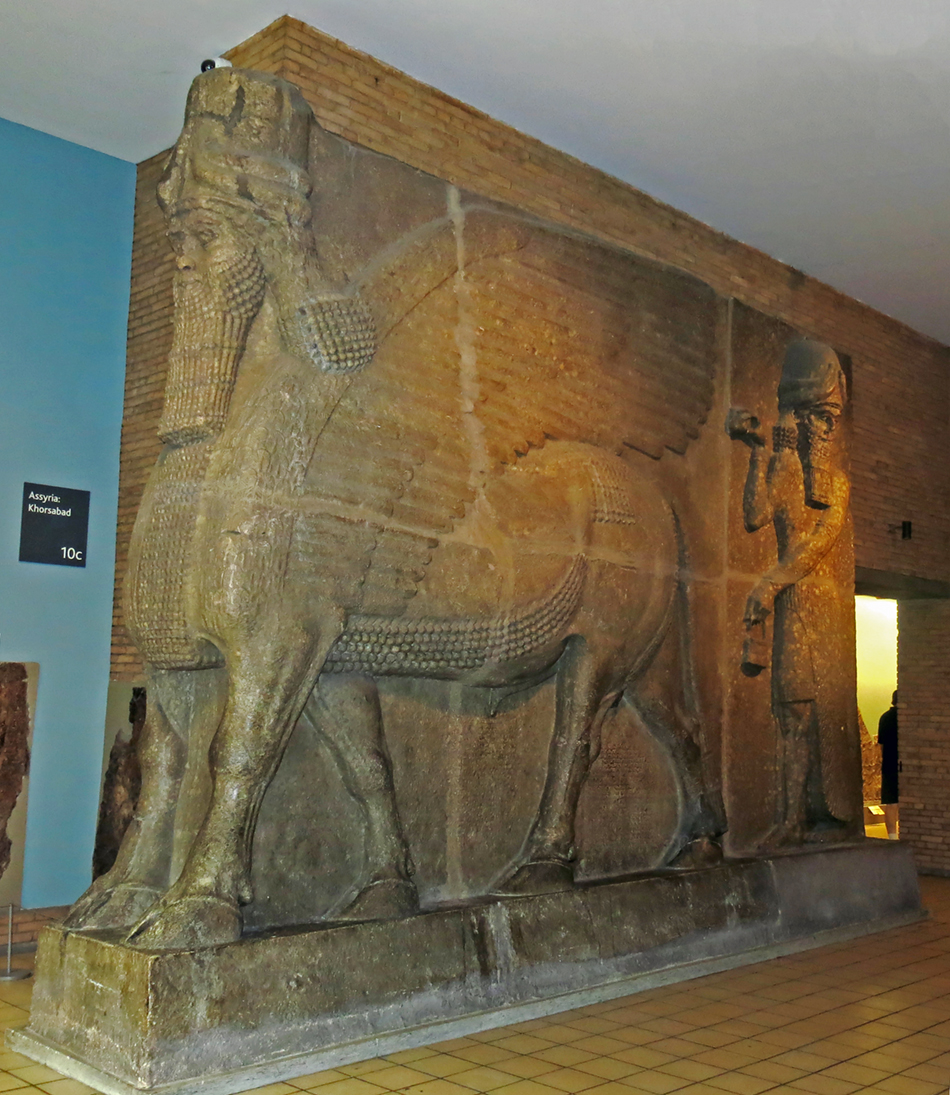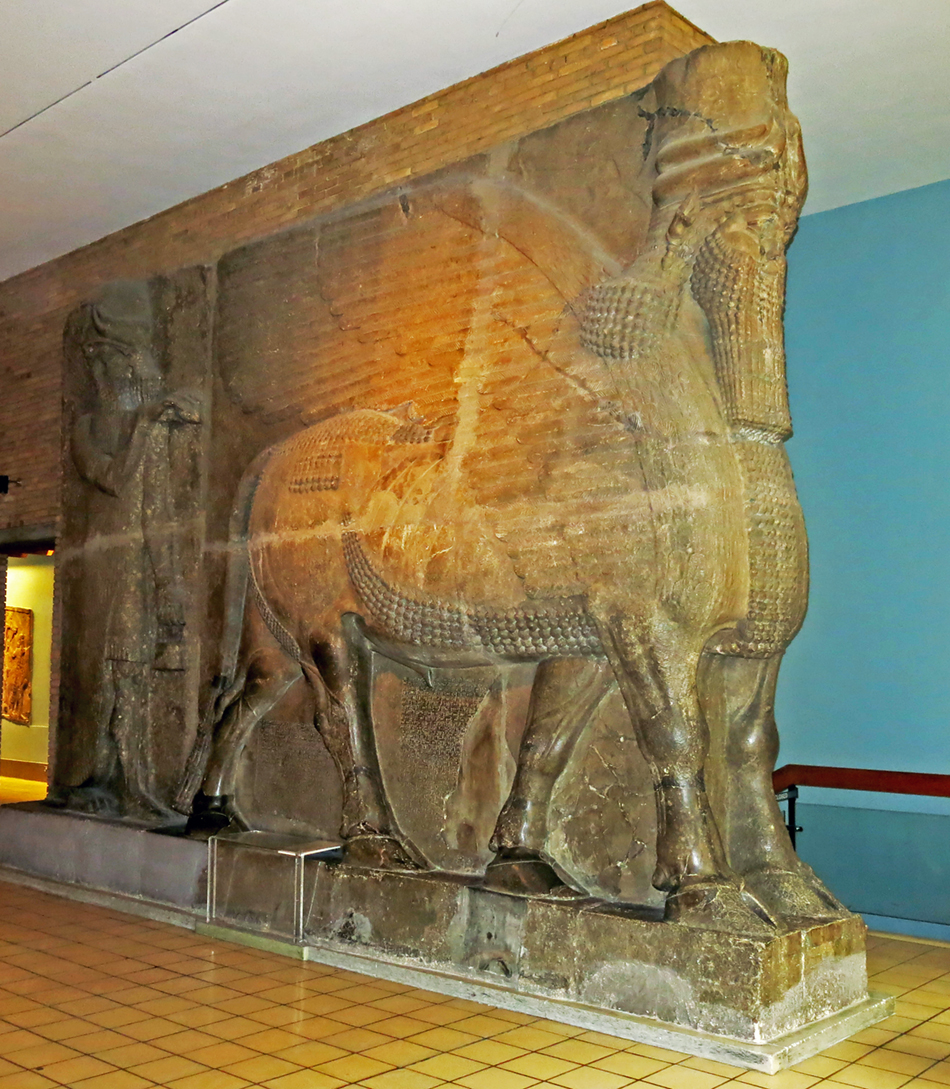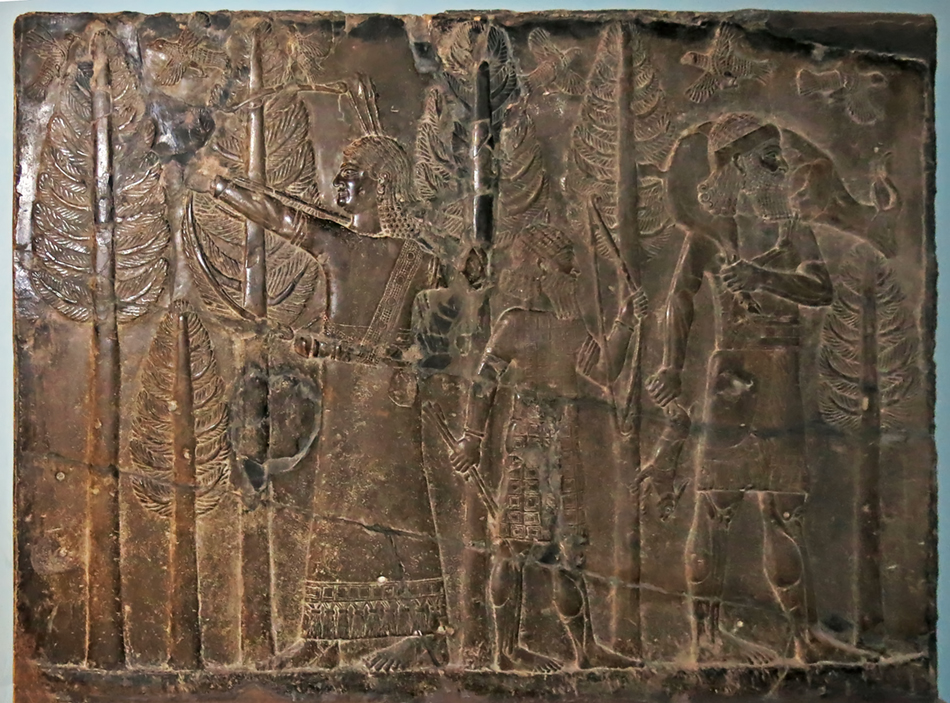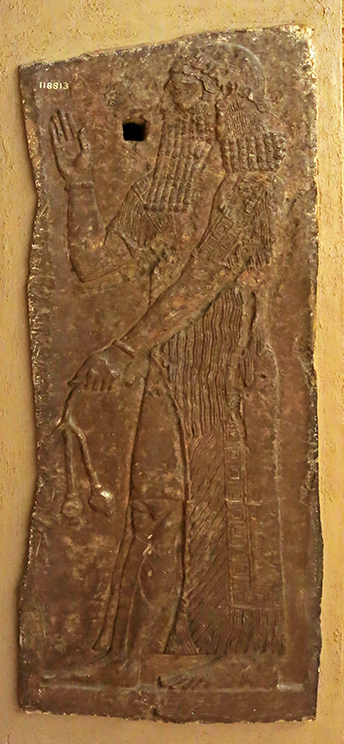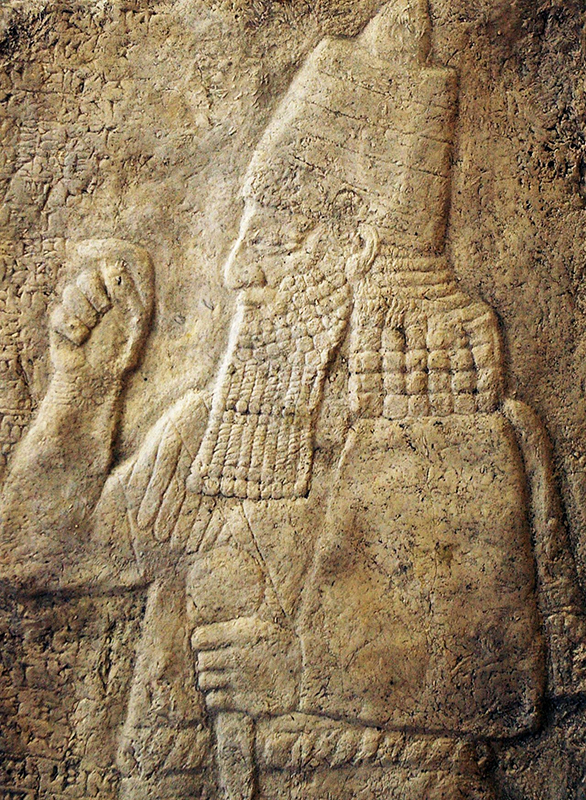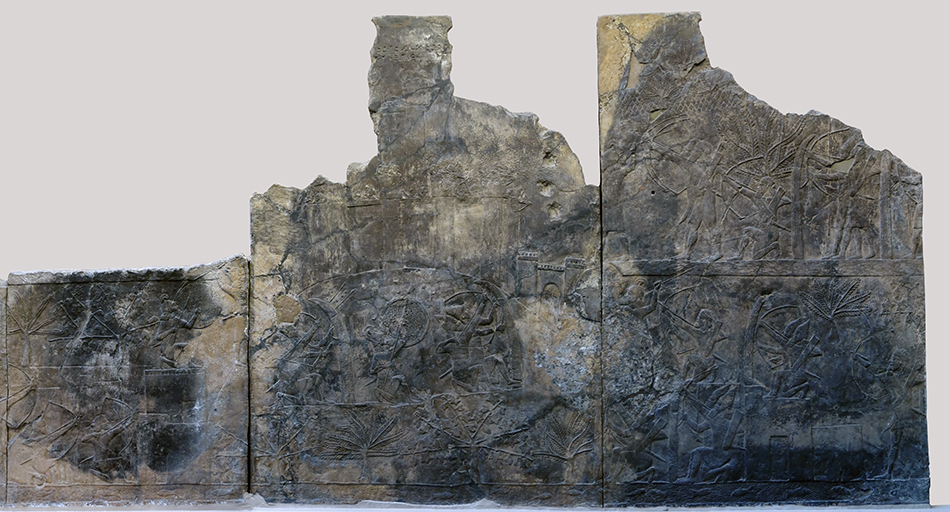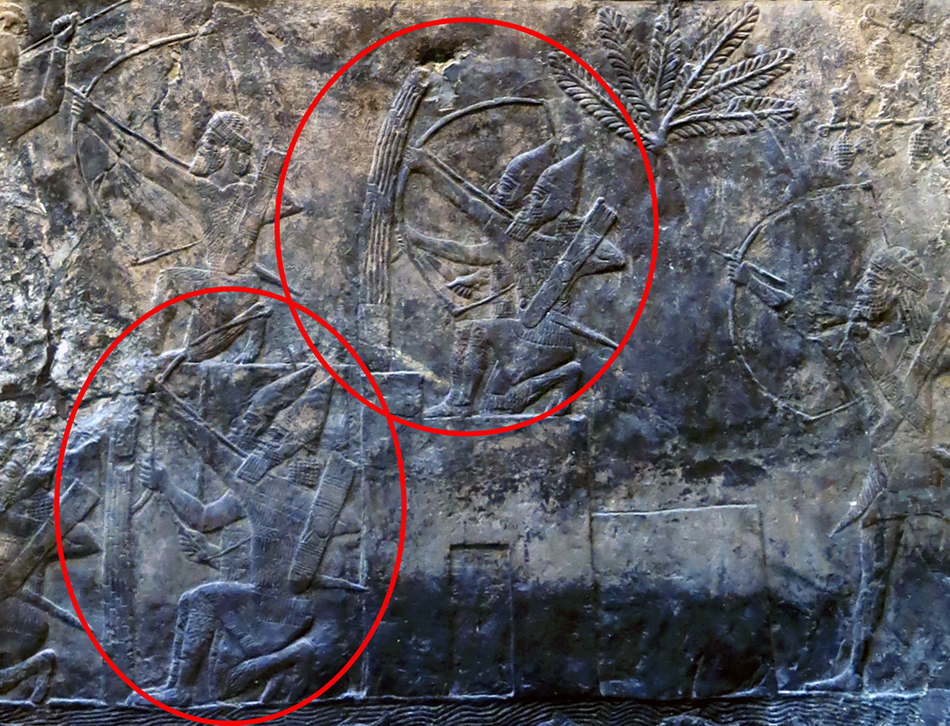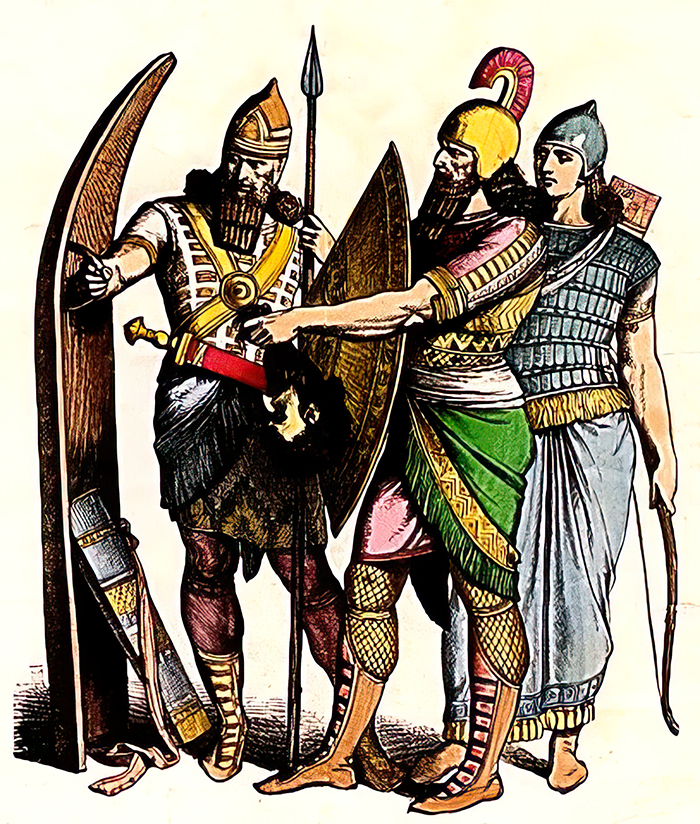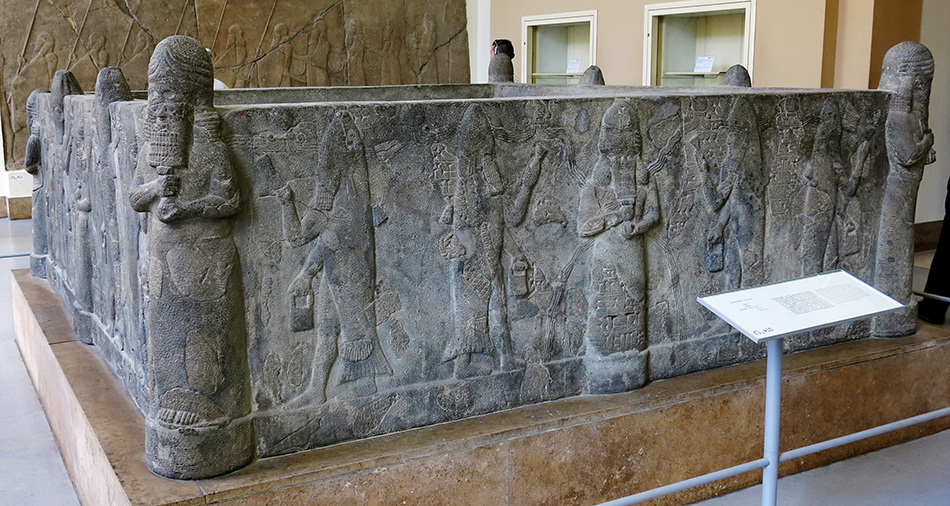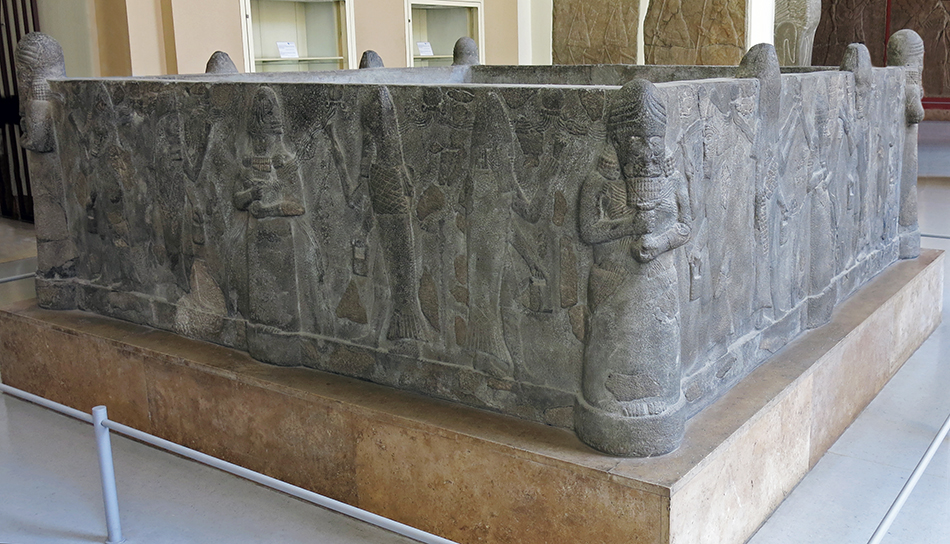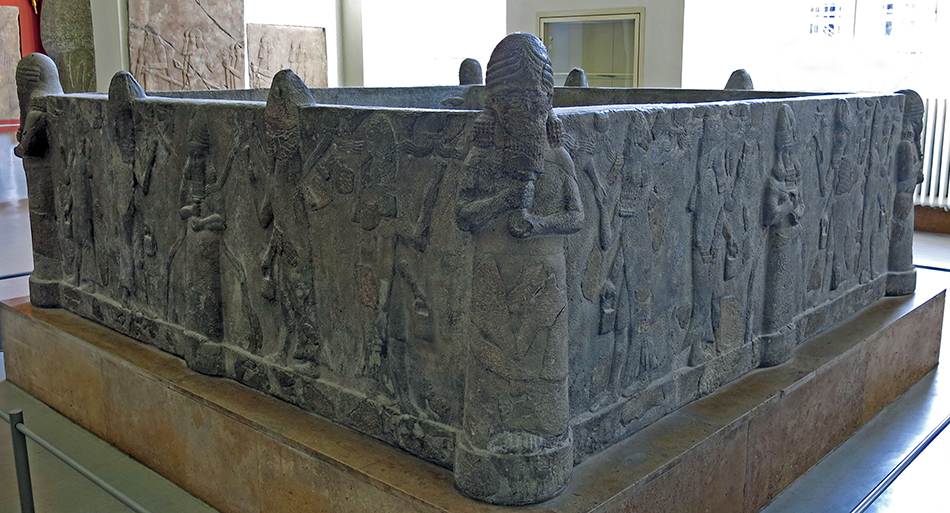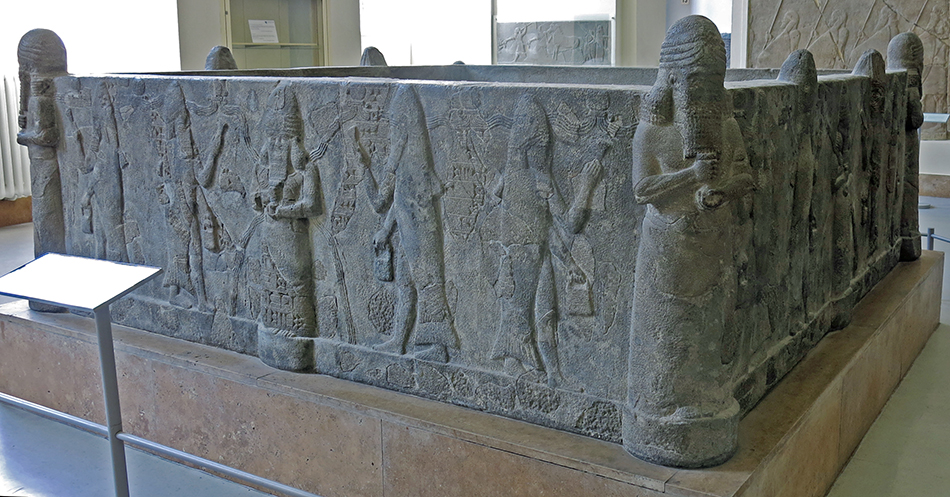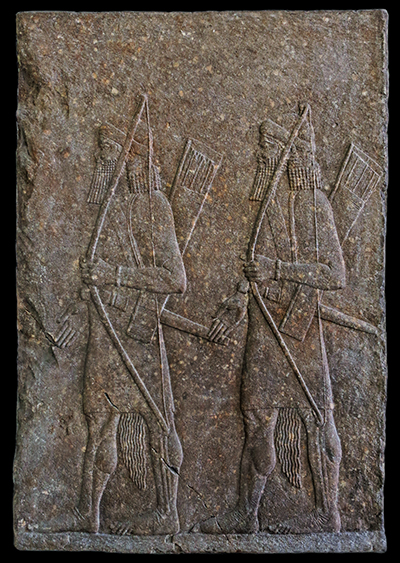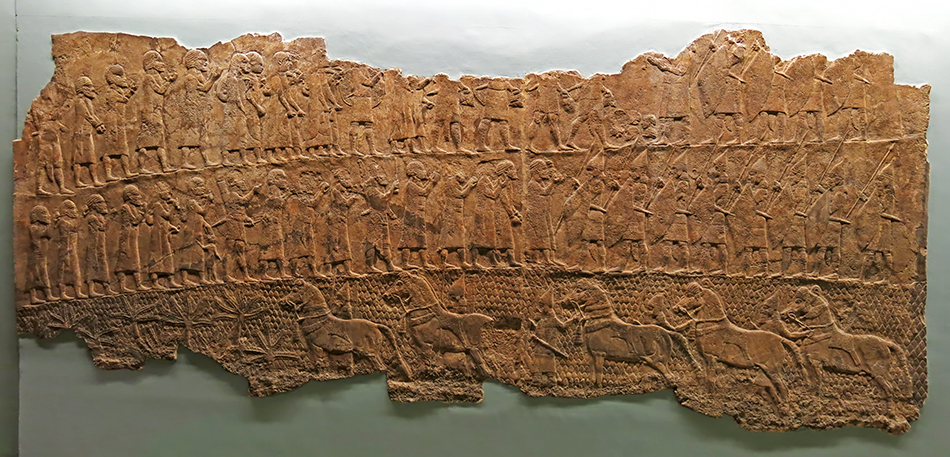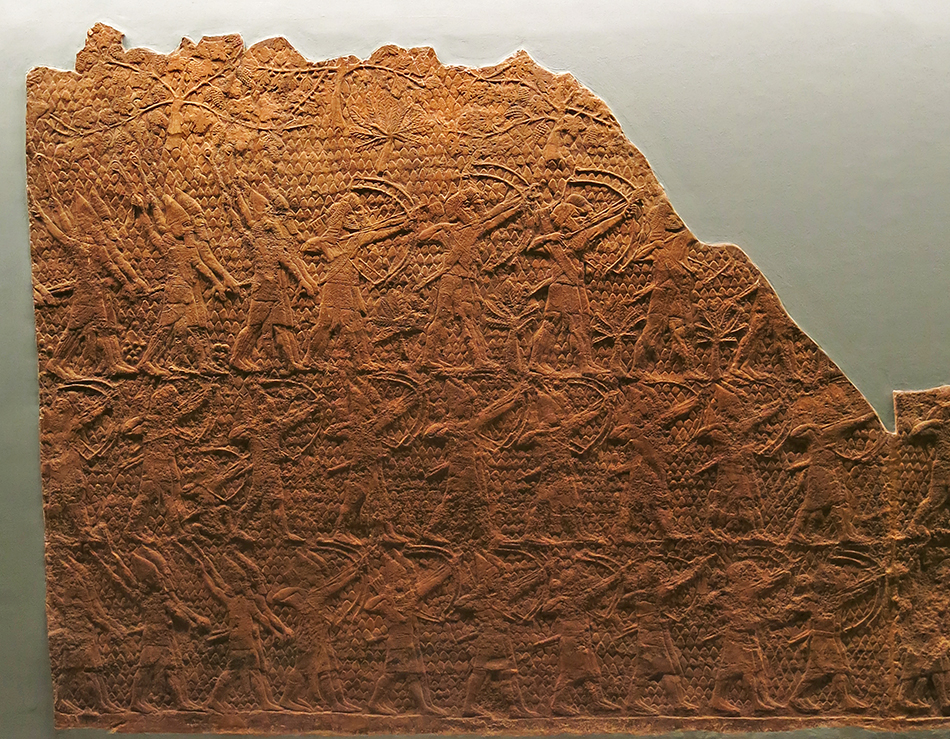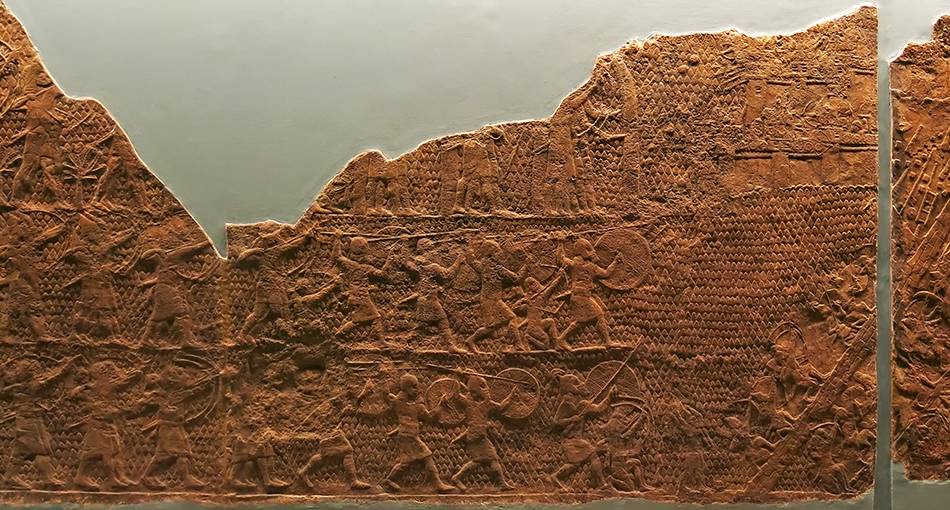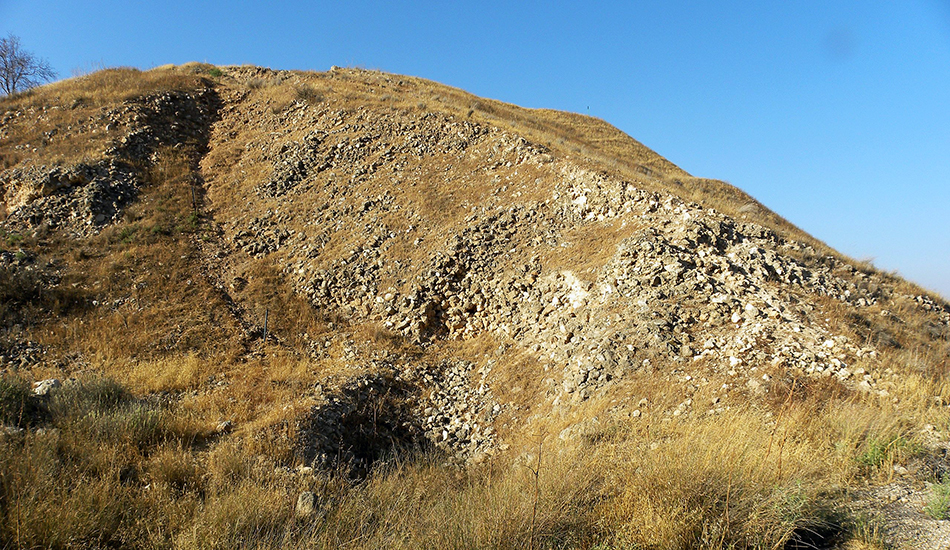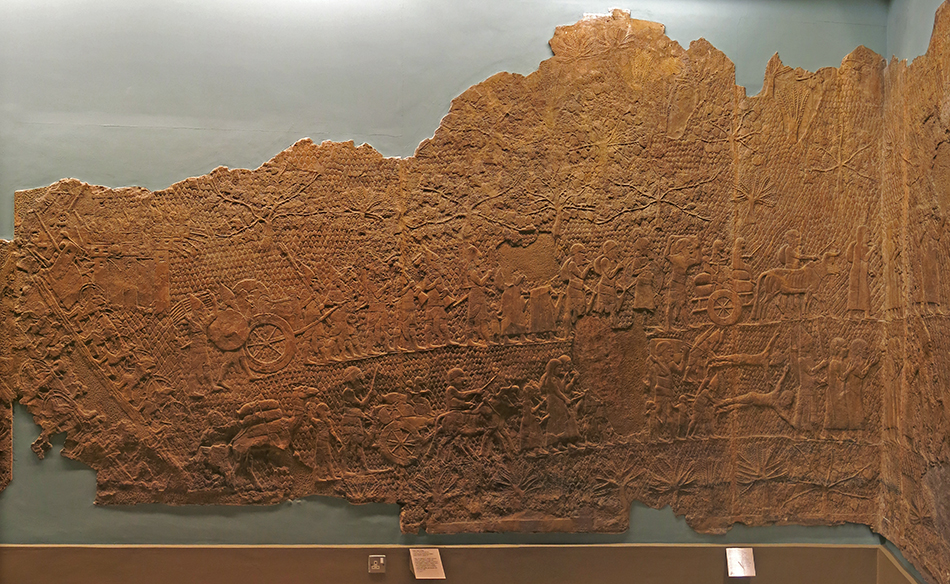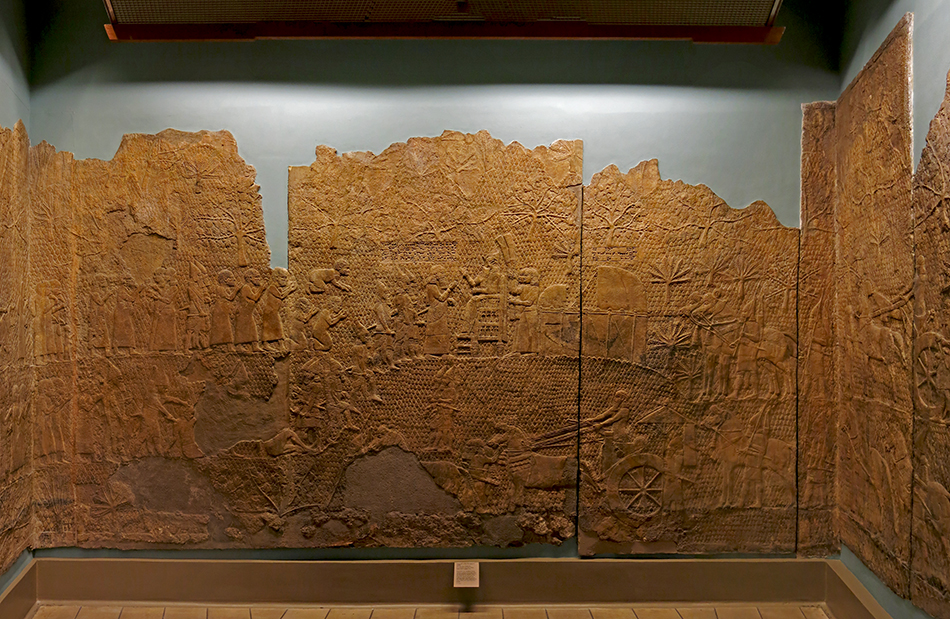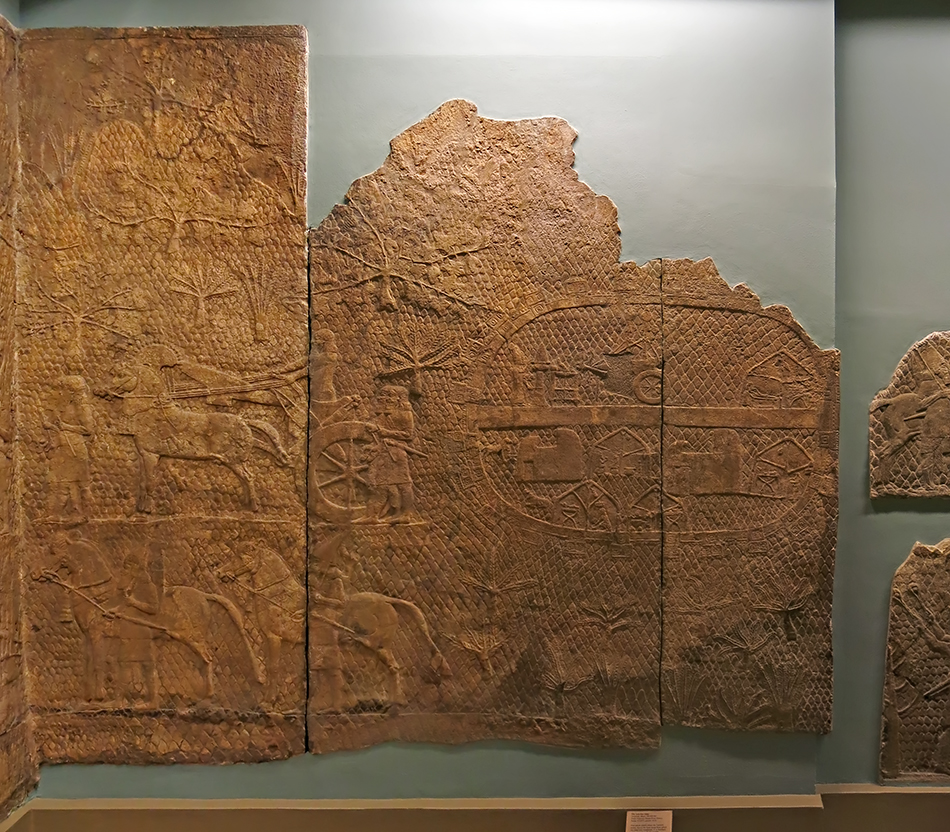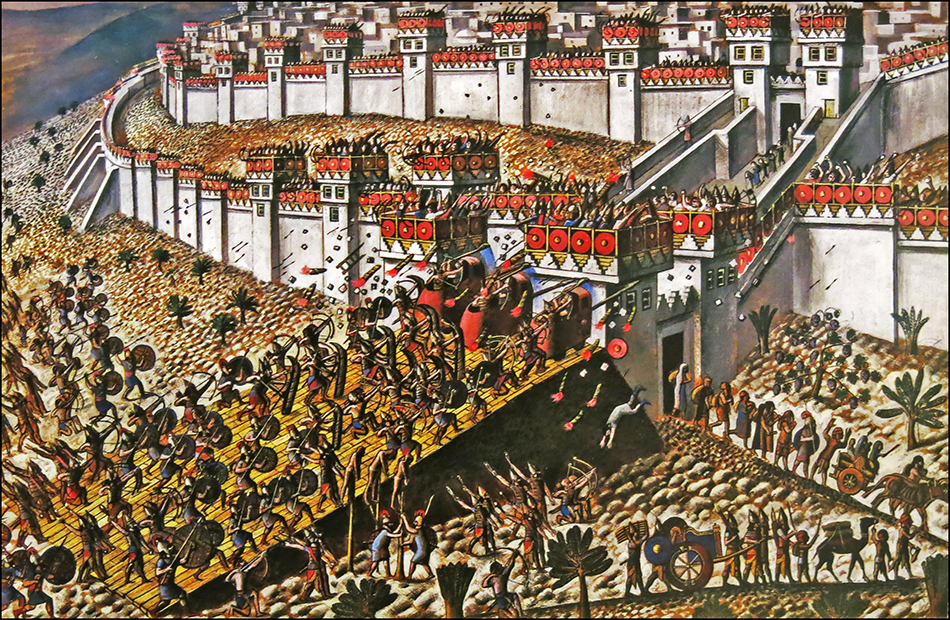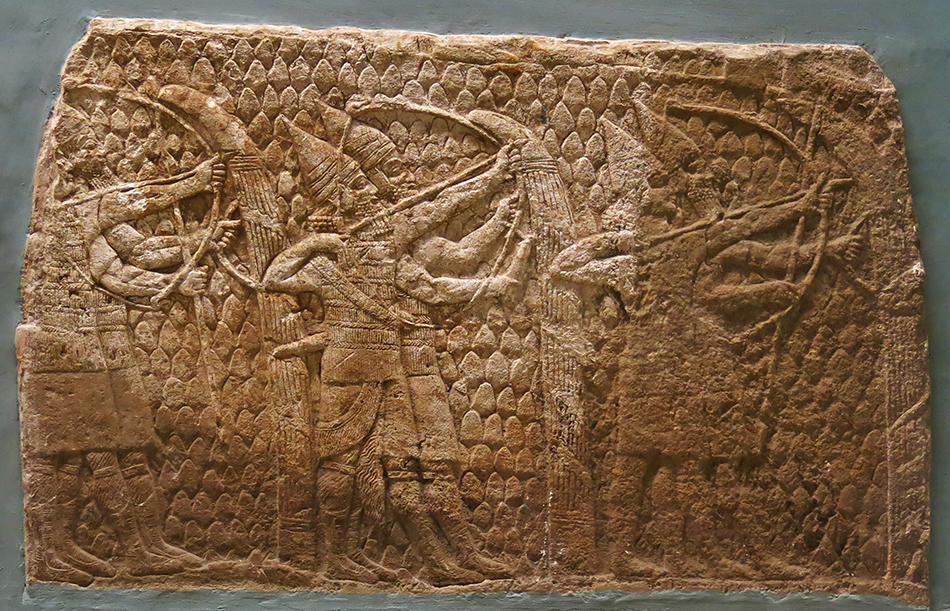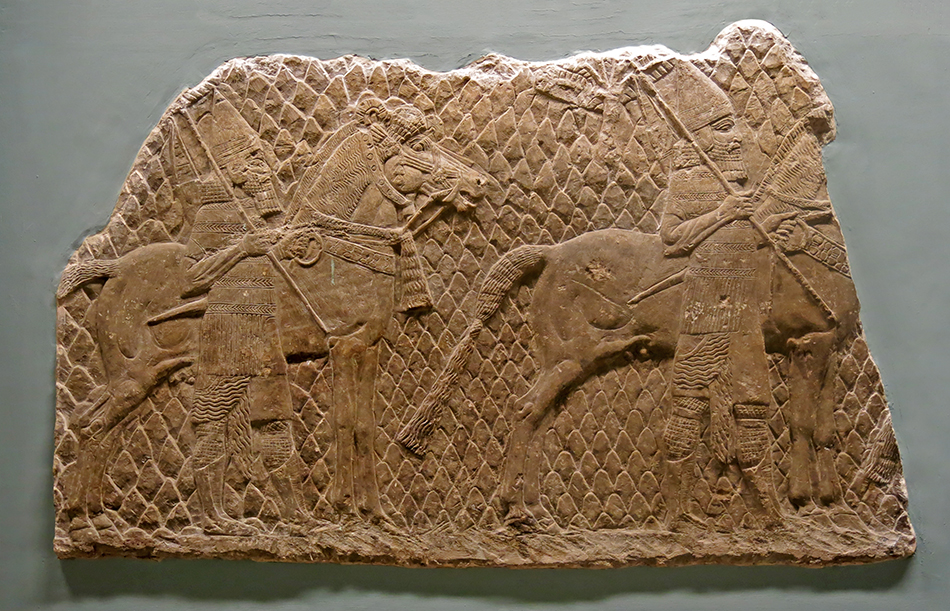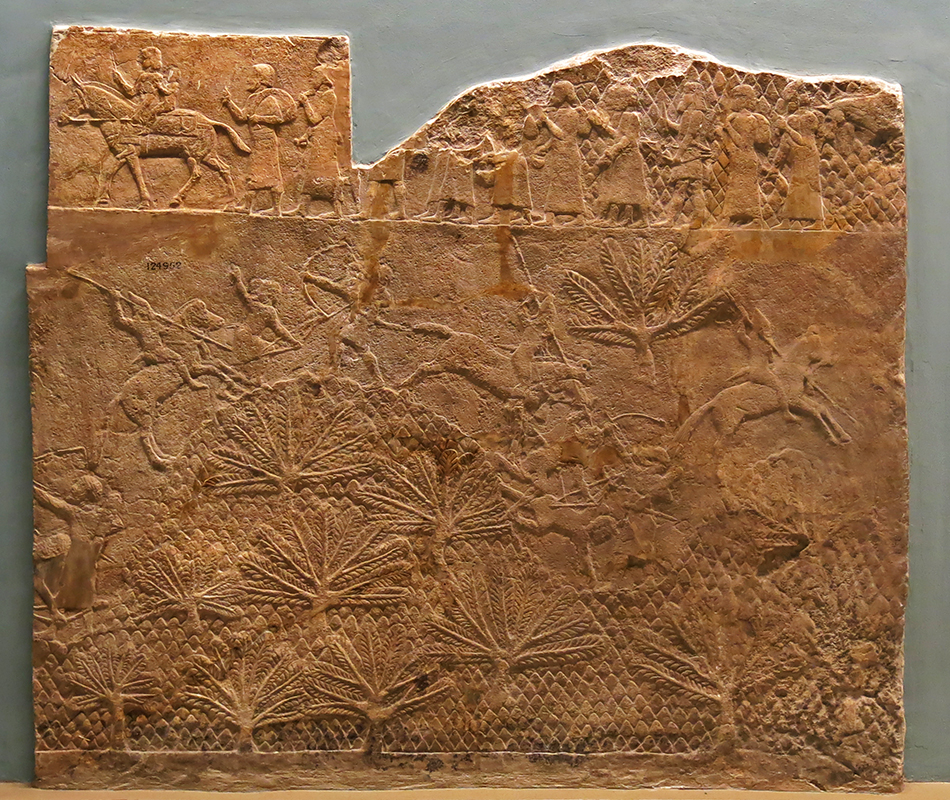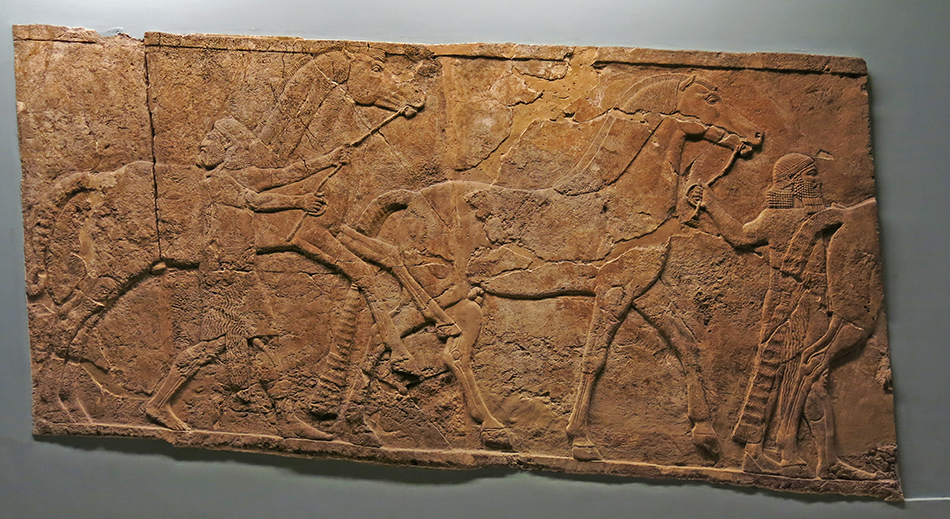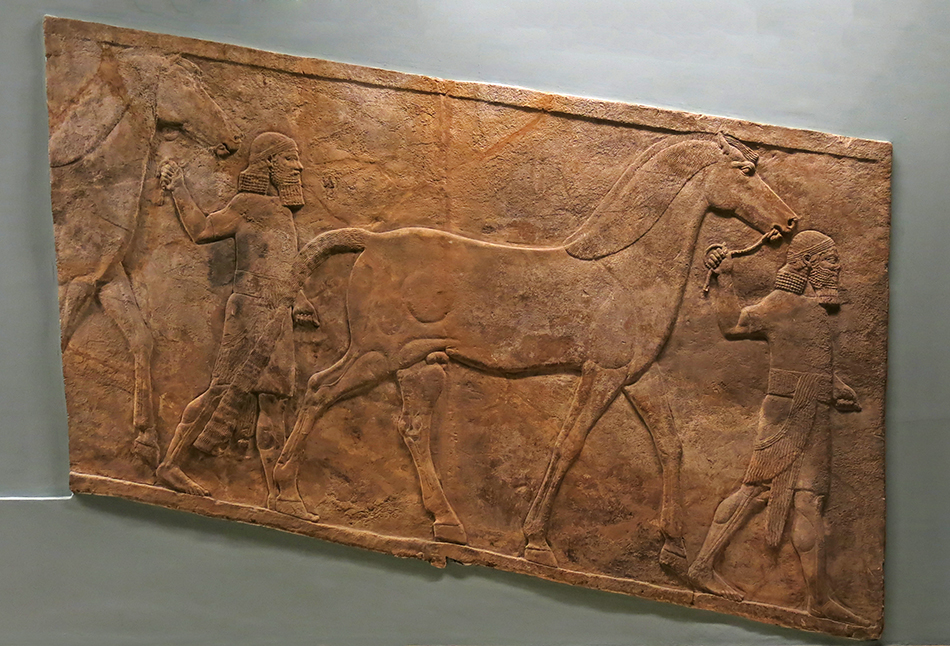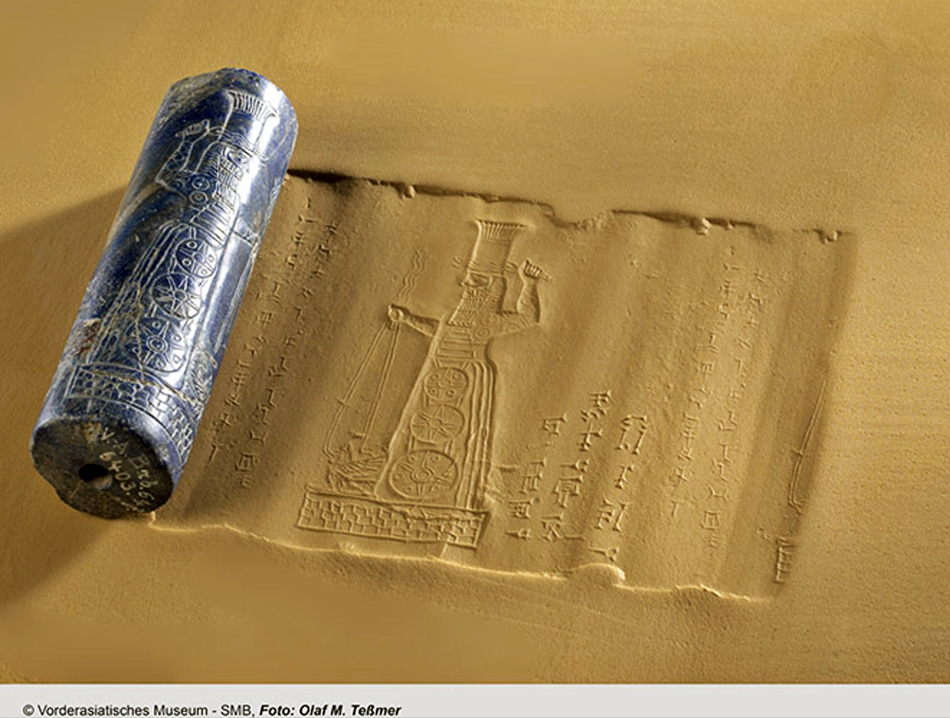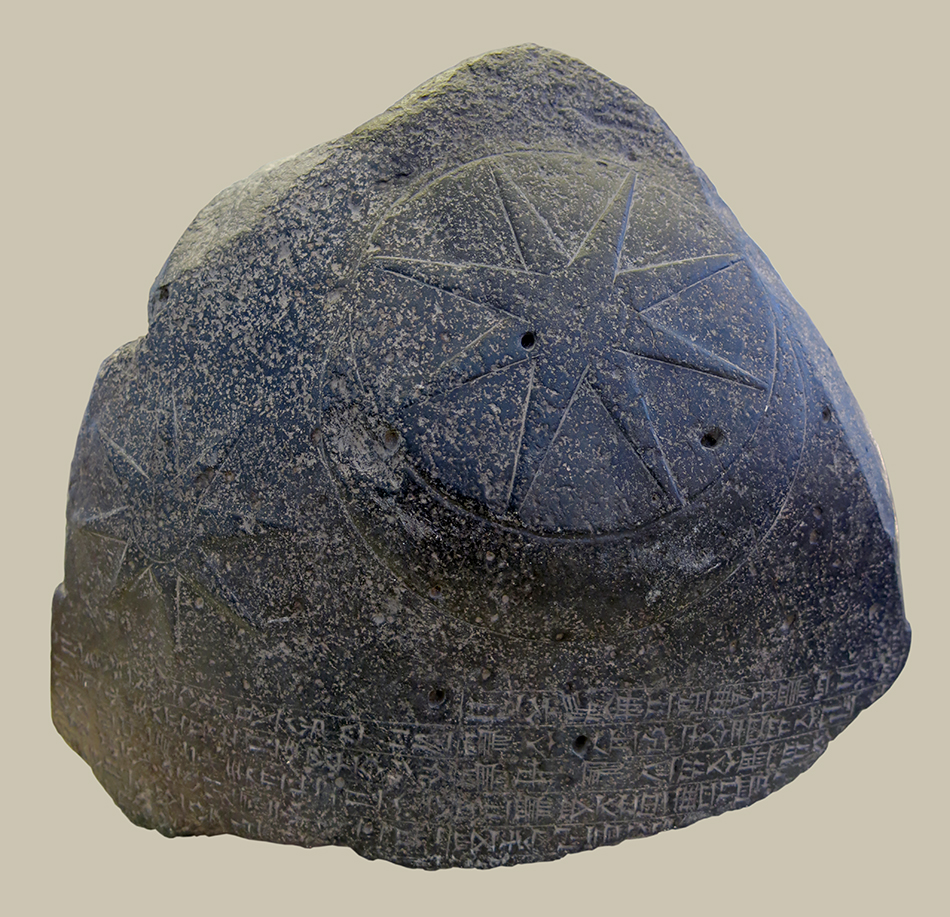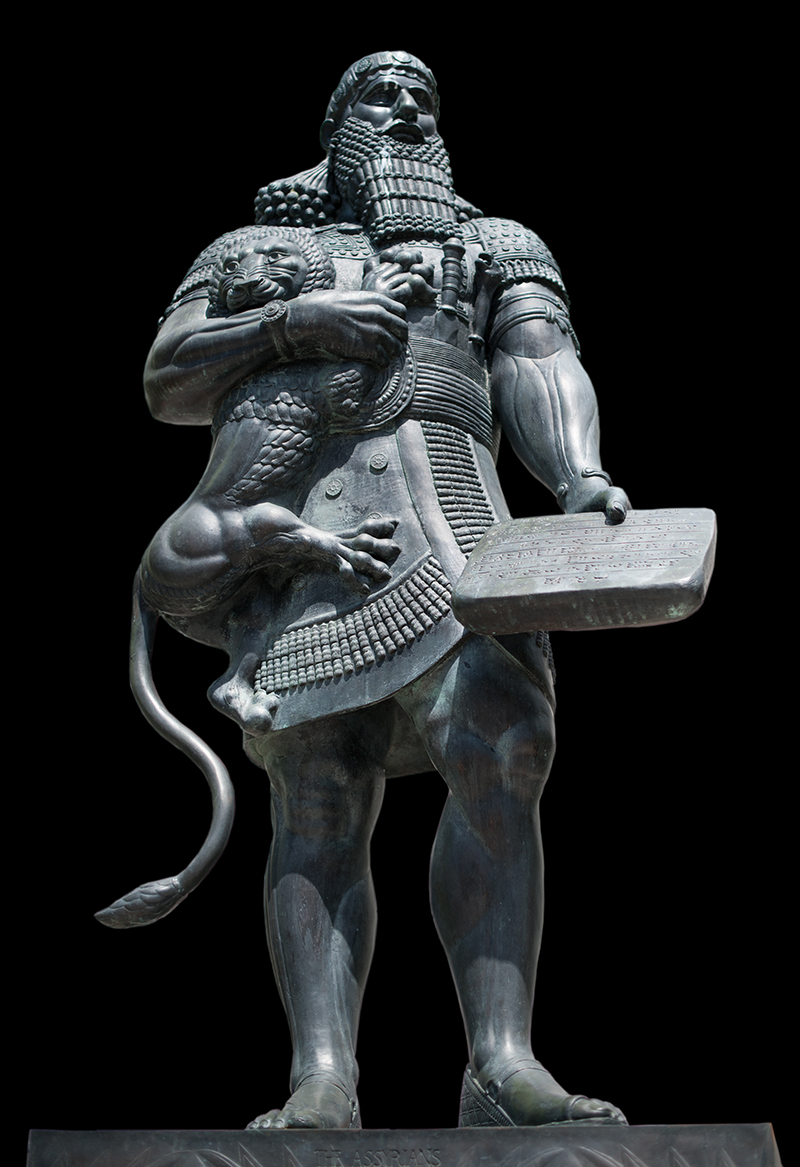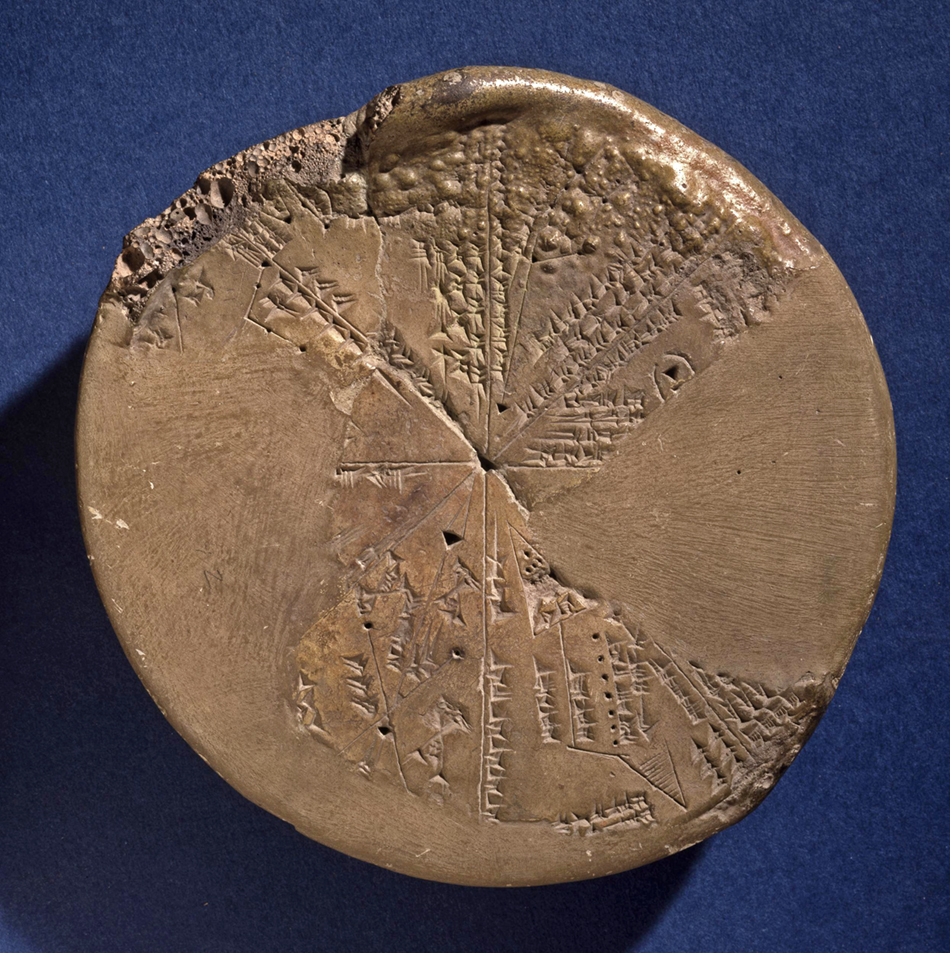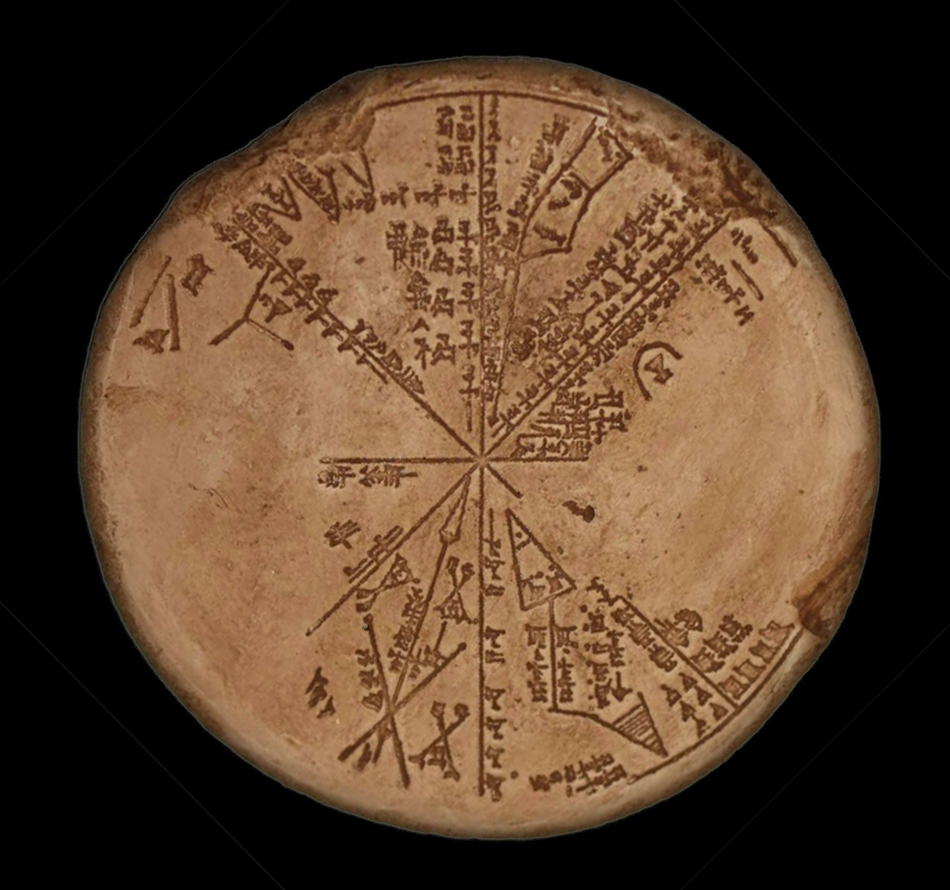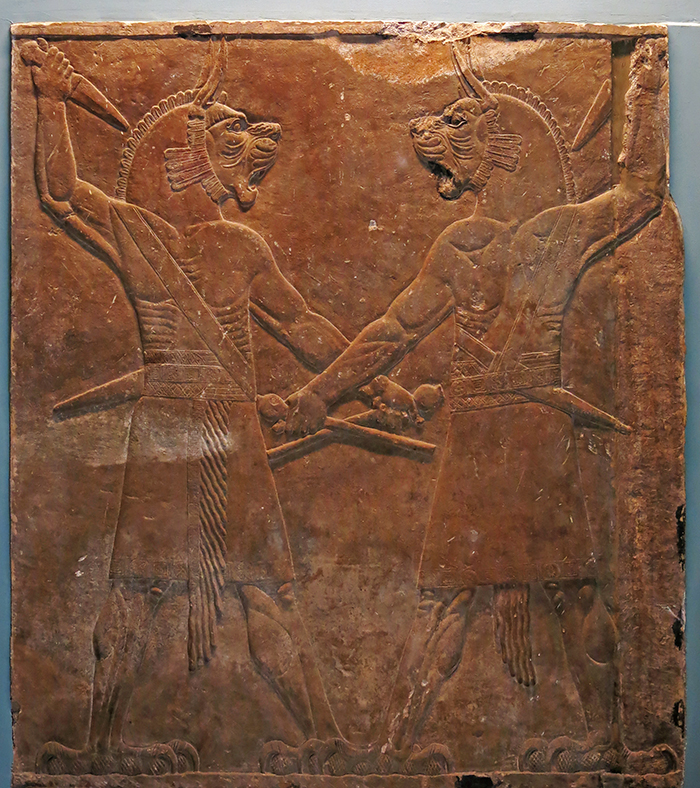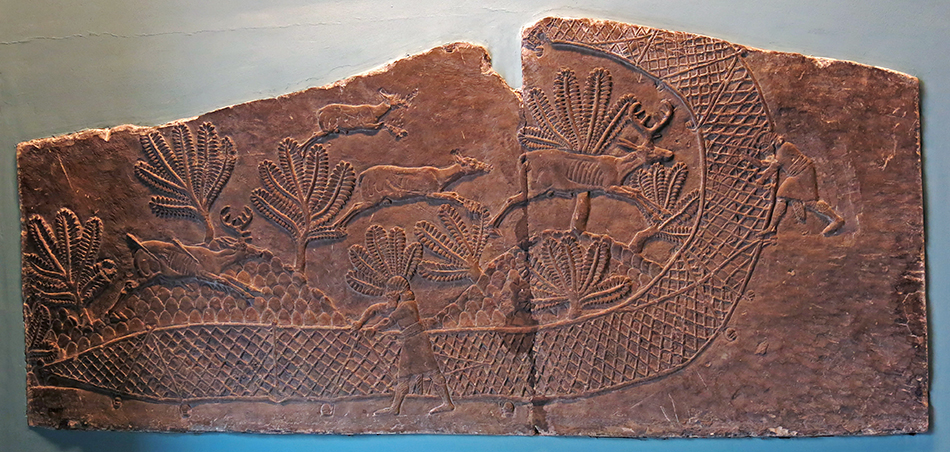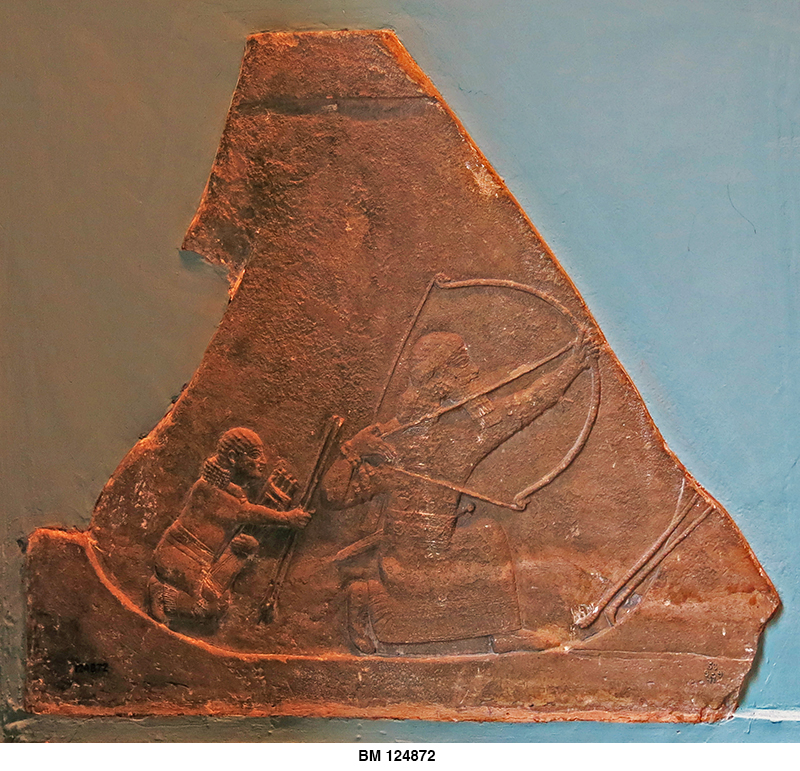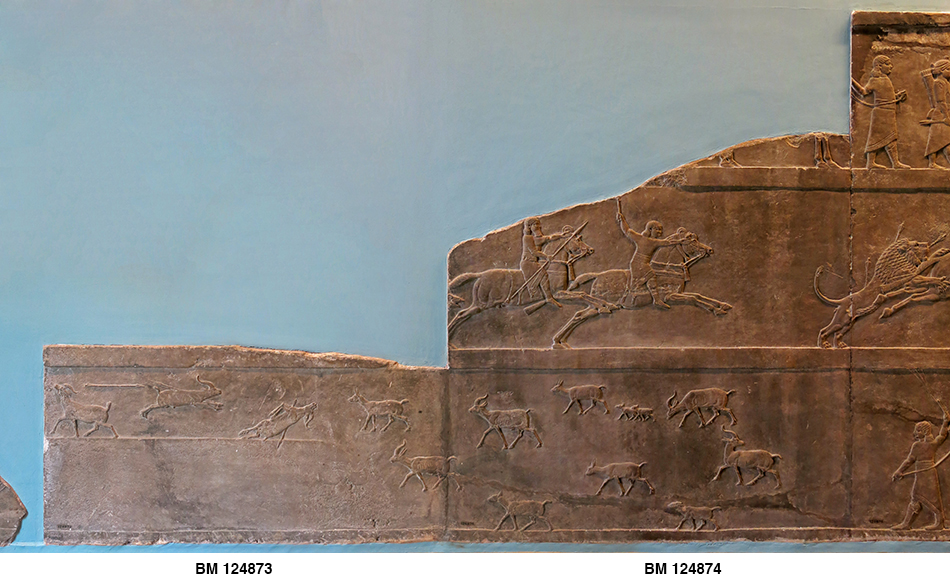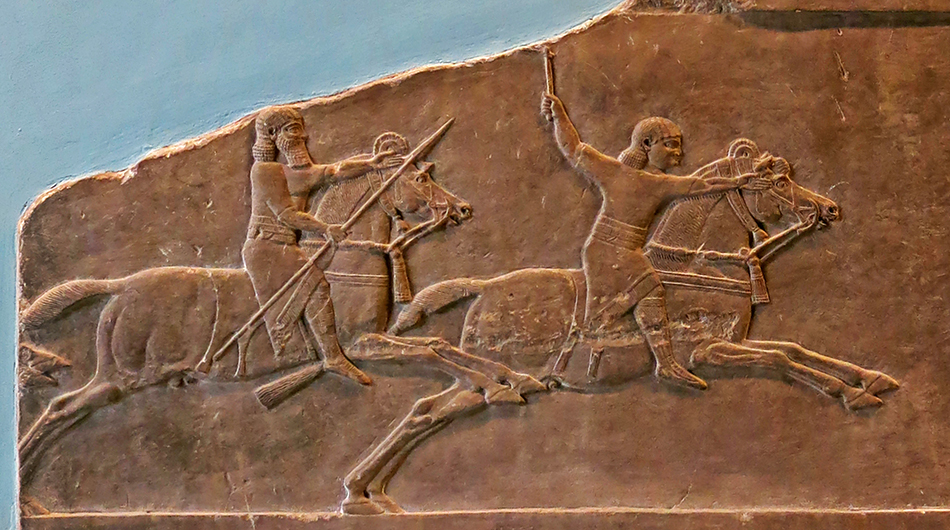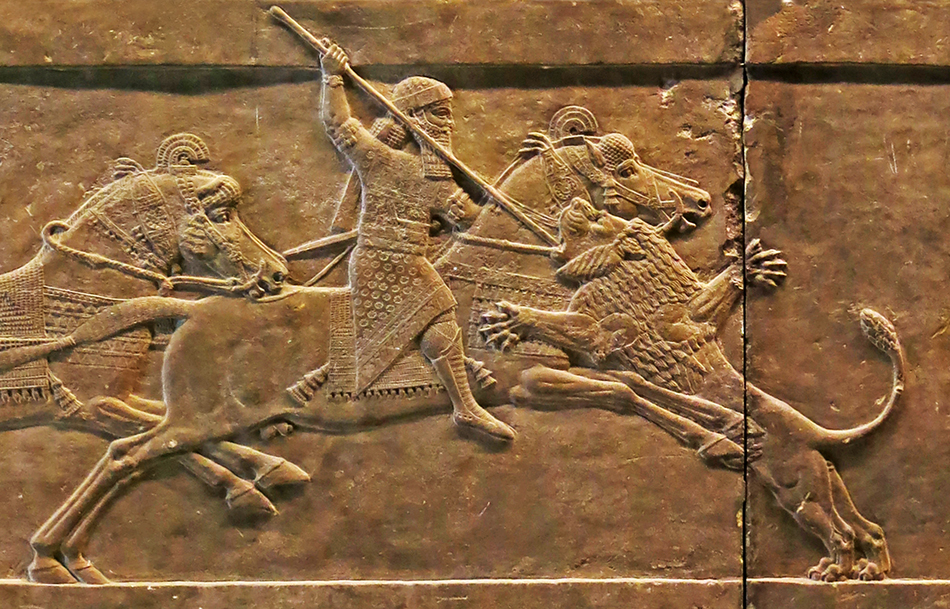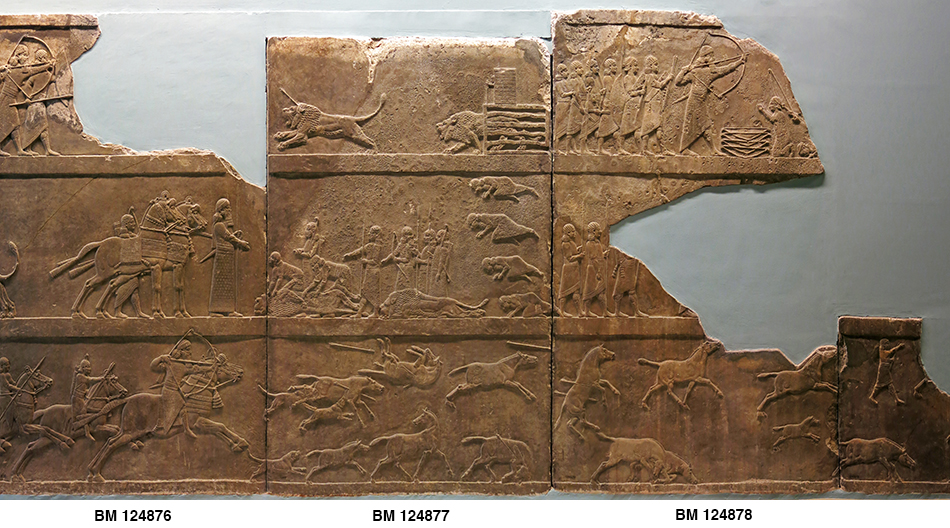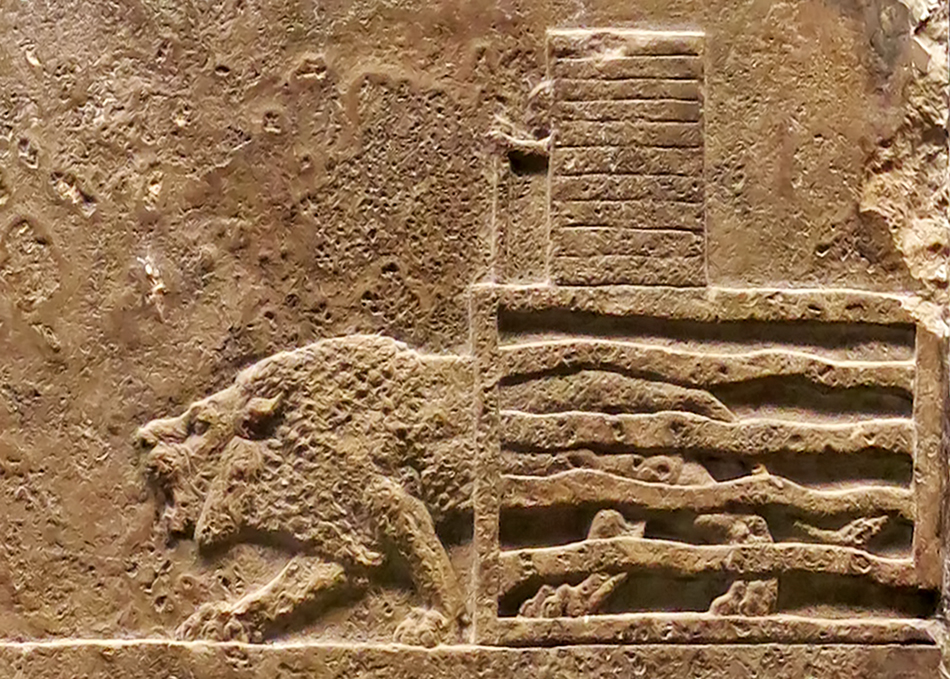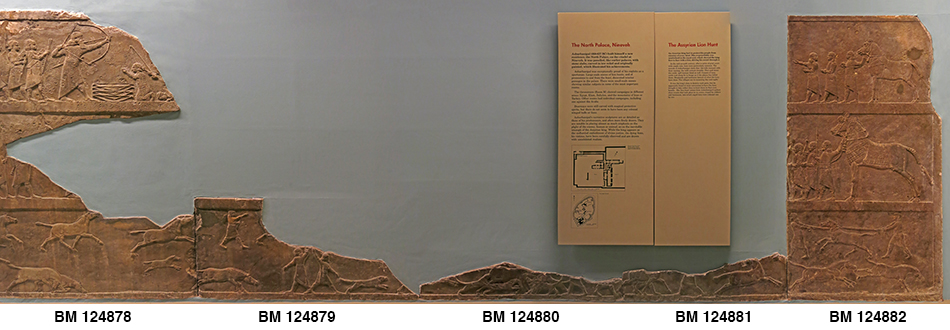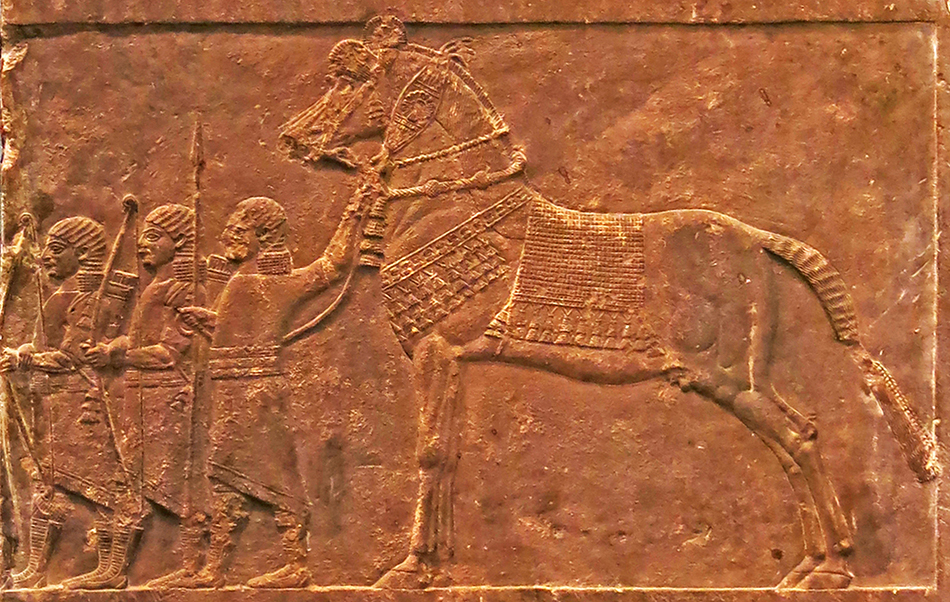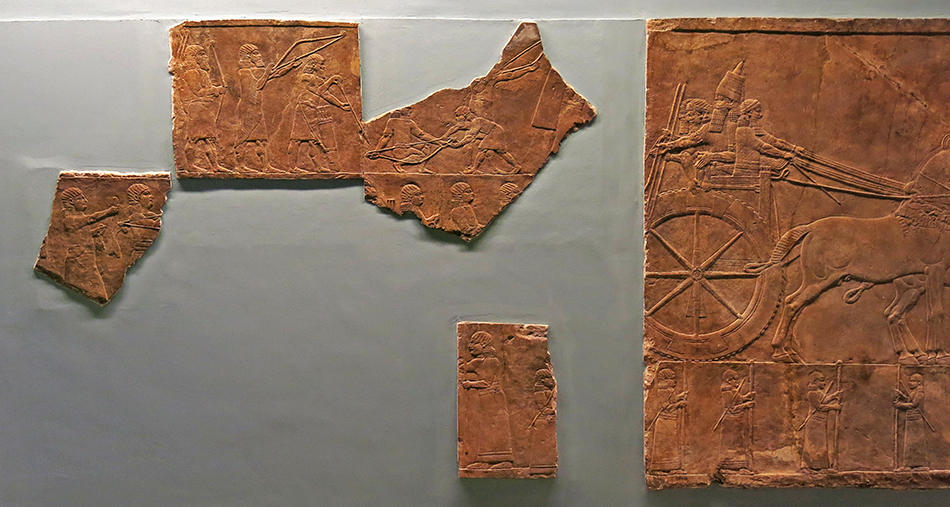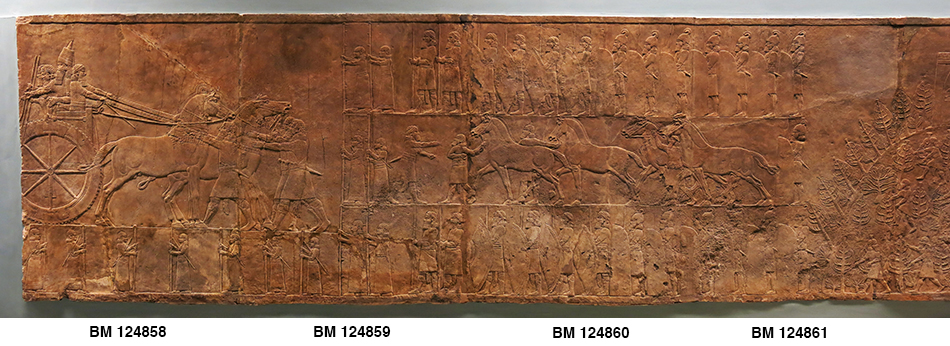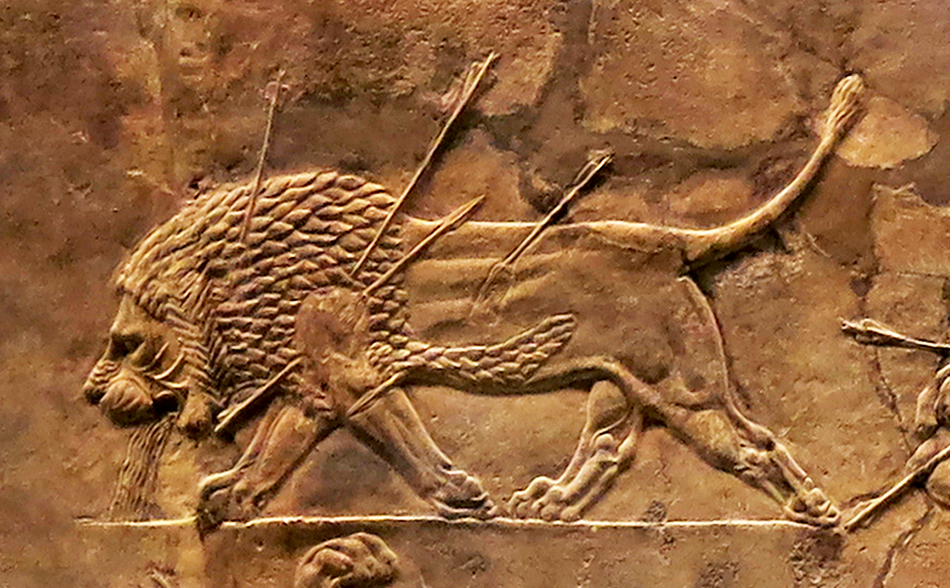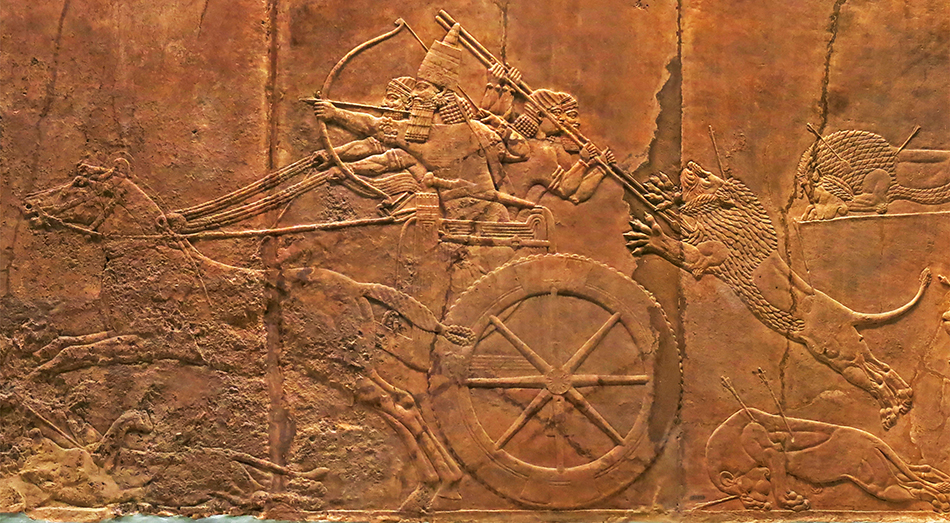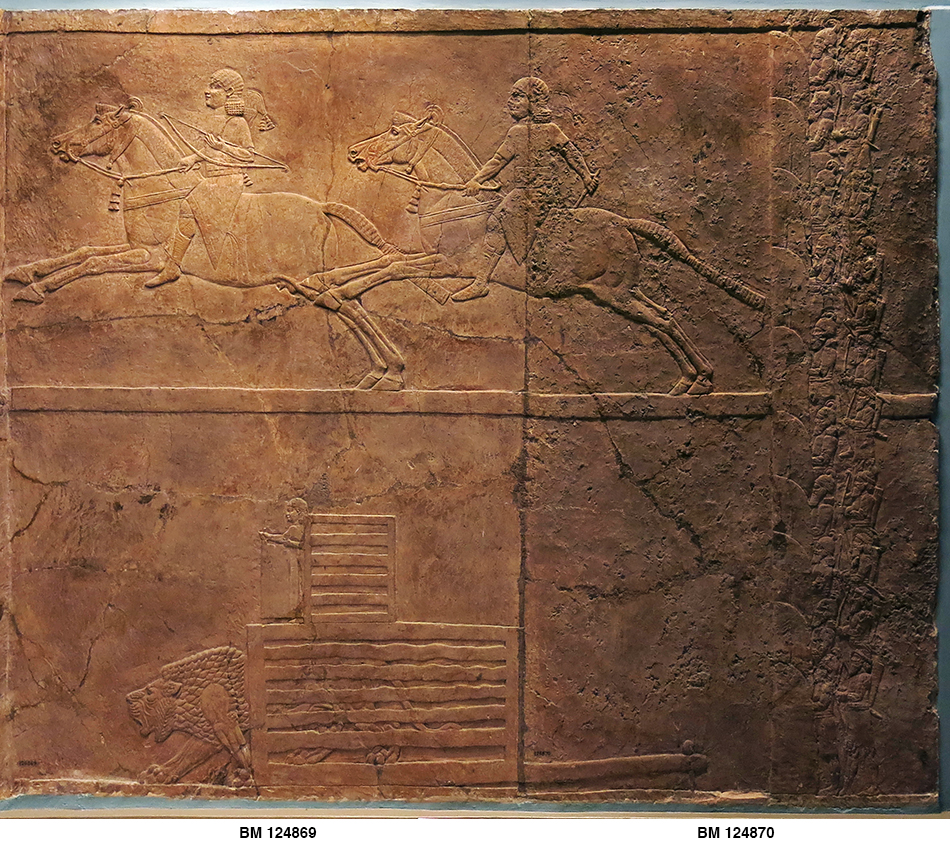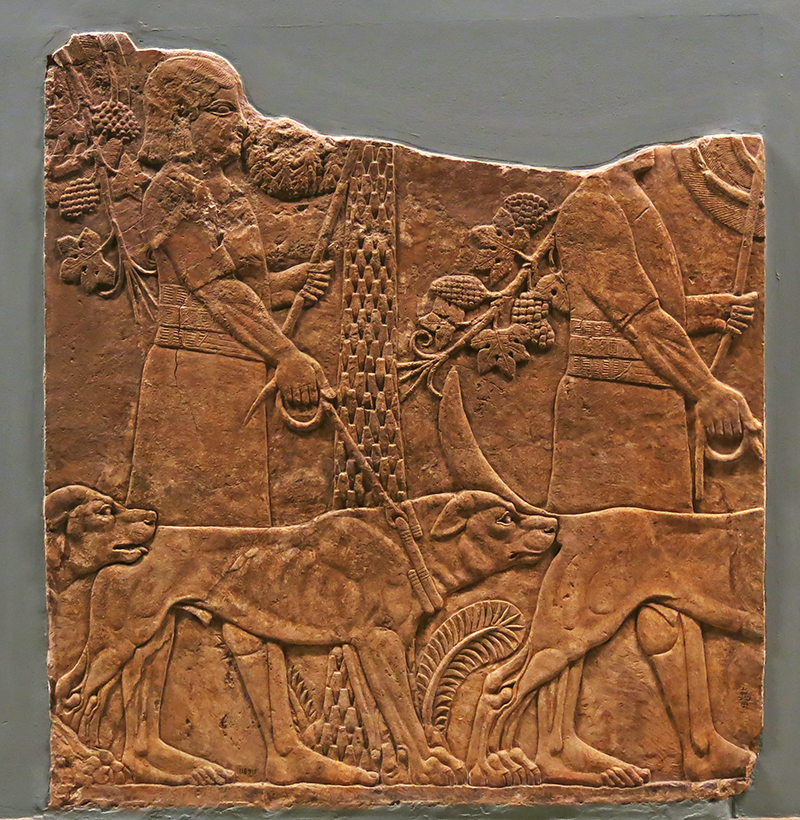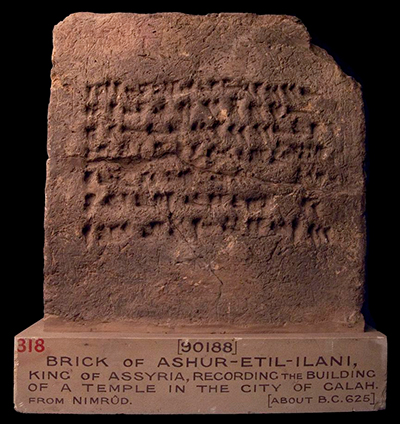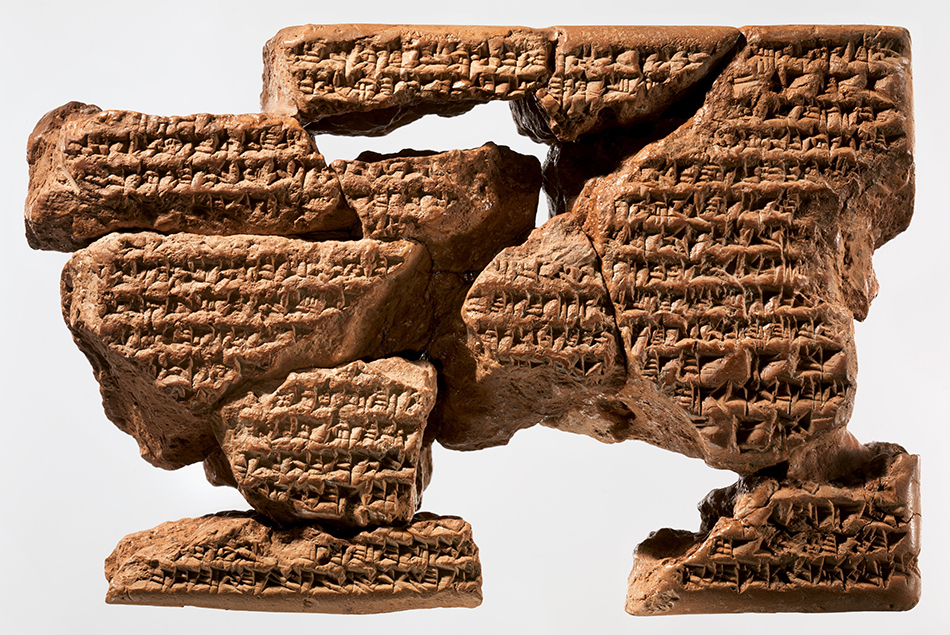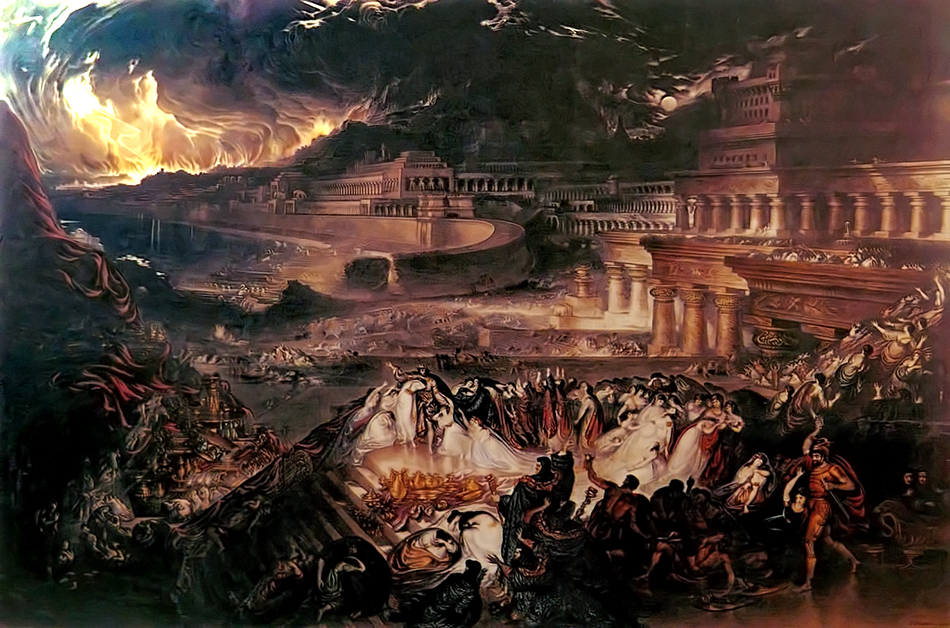Back to Don's Maps
 Back to Archaeological Sites
Back to Archaeological Sites
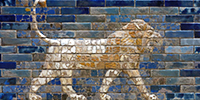 The Ishtar Gate at Babylon
The Ishtar Gate at Babylon
 Ancient Mesopotamia
Ancient Mesopotamia
The Neo-Assyrian
Artefacts from the Neo-Assyrian
The Neo-Assyrian Empire was a powerful state that existed in the ancient Near East from 911 BC to 609 BC. It was the largest empire in the world at the time and covered much of modern-day Iraq, Syria, and parts of Iran, Turkey, and Egypt. The Neo-Assyrians were known for their military might, efficient administration, and innovative use of technology, including the development of siege warfare and the use of iron weapons. They also had a well-organised system of government, with a king who had absolute power and a bureaucracy that helped him govern.
One of the most notable achievements of the Neo-Assyrians was their expansion of the empire through military conquest. They employed a standing army, which was one of the largest and most well-trained in the ancient world. The army was divided into specialised units, such as archers, infantry, and charioteers, and was equipped with advanced weapons and tactics. The Neo-Assyrians also developed a reputation for their brutal treatment of conquered peoples, often employing mass deportations and massacres to ensure obedience.
Despite their military might, the Neo-Assyrians were also known for their cultural achievements, particularly in the fields of art, literature, and science. They were great patrons of the arts and architecture, and built impressive structures such as the palace of King Sargon II at Dur-Sharrukin. They also produced great works of literature, including the epic of Gilgamesh, and made significant advances in science and medicine, with scholars producing important works on astronomy, mathematics, and the human body.
Map of the area of the Neo-Assyrian Empire.
Photo: Staatliche Museen zu Berlin - Vorderasiatisches Museum, Ausführung: Christoph Forster, datalina
Source: Staatliche Museen zu Berlin, Pergamonmuseum
| Kings of Neo-Assyria | ||||
|---|---|---|---|---|
| Name | Clickable Image |
Years | Dates | Comments |
| Ashur-dan II | 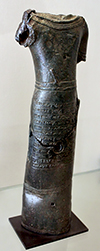 |
23 | 934 BC - 912 BC | Ashur-Dan II, son of Tiglath Pileser II, was the earliest king of the Neo-Assyrian Empire. He was best known for recapturing previously held Assyrian territory and restoring Assyria to its natural borders, from Tur Abdin (southeast Turkey) to the foothills beyond Arbel (Iraq). The reclaimed territory through his conquest was fortified with horses, ploughs, and grain stores. His military and economic expansions benefited four subsequent generations of kings that replicated his model. Ashur-Dan was the first king to conduct regular military campaigns in over a century. His military campaigns primarily focused on northern territories along mountainous terrain that made controlling it problematic. These areas were vital because they lay close to the Assyrian heartland and thus were vulnerable to enemy attacks. |
| Adad-nirari II |  |
21 | 911 BC - 891 BC | Adad-nirari firmly subjugated the areas previously under only nominal Assyrian vassalage, conquering and deporting troublesome Arameans. After subduing Neo-Hittite and Hurrian populations in the north, Adad-nirari II then twice attacked and defeated Shamash-mudammiq of Babylonia. He also campaigned to the west, subjugating the Aramean cities of Kadmuh and Nisibin. Along with vast amounts of treasure collected, he also secured the Kabur river region. His reign was a period of returning prosperity to the Middle East region following expansion of Phoenician and Aramaean trade routes, linking Anatolia, Egypt under the Libyan 22nd Dynasty, Mesopotamia and the Mediterranean. |
| Tukulti-Ninurta II | 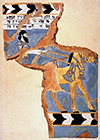 |
7 | 890 BC - 884 BC | Tukulti-Ninurta consolidated the gains made by his father over the Neo-Hittites, Babylonians and Arameans, and successfully campaigned in the Zagros Mountains of Iran, subjugating the newly arrived Iranian peoples of the area, the Persians and Medes, during his brief reign. Tukulti-Ninurta II was victorious over Ammi-Ba'al, the king of Bit-Zamani, and then entered into a treaty with him, as a result of which Bit-Zamani became an ally, and in fact a vassal of Assyria. Tukulti-Ninurta II developed both Nineveh and Assur, in which he improved the city walls, built palaces and temples and decorated the gardens with scenes of his military achievements. |
| Ashurnasirpal II | 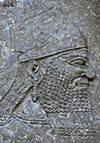 |
25 | 883 BC - 859 BC | During his reign he embarked on a vast program of expansion, first conquering the peoples to the north in Asia Minor as far as Nairi and exacting tribute from Phrygia, then invading Aram (modern Syria), conquering the Aramaeans and Neo-Hittites between the Khabur and the Euphrates Rivers. His harshness prompted a revolt that he crushed decisively in a pitched, two-day battle. The palaces, temples and other buildings raised by him bear witness to a considerable development of wealth and art. He was renowned for his brutality, using enslaved captives to build a new Assyrian capital at Kalhu (Nimrud) in Mesopotamia where he built many impressive monuments. He was also a shrewd administrator, who realised that he could gain greater control over his empire by installing Assyrian governors, rather than depending on local client rulers paying tribute. |
| Shalmaneser III | 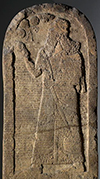 |
35 | 858 BC - 824 BC | Shalmaneser III expanded the Assyrian Empire to include parts of modern-day Turkey, Iran, and Syria. He was known for his military campaigns, which he recorded on the Black Obelisk, a monument that lists the kings he defeated and tribute he received. One of Shalmaneser's most significant military campaigns was against the state of Urartu, located in modern-day Armenia. He attacked Urartu several times, almost every year of his reign, and eventually defeated the Urartian king Sarduri II in 843 BC. Shalmaneser also campaigned against the Aramaean states, including Damascus and Israel. He besieged Damascus twice but was unable to capture it. However, his campaigns weakened the Aramaean states and allowed Assyria to gain control over them. Shalmaneser was also known for his building projects, including the construction of the Central Palace at Nimrud. The palace was decorated with reliefs depicting scenes from Shalmaneser's military campaigns and showed his power and authority as the king of Assyria. He also built several temples in his honour, including the temple of Ninurta at Kalhu. |
| Shamshi-Adad V | 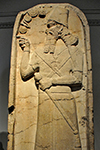 |
13 | 823 BC - 811 BC | The first years of Shamshi-Adad's reign saw a serious struggle for the succession of the aged Shalmaneser. The revolt was led by Shamshi-Adad's brother Assur-danin-pal, and had broken out already by 826 BC. The rebellious brother, according to Shamshi-Adad's own inscriptions, succeeded in bringing to his side 27 important cities, including Nineveh. The rebellion lasted until 820 BC, weakening the Assyrian empire and its ruler. Later in his reign, Shamshi-Adad campaigned against Southern Mesopotamia, and signed a treaty with the Babylonian king Marduk-zakir-shumi I. In 814 BC, he won the Battle of Dur-Papsukkal against the Babylonian king Marduk-balassu-iqbi, and a few Aramean tribes settled in Babylonia. The extent of Shamshi-Adad's victory was such that he obtained the submission of the Babylonian king and, after obtaining booty from several Babylonian cities, he returned to Assyria with palace treasures and sacred statues of gods. |
| Adad-nirari II | 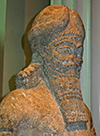 |
28 | 810 BC - 783 BC | Adad-nirari's youth at the time of his ascension to the throne, and the struggles his father had faced early in his reign, caused a serious weakening of Assyrian rulership over their indigenous Mesopotamia, and made way for the ambitions of officers, governors, and local rulers. He led several military campaigns with the purpose of regaining the strength Assyria enjoyed in the times of his grandfather Shalmaneser III. He was the builder of the temple of Nabu at Nineveh. Among his actions was a siege of Damascus in the time of Ben-Hadad III in 796 BC, which led to the eclipse of the Aramaean Kingdom of Damascus and allowed the recovery of Israel under Jehoash (who paid the Assyrian king tribute at this time) and Jeroboam II. Despite Adad-nirari's vigour, Assyria entered a several decades long period of weakness following his death. |
| Shalmaneser IV | 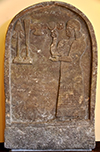 |
10 | 782 BC - 773 BC | The accession of Shalmaneser IV marks the beginning of an obscure period in Assyrian history, from which little information survives. This period also extends throughout the reigns of his two immediate successors, his brothers Ashur-dan III and Ashur-nirari V. By the end of Adad-nirari III's reign, the Neo-Assyrian Empire was declining. In particular, the power of the king himself was being threatened due to the emergence of extraordinarily powerful officials, whom while they accepted the authority of the Assyrian monarch in practice acted with supreme authority themselves and began to issue their own inscriptions, similar to those of the kings. This arrangement continued during the reign of Shalmaneser and his immediate successors, a time from which inscriptions from such officials are more common than inscriptions by the kings themselves. At the same time, the enemies of Assyria grew stronger and more threatening. This period of Assyrian decline coincided with the peak of the northern Kingdom of Urartu. |
| Ashur-dan III | 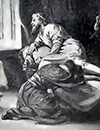 |
18 | 772 BC - 755 BC | Ashur-dan ruled during a period of Assyrian decline from which few sources survive. As such, his reign, other than the broad political developments, is poorly known. At this time, the Assyrian officials were becoming increasingly powerful relative to the king and at the same time, Assyria's enemies were growing more dangerous. Ashur-dan's reign was a particularly difficult one as he was faced with two outbreaks of plague and five of his eighteen years as king were devoted to putting down revolts. |
| Ashur-nirari V | 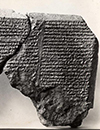 |
10 | 754 BC - 745 BC | Like his predecessor, Ashur-nirari ruled during a period of Assyrian decline from which few sources survive. An unusually small share of Ashur-nirari's reign was devoted to campaigns against foreign enemies, perhaps suggesting domestic political instability within Assyria. In 746 or 745 BC, there are records of a revolt in Nimrud, the Assyrian capital. |
| Tiglath-pileser III | 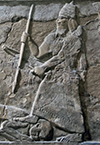
|
18 | 744 BC - 727 BC | Tiglath-pileser was one of the most prominent and historically significant Assyrian kings. He ended a period of Assyrian stagnation, introduced numerous political and military reforms and more than doubled the lands under Assyrian control. Because of the massive expansion and centralisation of Assyrian territory and establishment of a standing army, some researchers consider Tiglath-Pileser's reign to mark the true transition of Assyria into an empire. The reforms and methods of control introduced under Tiglath-Pileser laid the groundwork for policies enacted not only by later Assyrian kings but also by later empires for millennia after his death. Tiglath-Pileser early on increased royal power and authority through curbing the influence of prominent officials and generals. After securing some minor victories in 744 and 743, he defeated the Urartian king Sarduri II in battle near Arpad in 743. After defeating Sarduri, Tiglath-Pileser turned his attention to the Levant. Over the course of several years, Tiglath-Pileser conquered most of the Levant, defeating and then either annexing or subjugating previously influential kingdoms, notably ending the kingdom of Aram-Damascus. Tiglath-Pileser's activities in the Levant were recorded in the Hebrew Bible. After a few years of conflict, Tiglath-Pileser conquered Babylonia in 729, becoming the first king to rule as both king of Assyria and king of Babylon. |
| Shalmaneser V | 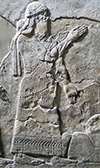
|
5 | 726 BC - 722 BC | Shalmaneser campaigned extensively in the lands west of the Assyrian heartland, warring not only against the Israelites, but also against the Phoenician city-states and against kingdoms in Anatolia. Though he successfully annexed some lands to the Assyrian Empire, his campaigns resulted in long and drawn-out sieges lasting several years, some being unresolved at the end of his reign. The circumstances of his deposition and death are not clear, though they were likely violent, and it is unlikely that Sargon II was his legitimate heir. It is possible that Sargon II was entirely unrelated, which would make Shalmaneser V the final king of the Adaside dynasty, which had ruled Assyria for almost a thousand years. |
| Sargon II | 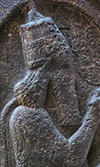
|
17 | 721 BC - 705 BC | Modelling his reign on the legends of the ancient rulers Sargon of Akkad, from whom Sargon II likely took his regnal name, and Gilgamesh, Sargon aspired to conquer the known world, initiate a golden age and a new world order, and be remembered and revered by future generations. Over the course of his seventeen-year reign, Sargon substantially expanded Assyrian territory and enacted important political and military reforms. An accomplished warrior-king and military strategist, Sargon personally led his troops into battle. By the end of his reign, all of his major enemies and rivals had been either defeated or pacified. Among Sargon's greatest accomplishments were the stabilisation of Assyrian control over the Levant, the weakening of the northern kingdom of Urartu, and the reconquest of Babylonia. From 717 to 707, Sargon constructed a new Assyrian capital named after himself, Dur-Sharrukin ('Fort Sargon'), which he made his official residence in 706. |
| Sennacherib | 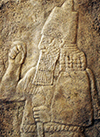
|
24 | 704 BC - 681 BC | The second king of the Sargonid dynasty, Sennacherib is one of the most famous Assyrian kings for the role he plays in the Hebrew Bible, which describes his campaign in the Levant. (II Kings, II Chronicles, and Isaiah). Although Sennacherib was one of the most powerful and wide-ranging Assyrian kings, he faced considerable difficulty in controlling Babylonia, which formed the southern portion of his empire. Because Babylon, had been the target of most of his military campaigns and had caused the death of his son, Sennacherib destroyed the city in 689 BC. Sennacherib transferred the capital of Assyria to Nineveh, where he had spent most of his time as crown prince. To transform Nineveh into a capital worthy of his empire, he launched one of the most ambitious building projects in ancient history. He expanded the size of the city and constructed great city walls, numerous temples and a royal garden. His most famous work in the city is the Southwest Palace, which Sennacherib named his 'Palace without Rival'. In 681 BC, he was murdered by two of his sons who hoped to seize the throne, but another son, Esarhaddon raised an army and seized Nineveh, installing himself as king as intended by Sennacherib. |
| Esarhaddon | 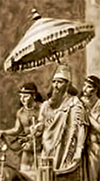
|
12 | 680 BC - 669 BC | Esarhaddon is most famous for his conquest of Egypt in 671 BC, which made his empire the largest the world had ever seen, and for his reconstruction of Babylon, which had been destroyed by his father. After a very difficult ascension to the throne, Esarhaddon was plagued by paranoia and mistrust for his officials, governors and male family members until the end of his reign. As a result of this paranoia, most of the palaces used by Esarhaddon were high-security fortifications located outside of the major population centres of the cities. Also perhaps resulting from his mistrust for his male relatives, Esarhaddon's female relatives, such as his mother Naqiʾa and his daughter Serua-eterat, were allowed to wield considerably more influence and political power during his reign than women had been allowed in any previous period of Assyrian history. Despite a relatively short and difficult reign, and being plagued by paranoia, depression and constant illness, Esarhaddon remains recognised as one of the greatest and most successful Assyrian kings. He quickly defeated his brothers in 680, completed ambitious and large-scale building projects in both Assyria and Babylonia, successfully campaigned in Media, the Arabian Peninsula, Anatolia, the Caucasus, and the Levant, defeated and conquered Lower Egypt, and ensured a peaceful transition of power to his Ashurbanipal after his death. |
| Ashurbanipal | 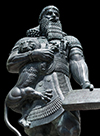
|
38 | 668 BC - 631 BC | Ashurbanipal is generally remembered as the last great king of Assyria. Inheriting the throne as the favoured heir of his father Esarhaddon, Ashurbanipal's 38-year reign was among the longest of any Assyrian king. Though sometimes regarded as the apogee of ancient Assyria, his reign also marked the last time Assyrian armies waged war throughout the ancient Near East and the beginning of the end of Assyrian dominion over the region. Much of the early years of Ashurbanipal's reign was spent fighting rebellions in Egypt, which had been conquered by his father. Much of Ashurbanipal's late reign is poorly known. Ashurbanipal is chiefly remembered today for his cultural efforts. A patron of artwork and literature, Ashurbanipal was deeply interested in the ancient literary culture of Mesopotamia. Over the course of his long reign, Ashurbanipal utilised the massive resources at his disposal to construct the Library of Ashurbanipal, a collection of texts and documents of various different genres. Perhaps comprising over 100 000 texts at its height, the Library of Ashurbanipal was not surpassed until the construction of the Library of Alexandria. |
| Ashur-etil-ilani | 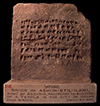
|
8 | 630 BC - 623 BC | The spread of inscriptions by Ashur-etil-ilani in Babylonia suggest that he exercised the same amount of control in the southern provinces as his father Ashurbanipal had, having a vassal king (Kandalanu) but exercising actual political and military power there himself. His inscriptions are known from all the major cities, including Babylon, Dilbat, Sippar and Nippur. Too few inscriptions of Ashur-etil-ilani survive to make any certain assumptions about his character. Excavations of his palace at Kalhu, one of the more important cities in the empire and a former capital, may indicate that he was less boastful than his father as it had no reliefs or statues similar to those that his predecessors had used to illustrate their strength and success. There are no records of Aššur-etil-ilāni ever conducting a military campaign or going on a hunt. His Kalhu palace was quite small with unusually small rooms by Assyrian royal standards. |
| Sin-shar-ishkun | 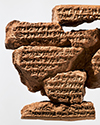
|
11 | 622 BC - 612 BC | On taking the throne, Sin-shar-ishkun was immediately faced by the revolt of one of his brother's chief generals, who attempted unsuccessfully to usurp the throne for himself. This failed attempt on the throne contributed to instability, and Sin-shar-ishkun lost control of Babylonia to Nabopolassar, who consolidated his power and formed the Neo-Babylonian Empire, restoring Babylonian independence after more than a century of Assyrian rule. This Neo-Babylonian Empire, and the newly formed Median Empire under Cyaxares, then invaded the Assyrian heartland. In 614 BC, the Medes captured and sacked Assur, the ceremonial and religious heart of the Assyrian Empire, and in 612 BC their combined armies attacked, brutally sacked, and razed Nineveh, the Assyrian capital. What doomed Assyria might have been the lack of an effective defensive plan for the Assyrian heartland, which had not been invaded in five hundred years, combined with having to face an enemy which aimed to outright destroy Assyria rather than simply conquer it. |
| Ashur-uballit II | 
|
3 | 612 BC - 609 BC | Ashur-uballit II was the final ruler of Assyria, ruling from his predecessor Sin-shar-ishkun's death at the Fall of Nineveh in 612 BC to his own defeat at Harran in 609 BC. He was possibly the son of Sin-shar-ishkun and likely the same person as a crown prince mentioned in inscriptions at the Assyrian capital of Nineveh in 626 and 623 BC. Over the course of Sin-shar-ishkun's reign, the Neo-Assyrian Empire had been irreversibly weakened. However, Ashur-uballit rallied what remained of the Assyrian army at Harran where, bolstered by an alliance with Egypt, he ruled for three years. His identification as 'king of Assyria' comes from Babylonian sources. Contemporary Assyrian inscriptions suggest that the Assyrians saw Ashur-uballit as their legitimate ruler, but continued to refer to him as 'crown prince' seeing as he could not undergo the traditional Assyrian coronation ceremony at Assur and thus hadn't formally been bestowed with the kingship by the Assyrian chief deity, Ashur. His rule at Harran came to an end when the city was seized by Medo-Babylonian forces in 610 BC. Ashur-uballit's attempt at retaking it in 609 BC was repulsed whereafter he is no longer mentioned in contemporary chronicles, signalling the end of the ancient Assyrian monarchy. |
King Ashur-dan II
Map of Assyria 1392 CC - 934 BC
This map shows the extent of the Assyrian Empire when King Ashur-dan II came to the throne. He began the process of greatly extending the Empire.
Photo: Nel Weggelaar and Jan Kort, Amsterdam, repositorio.uca.edu.ar/bitstream/123456789/16108/1/assyrian-king-list.pdf
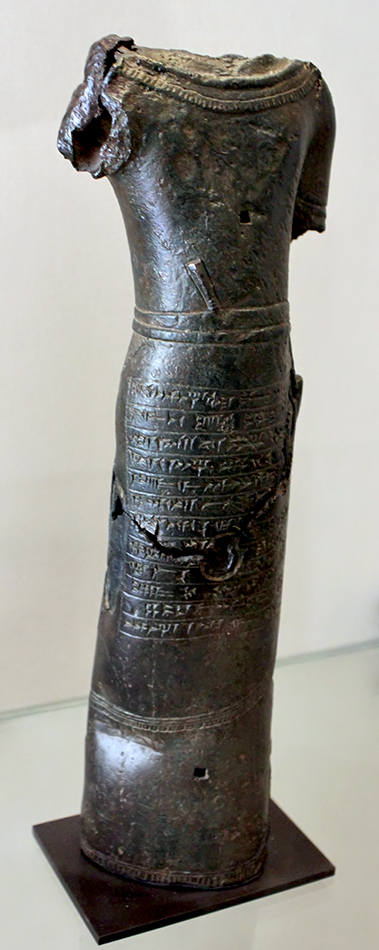
Reign of King Ashur-dan II (?) (934 BC - 912 BC)
Bronze statue
Bronze statue with inscription of King Ashur-dan, dedicated by a scribe of Ishtar of Arbeles, Shamshi-Bel. Tunic, shawl, fringe, belt, dagger.
The identity of the king is disputed: Deller and Grayson (RIMA 1 A.0.83.2001) identify him with Ashur-dan I (1178-1133 BC). The Louvre cartel indicated Ashur-dan II (933-912 BC) when the picture was taken. The Louvre database https://collections.louvre.fr/en/ark:/53355/cl010120461 does not decide between Assurdan I, II or III.
Translation in RIMA 1 (pp. 307-308): 'To the goddess Ištar, the great mistress who dwells in Egašankalamma, mistress of Arbail, [his] mistress: For the life of Aššur-dān, king of [Assyria], his [lord], Šamšī-bēl, temple scribe, son of Nergal-nädin-ahi (who was) also scribe, for his life, his well-being, and the well-being of his eldest son, dedicated and devoted (this) copper statue weighing x minas. The name of this statue is: 'O goddess Istar, to you my ear (is directed)!'.
Details on the object: Statue of Ashurdan I, II or III (?), whose arms and head have disappeared. The king is standing, dressed in a long tunic and a fringed shawl, a dagger held in his belt; inscription on the bottom of the garment.
Height 295 mm, width 103 mm, thickness 53 mm.
Catalog: Urmiah region
Photo: Zunkir
Permission: Creative Commons Attribution-Share Alike 4.0 International license.
King Adad-nirari II
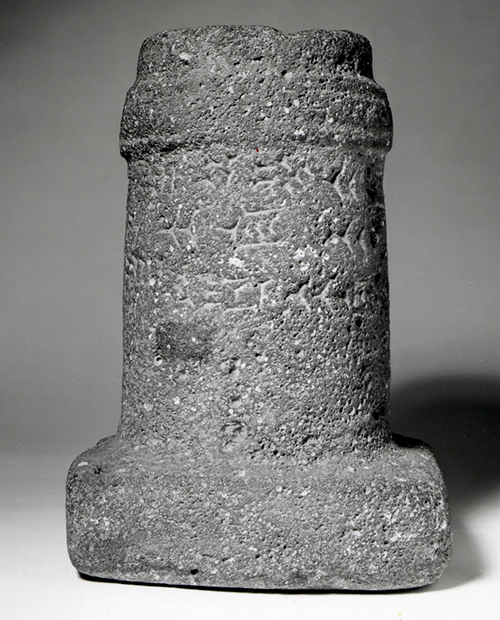
Reign of King Adad-nirari II (911 BC - 891 BC)
Basalt Pedestal
Basalt pedestal inscribed with name and titles of Adad-nirari II; probably supported a sacred pole in front of one of the temple shrines; hollow cylindrical column; inscribed.
Circa 900 BC.
Height 415 mm, width 285 mm, depth 270 mm.
Catalog: Basalt, Kouyunjik, BM/Big number 90853
Photo: Original, British Museum, http://www.britishmuseum.org/, © Trustees of the British Museum, CC BY-NC-SA 4.0
Text: Card with the display at the British Museum, http://www.britishmuseum.org/, © Trustees of the British Museum, CC BY-NC-SA 4.0
Stela, Middle Babylonian, 900 BC - 800 BC
Commemorative stone stela in the form of a boundary-stone (kudurru). The stela consists of a small boulder, on one face of which a fiat panel has been sunk, leaving figures and symbols standing out within it in low relief. The greater part of the inscription has been carved upon the flat surface of the panel, but the last seven lines extend below the panel to the base of the stone.
The stela is set up in honour of Adad-etir, the dagger-bearer of Marduk, by his eldest son. The name Marduk-balatsu-ikbi, which occurs in l. 4, is that of Adad-etir's son, not the name of the king to whom Adad-etir owed allegiance; and the two figures standing on the lower ledge of the panel represent Adad-etir and his eldest son, not Adad-etir and the king. The stele is closely related to a kudurru, since it is protected by carved symbols and by the addition of imprecatory clauses to the text. These symbols include (1) winged solar disc; (2) crescent; and (3) lion-headed mace upon a pedestal.
Findspot: Marduk Temple (Babylon)
Diameter 127 mm, height 380 mm, thickness 127 mm, width 270 mm.
Inscription translation of cuneiform: (1) (This) image of Adad-etir, the dagger-bearer of Marduk, (2) adorned by Sin, Shamash, and Nergal, (3) who fears Nabu and Marduk, who owes allegiance (4) to the king, his lord, Marduk-balatsu-ikbi, (5) his eldest son, has fashioned, (6) and for future days, (7) for his seed and his posterity, (8) has set up. (9) Whosoever in days to come (10) the image (11 f.) or this memorial-stone (13) shall destroy, (14) or by means of (15) a crafty device shall cause them to disappear, (16) may Marduk, the great lord, in anger (17) look upon him, and his name and his seed (18) may he cause to disappear! May Nabu, the scribe of all, (19) curtail the long number of his days! (20) But may the man who protects it be satisfied with the fulness of life!
Inscription note: Dedication in honour of Adad-etir, dagger-bearer of Marduk, by his son Marduk-balassu-iqbi; the text invokes curses on anyone who may deface it.
Curator's comments:
Commemorative stone stela; this object has some of the characteristics of a kudurru, including curses on anyone who may deface it, but it was set up in honour of a private individual, an official in the Marduk temple, by his son. The figures represent father and son together, and their shaven heads show that they are both priests, it being normal in ancient Mesopotamia for a son to adopt his father's profession
There are three divine symbols above the two priests: a winged solar disc representing the sun-god Shamash, a crescent of the moon-god Sin and a lion-headed mace on a pedestal.
The cuneiform inscription includes curses on anyone who may deface the stela. It translates: 'May Marduk, the great lord, in anger look upon him, and his name and his seed may he cause to disappear. May Nabu, the scribe of all, curtail the number of his days. But may the man who protects it be satisfied with the fullness of life.'
Since the fourth line of the inscription, taken from its context, contains the words 'the king his lord Marduk-balatsu-ikbi,' the stele has been traditionally assigned to the reign of Marduk-balatsu-ikbi, king of Babylon about 830 B.C.
That the two figures do not represent Adad-etir paying homage to his king is sufficiently obvious, from the absence of any royal headdress and other royal insignia from the taller figure. Further, the phrase 'ka-rib šarri-šu' is simply a descriptive title, on a par with 'si-mat (ilu)Sin (ilu)Šamaš u (ilu)Nergal' and 'pa-liḫ (ilu)Nabû u (ilu)Marduk'; the three phrases describe Adad-etir's personal endowments and his correct attitude towards divine and human authority. The writer merely refers to Adad-etir's loyalty: the name of the reigning king is immaterial and is therefore omitted.
On the other hand, Adad-etir's eldest son, who set up the stele as an act of piety, was not likely to omit his own name; and in the sculptured figures he represents himself paying homage to his father. It may be noted that the figures are dressed precisely alike, the only difference being that the father is taller than the son. Each raises one hand and rests the other on the handle of the dagger in his belt.
This stela comes from the Temple of Marduk in Babylon. It is a commemorative monument set up in honour of a private individual called Adad-etir. He was an official in the temple, known as 'the dagger bearer', and this stela was erected by his son Marduk-balassu-iqbi. The figures carved in relief on the front represent the father and son together. Their shaven heads show that they are both priests, it being normal in ancient Mesopotamia for a son to adopt his father's profession. There are three divine symbols above the two priests: a winged solar disc representing the sun-god Shamash, a crescent of the moon-god Sin and a lion-headed mace on a pedestal.
Associated names:
Named in inscription: Adad-Etir (temple official)
Named in inscription: Marduk-balassu-iqbi (Dedicator of stela)
Named in inscription: Marduk
Named in inscription: Nabu
Named in inscription: Sin
Named in inscription: Shamash
Associated places
Named in inscription: Marduk Temple (Babylon)
Asia: Middle East: Iraq: Iraq, South: Marduk Temple (Babylon)
Catalog: Diorite or granite, ME 90834
Photo: Don Hitchcock 2015
Source: Original, British Museum
Text: © Card with the display at the British Museum, © Trustees of the British Museum, CC BY-NC-SA 4.0.
King Tukulti-Ninurta II
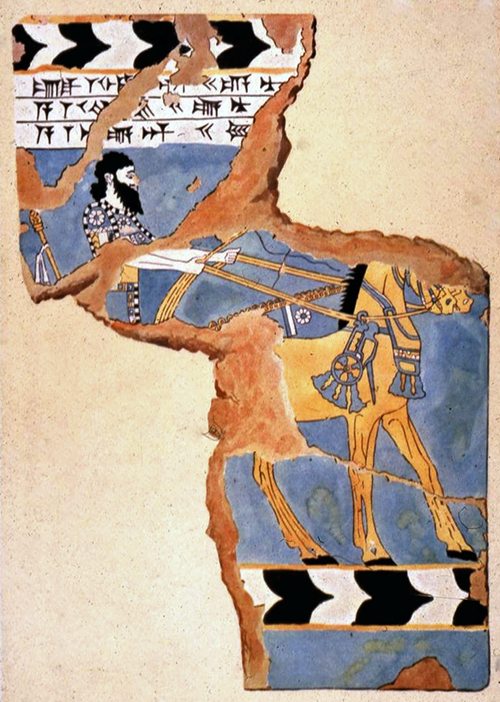
Reign of King Tukulti-Ninurta II (890 BC - 884 BC)
Wall-tile
Glazed wall-tile of fired clay showing a charioteer. There is a border of chevrons top and bottom and a cuneiform inscription.
Length 665 mm, width 465 mm, thickness 65 mm.
There is a painted inscription containing the titles and genealogy of King Tukulti-Ninurta II.
Tukulti-Ninurta consolidated the gains made by his father over the Neo-Hittites, Babylonians and Arameans, and successfully campaigned in the Zagros Mountains of Iran, subjugating the newly arrived Iranian peoples of the area, the Persians and Medes, during his brief reign. Tukulti-Ninurta II was victorious over Ammi-Ba'al, the king of Bit-Zamani, and then entered into a treaty with him, as a result of which Bit-Zamani became an ally, and in fact a vassal of Assyria. Tukulti-Ninurta II developed both Nineveh and Assur, in which he improved the city walls, built palaces and temples and decorated the gardens with scenes of his military achievements.
Catalog: Glazed pottery, Ashur, BM/Big number 115705
Photo: Original, British Museum, http://www.britishmuseum.org/, © Trustees of the British Museum, CC BY-NC-SA 4.0
Text: Card with the display at the British Museum, http://www.britishmuseum.org/, © Trustees of the British Museum, CC BY-NC-SA 4.0
Additional text: Wikipedia
Assyrian Palaces
Artist’s impression of Assyrian palaces from The Monuments of Nineveh by Sir Austen Henry Layard, 1853.
Nineveh, also known in early modern times as Kouyunjik, was an ancient Assyrian city of Upper Mesopotamia, located in the modern-day city of Mosul in northern Iraq. It is located on the eastern bank of the Tigris River and was the capital and largest city of the Neo-Assyrian Empire, as well as the largest city in the world for several decades. Today, it is a common name for the half of Mosul that lies on the eastern bank of the Tigris, and the country's Nineveh Governorate takes its name from it.
It was the largest city in the world for approximately fifty years until the year 612 BC when, after a bitter period of civil war in Assyria, it was sacked by a coalition of its former subject peoples including the Babylonians, Medes, Persians, Scythians and Cimmerians. The city was never again a political or administrative centre, but by Late Antiquity it was the seat of a Christian bishop. It declined relative to Mosul during the Middle Ages and was mostly abandoned by the 13th century AD.
Its ruins lie across the river from the historical city center of Mosul, in Iraq's Nineveh Governorate. The two main tells, or mound-ruins, within the walls are Tell Kuyunjiq and Tell Nabī Yūnus, site of a shrine to Jonah, the prophet who preached to Nineveh. Large amounts of Assyrian sculpture and other artifacts have been excavated there, and are now located in museums around the world.
Photo: Layard (1853) from a sketch by James Fergusson (1808–1886)
Proximal source: New York Public Library
Text: Wikipedia
Restoration of a hall in an Assyrian Palace.
Photo: Layard (1849)
Proximal source: New York Public Library
Nineveh - Mashki Gate
The reconstructed Mashki Gate of Nineveh. It has since been destroyed by the Islamic State.
Photo: Omar Siddeeq Yousif
Permission: Creative Commons Attribution-Share Alike 4.0 International license
Proximal Source: Wikipedia
King Ashurnasirpal II
Reign of King Ashurnasirpal II (883-859 BC)
Head of King Ashurnasirpal II
Assyrian, about 883 - 859 BC. From Nimrud, North-West Palace, Room S, door e, panel 1.
Circa 865 BC - 860 BC
Wall panel of the head of king Ashurnasirpal II.
Height 597 mm, width 660 mm
Nimrud is an ancient Assyrian city (original Assyrian name Kalhu, biblical name Calah) located in Iraq, 30 kilometres south of the city of Mosul, and 5 kilometres south of the village of Selamiyah, in the Nineveh Plains in Upper Mesopotamia. It was a major Assyrian city between approximately 1350 BC and 610 BC.
Catalog: Gypsum alabaster, Nimrud, North-West Palace BM/Big number 135156
Photo: Don Hitchcock 2015
Source: Original, British Museum
Text: Card with the display at the British Museum, http://www.britishmuseum.org/, © Trustees of the British Museum, CC BY-NC-SA 4.0
Additional text: Wikipedia
Plan I, General Plan, Nimrud.
Photo: Layard (1849)
Proximal source: New York Public Library
Plan II, South West Ruin / Palace, Nimrud.
( This image has been rotated 180 ° to agree with the general plan above - Don )
Photo: Layard (1849)
Proximal source: New York Public Library
Plan III, North-West Palace, Nimrud.
Photo: Layard (1849)
Proximal source: New York Public Library
Plan IV, Upper Chambers on the West Side of the Mound, Nimrud.
Photo: Layard (1849)
Proximal source: New York Public Library
Plan, Excavated ruins at Nineveh (Kouyunjik).
Photo: Layard (1849)
Proximal source: New York Public Library
9th century BC (late Assyrian)
Inlay of a Cow Suckling a Calf
Some of the most elaborate ivory works have been discovered in the Kalhu (present-day Nimrud). These objects were brought from Syrian and Phoenician workshops to the Neo-Assyrian court. Egyptianising style and Egyptian motifs were quite popular among those artists. Large quantities of such ivory works were excavated in special store rooms in Nimrud, particularly in Fort Shalmaneser. This inlay displays a typical Egyptian motif, which may be related to Hathor, the Egyptian goddess who often took the form of a cow and suckled royal infants. The proportions and compact composition are characteristic of the ivory-carving schools of northern Syria.
Dimensions 5 × 10 × 2 cm.
Photo: Walters Art Museum
Proximal source: Wikipedia
Permission: This work is free and may be used by anyone for any purpose
Reign of King Ashurnasirpal II (883-859 BC)
Winged human headed lion.
Assyrian, about 883 - 859 BC. From Nimrud, North-West Palace, Room G, door b, panel 2.
This protective spirit guarded the entrance into what may have been a banquet hall. The pair to it is in the Metropolitan Museum, New York ( see below - Don ).
Gypsum alabaster wall panel relief; winged human headed lion facing right; protective spirit; guarded entrance; inscription.
( The three 'horns' encircling the crown indicate that the wearer was of god-like status - Don )
Gypsum alabaster is a fine-grained, massive gypsum that has been used for centuries for statuary, carvings, and other ornaments. It normally is snow-white and translucent but can be artificially dyed; it may be made opaque and similar in appearance to marble by heat treatment.
Height 3170 mm, length 2810 mm.
Discovered by Layard at the beginning of 1847. It was placed on a raft and despatched from Nimrud towards the end of April 1847. It arrived at Basra, Iraq's main port with river access to the Persian Gulf, before the end of May. It was too heavy for further transport until loaded onto the Lynch & Co. sailing-ship 'Apprentice', arriving in London at the end of September 1850.
Catalog: Nimrud, North-West Palace, Room G, door b, panel 2. BM/Big number 118873
Photo: Don Hitchcock 2015
Source: Original, British Museum
Text: Card with the display at the British Museum, http://www.britishmuseum.org/, © Trustees of the British Museum, CC BY-NC-SA 4.0
Additional text: Encyclopedia Britannica
( I have rounded all the dimensions on this page to the nearest whole unit. Many of the dimensions were originally in British Imperial Units, and were transformed into Metric units at some point, which introduced spurious digits - Don )
Reign of King Ashurnasirpal II (883-859 BC)
Winged human headed lion.
Assyrian, about 883 - 859 BC. From Nimrud.
This protective spirit guarded the entrance into what may have been a banquet hall.
This sculpture is the pair to the one in the British Museum, above.
From the ninth to the seventh century B.C., the kings of Assyria ruled over a vast empire centred in northern Iraq. The great Assyrian king Ashurnasirpal II (reigned 883–859 BC), undertook a vast building program at Nimrud, ancient Kalhu. Until it became the capital city under Ashurnasirpal, Nimrud had been no more than a provincial town.
The new capital occupied an area of about nine hundred acres, around which Ashurnasirpal constructed a mudbrick wall that was 120 feet thick, 42 feet high, and five miles long. In the southwest corner of this enclosure was the acropolis, where the temples, palaces, and administrative offices of the empire were located. In 879 BC Ashurnasirpal held a festival
for 69 574 people to celebrate the construction of the new capital, and the event was documented by an inscription that read: 'the happy people of all the lands together with the people of Kalhu — for ten days I feasted, wined, bathed, and honoured them and sent them back to their homes in peace and joy.'
The so-called Standard Inscription that ran across the surface of most of the reliefs described Ashurnasirpal's palace: 'I built thereon [a palace with] halls of cedar, cypress, juniper, boxwood, teak, terebinth, and tamarisk as my royal dwelling and for the enduring leisure life of my lordship.' The inscription continues: 'Beasts of the mountains and the seas, which I had fashioned out of white limestone and alabaster, I had set up in its gates. I made it [the palace] fittingly imposing.'
Among such stone beasts is the human-headed, winged lion (lamassu) pictured here. The horned cap attests to its divinity, and the belt signifies its power. The sculptor gave these guardian figures five legs so that they appear to be standing firmly when viewed from the front but striding forward when seen from the side. Lamassu protected and supported important doorways in Assyrian palaces.
Dimensions: 311 x 62 x 277 cm, 7257 kg
Catalog: Medium: Gypsum alabaster, Accession Number: 32.143.2
Credit Line: Gift of John D. Rockefeller Jr., 1932
Photo and text: www.metmuseum.org/art/collection/search/322609
Permission: Public Domain
Source: Original, The Metropolitan Museum of Art
Reign of King Ashurnasirpal II (883-859 BC)
Winged human headed bull.
Assyrian, about 883 - 859 BC. From Nimrud, North-West Palace, Room S, door e, panel 1.
This protective spirit of a winged human headed bull facing left guarded the entrance into what may have been the king's private apartments. The pair to it is in the Metropolitan Museum, New York. ( see below - Don ).
Height 309 cm, length 315 cm. An inscription records the name, titles and conquests of Ashurnasirpal II.
Catalog: Nimrud, North-West Palace, Room S, door e, panel 1. BM/Big number 118872
Photo: Don Hitchcock 2015
Source: Original, British Museum
Text: Card with the display at the British Museum, http://www.britishmuseum.org/, © Trustees of the British Museum, CC BY-NC-SA 4.0
Reign of King Ashurnasirpal II (883-859 BC)
Winged human headed bull (lamassu).
Assyrian, about 883 - 859 BC. From Nimrud, the North-West Palace.
From the ninth to the seventh century B.C., the kings of Assyria ruled over a vast empire centred in northern Iraq. The great Assyrian king Ashurnasirpal II (reigned 883–859 BC), undertook a vast building program at Nimrud, ancient Kalhu. Until it became the capital city under Ashurnasirpal, Nimrud had been no more than a provincial town.
The new capital occupied an area of about nine hundred acres, around which Ashurnasirpal constructed a mudbrick wall that was 120 feet thick, 42 feet high, and five miles long. In the southwest corner of this enclosure was the acropolis, where the temples, palaces, and administrative offices of the empire were located. In 879 B.C. Ashurnasirpal held a festival for 69 574 people to celebrate the construction of the new capital, and the event was documented by an inscription that read: 'the happy people of all the lands together with the people of Kalhu—for ten days I feasted, wined, bathed, and honoured them and sent them back to their home in peace and joy.'
The so-called Standard Inscription that ran across the surface of most of the reliefs described Ashurnasirpal's palace: 'I built thereon [a palace with] halls of cedar, cypress, juniper, boxwood, teak, terebinth, and tamarisk [?] as my royal dwelling and for the enduring leisure life of my lordship.' The inscription continues: 'Beasts of the mountains and the seas, which I had fashioned out of white limestone and alabaster, I had set up in its gates. I made it [the palace] fittingly imposing.'
Among such stone beasts is the human-headed, winged bull pictured here. The horned cap attests to its divinity, and the belt signifies its power. The sculptor gave these guardian figures five legs so that they appear to be standing firmly when viewed from the front but striding forward when seen from the side. Lamassu protected and supported important doorways in Assyrian palaces.
Dimensions 314 x 67 x 310 cm, 7257 kg.
Catalog: Medium: Gypsum alabaster, Accession Number: 32.143.1
Credit Line: Gift of John D. Rockefeller Jr., 1932
Photo and text: www.metmuseum.org/art/collection/search/322608
Permission: Public Domain
Source: Original, The Metropolitan Museum of Art
Reign of King Ashurnasirpal II (883-859 BC)
Winged human headed lions.
Assyrian, about 883 - 859 BC. From Nimrud.
The human-headed, winged lion sculptures in the Pergamon Museum, known as Lamassu, are remarkable examples of Assyrian art and architecture.
Each Lamassu features a human head, typically depicted with a regal beard and a high, elaborate headdress. The human head is often portrayed with a serene and dignified expression, symbolising divine protection and wisdom.
The body of the Lamassu is that of a lion, symbolising strength and courage. The lion’s muscular form is powerfully rendered, showcasing the artist’s skill in representing physicality and grace.
The Lamassu is adorned with large, intricately detailed wings. The wings are spread wide, adding to the sculpture’s sense of majesty and divine authority. The feathers are carefully carved, demonstrating the craftsmanship of Assyrian artists.
The creature typically has the legs of a lion, as here, but in some depictions, it stands on a pair of legs that combine that of a lion and sometimes even a human-like structure, giving the sculpture a sense of movement and stability.
The sculptures are often highly detailed with elaborate patterns and motifs, including intricate carvings on the wings and body. These details reflect the high level of artistry and the importance of the Lamassu as protective figures.
Lamassu statues served as protective deities and were placed at the entrances of palaces and important buildings. They were intended to ward off evil and ensure the safety and sanctity of the spaces they guarded. Their imposing size and elaborate design conveyed the power and authority of the Assyrian rulers who commissioned them.
The Lamassu sculptures in the Pergamon Museum come from the Assyrian city of Dur-Sharrukin (modern Khorsabad), which was established by King Sargon II. The city and its art were designed to project the king’s power and divine favor. The Lamassu are part of the museum's extensive collection of Assyrian artefacts, providing valuable insight into ancient Near Eastern culture and artistry.
These statues are celebrated for their grandeur and the skill with which they were crafted, making them a highlight of the Pergamon Museum’s collection.
Note that the sculptures were meant to be seen from one side or from straight ahead, so that from some perspectives five legs can be seen.
Photo: Don Hitchcock 2015
Source: Pergamon Museum, Berlin
Text: Various sources
Reign of King Ashurnasirpal II (883-859 BC)
Winged human headed lion.
These are a pair of lions, 118802 above, and 118801 below, that flanked a doorway in the throne room of Ashurnasirpal II (883 BC - 859 BC). They provided magical protection for the building and they wear ropes, like other protective lions. The five legs suggest that they were intended to be viewed from the front or the side, not from an angle.
These gypsum statues, circa 865 BC - 860 BC of a human headed winged lion, flanked the doorway of the throne room of the North West palace of Ashurnasirpal in Nimrud. They helped provide magical protection.
118802: Height 3500 mm, length 3710 mm.
118801: Height: 3500 mm, length 3630 mm.
Photo: Don Hitchcock 2015
Catalog: BM/Big numbers 118801, 118802
Source: Original, British Museum
Text: Card with the display at the British Museum, www.britishmuseum.org/, © Trustees of the British Museum, CC BY-NC-SA 4.0
King Ashurnasirpal II (883-859 BC)
Stela
This stela shows the king worshipping, with his right hand raised to the symbols of his gods.
The text describes his attack around the upper Tigris river in 879 BC, near Diyarbakir. This stela was probably then raised in one of the Assyrian ruled towns. Ashurnasirpal's son also set up a stela at Kurkh.
Photo: Don Hitchcock 2015
Catalog: BM/Big number 11883
Source: Original, British Museum
Text: Card with the display at the British Museum, http://www.britishmuseum.org/, © Trustees of the British Museum, CC BY-NC-SA 4.0
The Standard Inscription of Ahurnasirpal
The so-called Standard Inscription of Ashurnasirpal was carved across the centre of every wall panel in the North-West Palace, forming a decorative band around each room. Occasionally, on narrow panels, part of the text was omitted. Otherwise there was no significant variation and the catalogue of royal titles, claims and achievements was simply repeated over and over again.
Palace of Ashurnasirpal, priest of Ashur, favourite of Enlil and Ninurtya, beloved of Anu and Dagan, the weapon of the great gods, the mighty king, king of the world, king of Assyria; son of Tukulti-Ninurta, the great king, the mighty king, king of the world, king of Assyria; the valiant man, who acts with the support of Ashur, his lord, and has no equal among the princes of the four quarters of the world; the wonderful shepherd who is not afraid of battle; the great flood which none can oppose; the king who makes those who makes those who are not subject to him submissive; who has subjugated all mankind; the mighty warrior who treads on the neck of his enemies, tramples down all foes, and shatters the forces of the proud; the king who acts with the support of the great gods, and whose hand has conquered all lands, who has subjugated all the mountains and received their tribute, taking hostages and establishing his power over all countries.Text above: Card with the display at the British Museum, http://www.britishmuseum.org/, © Trustees of the British Museum, CC BY-NC-SA 4.0
When Ashur, the lord who called me by name and has made my kingdom great, entrusted his merciless weapon to my lordly arms, I overthrew the widespread troops of the land of Lullume in battle. With the assistance of Shamash and Adad, the gods who help me, I thundered like Adad the destroyer over troops of the Nairi lands, Habhi, Shubaru, and Nirib. I am the king who has brought into submission at his feet the lands from beyond the Tigris to Mount Lebanon and the Great Sea (the Mediterranean), the whole of the land of Laqe, the land of Suhi as far as Rapiqu, and whose hand has conquered from the source of the river Subnat to the land of Urartu.
The area from the mountain passes of Kirruri to the land of Gilzanu, from beyond the Lower Zab to the city of Til-sha-Zabdani, Hirimu and Harutu, fortresses of the land of Karduniash (Babylonia), I have restored to the borders of my land. From the mountain passes of Babite to the land of Hashmar I have counted the inhabitants of my land. Over the lands which I have subjugated I have appointed my governors, and they do obeisance.
I am Ashurnasirpal, the celebrated prince, who reveres the great gods, the fierce dragon, conqueror of the cities and mountains to their furthest extent, king of rulers who has tamed the stiff-necked peoples, who is crowned with splendour, who is not afraid of battle, the merciless champion who shakes resistance, the glorious king, the shepherd, the protection of the whole world, the king, the word of whose mouth destroys mountains and seas, who by his lordly attack has forced fierce and merciless kings from the rising to the setting sun to acknowledge one rule.
The former city of Kalhu (Nimrud) which Shalmaneser king of Assyria, a prince who preceded me, had built, that city had fallen into ruins and lay deserted. That city I built anew. I took the peoples from whom my hand had conquered from the lands which I had subjugated, from the land of Suhi, from the whole of the land of Laqe, from the city of Sirqu on the other side of the Euphrates, from the furthest extent of the land of Zamua, from teh Bit-Adini and the land of Hatte, and from Lubarna, king of the island of Patina, and made them settle there.
I removed the ancient mound and dug down to the water level. I sank the foundations 120 brick courses deep. A palace with walls of cedar, cypress, juniper, box-wood, meskannu-wood (Dalbergia sissoo, terbinth (Pistacia terebinthus) and tamarisk, I founded my royal residence for my lordly pleasure forever.
Creatures of the mountains and seas I fashioned in white limestone and alabaster, and set them up at its gates. I adorned it, and made it glorious, and set ornamental knobs of bronze around it. I fixed doors of cedar, cypress, juniper and meskannu-wood in its gates. I took in great quantities, and placed there, silver, gold, tin, bronze and iron, booty taken by my hands from the lands which I had conquered.
Plan of the citadel of Nimrud.
Rephotography: Don Hitchcock 2015
Source and text: Poster with the display at the British Museum, http://www.britishmuseum.org/, © Trustees of the British Museum, CC BY-NC-SA 4.0
The Citadel of Nimrud.
Rendering of the citadel at Nimrud, extracted from the virtual world of the citadel created by Learning Sites; inset is a traditional plan of the same site.
Photo: © 2015 Learning Sites, Inc.
Source: Sanders (2015)
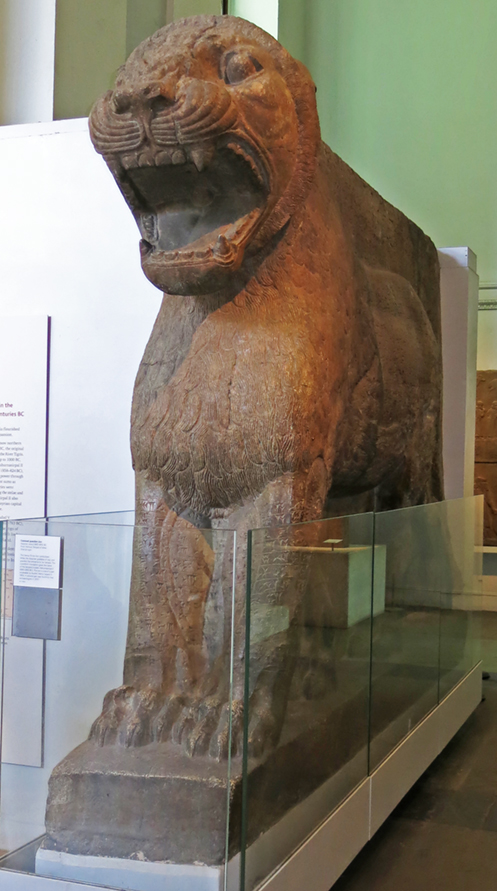
Reign of King Ashurnasirpal II (883 BC - 859 BC)
Colossal Lion
Gypsum wall-panel relief showing a colossal lion, one of a pair, much damaged by fire, which guarded the entrance to the temple of Ishtar Sharrat-niphi; inscribed.
Circa 865 BC - 860 BC.
Height 2590 mm, length 3960 mm.
Records the name, titles and conquests of Ashurnasirpal II.
Guarded entrance to temple of Ishtar Sharrat-Niphu (Belit-Mati according to the record card)
Catalog: Gypsum, Temple of Ishtar Sharrat-niphi, 118895
Photo: Don Hitchcock 2015
Source: Original, British Museum
Text: Card with the display at the British Museum, www.britishmuseum.org/, © Trustees of the British Museum, CC BY-NC-SA 4.0
The largest and most extravagant party ever held
When Ashurnasirpal, king of Assyria, inaugurated the palace of Calah, a palace of joy and [erected with] great ingenuity, he invited into it Ashur, the great lord and the gods of his entire country, [he prepared a banquet of] 1000 fattened head of cattle, 1000 calves, 10000 stable sheep, 15000 lambs — for my lady Ishtar [alone] 200 head of cattle [and] 1000 sihhu-sheep — 1000 spring lambs, 500 stages, 500 gazelles, 1000 ducks, 500 geese, 500 kurku-geese, 1000 mesuku-birds, 1000 qaribu-birds, 10000 doves, 10000 sukanunu-doves, 10000 other [assorted] small birds, 10000 [assorted] fish, 10000 jerboa, 10000 [assorted] eggs,…10000 [jars of] beer, 10000 skins with wine, …1000 wood crates with vegetables, 300 [containers with] oil, …100 [containers with] fine mixed beer, …100 pistachio cones, ….
When I inaugurated the palace at Calah I treated for ten days with food and drink 47074 persons, men and women, who were bid to come from across my entire country, [also] 5000 important persons, delegates from the country Suhu, from Hindana, Hattina, Hatti, Tyre, Sidon, Gurguma, Malida, Hubushka, Gilzana, Kuma [and] Musasir, [also] 16000 inhabitants of Calah from all ways of life, 1500 officials of all my palaces, altogether 69574 invited guests from all the [mentioned] countries including the people of Calah; I [furthermore] provided them with the means to clean and anoint themselves. I did them due honors and sent them back, healthy and happy, to their own countries.
Source: “The Banquet of Ashurnasirpal II,” translated by A. Leo Oppenheim, in Ancient Near Eastern Texts Relating to the Old Testament, 3rd ed. with Supplement, edited by James B. Pritchard (Princeton: Princeton University Press, 1969), 558-561.
Taken from the following Internet site, now unavailable (28 Sept. 2004):
www.bol.ucla.edu/~szuchman/banquet_inscription.htm
Image: AI image using openart.ai
Text below from the Metropolitan Museum of Art:
The ancient state of Assyria lay in what is now northern Iraq. The sculptures above are from the reign of King Ashurnasirpal II (reigned 883–859 BC), a king whose military expeditions to the west reached the shores of the Mediterranean Sea, and helped lay the foundations for an empire that came to dominate the Near Eastern political landscape from the ninth through seventh centuries B.C. The king himself is depicted on one of the reliefs (32.143.4). Ashurnasirpal moved from the traditional Assyrian capital, Ashur, to Nimrud, and there built a new and spectacular palace, today called the Northwest Palace for its position on the site’s citadel. Texts survive describing the palace’s completion and inauguration, involving a banquet for almost 70 000 people. The number is probably exaggerated, but there is no doubt that this was a huge festival.
The inscription was discovered in a recess of courtyard E of the North-West Palace during the third season of the Nimrud excavations in 1951. A full account of the discovery is given in Chap. IV of Mallowan's Nimrud and its Remains. For the text and a first discussion of the stele one turns to the edition of D. J. Wiseman published in Vol. XIV of this Journal.
Since the publication of the stele in 1952, three new translations have appeared, namely, those of Jorgan Laessøe, A. L. Oppenheim, and A. K. Grayson, and a number of improvements to the text and interpretation have been made by Wolfgang Schramm, and, following collation, by J. N. Postgate. Despite these attentions, however, many problems still remain.
Text in the two paragraphs immediately above: adapted from www.cambridge.org/
Text below from Martha Carlin, sites.uwm.edu/carlin/ashurnasirpal-iis-banquet-inscription/
Ashurnasirpal II’s Banquet Inscription
Found near throne room in Northwest Palace of Kalhu
[This is] the palace of Ashurnasirpal, the high priest of Ashur, chosen by Enlil and Ninurta, the favorite of Anu and Dagan [who is] destruction personified among all the great gods – the legitimate king, the king of the world, the king of Assyria, son of Tukult-Ninurta, great king, ligitimate king, king of the world, king of Assyria [who was] the son of Adad-nirari, likewise great king, legitimate king, king of the world and king of Assyria – the heroic warrior who always acts upon trust- inspiring signs given by his lord Ashur and [therefore] has no rival among the rulers of the four quarters [of the world]; the shepherd of all mortals, not afraid of battle [but] an onrushing flood which brooks no resistance; the king who subdues the unsubmissive [and] rules over all mankind; the king who always acts upon trust-inspiring signs given by his lords, the great gods, and therefore has personally conquered all countries; who has acquired dominion over the mountain regions and received their tribute; he takes hostages, triumphs over all the countries from beyond the Tigris to the Lebanon and the Great Sea, he has brought into submission the entire country of Laqe and the region of Suhu as far as the town of Rapiqu; personally he conquered [the region] from the source of the Subnat River to Urartu.
I returned to the territory of my own country [the regions] from the pass [which leads to] the country Kirrure as far as Gilzani, from beyond the Lower Zab River to the town of Til-bari which is upstream of the land of Zamua – from Til-sha-abtani to Til-sha-sabtani – [also] Hirimu and Harrutu [in] the fortified border region of Babylonia [Karduniash]. I listed as inhabitants of my own country [the people living] from the pass of Mt. Babite to the land of Hashmar.
Ashur, the Great Lord, has chosen me and made a prounouncement concerning my world rule with his own holy mouth [as follows]: Ashurnasirpal is the king whose fame is power!
I took over again the city of Calah in that wisdom of mine, the knowledge which Ea, the king of the subterranean waters, has bestowed upon me, I removed the old hill of rubble: I dug down to the water level; I heaped up a [new] terrace [measuring] from the water level to the upper edge 120 layers of bricks; upon that I erected as my royal seat and for my personal enjoyment 7 beautiful halls [roofed with] boxwood, Magan-ash, cedar, cypress, juniper, boxwood and Magan-ash with bands of bronze; I hung them in their doorways; I surrounded them [the doors] with decorative bronze bolts; to proclaim my heroic deeds I painted on [the palaces’] walls with vivid blue paint how I have marched across the mountain ranges, the foreign countries and the seas, my conquests in all countries; I had lapis lazuli colored glazed bricks made and set [them in the wall] above their gates. I brought in people from the countries over which I rule, those who were conquered by me personally, [that is] from the country Suhi [those of] the town Great [?], from the entire land of Zamua, the countries Bit-Zamani and [Kir]rure, the town of Sirqu with is across the Euphrates, and many inhabitants of Laqe, of Syria and [who are subjects] of Lubarna, the ruler of Hattina; I settled them therein [the city of Calah].
I dug a canal from the Upper Zab River; I cut [for this purpose] straight through the mountains[s]; I called it Patti- hegalli [“Channel-of-Abundance”]; I provided the lowlands along the Tigris with irrigation; I planted orchards at [the city’s] outskirts, with all sorts of fruit trees.
I pressed the grapes and offered [them] as first fruits in a libation to my lord Ashur and to all the sanctuaries of my country. I [then] dedicated that city to my lord Ashur.
[I collected and planted in my garden] from the countries through which I marched and the mountains which I crossed, the trees [and plants raised from] seeds from wherever I discovered [them, such as]: cedars, cypress, simmesallu-perfume trees, burasu-junipers, myrrh-producing trees, dapranu-junipers, nut- bearing trees, date palms, ebony, Magan-ash, olive trees, tamarind, oaks, tarpi’u-terebinth trees, luddu-nut-bearing trees, pistachio and cornel-trees, mehru-trees, semur-trees, tijatu- trees, Kanish oaks, willows, sadanu-trees, pomegranates, plum trees, fir trees, ingirasu-trees, kamesseru-pear trees, supurgillu-bearing trees, fig trees, grape vines, angasu-pear trees, aromatic sumlalu-trees, titip-trees…. In the gardens in [Calah] they vied with each other in fragrance; the paths [in the garden were well kept], the irrigation weirs [distributed the water evenly]; its pomegranates glow in the pleasure garden like the stars in the sky, they are interwoven like grapes on the vine; …in the pleasure garden…in the garden of happiness flourished like [cedar trees]….
I erected in Calah, the center of my overlordship, temples such as those of Enlil and Ninurta which did not exist there before; I rebuilt in it the [following] temples of the great gods…. In them I established the [sacred] pedestals of these, my divine lords. I decorated them splendidly; I roofed them with cedar beams, made large cedar doors, sheathed them with bands of bronze, placed them in their doorways. I placed representations made of shining bronze in their doorways. I made [the images of] their great godheads sumptuous with red gold and shining stones. I presented them with golden jewelry and many other precious objects which I had won as booty.
I lined the inner shrine of my lord Ninurta with gold and lapis lazuli, I placed at his pedestal fierce ushumgallu-dragons of gold. I performed his festival in the months Shabatu and Ululu. I arranged for them [the materials needed for] scatter and incense offerings so that his festival in Shabatu should be one of great display. I fashioned a statue of myself as king in the likeness of my own features out of red gold and polished stones and placed it before my lord Ninurta.
I organised the abandoned towns which during the rule of my fathers had become hills of rubble, and had many people settle therein; I rebuilt the old palaces across my entire country in due splendour; I stored in them barley and straw.
Ninurta and Palil, who love me as [their] high priest, handed over to me all the wild animals and ordered me to hunt [them]. I killed 450 big lions; I killed 390 wild bulls from my open chariots in direct assault as befits a ruler; I cut off the heads of 200 ostriches as if they were caged birds; I caught 30 elephants in pitfalls. I caught alive 50 wild bulls, 140 ostriches [and] 20 big lions with my own…
I received five live elephants as tribute from the governor of Suhu [the Middle Euphrates region] and the governor of Lubda [SE Assyria toward Babylonia]; they used to travel with me on my campaigns. I organised herds of wild bulls, lions, ostriches and male and female monkys and had them breed like flocks [of domestic animals].
I added land to the land of Assyria, many people to its people.
Like most ancient Near Eastern palaces, the Northwest Palace was made of mud brick. Ashurnasirpal seems to have been the first Assyrian king to line his palace walls with stone bas-reliefs, and his inscriptions boast of finding and utilising the stone that made it possible. This stone, which could be quarried locally, is a gypsum, sometimes called alabaster (it is almost white when first cut) and colloquially known as 'Mosul marble' after the nearby modern city. The slabs are extremely heavy, and simply quarrying and transporting the stone for use in the palace was a major undertaking. Once in position, the carving of the reliefs, with their carefully modelled figures and perfectly smooth backgrounds, represented another enormous task. An inscription describing the king’s achievements, today called the Standard Inscription was carved across the centre of each panel. It seems likely that the repetition of the inscription, like that of the reliefs’ imagery, formed part of the magical protection of the palace and the king. Finally, the reliefs were brightly painted. Some pigment can still be seen in rare cases (31.72.1), and analysis of microscopic traces can sometimes reveal the original colours even when no paint is visible. Many of the figures in the reliefs wear clothes with embroidered patterns, rendered on the stone as fine engraving (1982.1188.4); these would originally have been picked out in contrasting colours.
Map of the central area of the Neo-Assyrian Empire.
Photo: Staatliche Museen zu Berlin - Vorderasiatisches Museum, Ausführung: Christoph Forster, datalina
Source: Staatliche Museen zu Berlin, Pergamonmuseum
Reign of King Ashurnasirpal II (883-859 BC)
Spirit
865 BC - 860 BC
Gypsum wall panel relief, of a winged human-headed horned protective spirit with right hand raised and a branch in the left hand, facing right. It guarded the door into what may have been royal bedroom.
Height 2286 mm, width 1067 mm, thickness 203 mm.
Catalog: Nimrud, North-West Palace, Assyrian Transept West, BM/Big number 118803
Photo: Don Hitchcock 2015
Source: Original, British Museum
Text: Card with the display at the British Museum, www.britishmuseum.org/, © Trustees of the British Museum, CC BY-NC-SA 4.0
Reign of King Ashurnasirpal II (883-859 BC)
Spirit
865 BC - 860 BC
Gypsum wall panel relief showing a four-winged protective spirit facing left, wearing a three-horned cap and holding a mace. It may be performing an act of worship. This wall panel guarded one of the doors into the royal throne room. It bears the Standard Inscription of Ashurnasirpal II.
Height 2311 mm, width 1321 mm.
Catalog: Nimrud, North-West Palace, BM/Big number 124530
Photo: Don Hitchcock 2015
Source: Original, British Museum
Text: Card with the display at the British Museum, www.britishmuseum.org/, © Trustees of the British Museum, CC BY-NC-SA 4.0
Reign of King Ashurnasirpal II (883-859 BC)
Spirit
865 BC - 860 BC
Gypsum wall panel in relief. A winged eagle-headed protective spirit between sacred trees facing left, with an inscription.
The Sacred Trees were completed on adjoining panels. The one on the right is in Dresden, while the one on the left is lost.
Height 2134 mm, width 2184 mm, thickness 203 mm.
( Note that at the time of writing, May 2024, there is no image of this object available on the BM website - Don )
Catalog: From Nimrud, North-West Palace, Room F, panel 8. BM/Big number 118804
Photo: Don Hitchcock 2015
Source: Original, British Museum
Text: Card with the display at the British Museum, www.britishmuseum.org/, © Trustees of the British Museum, CC BY-NC-SA 4.0
Reign of King Ashurnasirpal II (883-859 BC)
Protective Spirit
Gypsum wall panel relief showing a protective spirit carrying a deer and a palm branch. This panel once guarded the door to the royal throne room. There is an inscription written in cuneiform script.
Circa 865 BC - 860 BC.
Height 2250 mm, width 1350 mm.
Catalog: Gypsum alabaster, Nimrud, North West Palace, Room B, Panel 30, BM/Big number 124560
Photo: Don Hitchcock 2015
Source: Original, British Museum
Text: Don Hitchcock
Reign of King Ashurnasirpal II (883-859 BC)
Wall panel; gypsum alabaster relief from the North West Palace of Nimrud.
King Ashurnasirpal appears twice, dressed in ritual robes and holding the mace symbolising authority. In front of him there is a Sacred Tree, possibly symbolising life, and he makes a gesture of worship to a god in a winged disc. The god, who may be the sun god Shamash, has a ring in one hand; this is an ancient Mesopotamian symbol of god-given kingship.
There are protective spirits on either side behind the king. This symmetrical scene, heavy with symbolism, was placed behind the royal throne. There was another opposite the main door of the throne room, and similar scenes occupied prominent positions in other Assyrian palaces; they were also embroidered on the royal clothes. Traces of colour pigment were noted on the sandals at the time of excavation, i.e. red soles and black uppers.
Circa 883 BC - 859 BC.
Height 195 centimetres (in total), width in total 433 cm.
There was another of these opposite the main door of throne room and in other palaces and the scene would have been represented on royal clothes.
In set with 1849,1222.4-5
In set with 1850,1228.24-26
Found by Layard, May 1846; packed into five cases on a raft despatched from Nimrud April 1847; three cases were shipped on the Indian Navy sloop 'Clive' June 1848, reaching Bombay in October that year and then brought to England on H.M.S. Meeanee in August 1849; the two remaining cases were shipped direct to England on the 'Apprentice' in August 1848, arriving January 1849.
Catalog: Gypsum alabaster, pigmented, Nimrud, BM/Big number 124531
Photo: Don Hitchcock 2015
Source: Original, British Museum
Text: Card with the display at the British Museum, http://www.britishmuseum.org/, © Trustees of the British Museum, CC BY-NC-SA 4.0
Reign of King Ashurnasirpal II (883-859 BC)
Wall panel; gypsum alabaster relief from the North West Palace of Nimrud.
This is a three-part representation with genii in front of a palmette tree ( a palmette is
an ornament of radiating petals that resemble the leaflets of a palm - Don )
and the standard inscription.
Height 2300 mm, width 1980 mm, depth 110 mm, weight 1430 kg.
Catalog: Gypsum alabaster, Nimrud, VA 00949
Photo: Don Hitchcock 2015
Source: Pergamon Museum, Berlin, www.smb-digital.de/
Permalink: id.smb.museum/object/1743976/dreiteilige-darstellung-mit-genien-vor-einem-palmettenbaum-und-standardinschrift
Reign of King Ashurnasirpal II (883-859 BC)
Bull Hunt wall panel / orthostat.
Gypsum alabaster relief from the North West Palace of Nimrud.
Height 790 mm, width 660 mm, depth 110 mm, weight 160 kg.
Catalog: Gypsum alabaster, Nimrud, VA 00962
Photo: Don Hitchcock 2015
Source: Pergamon Museum, Berlin, www.smb-digital.de/
Permalink: id.smb.museum/object/1743974/orthostat-mit-darstellung-einer-stierjagd
Reign of King Ashurnasirpal II (883-859 BC)
Relief of a prisoner of war.
Gypsum alabaster relief from the North West Palace of Nimrud.
Height 1150 mm, width 710 mm, depth 110 mm, weight 250 kg.
Catalog: Gypsum alabaster, Nimrud, VA 08747
Photo: Don Hitchcock 2015
Source: Pergamon Museum, Berlin, www.smb-digital.de/
Permalink: id.smb.museum/object/1743981/relief-eines-unterworfenen
Reign of King Ashurnasirpal II (883-859 BC)
Wall panel; gypsum alabaster relief from the North West Palace Room I of Nimrud.
This is a three-part representation with genii in front of a palmette tree ( a palmette is
an ornament of radiating petals that resemble the leaflets of a palm - Don )
and the standard inscription.
Height 2250 mm, width 2030 mm, depth 110 mm, weight 1430 kg.
Catalog: Gypsum alabaster, Nimrud, VA 00950
Photo: Don Hitchcock 2015
Source: Pergamon Museum, Berlin, www.smb-digital.de/
Permalink: id.smb.museum/object/1743991/dreiteilige-darstellung-mit-genien-vor-einem-palmettenbaum-und-standardinschrift
Reign of King Ashurnasirpal II (883-859 BC)
Relief depicting a lion hunt, North West Palace, Nimrud.
This Lion Hunt Relief came from the western wing of Northwest Palace of the Royal Residence of King Ashurbanipal in Nimrud, present-day Iraq. The relief shows the king, standing on a light hunting chariot, which is guided by a charioteer and pulled by three horses. Three arrows have hit the lion. The King once again aims an arrow at the lion. The lion has turned its head back and seems to roar at its attacker in pain.
The royal lion hunt is a symbol of the King overcoming the dangers and challenges to the Assyrian state by its ruler.
Particularly noteworthy is in the initially coloured bas-relief of detail, such as in hunting chariots and weapons, as well as in the richly decorated horses with their teeth.
This section of the relief is only the lower part of a three-walled wall relief, the total height of which was about 2300 mm.
While the upper register with another narrative relief is lost, only a few remnants of two lines of cuneiform have been preserved from the middle register, which bore the king’s standard inscription.
An almost identical representation, now in the British Museum in London, shows the bow-shooting king, who has just killed a male lion.
Nimrud has been one of the primary sources of Assyrian sculpture, including the famous palace reliefs.
A series of the distinctive Assyrian shallow reliefs were removed from the palaces, and sections are now found in several museums, in particular, the British Museum and the Pergamon Museums. These show scenes of hunting, warfare, ritual, and processions. There are about two dozen sets of scenes of lion hunting in surviving Assyrian palace reliefs.
Neo-Assyrian palaces were very extensively decorated with such reliefs, carved in shallow reliefs on slabs that are mostly of gypsum alabaster, which was plentiful in northern Iraq.
Other animals were also shown being hunted, and the main subject for narrative reliefs was the war campaigns of the king who built the palace. Other reliefs showed the king, his court, and 'winged genie' and lamassu protective minor deities.
Nimrud is an ancient Assyrian city located 30 kilometres (20 mi) south of the city of Mosul, in the Nineveh plains in Upper Mesopotamia.
It was a major Assyrian city between about 1350 BC and 610 BC. The city is located in strategic position north of the point that the river Tigris meets its tributary, the Great Zab.
In the mid 19th century, biblical archaeologists proposed the Biblical name of Kalhu (Calah), based on a description in Genesis 10. The city gained fame when king Ashurnasirpal II (883–859 BC) of the Neo-Assyrian Empire (911–605 BC) made it his capital at the expense of Assur.
He built a large palace and temples in the city, which fell into disrepair during the Bronze Age Collapse of the mid-11th to mid-10th centuries BC.
Archaeological excavations at the site began in 1845, and many vital artifacts were discovered, with most being moved to museums in Iraq and abroad. Historical artefacts from Nimrud can now be found in over 76 museums worldwide, including 36 in the United States and 13 in the United Kingdom. In 2015, the terrorist organization, the Islāmic State of Iraq and the Levant (ISIL), destroyed much of the site. The excavated remains were damaged because of its Assyrian history.
The relief from the western wing of the so-called Northwest Palace of the royal residence in Kalchu (today Nimrud/Iraq) is only the lower part of a three-register wall relief, the total height of which was approx. 2300 mm. The king is depicted standing on a light hunting chariot, which is led by a driver and drawn by three horses.
Height 970 mm, width 1830 mm, depth 110 mm, weight 555 kg.
Catalog: Gypsum alabaster, Nimrud, VA 00959
Photo: Don Hitchcock 2015
Source: Pergamon Museum, Berlin, www.smb-digital.de/
Permalink: id.smb.museum/object/1743971/relief-mit-darstellung-einer-l%C3%B6wenjagd
Reign of King Ashurnasirpal II (883-859 BC)
Wall panel; gypsum alabaster relief from the North West Palace of Nimrud.
Circa 883 BC - 859 BC.
Gypsum alabaster wall panel depicting a protective spirit in relief: this figure, a man with wings like an angel, is a protective spirit, probably an 'apkallu'. He carries a goat and a giant ear of corn ( i.e. wheat or barley - Don ), possibly symbolic of fertility though their precise significance is uncertain.
He wears a kilt with long tassels hanging from it, indicating his semi-divine status, and a fringed robe, embroidered with clusters of dates, which is drawn round the body and thrown over his shoulder, leaving the right leg exposed. There are sandals on his feet. A bead necklace round his neck is held in position by a tassel at the back. His armlets have animal-head terminals, and there are rosettes on his wristlets and on his diadem.
He has the magnificent curled moustache and long curled beard and hair typical of ninth-century figures. The musculature of his leg is exaggeratedly drawn, with a prominent vein encircling his ankle.
Across his body runs the standard inscription. This was incised after the carving of the figure was complete, and it cuts through some of the fine details of decoration on the dress.
Height 224 cm, width 127 cm, thickness 12 cm.
This figure was probably one of a pair which guarded an entrance into the private quarters of the king. It was previously described on a label as from Room Z rather than T.
Shipped by the excavator, Sir Austen Henry Layard, on the 'Apprentice'; arrived January 1849.
Catalog: Gypsum alabaster, pigmented, Nimrud, BM/Big number 124561
Photo: Don Hitchcock 2015
Source: Original, British Museum
Text: Card with the display at the British Museum, http://www.britishmuseum.org/, © Trustees of the British Museum, CC BY-NC-SA 4.0
Reign of King Ashurnasirpal II (883-859 BC)
Tribute Bearers
Circa 883 BC - 859 BC.
Gypsum wall panel relief from the North West Palace of Nimrud, carved and showing tribute bearers. One has a North West Syrian type turban and raises clenched hands in token of submission; the second may be Phoenician and brings a pair of apes.
There is an inscription written in cuneiform script with partial white infilling in some of the signs. The panel originally had traces of black paint at the top.
Height 263 cm, width 259 cm.
This panel was part of the façade of the throne room. Layard (1849, 'Nineveh and its Remains', vol. I, p. 118) refers to how at the time of discovery there were extensive traces of black pigment covering the face of the man with the monkeys, and he speculated that this was either from a deliberate attempt to depict a negro or that the paint had washed down from the man's hair. No traces of this are now visible to the naked eye (2008).
Layard refers to the survival at the time of excavation of pigment on selective portions of other sculptures at Nimrud, specifically on the hair, beards, eyes and sandals of some sculptures and the red-painted tongue of an eagle-headed genie (ibid., pp. 71-72, 126). The white infilling in the inscription on this particular scuplture may also be ancient and resembles a feature noted on Persepolitan (the capital of ancient Persia) inscriptions.
Catalog: Gypsum alabaster, pigmented, Nimrud, BM/Big number 124562
Photo: Don Hitchcock 2015
Source: Original, British Museum
Text: Card with the display at the British Museum, http://www.britishmuseum.org/, © Trustees of the British Museum, CC BY-NC-SA 4.0
Reign of King Ashurnasirpal II (883-859 BC)
Eagle Headed Winged Genie
Gypsum alabaster wall panel relief, circa 865 BC - 860 BC, showing an eagle-headed protective spirit in the character of a fertiliser of the date-palm, facing right and holding a bucket in one hand and in the other a spathe (leaf-like sheath for the flowers) of the date palm. He is tending a tree, not visible in this panel, a symbol of vegetal life and fertility.
There is a band of cuneiform inscription of Ashurnasirpal II across the centre.
Height 241 cm, width 169 cm.
Winged Genies occur in the reliefs of the walls of Ashurnasirpal II’s palace at Nimrud (originally Kalhu) and Sargon II’s palace Dur-Sharrukin, "Fortress of Sargon". There are three common stylistic tendencies in reliefs with genii. First there are bearded, winged figures wearing a horned helmet. Next there are bearded, winged figures wearing a diadem instead of helmet. Finally there are winged, muscular, male figures with bird heads. They are usually adorned with rosettes on their diadem and/or wrists. Most often they are wearing a short sleeved, knee-length tunic with a tasseled hem. Over the tunic is an ankle length fringed shawl that covers the near leg, wraps around the body and drapes the left shoulder, with the end hanging down the back to the waist.
Catalog: Gypsum alabaster, repaired from fragments, Nimrud, North West Palace, Room G, panel d 1, BM/Big number WA 124576
Photo: Don Hitchcock 2015
Source: Original, British Museum
Text: Card with the display at the British Museum, http://www.britishmuseum.org/, © Trustees of the British Museum, CC BY-NC-SA 4.0
Additional text: various sources including Wikipedia
Reign of King Ashurnasirpal II (883-859 BC)
Eagle Headed Winged Genie
Height 220 cm, width 163 cm.
Catalog: Gypsum alabaster, VA 00941, Nimrud, Northwest Palace, Room F
Photo: Don Hitchcock 2015
Source and text: Pergamon Museum, Berlin, recherche.smb.museum
As always, click on this small image to see the full size photo.
Reign of King Ashurnasirpal II (883-859 BC)
Eagle Headed Winged Genie
Eagle-headed protective spirit.
Height 106 cm, width 69 cm.
( This fragment is asymmetrical - Don )
Circa 865 BC - 860 BC
Photo: Don Hitchcock 2015
Source: Original, British Museum
Catalog: Gypsum alabaster, Nimrud, North West Palace, BM/Big number 118921
Text: Card with the display at the British Museum, http://www.britishmuseum.org/, © Trustees of the British Museum, CC BY-NC-SA 4.0
As always, click on this small image to see the full size photo.
Reign of King Ashurnasirpal II (883-859 BC)
Human Headed Winged Genie
Winged genie with bucket and cone.
Relief Plaque.
Height 232 cm, width 162 cm.
Photo: Don Hitchcock 2015
Catalog: Gypsum alabaster, Found Nimrud, Northwest Palace, Room C, present location Pergamon Museum, Level 1, Museum of the Near East, Room 11, VA 00943
Source and text: Pergamon Museum, Berlin, recherche.smb.museum
As always, click on this small image to see the full size photo.
Reign of King Ashurnasirpal II (883-859 BC)
Stone Reliefs.
These stone reliefs were originally painted, to judge by the traces of colour detected on the sandals of several of the figures. The reliefs show King Ashurnasirpal II in a cultic function during a libation between winged divine beings.
These reliefs served as magical protection for the king.
Photo: Don Hitchcock 2015
Catalog: Gypsum alabaster, painted.
Source and text: Pergamon Museum, Berlin, recherche.smb.museum
Reign of King Ashurnasirpal II (883-859 BC)
Ashurnasirpal II
Gypsum alabaster wall panel relief showing Ashurnasirpal II, originally flanked by other figures, wearing the royal cap with pointed projection and lappets, and a long garment which reaches down to his ankles, with sandals and armlets and bracelets. He holds the staff of royalty in his right hand, and his left rests upon the handle of his sword.
In a fold of his garment, a little above the waist, are thrust two daggers. There is black and red paint on the sandals. There is an inscription written in cuneiform script. The panel once stood at the head of a room on the private side of the palace.
Circa 865 BC - 860 BC
Height 325 cm, width 147 cm.
The flanking figures are in New York and New Haven.
Photo: Don Hitchcock 2015
Source: Original, British Museum
Catalog: Gypsum alabaster, painted, Nimrud, North West Palace, BM/Big number 124563
Text: Card with the display at the British Museum, http://www.britishmuseum.org/, © Trustees of the British Museum, CC BY-NC-SA 4.0
As always, click on this small image to see the full size photo.
Reign of King Ashurnasirpal II (883-859 BC)
Ashurnasirpal II
Court Scene
Assyrian, about 865 - 860
Gypsum wall panel relief, from Nimrud, North-West Palace, Room G, Panels 2, 3, 4.
King Ashurnasirpal is enthroned between attendants, and the group is flanked by a pair of winged protective spirits. The workmanship of these panels, from the head of what was possibly a banquet hall, is exceptionally fine. Detailed patterns are represented by delicate incisions on the clothes. There are traces of paint on the sandals.
(leftmost panel) 124564:
Gypsum wall panel relief: showing part of a court scene. A royal eunuch attendant offers a bowl of wine to the king. Behind him is a four-winged protective spirit, wearing the two-horned cap, and holding in his hands objects used in connection with the ceremony of fertilising the date palm.
The sandals are coloured black with red soles. The clothes have incised patterns, including a palm with a rampant horned animal on each side of it, the palm with winged protective spirits in the character of fertilisers of the palm, and a winged, horned animal with its head turned behind. Ashurnasirpal II is also shown holding up in each hand a wild bull, head downwards, by a hind-leg. There is an inscription written in cuneiform script.
( I cannot find any of these decorations - Don )
(middle panel) 124565:
Ashurnasirpal II seated on his throne, with his feet on a footstool, holding a bowl of wine in his right hand; behind him stands an attendant with a fly-flapper, and bearing the royal bow, quiver, and sword. The sandals are coloured black with red soles and the clothes have incised patterns. The panel has been inscribed with cuneiform script.
(rightmost panel) 124566:
Depicted is an attendant bearing the royal bow and quiver and sword, followed by a winged being, who wears the two-horned cap, and holds in his hands objects used in connection with the ceremony of fertilising the palm-tree. The sandals are coloured black with red soles, and the clothes have incised patterns. The decorative borders on the garments worn show a palm-tree with an ostrich on each side of it, within a border filled with rosettes, together with clusters of palm-leaves and fruit. There is an inscription written in cuneiform script.
Photo: Don Hitchcock 2015
Source: Original, British Museum
Catalog: Gypsum alabaster, painted, Nimrud, North West Palace, Room G, panels 2, 3, 4, BM/Big number WA 124564, 124565, 124566
Text: Card with the display at the British Museum, http://www.britishmuseum.org/, © Trustees of the British Museum, CC BY-NC-SA 4.0
As always, click on this small image to see the full size photo.
Reign of King Ashurnasirpal II (883-859 BC)
Ashurnasirpal II
Gypsum wall panel relief showing a formal scene. Ashurnasirpal II appears as conquerer with bow and arrows flanked by a protective spirit. The sandals are coloured black with red soles. The royal garments have decorative borders consisting of a winged protective spirit wearing a two-horned cap, and a man-headed winged lion.
( I cannot find any of these decorations - Don )
There is an inscription written in cuneiform script. This panel forms part of group showing the king as conqueror with bow and arrow, and also holding bow and bowl, flanked by attendants.
Circa 865 BC - 860 BC.
Photo: Don Hitchcock 2015
Source: Original, British Museum
Catalog: Gypsum alabaster, painted, Nimrud, North West Palace, Room G, panels 6, 12, 10, BM/Big number 124567
Text: Card with the display at the British Museum, http://www.britishmuseum.org/, © Trustees of the British Museum, CC BY-NC-SA 4.0
As always, click on this small image to see the full size photo.
Reign of King Ashurnasirpal II (883-859 BC)
Ashurnasirpal II
Gypsum wall panel relief: showing a formal scene. A protective spirit, in a two-horned cap, and an attendant bearing the royal bow and quiver, mace and sword are depicted. The sandals are coloured black with red soles. There is an inscription written in cuneiform script. This panel forms part of a group showing king as conqueror; including bowl.
Circa 865 BC - 860 BC.
There are traces of the original red and black pigment on the sandals.
Catalog: Gypsum alabaster, painted, Nimrud, North West Palace, Room G, panels 6, 12, 10, BM/Big number 124568
Photo: Don Hitchcock 2015
Source: Original, British Museum
Text: Card with the display at the British Museum, http://www.britishmuseum.org/, © Trustees of the British Museum, CC BY-NC-SA 4.0
Reign of King Ashurnasirpal II (883 BC - 859 BC)
Wall Panel Relief, 865 BC - 860 BC
Gypsum wall panel relief showing a winged protective spirit holding a branch with five blossoms, facing right, and performing an act of worship (?). There is an inscription written in cuneiform script.
Findspot: Nimrud, North West Palace.
Height 100 cm, width 89 cm.
Reverse of plaster cast dated 1869 and inscribed "Luglio", "lion" and "leone" (twice), ironically given the subject of the original.
Catalog: Gypsum, 118876
Photo: Don Hitchcock 2015
Source: Original, British Museum
Text: Card with the display at the British Museum, http://www.britishmuseum.org/, © Trustees of the British Museum, CC BY-NC-SA 4.0
Reign of King Ashurnasirpal II (883 BC - 859 BC)
Wall Panel Relief, 865 BC - 860 BC
Gypsum wall panel in relief, small winged protective spirit wearing horned headdress and facing left, holding a branch.
Findspot: Nimrud, North West Palace.
Height 104 cm, width 56 cm.
( I can't help but note here ( humour me, I am a retired mathematics teacher with more than 50 years in front of a blackboard, and you never lose that mindset ) that someone was obviously given the job of metrication of the BM catalog, inadvertently introducing spurious accuracy/significant figures. The measurement of this piece, for example, was given in the online catalog as 104.14 cm by 55.88 cm. This was obviously originally correct to two significant figures, 41 inches by 22 inches (try it yourself on google or a calculator, the relevant calculations are 41 inches x 2.54 cm and 22 inches x 2.54 cm), thus taking a two significant figures measurement and turning into apparently four or more significant figures. A better metrication would be 104 cm by 56 cm, as above - Don )
Catalog: Gypsum, 118874
Photo: Don Hitchcock 2015
Source: Original, British Museum
Text: Card with the display at the British Museum, www.britishmuseum.org/, © Trustees of the British Museum, CC BY-NC-SA 4.0
As always, click on this small image to see the full size photo.
Reign of King Ashurnasirpal II (883-859 BC)
Ashurnasirpal II
Gypsum wall panel relief: showing a formal scene. Ashurnasirpal II appears holding a bow and bowl flanked by a human attendant with a fly-flapper. The royal garments have decorative borders composed of heads of palms, horned animals, and perhaps winged bulls. The sandals are coloured black with red soles. These designs also show a cluster of palm-leaves, ostriches and rosettes. This panel forms part of a group showing the king as conqueror.
( There are marks on the borders of the royal garments, but I cannot identify them as per the description - Don )
Circa 865 BC - 860 BC.
There are traces of the original red and black pigment on the sandals.
Photo: Don Hitchcock 2015
Source: Original, British Museum
Catalog: Gypsum alabaster, painted, Nimrud, North West Palace, Room G, panels 6, 12, 10, BM/Big number 124568
Text: Card with the display at the British Museum, http://www.britishmuseum.org/, © Trustees of the British Museum, CC BY-NC-SA 4.0
As always, click on this small image to see the full size photo.
Reign of King Ashurnasirpal II (883-859 BC)
Ashurnasirpal II
King Ashurnasirpal appears twice, dressed in ritual robes and holding the mace symbolising authority. In front of him there is a Sacred Tree, possibly symbolising life, and he makes a gesture of worship to a god in a winged disc. The god, who may be the sun god Shamash, has a ring in one hand; this is an ancient Mesopotamian symbol of god-given kingship.
( Note that a number of other sources attribute this specific god in a winged disc to Ashur, Ašur, Aššur, a god of the ancient Assyrians and Akkadians, and the head of the Assyrian pantheon in Mesopotamian religion, who was worshipped mainly in northern Mesopotamia, and parts of north-east Syria and south-east Asia Minor which constituted old Assyria. He may have had a solar iconography - Don )
There are protective spirits on either side behind the king. This symmetrical scene, heavy with symbolism, was placed behind the royal throne in the North West Palace. There was another opposite the main door of the throne room, and similar scenes occupied prominent positions in other Assyrian palaces; they were also embroidered on the royal clothes. Traces of colour pigment noted on the sandals at the time of excavation, i.e. red soles and black uppers.
Circa 865 BC - 860 BC
Representations of: Ashurnasirpal II, Ashur (?), Shamash (?)
Found by Layard May 1846; packed into five cases on a raft despatched from Nimrud April 1847; three cases were shipped on the Indian Navy sloop 'Clive' June 1848, reaching Bombay October that year and then brought to England on H.M.S. Meeanee in August 1849; the two remaining cases were shipped direct to England on the 'Apprentice' in August 1848, arriving January 1849.
Photo: Don Hitchcock 2015
Source: Original, British Museum
Catalog: Gypsum alabaster, painted, Nimrud, North West Palace, BM/Big number 124531
Text: Card with the display at the British Museum, http://www.britishmuseum.org/, © Trustees of the British Museum, CC BY-NC-SA 4.0
Additional text: Wikipedia
As always, click on this small image to see the full size photo.
Reign of King Ashurnasirpal II (883-859 BC)
Ashurnasirpal II
Production date 865 BC - 860 BC.
124541 (left): Gypsum wall panel relief showing Ashurnasirpal II's chariot and another being placed in a boat for transportation across a river, probably the Euphrates. Upstream, Assyrian officials supervise as the army crosses river; some cross on inflated skins. There is an inscription written in cuneiform script.
Height 953 mm, length 2134 mm
124543 (right): Gypsum wall panel relief showing the crossing of a river. Horses swim, led by grooms, while a chariot, bed and jar are carried on coracles. Figures are shown complete and not half submerged which is typical of Assyrian art. There is an inscription written in cuneiform script.
Height 914 mm, width 2134 mm.
In set with 124541, 124543, 124545, 124547, 124549, (2007,6027.1), 124552, 124554, 124556
Photo: Don Hitchcock 2015
Source: Original, British Museum
Catalog: Gypsum alabaster, Nimrud, North West Palace, BM/Big number 124541 (left), 124543 (right)
Text: Card with the display at the British Museum, www.britishmuseum.org/, © Trustees of the British Museum, CC BY-NC-SA 4.0
As always, click on this small image to see the full size photo.
Reign of King Ashurnasirpal II (883-859 BC)
Ashurnasirpal II
Production date 865 BC - 860 BC.
124545 (left): Gypsum wall panel relief: showing the crossing of a river. Ashurnasirpal II's boat is rowed across river and hauled ashore. The royal chariot is beside him and horses swim behind him. An attendant draws the king's attention to a captured town that appears on the next panel to the right. There is an inscription written in cuneiform script.
Height 1005 mm, width 2164 mm.
124547 (right): Gypsum wall panel relief: showing chariots beside a captured town. The town, with women gesticulating from battlements, has just surrendered to the Assyrians; chariots carrying divine standards form a procession behind royal chariot on right. There is an inscription written in cuneiform script.
Height: 1051 mm, width 2164 mm.
In set with 124541, 124543, 124545, 124547, 124549, (2007,6027.1), 124552, 124554, 124556
Photo: Don Hitchcock 2015
Source: Original, British Museum
Catalog: Gypsum alabaster, Nimrud, North West Palace, BM/Big number 124545 (left), 124547 (right)
Text: Card with the display at the British Museum, www.britishmuseum.org/, © Trustees of the British Museum, CC BY-NC-SA 4.0
As always, click on this small image to see the full size photo.
Reign of King Ashurnasirpal II (883-859 BC)
Ashurnasirpal II
Production date 865 BC - 860 BC.
124549 (left): Gypsum wall panel relief: showing a review of prisoners. Ashurnasirpal II stands in front of a chariot below a parasol and holds raised arrows, symbolic of victory. He receives a high official who is followed by prisoners. The king is accompanied by the god Ashur in a winged disc. There is an inscription written in cuneiform script.
Height 940 mm, width 2184 mm.
2007,6027.1 (right): Oil painting of an Assyrian sculpture in Room B of the North-West Palace at Nimrud, based on the original drawing in Or.Dr. III, N.W. x; light green with white highlighting; depicts a line of prisoners accompanied by Assyrian soldiers.
Painted by: Sir George Scharf in 1853 for the sum of £5 from a drawing made by Mr Layar of a frieze which Mr Layard considered to be in too bad a condition to remove.
Height: Height 940 mm, width 2120 mm.
In set with 124541, 124543, 124545, 124547, 124549, (2007,6027.1), 124552, 124554, 124556
Photo: Don Hitchcock 2015
Source: Original, British Museum
Catalog: Gypsum alabaster, Nimrud, North West Palace, BM/Big number 124549 (left), 2007,6027.1 (right)
Text: Card with the display at the British Museum, www.britishmuseum.org/, © Trustees of the British Museum, CC BY-NC-SA 4.0
As always, click on this small image to see the full size photo.
Reign of King Ashurnasirpal II (883-859 BC)
Ashurnasirpal II
Production date 865 BC - 860 BC.
124552 (left): Gypsum wall panel relief: showing a review of prisoners and attack on enemy town. On the left, women, a child and cattle are led to join a procession of prisoners on the next panel. On the right Ashurnasirpal II shoots at the enemy town, while soldiers scale walls or tunnel under them. An Assyrian soldier is mounting a ladder, being protected by a convex shield, and his comrades are occupied in killing the men who have been wounded by the arrows from the king's bow; two enemies fall from the walls.
Width: 3048 mm.
124554 (right): Gypsum wall panel relief: showing Ashurnasirpal II besieging a city by a river. Some Assyrians break through the lower walls; a wooden 'seige tower' has been brought up close to the wall of the city, and under its protection the king shoots his arrows at his enemies on the walls. Their main siege engine is under attack. The enemy have caught their battering lever on a chain; two Assyrians hold it in place with hooks. Torches are thrown but water is piped from the siege engine to quench the flames. Meanwhile the men in the lower part of the tower work the battering-ram; and the archers in the upper part of it send out flight after flight of arrows. To the left Assyrian soldiers are digging down the lower walls with iron crowbars. There is an inscription written in cuneiform script.
Height 914 mm, width 2159 mm.
In set with 124541, 124543, 124545, 124547, 124549, (2007,6027.1), 124552, 124554, 124556
Photo: Don Hitchcock 2015
Source: Original, British Museum
Catalog: Gypsum alabaster, Nimrud, North West Palace, BM/Big number 124552 (left), 124554 (right)
Text: Card with the display at the British Museum, www.britishmuseum.org/, © Trustees of the British Museum, CC BY-NC-SA 4.0
As always, click on this small image to see the full size photo.
Reign of King Ashurnasirpal II (883-859 BC)
Ashurnasirpal II
Production date 865 BC - 860 BC.
( This pair of panels completes the story line for this set of wall panel reliefs - Don )
124554 (left): Gypsum wall panel relief: showing Ashurnasirpal II besieging a city by a river. Some Assyrians break through the lower walls; a wooden 'seige tower' has been brought up close to the wall of the city, and under its protection the king shoots his arrows at his enemies on the walls. Their main siege engine is under attack. The enemy have caught their battering lever on a chain; two Assyrians hold it in place with hooks. Torches are thrown but water is piped from the siege engine to quench the flames. Meanwhile the men in the lower part of the tower work the battering-ram; and the archers in the upper part of it send out flight after flight of arrows. To the left Assyrian soldiers are digging down the lower walls with iron crowbars. There is an inscription written in cuneiform script.
Width: 3048 mm.
124556 (right): Gypsum wall panel relief: showing an attack on an enemy town. A high official in ankle length scale armour shoots towards an enemy town. A chariot waits behind while a vulture plucks at the body of a dead enemy. There is an inscription written in cuneiform script.
Height 944 mm, width 2164mm.
In set with 124541, 124543, 124545, 124547, 124549, (2007,6027.1), 124552, 124554, 124556
Photo: Don Hitchcock 2015
Source: Original, British Museum
Catalog: Gypsum alabaster, Nimrud, North West Palace, BM/Big number 124544 (left), 124546 (right)
Text: Card with the display at the British Museum, www.britishmuseum.org/, © Trustees of the British Museum, CC BY-NC-SA 4.0
As always, click on this small image to see the full size photo.
Reign of King Ashurnasirpal II (883-859 BC)
Ashurnasirpal II
Production date circa 874 BC.
Part of a corner slab of a gypsum wall panel relief, showing two soldiers and a man with two horses crossing mountains. There is an inscription written in cuneiform script at the right side of the corner panel.
Height 1000 mm, width 930 mm.
Catalog: Nimrud, North West Palace
Inscription note: Reverse of relief carved with so called 'standard inscription' summarising the achievements of the king, which was written across virtually every panel of the North West palace in Nimrud.
In set with 1856,0909.210 (BM.124557). Inscription on the reverse refers to an expedition to Lebanon in ca 874 BC so the relief must date to this year or slightly later.
Photo: Don Hitchcock 2015
Source: Original, British Museum
Catalog: Gypsum alabaster, Nimrud Gallery, 16b (2), Nimrud, North West Palace, BM/Big number 124558
Text: Card with the display at the British Museum, www.britishmuseum.org/, © Trustees of the British Museum, CC BY-NC-SA 4.0
As always, click on this small image to see the full size photo.
Reign of King Ashurnasirpal II (883-859 BC)
Ashurnasirpal II
Production date circa 874 BC.
Gypsum wall panel relief showing King Ashurnasirpal II on campaign: Ashurnasirpal is travelling in a royal chariot through a hilly landscape with attendants. A river at the bottom is represented schematically by lines and spirals, and the rough ground by a pattern of scales. The king can be identified by his crown, a conical hat with a pointed top, and his is the grandest beard. The two arrows held upright in his right hand, with the bow lowered in his left, symbolise victory. He wears a sword slung on a swordbelt over his shoulder, and the end of the sheath is decorated with a pair of lions back to back. He has two wristlets; both incorporate rosettes, worn in the position of a modern wrist-watch. A spare bow and two quivers of arrows, an axe and a short javelin are carried in quivers on the side of the cab; decoration including a prancing bull is incised on the quivers.
The rear of the chariot, from which a spear-shaft projects diagonally backwards, is closed by a spiked shield with a central boss in the shape of a lion's head. An attendant holds a sunshade over the king's head; in battle this man would use a shield to protect the king from arrows.
The charioteer holds four reins in each hand, together with a whip. This is a typical Assyrian royal chariot of the period, holding a maximum of three people (most chariots carried only two crew) with six-spoked wheels. The two legs of a 'Y' shaped yoke pole is visible, rising from the base of the cab and shown in a distorted false perspective. A patterned cloth is visible above the horses' shoulders, attached to the front of the cab and the yoke. The horses themselves, of which royal chariots probably had a team of four (as revealed in river-crossing scenes) although only three are shown, are led by a groom in front. The tasselled harness is shown in detail, with crests and blinkers on the headstall.
An armed groom in front is helping to lead the horses. His raised arm wears a wristlet similar to the king's.
This is one of two pieces that originally formed the lower section of a single right-angled panel in the corner of a room; they were sawn in two for ease of transport in the 19th century. At the top of the panel can be seen a few signs of the so-called 'standard inscription'.
Height 1010 mm, width 860 mm, thickness 200 mm.
In set with BM 124558, above.
Photo: British Museum, © Trustees of the British Museum, CC BY-NC-SA 4.0
( I was unable to photograph the relief at the time of my visit to the BM, since it was on loan - Don )
Source: Original, British Museum
Catalog: Gypsum alabaster, Nimrud, North West Palace, 124557
Text: www.britishmuseum.org/, © Trustees of the British Museum, CC BY-NC-SA 4.0
As always, click on this small image to see the full size photo.
Reign of King Ashurnasirpal II (883-859 BC)
Ashurnasirpal II
Production date circa 865 BC - 860 BC.
124553 (left): Gypsum wall panel relief showing a battle scene. Assyrian archers shooting from their chariots at the enemy. In each chariot is a standard. Among the brushwood and vines in the landscape, and in the open, lie decapitated bodies, and near them a bird of prey is hovering. There is an inscription written in cuneiform script.
Height 944 mm, width 2179 mm.
124555 (right): Gypsum wall panel relief: Ashurnasirpal II is shown assaulting a city under the protection of the god Ashur. An enemy chariot collapses in front of the king. Above, an enemy soldier tries to pull his friend to safety. On the right the Assyrian soldiers are seizing men who are hiding among the trees by the city wall, and to the left of the royal chariot are two others who are hacking off a hand and an arm from a fallen foe. There is an inscription in cuneiform script.
Height 944 mm, width 2164 mm.
In set with 124553, 124555, 124540, 124542, 124544, 124546, 124548, 124550, 124551, 124537, 124539, 124536
Source: Original, British Museum
Catalog: Gypsum alabaster, Nimrud Gallery, 16b (2), Nimrud, North West Palace, BM/Big number 124553, 124555
Text: www.britishmuseum.org/, © Trustees of the British Museum, CC BY-NC-SA 4.0
As always, click on this small image to see the full size photo.
Reign of King Ashurnasirpal II (883-859 BC)
Ashurnasirpal II
Production date circa 865 BC - 860 BC.
124559: Gypsum wall panel relief: showing a battle scene. Assyrian officials in a chariot pursue enemy horsemen, who wear turbans, towards a river. There is an inscription written in cuneiform script.
( Note that the artist has intentionally 'belittled' the enemy horsemen and their equipment. The enemy soldiers are small, almost like children, their bows are much smaller than those of the Assyrians, and even their horses are smaller. The lead archer on horseback is shown firing an arrow at his pursuers in a very awkward way.
Note also that the panel itself bears no relation to the panels beside it, and that the panel has been placed in a corner of the BM room - Don )
Height 1054 mm, width 2164 mm.
Source: Original, British Museum
Catalog: Gypsum alabaster, Nimrud, North West Palace, BM/Big number 124559
Text: www.britishmuseum.org/, © Trustees of the British Museum, CC BY-NC-SA 4.0
As always, click on this small image to see the full size photo.
Reign of King Ashurnasirpal II (883-859 BC)
Ashurnasirpal II
Production date circa 865 BC - 860 BC.
124540 (left): Gypsum wall panel relief: showing Ashurnasirpal II in his chariot attacking the archers of the enemy. Above his horses is the emblem of the god Ashur (also shooting arrows), and under lies a prostrate foe with two arrows driven into his body as far as the feathers. In the field lies a dead foe, with a bird of prey pecking out his eyes. The wall panel is inscribed with a text in cuneiform.
Length 2146 mm, width 965 mm.
124542 (right): Gypsum wall panel relief: showing a battle scene in which Assyrian archers in chariots are attacking the enemy. In each chariot is a standard, symbolising the gods Adad and Nergal. The wall panel is inscribed with a text in cuneiform.
Length 2184 mm, width 965 mm.
In set with 124553, 124555, 124540, 124542, 124544, 124546, 124548, 124550, 124551, 124537, 124539, 124536
Source: Original, British Museum
Catalog: Gypsum alabaster, Nimrud Gallery, 16b (2), Nimrud, North West Palace, BM/Big number 124540, 124542
Text: www.britishmuseum.org/, © Trustees of the British Museum, CC BY-NC-SA 4.0
As always, click on this small image to see the full size photo.
Reign of King Ashurnasirpal II (883-859 BC)
Ashurnasirpal II
Production date circa 865 BC - 860 BC.
124544 (left): Gypsum wall panel relief showing Assyrian cavalry and infantry attacking the enemy, several of whom (one is decapitated) are lying dead on the field, with their bows beside them. Above them hovers a bird of prey. There is an inscription written in cuneiform script.
Height 944 mm, width 2164 mm.
124546 (right): Gypsum wall panel relief showing a battle scene, where the chariot of a beardless Assyrian officer leads charge towards hillock, inflicting great slaughter upon the enemy. There is an inscription in written in cuneiform.
Height 944 mm, width 2164 mm. ( It is curious that these two panels are given exactly the same dimensions. This is almost certainly a typo, so treat the dimensions with caution - Don )
In set with 124553, 124555, 124540, 124542, 124544, 124546, 124548, 124550, 124551, 124537, 124539, 124536
Source: Original, British Museum
Catalog: Gypsum alabaster, Nimrud Gallery, 16b (2), Nimrud, North West Palace, BM/Big number 124544,
124546
Text: www.britishmuseum.org/, © Trustees of the British Museum, CC BY-NC-SA 4.0
As always, click on this small image to see the full size photo.
Reign of King Ashurnasirpal II (883-859 BC)
Ashurnasirpal II
Production date circa 865 BC - 860 BC.
124548 (left): Gypsum wall panel relief showing a scene in the Assyrian camp. On the left is a schematic view of a circular fortified camp. In a circular enclosure with four divisions food is being prepared and cooked, while a priest in a flat hat inspects the entrails of an animal in order to predict the future, and outside are several horses feeding from a circular manger made of mud or clay. In the 'zaribah' close by an Assyrian is grooming a horse, and at the door of it is an official noting the arrival of a batch of prisoners who are in the charge of a soldier. On each of the front posts of the 'zaribah' is the figure of a horned animal. Near it stand an attendant and two lion-headed figures. There is an inscription written in cuneiform. A splash of bitumen runs across part of the inscription on the face.
Length 2201 mm, width 927 mm.
124550 (right): Gypsum wall panel showing the return of the Assyrian army in triumph, with their standards. In front are a number of Assyrian soldiers who are engaged in counting and stacking the heads of the enemy, while the musicians play stringed instruments. In the upper part of the relief is a bird of prey bearing a man's head in its claws. There is an inscription in cuneiform script.
Height 927 mm, width 2134 mm,.
In set with 124553, 124555, 124540, 124542, 124544, 124546, 124548, 124550, 124551, 124537, 124539, 124536
Source: Original, British Museum
Catalog: Gypsum alabaster, Nimrud Gallery, 16b (2), Nimrud, North West Palace, BM/Big number 124548,
124550
Text: www.britishmuseum.org/, © Trustees of the British Museum, CC BY-NC-SA 4.0
As always, click on this small image to see the full size photo.
Reign of King Ashurnasirpal II (883-859 BC)
Ashurnasirpal II
Production date circa 865 BC - 860 BC.
124551: Gypsum wall panel relief showing Ashurnasirpal II in his chariot returning from the war in triumph. One attendant in the chariot holds a parasol over his head, and another is leading his horses. Behind the chariot is a horseman with spare horses, and at the side march two soldiers with bows and maces. Above the horses is the emblem of the god Ashur, and dead bodies are lying by the roadside. There is an inscription in cuneiform script.
Height 914 mm, width 2438 mm
In set with 124553, 124555, 124540, 124542, 124544, 124546, 124548, 124550, 124551, 124537, 124539, 124536
Source: Original, British Museum
Catalog: Gypsum alabaster, Nimrud, North West Palace, BM/Big number 124551
Text: www.britishmuseum.org/, © Trustees of the British Museum, CC BY-NC-SA 4.0
As always, click on this small image to see the full size photo.
Reign of King Ashurnasirpal II (883-859 BC)
Ashurnasirpal II
Production date circa 865 BC - 860 BC.
124537: Gypsum wall panel relief: showing a review of prisoners. Ashurnasirpal II has dismounted from his chariot to review procession of courtiers and prisoners of war. An Assyrian soldier, kissing the king's feet probably distinguished himself in fighting.
Height 975 mm, width 2255 mm.
In set with 124553, 124555, 124540, 124542, 124544, 124546, 124548, 124550, 124551, 124537, 124539, 124536
Source: Original, British Museum
Catalog: Gypsum alabaster, Nimrud Gallery, 16b (2), Nimrud, North West Palace, BM/Big number 124537
Text: www.britishmuseum.org/, © Trustees of the British Museum, CC BY-NC-SA 4.0
As always, click on this small image to see the full size photo.
Reign of King Ashurnasirpal II (883-859 BC)
Ashurnasirpal II
Production date circa 865 BC - 860 BC.
Gypsum wall panel relief showing Assyrian officials bringing enemy prisoners to the king. Captured goods are shown in mid-air. These include metal cauldrons, which are often mentioned in Assyrian lists of booty, and a pair of ivory tusks. The scene is a continuation of 124537 above.
Height 975 mm, width 2316 mm.
In set with 124553, 124555, 124540, 124542, 124544, 124546, 124548, 124550, 124551, 124537, 124539, 124536
Source: Original, British Museum
Catalog: Gypsum alabaster, Nimrud Gallery, 16b (2), room B, Panel 17, Nimrud, North West Palace, BM/Big number 124539
Text: www.britishmuseum.org/, © Trustees of the British Museum, CC BY-NC-SA 4.0
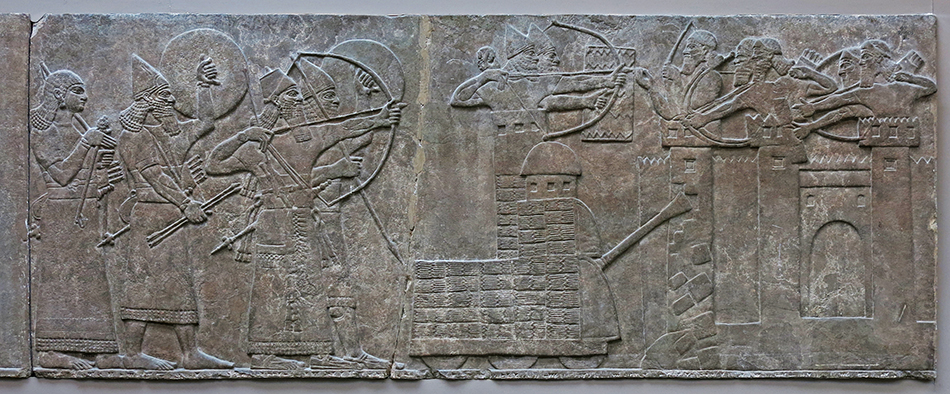
Reign of King Ashurnasirpal II (883-859 BC)
Siege engine used by the Assyrians.
( This is an important panel to understand the use of the seige engines used by the Assyrians, including those of Sennacherib, which are not shown in as detailed a fashion as those from Ashurnasirpal II's reign, and are far less reliable in terms of scale and construction - Don )
This gypsum alabaster wall panel relief, circa 865 BC - 860 BC shows Ashurnasirpal II besieging a strongly-walled town which is being defended by archers. The Assyrians have brought up a wooden siege tower close to the walls, and the archers on the top of it are shooting at the enemy, whilst the men in the lower part of it are breaking down the walls with a battering ram. Behind the tower stands the king shooting at the foe with his bow, and close to him are his armour bearers and an attendant. The panel is inscribed with a cuneiform text.
The panel has a height of 868 mm and a width of 2286 mm.
In set with 124553, 124555, 124540, 124542, 124544, 124546, 124548, 124550, 124551, 124537, 124539, 124536
Catalog: Gypsum alabaster, 124536
Photo: Don Hitchcock 2015
Source: Original, British Museum
Text: Card with the display at the British Museum, http://www.britishmuseum.org/, © Trustees of the British Museum, CC BY-NC-SA 4.0
Reign of King Ashurnasirpal II (883-859 BC)
Siege engine used by the Assyrians.
This is the complete siege engine, a close up of the image BM 124536 shown above.
Ashurnasirpal II used an extremely heavy siege engine, weighing close to a ton, five metres long, two and a half metres high, with six wheels, and protected by a roof and a turret, about three metres higher than the roof. Iron chains were hung from the roof and suspended the ram, which could then swing freely. Its business end was covered by a metal plate, shaped into a blade that was rammed into the bricks of the wall.
Archers occupied the turret. From there they provided protective cover for the ram with their arrows. Over time, the siege engines grew lighter, requiring only four wheels. By the time of Sennacherib’s siege of Lachish (701 BC), he used smaller, prefabricated siege engines, sometimes groups of them all attacking the same wall or gate.
In many of the images from this king's reign, the battering ram is shown at quite a steep angle, as in this image. I would have expected it to be horizontal when in use. The angle may perhaps be explained as for artistic effect, but at first sight it is odd nevertheless.
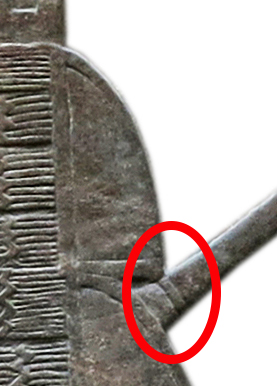
My full explanation for this is given below, but the band around the base of the protruding ram can be identified as a rope lashing.
In addition, the ram is far too close to the roof when fully extended. It would have to have been quite low down to be swung effectively on chains. The longer the chains (and thus the higher the roof from which they were suspended), the greater the destructive power of the ram.
The battering ram gets its energy by being pulled back so that the chains themselves are as close to horizontal as practical, and the ram is thus as close to the roof of the engine as possible. This means that the heavy battering ram has a lot of potential energy by reason of its elevation, supplied by a number of burly soldiers. This energy is released as kinetic energy when the ram is released, as gravity causes it to gain speed and destructive power, which is at its maximum when the ram reaches the point where it is as low as the chains suspending it will allow. The best results are obtained when this point is reached just when the ram hits the wall. The ram would have no effect whatsoever if it were allowed to swing up to a position close to the roof of the engine at the same height as it started.
In the same way, a child on a swing with long ropes will go very fast at the bottom of the arc, and reach a speed of zero at the top of the arc, high above the ground. Physics lecturers sometimes demonstrate this by suspending a heavy metal ball by a thin but strong wire to the ceiling of a classroom or lecture theatre, so that it is just above the floor, then standing well back from the suspension point with the metal ball barely touching their forehead, let it go, and watch as the ball comes back to kiss their forehead gently. Faith in the science is necessary to do this without flinching!
Put 'swinging ball of death' into a search engine to see this performed. And as the lecturer says, 'Don't try this at home!'
It may be that the artists had little practical knowledge of the machines.
Some sources say that the ram used here was simply swung up and dropped down to hit the wall. While that is how some of the reliefs could be interpreted, the amount of energy supplied in such a system would be extremely limited. There is no obvious mechanism for raising the ram apart from it being on an axle, and the ram raised by pulling down on the part inside the siege engine. When dropped, this would waste most of the energy otherwise available, since the weight of the battering ram outside the engine would be compensated for to a large extent by the weight of the ram inside the engine, on the other side of the axle.
A much less powerful ram could however be made by having the wooden pole on an axle placed very close to one end, and this axle then positioned at the front of the engine. The pole could then be raised using a strong rope affixed behind the metal cap. However this rope would need to be raised by soldiers in the tower, and the pole would need to be raised as high as possible before loosing the rope, with the ram then hitting the wall. This pole appears to be able to be raised only to 45°, which again would limit its destructive power considerably.
In addition, this would mean a wooden beam used for the ram of only three metres effective length and corresponding weight. Putting the wooden beam swung horizontally on chains would mean that the beam could be at least five metres longer, thus having a beam of eight metres length rather than three, with a corresponding increase (nearly two times) in weight and thus effectiveness.
The discovery of an iron chain (Garfinkel et al., 2021) found on top of the siege ramp at Lachish also leads us to the method of construction outlined above.
As Garfinkel et al., (2021) point out:
The battering ram was a large, heavy wooden beam with a metal tip on the active end. Its main effect was to deliver a repeated impact on the city wall, until the wall crumbled and collapsed. The ram’s operation required a mechanical device, probably a suspension frame, to swing the heavy beam back and forth. The ram and its operating device were placed inside a siege engine, a large wheeled wooden box covered with metal sheets to protect the attackers from objects hurled from the city above. The machine could carry additional military equipment, which in the case of Lachish seems to have included a water tank (Ussishkin, 2004, fig. 13.59). When all these functions were incorporated in a single siege engine, the result was a very heavy installation, which could easily weigh between 500 kg and 1000 kg (a ton). The wheels enabled this massive device to be propelled up the siege ramp to the city wall. It is likely that the siege engine was moved by both pushing and pulling, and that this was probably therefore done by night. The soldiers operating the ram entered the siege engine only when it was in its final position against the city wall.Catalog: Gypsum alabaster, 124536
Photo: Don Hitchcock 2015
Source: Original, British Museum
Text: Don Hitchcock

I strongly suspect that the reason for the strange orientation of the ram in the reliefs is because the sculptors only saw them when the siege machine had been transported back to the city. The siege machine would not have been dismantled for the trip home, but the ram would have had to be immobilised, it would be dangerous for it to be in battle mode, swinging randomly.
One way to do that would be to put a rope around the beam, then pass the end through a hole in the base of the tower, around the horizontal joist at the front of the roof, back to the beam, then lash the rope tight so that the beam was pressing hard against the base of the tower, so that it could not move. This would also have raised the beam out of the way of the oxen which drew it.
This rope has been faithfully reproduced by yet another sculptor, as shown circled at left, who obviously did not realise that the rope was only put on when the siege engine had to be transported from one battle site to another, or when the siege engine was in storage.
Thus the sculptors thought that the beam when in use was raised and dropped instead of swinging back and forth, and carved the siege engine reliefs to reflect this misunderstanding.
Catalog: Gypsum alabaster, North West Palace, Nimrud, 124554
Photo: Don Hitchcock 2015
Source: Original, British Museum
Text: Don Hitchcock
Reign of King Ashurnasirpal II (883-859 BC)
A siege in progress.
It is very useful to examine this wall relief above, which shows clearly the way that the siege engine was used in battle.
In fact this particular panel is very instructive in many ways, and demonstrates several important types of siege warfare methods and equipment.
Note also that when the relief panel was cut to facilitate transport back to Britain, the cuts were made at angles calculated to cause the least damage to the figures.
Description from the British Museum: Gypsum wall panel relief: showing Ashurnasirpal II besieging a city by a river. Some Assyrians break through the lower walls. A wooden 'siege tower' has been brought up close to the wall of the city, and under its protection the king shoots his arrows at his enemies on the walls. Their main siege engine is under attack. The enemy have caught their battering lever on a chain. Two Assyrians hold it in place with hooks. Torches are thrown but water is piped from the siege engine to quench the flames. Meanwhile the men in the lower part of the tower work the battering-ram. The archers in the upper part of it send out flight after flight of arrows. To the left Assyrian soldiers are digging down the lower walls with iron crowbars. There is an inscription written in cuneiform script.
Height 91 cm, length 216 cm.
Catalog: Gypsum alabaster, North West Palace, Nimrud, 124554
Photo: Don Hitchcock 2015
Source: Original, British Museum
Text: http://www.britishmuseum.org/, © Trustees of the British Museum, CC BY-NC-SA 4.0
Additional text: Don Hitchcock
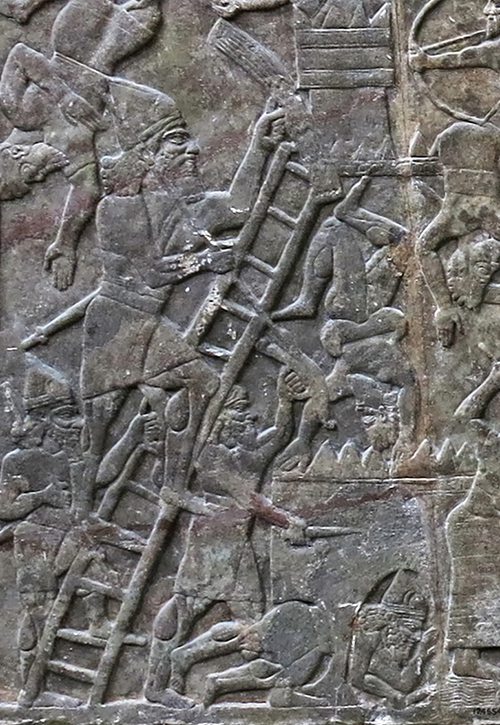
Here an essential item of equipment is shown, a strong (those Assyrian soldiers were heavy!) and long ladder.
While the ladder could be toppled when first laid against the wall, in practice it was immediately stabilised by several soldiers at its base, who provided weight, as shown here, with in this case just one soldier shown holding on to it, with one foot on the ground, and the other on a lower rung.
In addition, the placement of ladders would need to be carefully choreographed, with many used at the same time, and with multiple soldiers on the ladder for just seconds each, in order to send up a large force to overwhelm the defenders. The element of surprise would have been vital.
Much of the depiction of campaigns on these reliefs is schematic or suggestive rather than being completely realistic.
The soldier at the top of the ladder is depicted with what I call a 'half shield' of the rectangular type, and carries a spear.
The full rectangular shield is normally used by pairs of men when an archer is fully exposed, on the siege ramp for example. It is taller and wider than the two soldiers standing behind it, and the archer uses his bow from its protection, while the shield is held in place by another soldier, an assistant to the archer, usually armed only with a short sword or spear.
Two attacking Assyrians are shown falling from the parapet, while a defending archer hangs, slain, from the top of the wall.
At the base of the wall, a sapper is shown entering a tunnel, probably meant for the drainage of waste water and/or sewage, in order for the invaders to gain access by stealth to the city.
Normally there would be one or more defensive metal grates across the tunnel, and these would need to be removed.
Catalog: Gypsum alabaster, North West Palace, Nimrud, 124554, close up
Photo: Don Hitchcock 2015
Source: Original, British Museum
Text: Don Hitchcock
In this section of the panel, two sappers are using long handled tools with iron wedges on the ends to pry bricks from a wall. This destroys the structural integrity of the wall above, and the rest of the bricks (which are of sun-dried mud and straw, with mud for mortar) will come tumbling down.
Catalog: Gypsum alabaster, North West Palace, Nimrud, 124554, close up
The long handled tools are equivalent to a modern Oz 'fencing crowbar' ('digging bar' in the US, a more logical term) such as is used in Australia to dig post holes:
Image above: www.stratco.com.au
On the topmost wall, the defenders are using bows and arrows to kill the attackers. Their position high on the wall gives them an advantage with regard to the archers attacking the city. One of the defenders has been slain by an arrow, and slumps over the wall.
The walls have been set with sharp triangles which are probably of fired clay, in order to discourage boarders. Several women are shown on a mudbrick tower.
Catalog: Gypsum alabaster, North West Palace, Nimrud, 124554
Photo: Don Hitchcock 2015
Source: Original, British Museum
Text: Don Hitchcock
On the left, two sappers have dug out two tunnels into the base of the wall. The city walls were often very thick at the base. The object was to get the walls to collapse into the tunnels. The work was difficult and dangerous, and in this case they may have made the walls of the tunnels thinner and thinner until there were signs of cracking, and then used some method to knock away the thin walls from the outside.
In Mediaeval times in Europe, the tunnels would have been shored up with wooden pillars and beams until a wide tunnel was made, then the tunnel would have been filled with firewood and set alight, causing the pillars and beams to catch fire and collapse, and with them the wall above.
At centre right is a siege engine outlined in green. The wheels are not shown, but there would have been six altogether. The sides appear to be made with wickerwork to keep the weight down, and for easy repair. There is a curious plaque on the front at the base of the tower which shows what may be the king, with a bow. An archer and a stone thrower are standing in the tower, firing their weapons at the defenders.
Two heavy soldiers shelter behind the siege engine and a half shield, held by one soldier, while the other looses an arrow, both kneeling because the half shield does not provide much cover.
A heavy pole with a strong iron cap on its forward end, used as a battering ram, is suspended by at least two chains within the siege engine, each looped under the ram, and attached to the roof at each end. It is not obvious what the loop of rope outlined here in yellow is for. It is unable to be discerned whether the iron cap is mushroom (seen here in profile) or chisel shaped.
Inside the five metre long siege engine would be perhaps six soldiers for an engine of this size, who would pull the battering ram back as far as possible, then loose it to pound the wall made of clay bricks, turning some to dust, and breaking and dislodging others. Eventually the wall would collapse when it was sufficiently undermined.
However things are not going well for the members of the siege engine team. A defender has managed to lower a large strong iron chain in a loop to catch the end of the battering ram, and immobilise it by pulling the chain up until the ram has become jammed on the upper part of the siege engine below the tower.
Two men have been sent outside to fix the problem, which must be common, because they are well prepared with two heavy iron hooks which they have inserted into the links of the chain, and are in the process of pulling the chain down until they can free the chain from the battering ram, preferably by wrenching the chain from the hands of the defender on the wall above.
To make their day complete, the soldiers are being showered with burning torches, outlined here in red, to speed them on their task without delay. The burning torches would certainly inconvenience the soldiers struggling to free the battering ram, but more importantly would serve to set fire to the wicker work of the siege engine itself.
Some help is at hand, because an out of view soldier is pouring water out in two solid streams (shown here in blue) on the torches. It appears that the water has been channelled somehow into (possibly tightly sewn cowskin) tubes so that the water can be directed onto the flames for just such occasions as this.
Catalog: Gypsum alabaster, North West Palace, Nimrud, 124554, close up
Photo: Don Hitchcock 2015
Source: Original, British Museum
Text: Don Hitchcock
As always, click on this small image to see the full size photo.
Reign of King Ashurnasirpal II (883-859 BC)
Ashurnasirpal II
Gypsum wall panel relief showing Ashurnasirpal II hunting lions. Two attendants, wearing conical helmets, and armed with bows and shields, stand ready to dispatch with their daggers the lion which is attacking the king at the back of his chariot.
King Ashurnasirpal shoots at a wounded lion. Killing lions was a royal sport in Assyria, symbolising the king's role as protector of civilisation against savagery, and Ashurnasirpal claimed to have killed 450 lions in all.
Circa 865 BC - 860 BC
Height 887 mm, width 2235 mm.
( This panel is not related to the panel on the right, 124536 - Don )
Catalog: Gypsum alabaster, North West Palace, Nimrud, Room B, Panel 19, (top), 124534
Photo: Don Hitchcock 2015
Source: Original, British Museum
Text: Card with the display at the British Museum, www.britishmuseum.org/, © Trustees of the British Museum, CC BY-NC-SA 4.0
As always, click on this small image to see the full size photo.
Reign of King Ashurnasirpal II (883-859 BC)
Ashurnasirpal II
Circa 865 BC - 860 BC
Gypsum wall panel relief showing Ashurnasirpal II, attended by bowmen, a fan-bearer and courtiers, about to pour a libation over a dead lion while two musicians play on horizontal harps. There is an inscription written in cuneiform.
Height 868 mm, width 2255 mm.
Catalog: Gypsum alabaster, North West Palace, Nimrud, 124535
Photo: Don Hitchcock 2015
Source: Original, British Museum
Text: Card with the display at the British Museum, www.britishmuseum.org/, © Trustees of the British Museum, CC BY-NC-SA 4.0
The King Ashurnasirpal II Gates at Balawat
Reign of King Ashurnasirpal II (883-859 BC)
Bronze gate ornaments showing the achievements of King Ashurnasirpal II
(883-859 BC)
From Balawat, near Nimrud.
These embossed bronze bands, like those
of Shalmaneser III, were attached to the leaves of a door in a
small palace. They show scenes of warfare,
prisoners or tribute-bearers brought
before the king. In the lowest two
registers, the king and his companions
hunt lions and wild cattle.
Catalog: Wood, bronze, ANE 124685-98 (part)
Photo: Don Hitchcock 2015
Source: Original, British Museum
Text: Card with the display at the British Museum, http://www.britishmuseum.org/, © Trustees of the British Museum, CC BY-NC-SA 4.0
Reign of King Ashurnasirpal II (883-859 BC)
Balawat Gates
Bronze gate ornaments showing the achievements of King Ashurnasirpal II
(883-859 BC)
Close up of the right hand gate showing a hunting scene with an archer on a leaping horse with a lion on the ground.
From Balawat, near Nimrud.
Catalog: Wood, bronze, ANE 124685-98 (part)
Photo: Don Hitchcock 2015
Source: Original, British Museum
Text: Card with the display at the British Museum, http://www.britishmuseum.org/, © Trustees of the British Museum, CC BY-NC-SA 4.0
Reign of King Ashurnasirpal II (883-859 BC)
Bronze gate ornaments from a bronze-decorated gate showing horses drawing a chariot, arms bearers, and tributaries.
From Balawat, near Nimrud.
Catalog: Wood, bronze, ME N2063-2065
Photo: Don Hitchcock 2015
Source: Original, British Museum
Text: Card with the display at the British Museum, http://www.britishmuseum.org/, © Trustees of the British Museum, CC BY-NC-SA 4.0
Reign of King Ashurnasirpal II (883-859 BC)
Lidded limestone box with foundation tablets.
Assyrian, circa 875 BC - 865 BC.
From Balawat, near Nimrud.
This box was placed in the Temple of Mamu, god of dreams. The tablets, represented here by plaster casts of the originals (ME 90980-1), give the titles and achievements.
Limestone coffer with lid: containing casts of stone foundation tablets. Inscribed on top and at one end.
Height 36 cm, length 85 cm, width 48 cm.
Named in inscription: Ashurnasirpal II
Catalog: limestone, ME 90980-1, 135121
Photo: Don Hitchcock 2015
Source: Original, British Museum
Text: Card with the display at the British Museum, http://www.britishmuseum.org/, © Trustees of the British Museum, CC BY-NC-SA 4.0
King Shalmaneser III
King Shalmaneser III, 858 BC - 824 BC
Limestone Stela
A round-topped stele, of inferior limestone, much eroded. The king, Shalmaneser III, stands before four divine emblems:
1. The winged disk, the symbol of the god Ashur, or, as some hold, of Shamash.
2. The six-pointed star of Ishtar, goddess of the morning and evening star.
3. The crown of the sky-god Anu, in this instance with three horns, in profile.
4. the disk and crescent of the god Sin as the new and the full moon.
On his collar the king wears as amulets the fork, the symbol of the weather-god, Adad; a segment of a circle, of uncertain meaning; an eight-pointed star in a disk, here probably the symbol of Shamash, the sun-god; a winged disk, again of the god Ashur.
The gesture of the right hand has been much discussed and variously interpreted, either as the end of the action of throwing a kiss as an act of worship, or as resulting from cracking the fingers with the thumb, as a ritual act which is attributed to the Assyrians by later Greek writers, or as being simply a gesture of authority suitable to the king, with no reference to a particular religious significance.
Karen Radner, LMU Munich and University College London, an expert on Assyria, interprets it as a gesture of worship and/or prayer. See 18.50 www.youtube.com/live/GnRNWyf1Rtw
It seems fairly clear that the gesture is described in the phrase 'uban damiqti taraṣu', 'to stretch out a favourable finger', a blessing which corresponds to the reverse action, in which the index finger is not stretched out. There is a cuneiform inscription written across the face and base and around the sides of the stela.
Height 221 cm, width 87 cm, depth 23 cm
Catalog: BM 118884
Photo: British Museum, http://www.britishmuseum.org/, © Trustees of the British Museum, CC BY-NC-SA 4.0
Text: Card with the display at the British Museum, http://www.britishmuseum.org/, © Trustees of the British Museum, CC BY-NC-SA 4.0
Assyrian Empire:

Under Ashur-Dan II (934 BC - 912 BC)

Expansion under Shalmaneser III (858 BC - 824 BC)
Shalmaneser III expanded the Assyrian Empire to include parts of modern-day Turkey, Iran, and Syria. He was known for his military campaigns, which he recorded on the Black Obelisk, a monument that lists the kings he defeated and tribute he received.
One of Shalmaneser's most significant military campaigns was against the state of Urartu, located in modern-day Armenia. He attacked Urartu several times, almost every year of his reign, and eventually defeated the Urartian king Sarduri II in 843 BC.
Shalmaneser also campaigned against the Aramaean states, including Damascus and Israel. He besieged Damascus twice but was unable to capture it. However, his campaigns weakened the Aramaean states and allowed Assyria to gain control over them.
Shalmaneser was also known for his building projects, including the construction of the Central Palace at Nimrud. The palace was decorated with reliefs depicting scenes from Shalmaneser's military campaigns and showed his power and authority as the king of Assyria. He also built several temples in his honour, including the temple of Ninurta at Kalhu.
Photo: www.timetoast.com, threadreaderapp.com
Text: various sources, including Wikipedia
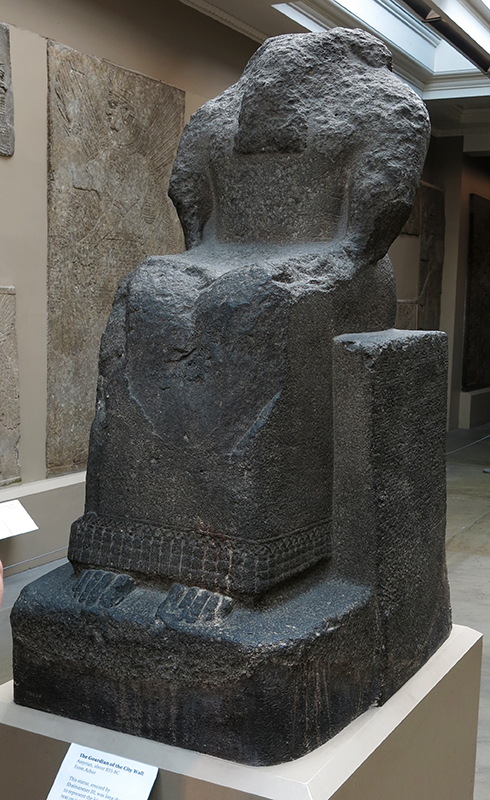
King Shalmaneser III, 858 BC - 824 BC
Headless statue
The Guardian of the City Wall, from Ashur.
This statue, erected by Shalmaneser III, was long thought to represent the king himself. The text on it indicated, however, that the subject is the god Kidudu, guardian spirit of the wall of the city of Ashur. The statue must have been imported into Assyria.
( I assume that the importation of the statue was by reason of the lack of basalt stone, and the technology to shape it. There are few if any statues in difficult to work stone such as basalt extant from the Neo-Assyrian, though there are a few statues in the round of limestone, magnesite, and gypsum alabaster - Don )
Circa 835 BC.
Shipped on the Apprentice, arrived January 1849.
Catalog: ME 118886
Photo: Don Hitchcock 2015
Text: Card with the display at the British Museum, http://www.britishmuseum.org/, © Trustees of the British Museum, CC BY-NC-SA 4.0
King Shalmaneser III, 858 BC - 824 BC
The Black Obelisk
This Black limestone obelisk of Shalmaneser III from Nimrud, circa 825 BC, glorifies the achievements of the king and minister. The illustrations show tributes from all directions. The tribute bearers in five rows, are identified by captions. Each row has four panels, one on each side of the obelisk.
1. Gilzanu (North West Iran), the tribute includes horses.
2. House of Omri (Ancient Israel- tribute from Biblical King Jehu 841BC).
3. Musri, or Egypt tribute or gift of elephant, ape and other exotic animals.
4. Suhi on the Euphrates, scene of animal hunting.
5. Patina in Southern Turkey.
Width 450 - 601 mm, height 820 mm (of plinth), height 1975 mm
Inscription language: Akkadian
Catalog: 118885
Photo: Don Hitchcock 2015
Text: Card with the display at the British Museum, http://www.britishmuseum.org/, © Trustees of the British Museum, CC BY-NC-SA 4.0
The King Shalmaneser III Gates at Balawat
Reign of King Shalmaneser III, 858 BC - 824 BC
This is a full scale reconstruction of the gates from
the palace of Shalmaneser III (859-824 BC) at
Balawat. It is made of cedarwood and fitted with
electrotype (the electrolytic deposition of copper on a mould) copies of the original bronze bands.
The gates were not quite complete when excavated
by H. Rassam in 1878. He described them as
consisting of 'two poles about fifteen feet high - out
of each project half a dozen scrolls each
measuring about six feet in length.' Most of
the missing pieces are in other museums.
It was possible to estimate the gates' original
height, about seven metres, from the length of
the bronze strips placed along the doors' edges.
The spacing of the horizontal bands was indicated
by variations in the corrosion patterns on the
underside of the strips and by the position of
cut-outs at the back, marking the location of the
horizontal bars to which the strips were nailed.
The arrangement of the bands was worked out by
assuming that the tree trunks used as doorposts
tapered upwards. The parts of the bands encircling
the posts would have been smaller towards the
top.
Catalog: Cedarwood and electrotype (deposited copper) BM/Big number unrecorded
Photo: Don Hitchcock 2015
Source: Original, British Museum
Text: Card with the display at the British Museum, http://www.britishmuseum.org/, © Trustees of the British Museum, CC BY-NC-SA 4.0
Reign of King Shalmaneser III
The Palace Gates of Shalmaneser III, 859 BC - 824 BC.
From Balawat, near Nimrud.
( I can just imagine the master craftsman who designed and oversaw the making of these gates looking at them when they were finally completed, and hung in all their glory, saying something like:
"That's not a gate - THIS is a gate! - Don )
Tablets inform us that the gates at Balawat (one days march to the north-east of Nimrud) were made of fragrant cedar wood; they were hung on huge cedar-wood trunks capped with bronze and turned in stone sockets. The gates were perhaps around 6.8 metres high. When they were discovered in 1878 by Hormuzd Rassam, the wood had completely rotted, leaving the bronze fragments now in the Museum. Eight bands were fixed to the outer face of each door, and there is a great variety in the details of the subject-matter and in the workmanship.
The carvings and inscriptions left by Shalmaneser are still visible today south-west of Lake Van in eastern Turkey.
Catalog: Wood, bronze
Photo: Don Hitchcock 2015
Source: Original, British Museum
Text: Card with the display at the British Museum, http://www.britishmuseum.org/, © Trustees of the British Museum, CC BY-NC-SA 4.0
Additional text: Google Arts and Culture
Reign of King Shalmaneser III
The Palace Gates of Shalmaneser III, 859 BC - 824 BC.
From Balawat, near Nimrud.
Bronze ornaments from the gate above.
On the left, the fourth and fifth band from the base of the left door-leaf, showing cattle, rams, goats and horses being driven to a city.
The upper register, from Band VII.2, shows the campaign in Armenia, 857 BC, with images of the Tribute of the men of Gilzani, bringing rams, goats and horses.
The lower two registers, from Band VI.2, show the campaign in Northern Syria, 858 BC, depicting the Tribute of Sangar; the city of Carchemish.
On the right, the third and fourth band from the base of the right door-leaf, showing horse-drawn chariots with two horses and two charioteers moving left, An inspector on a chair with soldiers carrying swords, bows, and quivers of arrows ranked behind him, and carters in front moving to the right across a bridge, then above, carters bringing tributes past date trees, moving to the left.
Plate XI.5, Campaign in Southern Babylonia, 851 BC.
Upper Register: Chaldeans from Bit-Dakuri, carrying tribute through a date plantation.
Lower Register: Assyrian inspector, seated, watching the collection of a tribute at a bridge of boats.
Catalog: Wood, bronze.
Photo: Don Hitchcock 2015
Source: Original, British Museum
Text: Card with the display at the British Museum, http://www.britishmuseum.org/, © Trustees of the British Museum, CC BY-NC-SA 4.0
Specific information on the Bands and their interpretation:
King (1915)
Reign of King Shalmaneser III
The Palace Gates of Shalmaneser III, 859 BC - 824 BC.
From Balawat, near Nimrud.
Band II.3 - Campaign in Armenia, 860 BC.
Upper Register: Slaughter of Urartians by Assyrian chariots, under Shalmaneser's leadership.
A city beside a lake is shown in flames on the left, with archers on chariots killing at will, with dead and wounded on the ground.
Lower Register: Storming and capture of a city of Urartu. Urartu, also known as the Kingdom of Van, is centred around Lake Van in the historic Armenian Highlands.
Ladders were used to storm the city, which is shown in flames, beside a lake. The archers and swordsmen (who carry narrow rectangular shields) are shown as infantry in this case.
Catalog: Wood, bronze.
Photo: Don Hitchcock 2015
Source: Original, British Museum
Text: Card with the display at the British Museum, http://www.britishmuseum.org/, © Trustees of the British Museum, CC BY-NC-SA 4.0
Specific information on the Bands and their interpretation:
King (1915)
Reign of King Shalmaneser III
The Palace Gates of Shalmaneser III, 859 BC - 824 BC.
From Balawat, near Nimrud.
Plate LXII Band XI.3
Campaign in Southern Babylonia, 851 BC.
Upper Register: Shalmaneser receiving the tribute of Adini, the Chaldean.
Lower Register: The head of Shalmaneser's column meeting the Chaldeans bearing tribute.
Catalog: Wood, bronze.
Photo: Don Hitchcock 2015
Source: Original, British Museum
Text: Card with the display at the British Museum, http://www.britishmuseum.org/, © Trustees of the British Museum, CC BY-NC-SA 4.0
Specific information on the Bands and their interpretation:
King (1915)
.
Reign of King Shalmaneser III
The Palace Gates of Shalmaneser III, 859 BC - 824 BC.
From Balawat, near Nimrud.
Plate XIX Band IV.1
Campaign in Northern Syria, 858 BC
Upper Register: Assyrian infantry and chariots at the storming of Dabigu.
Lower Register:Chariots advancing from an Assyrian camp.
Catalog: Wood, bronze.
Photo: Don Hitchcock 2015
Source: Original, British Museum
Text: Card with the display at the British Museum, http://www.britishmuseum.org/, © Trustees of the British Museum, CC BY-NC-SA 4.0
Specific information on the Bands and their interpretation:
King (1915)
The buildings on the citadel of Balawat, with suggested restoration by Professor D. Oates.
The Shalmaneser gates may have been placed at point B, the Ashurnasirpal ones at point A.
Rephotography: Don Hitchcock 2015
Source: Poster, British Museum
Text: Card with the display at the British Museum, http://www.britishmuseum.org/, © Trustees of the British Museum, CC BY-NC-SA 4.0
King Shamshi-Adad V
King Shamshi-Adad V
King of Assyria 823 BC to 811 BC.
The limestone stela shows the Assyrian king Shamshi-Adad V worships in front of god symbols. The cuneiform inscriptions narrate the king's military campaign until 814 BCE.
Limestone stela of Shamshi-Adad V: a round-topped stela of white limestone. The king stands in the gesture of blessing before five divine emblems: the crown of the sky-god Anu, with three horns, the winged disk, the disk and crescent, the fork, the eight-pointed star of Ishtar. The cross worn as an amulet is a symbol of the sun god.
Height 195 cm, width 93 cm, depth 72 cm.
Inscription written in strange form of cuneiform to give impression of age and authority; an incomplete account of the king's campaigns to 815 BC.
This stela sows the king worshipping in front of symbols of the gods. The large cross on his chest is a symbol of the sun god. His dress and beard indicate his role as the king of Babylon after the defeat of Marduk-balassu-iqbi in 814 BC. The inscription is an account of the king's campaigns until about 814 BC. It is written in a type of cuneiform used 1000 years earlier, apparently to give an impression of great age and authority. (text from the museum card)
( Note that there appear to be no inscriptions on the stela. - Don )
The cross worn as an amulet is found not infrequently on seals of the Kassite period in Babylonia, 1500-1000 B.C., and occurs on Sumerian seals of the early archaic period.
Catalog: Limestone, Temple of Nabu, BM/Big number 118892
Photo: Osama Shukir Muhammed Amin FRCP(Glasg)
Permission: Creative Commons Attribution-Share Alike 4.0 International license.
Source: Original, British Museum
Text: Card with the display at the British Museum, http://www.britishmuseum.org/, © Trustees of the British Museum, CC BY-NC-SA 4.0
King Adad-nirari III

Reign of King Adad-nirari III
(also Adad-narari), King of Assyria 811 BC to 783 BC.
This attendant god, one of a pair with 118888, was found at the Temple of god Nabu at Nimrud, Mesopotamia, Iraq. The cuneiform inscription mentions the name of the Assyrian king Adad-nirari III and his mother, Sammuramat.
This limestone statue of an attendant god was dedicated to Nabu by Adad-Nirari III and Sammuramat. It is carved from inferior limestone, standing in the attitude of submission, wearing the single-horned crown proper to minor deities. There is a cuneiform inscription around the skirt. Circa 810 BC - 800 BC.
Height 183 cm.
Inscription translation: ( ' O man coming hereafter, wait on Nabu. Trust no other god.' )
Inscription note: Mentions Adad-Nirari III and his powerful mother Sammuramat, the original Semiramis; ends by advising reader to trust Nabu.
The figure was dedicated to Nabu, the god of learning, in the temple of Ezida at Calah by the governor of Calah and other cities, for the life of the king and of his consort Sammuramat (probably the original of the legendary Semiramis), of the donor and of the people under his rule. The unjustified inference has been drawn that this figure represented Nabu, but it clearly represents an attendant of the kind found in the prophylactic terracotta figurines.
The inscription around the skirts is the same on both figures, and has been published in Rawlinson, vol. i, Plate 35, no. 2, and translated in Luckenbill, 'Ancient Records of Assyria and Babylonia', vol. i, p. 264.
Catalog: Inferior limestone, BM/Big number 118889
Photo: Don Hitchcock 2015
Source: Original, British Museum
Text: Card with the display at the British Museum, http://www.britishmuseum.org/, © Trustees of the British Museum, CC BY-NC-SA 4.0
King Shalmaneser IV
Reign of King Shalmaneser IV
King of Assyria 782 BC to 773 BC.
Stele of Bel-harran-beli-usur, from Tell Abta, west of Mosul, Iraq. 8th century BCE. He prays before the divine symbols of gods.
Photo: Osama Shukir Muhammed Amin FRCP(Glasg)
Permission: Creative Commons Attribution-Share Alike 4.0 International license
Source and text: Ancient Orient Museum, Istanbul, Turkey.
King Ashur-dan III
Reign of King Ashur-dan III
King of Assyria 772 BC to 755 BC.
The eclipse of the sun, June 15, 763 BC. Ashur-dan III is shown watching the eclipse.
The eclipse has been dated to the tenth year of the reign of king Ashur-dan III.
For some years, Assyria had been passing through a period of weakness. Matters reached a climax in 763 BC when the total eclipse of the sun was taken as a terrible portent of the wrath of the gods.
After 765 BC, a very unstable time is suggested in the records. Plague is reported in both 765 and 759 BC and a revolt in the Assyrian heartland is recorded from 763–762 BC, a revolt in Arrapha 761–760 BC and a revolt in Guzana 759–758 BC until peace was at last restored in 758 BC.
Perhaps the many revolts were in response to the plague epidemic as well as the Bur-Sagale solar eclipse on 15 June 763 BC. Solar eclipses, especially full eclipses that were visible to everyone in the empire (as was the case for this eclipse) were always interpreted as bad omens, and as such the epidemic and the eclipse may have been interpreted as the gods withdrawing their divine support for Ashur-dan's rule. The last campaign noted is a third campaign to Hatarikka in 755. It is probable that some, or perhaps even all, of the campaigns were actually led by Shamshi-ilu, rather than the king. Ashur-dan died in 755 BC and was succeeded by his brother, Ashur-nirari V.
Artist: Margaret Dovaston
Photo and text: Hutchinson (1915)
Additional text: Wikipedia
King Ashur-nirari V
Reign of King Ashur-nirari V
King of Assyria 754 BC to 745 BC.
Fragment of a clay tablet; top right corner. Sumerian incantation ?,interlinear. 2 lines of inscription, Neo-Assyrian.
Length 4 cm, width 3 cm.
Like his predecessor, Ashur-nirari ruled during a period of Assyrian decline from which few sources survive. An unusually small share of Ashur-nirari's reign was devoted to campaigns against foreign enemies, perhaps suggesting domestic political instability within Assyria. In 746 or 745 BC, there are records of a revolt in Nimrud, the Assyrian capital.
Catalog: K.15272
Photo and text: British Museum, http://www.britishmuseum.org/, © Trustees of the British Museum, CC BY-NC-SA 4.0
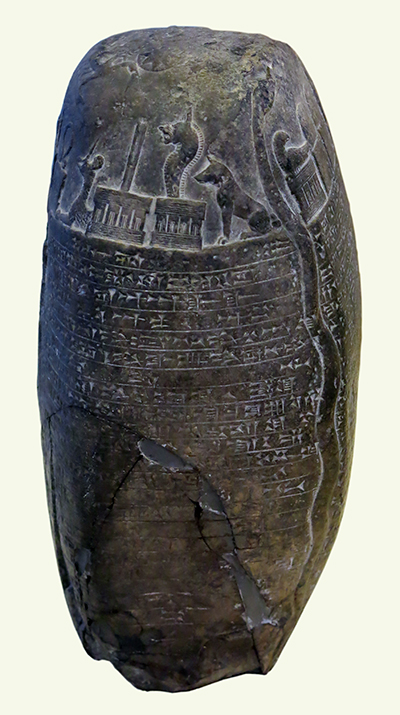
Stele protecting a royal land grant (Akkadian kudurru) of Nabu-shuma-ishkun.
Eighth year of the reign of Nabu-shuma-ishkun, King of Babylon, 761 BC - 748 BC.
Nabû-šuma-iškun, Nabu-shuma-ishkun, meaning 'Nabu has set a name', was king of Babylon, ca. 761 BC – 748 BC, and ruled during a time of great civil unrest. He came from the Bīt-Dakkūri tribe, a Chaldean group apparently unrelated to that of his immediate predecessor, Erība-Marduk.
Found at Borsippa, an important ancient city of Sumer, built on both sides of a lake about 18 km southwest of Babylon on the east bank of the Euphrates.
Following the definition of Belser (1894) who was also the first to label these objects with the term 'kudurru', a kudurru was a stele, a stone document used as a boundary stone and as a record of land grants to vassals by the Kassites and later dynasties in ancient Babylonia between the 16th and 7th centuries BC. The original kudurru would typically be stored in a temple while the person granted the land would be given a clay copy to use to confirm legal ownership.
This stele, circa 753 BC – 752 BC has inscriptions and symbols of the gods, some on pedestals.
Height 220 mm, width 157 mm, thickness 71 mm, weight 3820 gm.
Catalog: Black Limestone, Level 1, Museum of the Ancient Near East, Room 6. VA 3031
Photo: Don Hitchcock 2015
Source and text: Pergamon Museum, Berlin, recherche.smb.museum
Additional text: Wikipedia
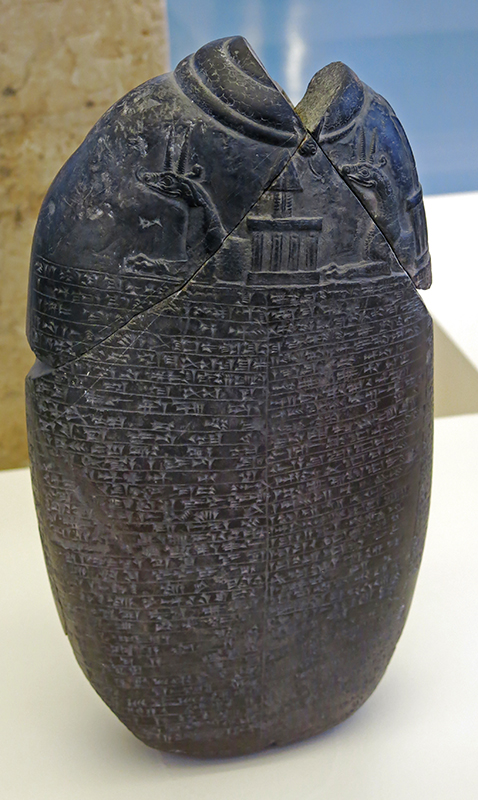
Stele , or kudurru protecting a royal land grant.
This piece in black limestone shows 'fantastic' two horned animals, mušḫuššu, similar to the mušḫuššu of the Ishtar Gate in Babylon.
This stele shows the symbol of Marduk, a triangular headed spade, atop a temple facade pulled by his sacred animal the snake-dragon, Mushus. Closely associated with the city of Babylon, Marduk's importance was tied to the rise of the political power of Babylon as capital of an empire.
Late 8th century BC, 11th year of the reign of Sargon II.
Height 325 mm, width 170 mm, thickness 90 mm, weight calculated as 9 kg.
Catalog: Pergamon Museum, Level 1, Museum of the Near East, Room 6, VA 00209
Photo: Don Hitchcock 2015
Source and text: Pergamon Museum, Berlin, recherche.smb.museum
Additional text (proximal source, an image from elsewhere): http://bharatkalyan97.blogspot.com/2017/07/indus-script-hieroglyphs-on-kassite.html
King Tiglath-pileser III
The Palace of Tiglath-Pileser Ill at Nimrud.The sculptures below once decorated the palace of King Tiglathpileser Ill (reigned 744-727 BC) in the Assyrian capital at Nimrud, in northern Iraq, and are displayed in a room at the British Museum.
Tiglath-pileser was one of the most successful Assyrian kings. His military campaigns extended north into Urartu (Ararat), east into Iran, west to the Mediterranean and south to the borders of Egypt. He transformed troublesome foreign kingdoms into provinces of the empire ruled directly by Assyrian governors.
Towards the end of his reign, Tiglath-pileser began to build a new palace (the Central Palace) at Nimrud, but this was never finished. A later Assyrian king, Esarhaddon (reigned 680-669 BC), chose to build another palace at Nimrud (the South-West Palace).
When the archaeologist Austen Henry Layard excavated both palaces in the 1840s, he found that many of the reliefs from the Central Palace had been stacked for removal to Esarhaddon's new palace, while others had already been moved there. Some had their carved side turned to the wall, and few survive in good condition.
Text above: Adapted from a poster with the display at the British Museum, http://www.britishmuseum.org/, © Trustees of the British Museum, CC BY-NC-SA 4.0
Neo-Assyrian, reign of King Tiglath-pileser III, 744 BC - 727 BC.
Gypsum alabaster wall panel relief
In the upper register of this wall panel relief, a line of Assyrian warriors moves to the left. On the right, an Assyrian soldier wears a mail-shirt over the tunic decorated with the fringed border which hangs down between his knees, and, as it seems, a helmet, pulls at the branches of a low tree.
In front of this soldier are six warriors consisting of three slingers and before them, a man with round shield and dagger, all similarly dressed, except that the tunic of the shield-bearer is richly ornamented with concentric squares.
He follows a pair of warriors; the first, wearing a garment decorated with fringes and small discs put into squares, is an archer; the man partly hidden by him and wearing an ornamented tunic holds a dagger in his right hand. The attitude of this pair strongly reminds one of two warriors standing behind the siege-shield, and Layard understandably mistook the figure in front of them as that of a shield.
He is, however, a man dressed in a fringed and ornamented garment.
The upper register is noteworthy, because the ritual scene, the anointing of a bare tree, carried out in this case by a man in military dress, on a small scale which can only be explained as showing the action takes place in the distance, is combined with dagger men, archers, and slingers arranged as if in a siege scene. It is possible that the soldiers are marching in a procession, but not probable in view of the actions of the bowmen and slingers.
In the lower register, the king, Tiglath-pileser III, facing to the left, places his foot on the neck of an enemy. He wears his high crown decorated with the three bands, the ends of the lowest hanging down on his back, and a fringed garment. His wrists are ornamented with four-fold bracelets and round his neck hangs a necklace with the divine symbols of Sin (crescent), Istar (star), Samas (sun), Anu (horned cap), and Adad (trident).
He holds a bow in his left hand; in his right hand he points a spear at the suppliant enemy upon whose neck he puts his right foot, apparently condemning him to death. The enemy has fallen to his knees, his face nearly touching the ground. He wears a long garment and a round cap, and has a close beard.
Behind the king stands a beardless attendant, a fringed cloth over his left shoulder, his right hand holding a fan. The victim is introduced by the 'vizier', wearing a fringed garment and wrap, who raises his right hand. A beardless attendant, following him and similarly dressed, wears sandals. This is curious, because the 'vizier' seems to be without them, at least they are no longer visible in the relief. The mutilation of the king's face may be due to the action of Sargon. The inscription is in two columns, the beginnings of the lines in column I and the ends of the lines in column II being lost.
( Note that the 'vizier' may be Tiglath-pileser III's son, Shalmaneser V, during his time as crown prince to his father - Don )
An inscription note in cuneiform describes some of the campaigns of Tiglath Pileser III in Iran in 744BC. The inscription on this slab was recorded by Layard, 'Inscriptions in the Cuneiform Character', pl.51 (= Rost, 'Die Keilschrifttexte Tiglat-Pilesers III', pls.IX-X); it deals with Tiglath-pileser III's campaigns against the provinces of Media. The Annals of the king report two campaigns against Media, one in his 2nd, the other in his 9th 'palû'. According to Rost, the part of the inscription preserved on this slab belongs to the campaign of the 2nd 'palû'.
Height 272 cm, length 239 cm.
This wall panel forms one of a series with two disconnected scenes.
Catalog: Nimrud, gypsum alabaster, North West Palace (Nimrud), reused in the South West Palace (Nimrud), BM/Big number 118933
Photo: Don Hitchcock 2015
Source: Original, British Museum
Text: Card with the display at the British Museum, http://www.britishmuseum.org/, © Trustees of the British Museum, CC BY-NC-SA 4.0
Neo-Assyrian, reign of Tiglath-pileser III, 744 BC - 727 BC.
Gypsum alabaster wall panel relief
In the upper register a city, depicted in plan and in a series of three elevations, is attacked by the Assyrians. Of the three elevations, the uppermost, at the top of the slab, is now completely effaced. The middle one recedes from the lower on the left-hand side, but coincides on the right, a fact which precludes the interpretation as an upper storey, or even as a middle line of defence.
The two walls might, in this kind of representation, be the two walls, of different length, meeting at the corner represented in plan; but this leaves the third wall unexplained. Apparently only women remain in this middle section of the defence, ready to surrender.
In the lowest elevation archers are seen in embrasures, fighting behind a parapet which also serves as the outline of the plan of the city. In other embrasures there are round-topped objects which may represent doors, for inside the city plan, in the centre, two Assyrian soldiers, defending their heads with shields, cut through such an object with daggers, while on the left four others carry away the booty already seized, a couch and two sacks of goods.
To the right lie enemy dead, and an Assyrian soldier is driving an ox away. The plan is used for yet another type of picture; two auxiliaries, wearing crested helmets and crossed bands, have advanced from behind a palisade to force a breach at the corner of the city wall, and are attacking the brickwork, represented in plan, with their lances, while defending themselves with their shields.
The mixture of elevation and plan in this scene, though characteristic, is unusual in Assyrian work by reason of its complexity.
The inscription on the centre band gives 12 lines of one column, the commencement broken, and the beginnings of 11 lines of a second.
Inscription translation: The 'erib-biti' priests of the temples of Esagila, Ezida, and Emeslam brought me the 'rihati' of Bel Nabu, and Nergal. ... I richly adorned them and they went their way to their own land.
Inscription note: Describes the resettlement of prisoners after the Assyrian campaign of 745 BC. Written in 12 fines of one column, the commencement broken, and the beginnings of 11 lines of a second.
In the lower register a procession of Assyrian soldiers carries away statues of the gods. It is very doubtful whether the head of the first deity was turned full-face, and the head-dress has completely disappeared.
The honourable treatment accorded these gods and the types represented show that these were deities recognised by the Assyrians; the first two are forms of Ishtar, the fourth is the weather god, whether his name be Adad or some other form. It is not impossible that the scenes in both registers depict incidents in the campaign against the Chaldaeans to which the text on the centre band refers. It may be that the lower scene shows statues of Babylonian gods returned to their own cities by the Assyrians.
Height 272 cm, length 254 cm.
Named in inscription & portrayed: Tiglath-pileser III, representation of Ishtar and Adad, named in inscription Bel, Nabu, Nergal, Temple of Nabu (Borsippa).
Catalog: Nimrud, gypsum alabaster, Central Palace, reused in the South West Palace (Nimrud), BM/Big number 118934
Photo: Don Hitchcock 2015
Source: Original, British Museum
Text: Card with the display at the British Museum, http://www.britishmuseum.org/, © Trustees of the British Museum, CC BY-NC-SA 4.0
Neo-Assyrian, reign of Tiglath-pileser III, 744 BC - 727 BC.
Gypsum alabaster wall panel relief
( there are two panels joined here, the join may be identified by a vertical somewhat lighter colour - Don )
The relief on the left, BM 118882, shows a city captured, its inhabitants and animals being driven away.
The city is surrounded by a double wall fortified with turrets and battlements. The walls are crenellated but have no openings. Three square gateways with double doors lead into the city, within which a date-palm grows. This indicates that this scene is laid in Babylonia.
On a low platform in front of the walls, apparently made by the Assyrians for the attack, stand two battering rams (of that to the left only traces are visible). They are not in action because the city is already taken. A scribe writes to an officer's dictation as women and children are driving away in bullock-carts with eight-spoked wheels.
The cart nearest to the city is heavily loaded and on top of it sit two women, their feet resting on the backs of the bullocks, and a little boy. The first woman has long hair hanging down to her neck and holds a bottle with both hands. The woman behind her holds a staff in her right hand, and her veil hangs down over her shoulders. The boy seems to wear a cap (or coiffure?) with a sort of tuft.
The second cart is lower, but longer. It seems to carry a mother with her son and daughter. The boy is somewhat older than that in the first cart but wears a similar cap(?). The girl holds a water-skin in her left hand. Both women wear a cloth or garment which covers their heads. In front of the carts is a herd of cattle, beyond them a date-palm. This is only the left part of a group. The full group shows the deportation during Tiglath-Pileser III's campaigns in Southern Iraq.
Height 99 cm, length 290 cm. When combined with the panel on the right, length is 1105 cm.
( There appears to me to be some error with the lengths of these panels in all parts of the BM notes with regard to this item. The numbers do not match up - Don )
On the right hand edge of the left panel, BM 1849,0502.6, a beardless officer stands, wearing a long garment and a fringed wrap, his left hand resting on his sword, his right holding a short stick. He appears to be counting out the spoil to the two Assyrian scribes standing opposite him in the right hand panel, BM 1848, 1104.5. Both are beardless like the officer, but their garments are decorated with fringes and they wear sandals.
The first holds a clay-tablet in his left, the stylus in his right hand; the second is writing on a roll presumably made of leather; they are the Scribe of the Cuneiform and his colleague, the writer of Aramaic. The artist seems to have intentionally given the scribes slightly different features from the officer.
The counted spoil, fat-tailed sheep and goats, is arranged in two rows. They are driven away by a beardless officer. To the right traces are visible of a male figure with raised arm, obviously an Assyrian soldier who follows a line of prisoners.
The full group shows the deportation during Tiglath-Pileser III's campaigns in Southern Iraq; on the left, a captured town with siege engine by the gate; in the centre Assyrian clerks with tablet and scroll record details of campaign; civilian prisoners with possessions and livestock are moving to the right.
Left panel: 1849,0502.6, height 99 cm, length 290 cm.
Right panel: 1848, 1104.5, height: 97 cm, length 142 cm
Layard, after having drawn slabs 1848,1105.5 and 1849,0502.6 (BM. 118882), realised that the two reliefs formed one scene and provided a short description of it in ‘Nineveh and its Remains’, vol. II, pp.22-3.
Catalog: Nimrud, Central Palace, gypsum alabaster, BM/Big number 118882
Photo: Don Hitchcock 2015
Source: Original, British Museum
Text: Card with the display at the British Museum, http://www.britishmuseum.org/, © Trustees of the British Museum, CC BY-NC-SA 4.0
Neo-Assyrian, reign of Tiglath-pileser III, 744 BC - 727 BC.
Gypsum alabaster wall panel relief, Capture of Astartu
Gypsum wall panel low relief. The text on this panel describes a campaign in the north, but the upper composition represented a campaign in the west, and the name of the town represented, Astartu, is given in a caption at the top.
Astartu is shown as a typical Middle Eastern fortress town, built on top of a mound which probably covered the remains of much older settlements. There are towers at intervals along the walls, and a high town gate; inside, at the top on the left, is a building with an arched entrance, perhaps the citadel.
The town has just been captured and its inhabitants are being marched away. An Assyrian soldier waving a mace escorts four prisoners, who carry their possessions in sacks over their shoulders. Their clothes and their turbans, rising to a slight point which flops backwards, are typical of the area; people from the Biblical kingdom of Israel, shown on other sculptures, wear the same dress.
Above them a second Assyrian soldier is driving two fat-tailed sheep. Further to the right they would have met the Assyrian king, reviewing his troops and their booty.
In the lower register, the king Tiglath-pileser III himself appears in a chariot under his tasselled state parasol, which is held by a eunuch. He wears the royal hat, somewhat higher than the ninth-century type, and a fringed robe. His right hand is raised, while his left holds a flower.
His chariot is larger than the ninth-century type, with a quiver at the front, and the wheels have eight spokes rather than six. The patterns on the cloth hanging between the front of the chariot and the yoke include a winged disc, a solar symbol of great significance throughout the Ancient Near East.
The charioteer holds three reins, but two horses are actually shown drawing the chariot, gaily caparisoned and led by a pair of grooms wearing quivers. The one man visible in the poorly preserved chariot to the right once held a pole with a circular ornament on top. This was one of the sacred standards which accompanied the Assyrians into battle.
Circa 730 BC - 727 BC.
Length 1880 mm, width 1950 mm, thickness 160 mm.
The inscription identifies the city as Astartu, the Biblical Ashtaroth Karnaim in Gilead (now identified as Tell Ashtara).
This panel, once the left end of a composition, was found reused in a later palace. It belonged to a series in which a central band of inscription, listing the events of the reign in chronological order, divided two independent compositions in separate registers.
Catalog: Nimrud, South West Palace, gypsum alabaster, BM/Big number 118908
Photo: Don Hitchcock 2015
Source: Original, British Museum
Text: Card with the display at the British Museum, http://www.britishmuseum.org/, © Trustees of the British Museum, CC BY-NC-SA 4.0
Neo-Assyrian, reign of Tiglath-pileser III, 744 BC - 727 BC.
Gypsum alabaster, wall panel relief
Three Assyrian soldiers, behind a siege-shield facing to the left, attack a city. The drawing ( perhaps Or.Dr.III, 'Central VI: "Seige of a City"', an original drawing held in the British Museum collection - Don ) shows another identical group standing behind them. The first and nearest soldier, an archer, is beardless and wears a long garment held at the waist by a broad fringed(?) girdle. His sword-belt runs From his right shoulder to his left hip. The narrow object on his back is perhaps a bow-case, since the quivers in Tiglath-pileser's reliefs are broader and usually have fringes attached to them. The second archer has a full beard, a long garment, and also a sword. The third soldier, with a full beard and dressed in a tunic, has a dagger in his right hand, while with the left he holds the tall shield. This full-size shield, used only in sieges, has the upper square return, characteristic of the time of Tiglath-pileser III. All three men wear round caps or helmets with earflaps.
The Assyrians are attacking a castle or small fortified city surrounded by water (lake or moat?); on its bank grow date-palms and a pomegranate tree, indicating some locality in southern Babylonia. On the relief there remain only part of a turret and the arm of an archer shooting against the attackers.
This panel is one of a set of panels showing Tiglath-Pileser III's campaigns in Southern Iraq.
Height 103 cm, width 109 cm.
Catalog: Nimrud, Central Palace, gypsum alabaster, BM/Big number 118904
Photo: Don Hitchcock 2015
Source: Original, British Museum
Text: Card with the display at the British Museum, http://www.britishmuseum.org/, © Trustees of the British Museum, CC BY-NC-SA 4.0
Neo-Assyrian, reign of Tiglath-pileser III, 744 BC - 727 BC.
Gypsum alabaster wall panel relief
Assyrian soldiers attack a triple-walled city from the right. It stands on an artificial mound on which grows a date-palm, indicating a locality in Babylonia. Its walls are fortified with turrets and battlements. A square gateway on the left with double doors leads into it. A pair of archers stands on both the first and second wall. They wear tunics and have long curly hair and beards. Their arms consist of bows, swords, and quivers equipped with fringes. In front of the platform supporting the city lie two naked headless bodies; one of the defenders falls down from the wall, head first, his hair falling over his forehead.
The Assyrians have built a ramp, up which they move their battering ram to the level of the city. The machine has four wheels and is covered with some kind of fringed cloth. A pair of archers stand in its small tower. A third, wearing a fringed garment, kneels on its back. Behind it, a naked headless body falls to the ground.
The upper right part of the relief shows an Assyrian soldier spearing a fallen enemy. He has a pointed beard and short curly hair, and wears a broad girdle held by two crossed bands with a small disc in the middle. His pointed helmet is crowned with a crescent-shaped feathered crest from which a band-like projection hangs down on the back of the helmet. He holds a round shield in his right hand, in his left, his spear. His victim, holding two arrows in his right, his bow in his left hand, falls against a date-palm which is breaking down. The object behind the soldier's feet is probably the trunk of another palm tree cut down by the Assyrians.
The panel is peculiarly interesting because the two lower horizontal lines of the building slope upwards in the representation at different angles. This secures a counterbalance to the slope of the ramp, but is not necessarily due to the desire for balance. It seems clear that the three superimposed walls are not stories of a building, nor even three successive walls, for then the middle wall would not need defence at the same moment as the outermost wall. It seems possible that the three walls represent three sides of the whole fortification, with the object of showing that the defence continued active on two sides when the defence of the third side had ceased action. The location of the town in Babylonia seems to be marked by the palm-tree shown inside the lowest wall. This panel is one of a set showing Tiglath-Pileser III's campaigns in Southern Iraq.
Height 99 cm, width 101 cm.
Catalog: Nimrud, Central Palace, gypsum alabaster, BM/Big number 118902
Photo: Don Hitchcock 2015
Source: Original, British Museum
Text: Card with the display at the British Museum, http://www.britishmuseum.org/, © Trustees of the British Museum, CC BY-NC-SA 4.0
Neo-Assyrian, reign of Tiglath-pileser III, 744 BC - 727 BC.
Gypsum alabaster wall panel relief
Bas-relief of an attack on an enemy town during the reign of Tiglath-Pileser III from his palace at Kalhu (Nimrud), gypsum, now in the collections of the British Museum on loan to the Getty Villa.
( Note that this siege engine is shown with two battering rams held together with a rope or leather strap.
As noted above, these images were likely created by the sculptors from siege engines in storage at the palace. The battering ram when in use was singular and horizontal, swinging on several chains attached to the roof.
When being transported back to the palace, the battering ram was tied up to the joist at the front of the roof of the siege engine in order to secure it for the journey, and to get it out of the way of the oxen used to pull the engine.
In this case, it would appear that the artist saw a siege engine in storage in which an extra battering ram was placed, probably because the engine it had been in was in no condition to be transported, but the battering ram itself was valuable, so the two were tied together in one engine for the journey - Don )
Photo: Mary Harrsch
Permission: Creative Commons Attribution-Share Alike 4.0 International license.
Source: Original, British Museum
Proximal source and text: Wikipedia
King Shalmaneser V
Reign of King Shalmaneser V
Reign: 726 BC - 722 BC
The person identified as a 'vizier' with raised right hand on the left of Tiglath-pileser III in this image may be Tiglath-pileser III's son, Shalmaneser V, during Shalmaneser V's time as crown prince to his father.
Shalmaneser campaigned extensively in the lands west of the Assyrian heartland, warring not only against the Israelites, but also against the Phoenician city-states and against kingdoms in Anatolia. Though he successfully annexed some lands to the Assyrian Empire, his campaigns resulted in long and drawn-out sieges lasting several years, some being unresolved at the end of his reign. The circumstances of his deposition and death are not clear, though they were likely violent, and it is unlikely that Sargon II was his legitimate heir. It is possible that Sargon II was entirely unrelated, which would make Shalmaneser V the final king of the Adaside dynasty, which had ruled Assyria for almost a thousand years.
Catalog: Nimrud, gypsum alabaster, North West Palace (Nimrud), reused in the South West Palace (Nimrud), BM/Big number 118933
Photo: Don Hitchcock 2015
Source: Original, British Museum
Text: Card with the display at the British Museum, http://www.britishmuseum.org/, © Trustees of the British Museum, CC BY-NC-SA 4.0
Additional text: Wikipedia
Stele protecting a royal land grant of Marduk - apla - iddina II.
Merodach-Baladan, King of Babylon, enfeoffs (gives someone freehold property or land in exchange for their pledged service) a vassal.
Place of discovery unknown.
Symbols of the gods on the upper register, below the enfeoffment scene.
715 / 714 BC (seventh year of the reign of Marduk-apla-iddina II).
The Babylonian king Marduk-apla-iddina II, named in the inscription, (and called Merodach-Baladan in the bible) is depicted on the left. In front of him is the temple functionary Belu-sche-eriba whose services to the country and its people are acknowledged in the text. They were the reason for the donation of the land, which was to be protected by this stone monument. The text begins with an explanation of the divine legitimacy of the king and his deeds for the good of the Babylonian empire. The main part describes in cadastral form the location of the plots of land in the surrounding countryside in relation to canals, roads and other plots.
It ends with a curse against the man who does something against the land donation, 'That man Anu, Ea and Bel, the great gods; as far as their names are mentioned in this tablet, may destroy his name, seed and offspring in the mouth of the people, cut off his further life. The tablet is sealed with the king's seal of decree, so that no action for change or recovery may be brought.'
Marduk-apla-iddina II, in the Bible Merodach-Baladan, was a Chaldean leader from the Bit-Yakin tribe, originally established in the territory of the Sealand in southern Babylonia. He seized the Babylonian throne in 722 BC from Assyrian control and reigned from 722 BC to 710 BC, and from 703 BC to 702 BC. His reign is defined by some historians as an illegitimate Third Dynasty of the Sealand, inside of the Xth Dynasty of Babylon, or Assyrian Dynasty.
He was known as one of the kings who maintained Babylonian independence in the face of Assyrian military supremacy for more than a decade.
Sargon of Assyria repressed the allies of Marduk-apla-iddina II in Elam, Aram and Israel and eventually drove (ca. 710 BC) him from Babylon. After the death of Sargon, Marduk-apla-iddina II briefly recaptured the throne from a native Babylonian nobleman. He reigned nine months (703 BC – 702 BC). He returned from Elam and ignited rebellion in Babylonia. He was able to enter Babylon and be declared king again. Nine months later he was defeated near Kish by the Assyrians, but managed to flee to Elam. He died in exile a couple of years later.
In the Bible He is mentioned as king of Babylon in the days of King Hezekiah, both in 2 Kings 20:12 (here called Berodach-baladan) and in Isaiah 39:1. In both passages he sends Hezekiah a letter, having heard of his illness and recovery. His messengers who have delivered the letter are lavishly entertained by Hezekiah, leading the prophet Isaiah to criticise Hezekiah for his excessive openness about the wealth he had amassed.
Height: 460 mm, width 330 mm, thickness 105 mm, weight calculated as 27 kg.
Catalog: Limestone, Pergamon Museum, Level 1, Museum of the Ancient Near East, Room 6, VA 02663
Photo: Don Hitchcock 2015
Source and text: Pergamon Museum, Berlin, recherche.smb.museum
Additional text: Wikipedia
King Sargon II
Sargon II was the king of the Neo-Assyrian Empire from the downfall of his predecessor Shalmaneser V in 722 BC to his death in battle in 705 BC. Sargon is recognised as one of the most important Neo-Assyrian kings due to his role in founding the Sargonid dynasty, which would rule the Neo-Assyrian Empire until its fall less than a century after Sargon's death.The king probably took the name Sargon from the legendary ruler Sargon of Akkad, who had founded the Akkadian Empire and ruled most of Mesopotamia almost two thousand years prior. Through his military campaigns aimed at world conquest, Sargon II aspired to follow in the footsteps of his ancient namesake. Sargon sought to project an image of piety, justice, energy, intelligence and strength and remains recognised as a great conqueror and tactician due to his many military accomplishments.
His greatest campaigns were his 714 BC war against Urartu, Assyria's northern neighbor, and his 710–709 BC reconquest of Babylon, which had successfully re-established itself as an independent kingdom upon Shalmaneser V's death. In the war against Urartu, Sargon circumvented the series of Urartian fortifications alongside the border of the two kingdoms by marching around them along a longer route and he successfully seized and plundered Urartu's holiest city, Musasir. In the Babylonian campaign, Sargon also attacked from an unexpected front, first marching alongside the Tigris river and then attacking the kingdom from the southeast rather than the north.
After the Babylonian conquest he resided at Babylon for three years, with his crown prince and heir Sennacherib serving as regent in Assyria, but he moved to Dur-Sharrukin upon its near completion in 706 BC.
Text above: adapted from Wikipedia
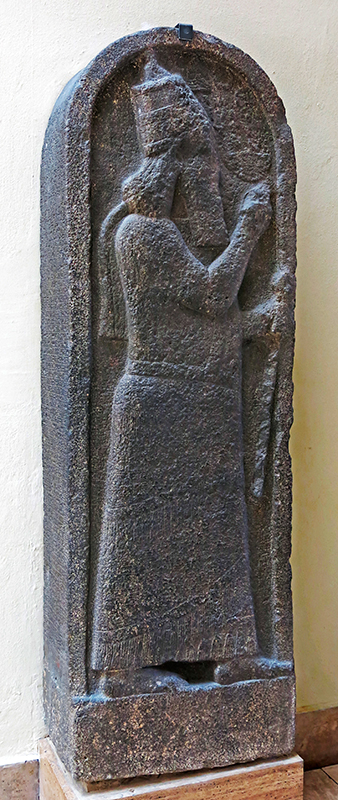
King Sargon II
Reigned 722 BC – 705 BC
The Sargon Stele shown at left was found in the autumn of 1845 in Cyprus on the site of the former city-kingdom of Kition, in present-day Larnaca to the west of the old harbour of Kition on the archaeological site of Bamboula. The language on the stele is Assyrian Akkadian.
The basalt stele was placed there during the time Sargon II (reigned 722 BC – 705 BC) ruled the Neo Assyrian Empire. It was offered for sale to the British Museum, which bid 20 pounds. Ludwig Ross offered 50 pounds for the stele and it was shipped to Berlin.
Together with the stele was found a gilded silver plaquette, that today is located at the Louvre.
It was erected by King Sargon II of the Neo-Assyrian Empire near Kition (modern Larnaca) and describes his conquests, and notes the voluntary submission of the Seven Kings of the Land of Ia (which has been identified as Cyprus) and Iatnana meaning the Islands of the Danaans, i.e., Greece. Likely this act of submission provided the Cypriot kings with a trade network and a source of stable markets for the exportation of copper and other trade goods.
The site of this royal monument in Cyprus impressively illustrates that the influence of the Assyrian Empire reached very far west in the late 8th century BC.
Height 210 cm, width 68 cm, thickness 35 cm.
The stele shows King Sargon II in typical Assyrian royal costume with a long, fringed robe and royal headdress. In his left hand he holds a club, his right hand is raised in prayer.
In front of his head are eight symbols representing various Assyrian deities. The same eight gods are invoked in the first lines of the long inscription placed on the front of the stela.
In the rest of the text, Sargon's royal titles are mentioned, as well as his military successes, and his role as protector of the Marduk sanctuary in Babylon is emphasised.
In addition, legations from distant lands are enumerated. The last lines of the inscription refer to the erection of the stele itself, instruct future kings to preserve it, and conclude with the obligatory curse formulas against those who would harm this image of the king.
Catalog: Basalt, Pergamon Museum, Level 1, Museum of the Ancient Near East, Room 3, VA 00968
Photo: Don Hitchcock 2015
Source and text: Pergamon Museum, Berlin, recherche.smb.museum, with additional text by Anja Fügert
Additional external text: Wikipedia, cyprusthepodcast.podbean.com/e/primary-source-v-the-sargon-stele/
,
Reign of King Sargon II
Reigned 722 BC – 705 BC
Carved gypsum sculpture of a protective spirit facing left: a winged bull from a gateway in the citadel wall at Khorsabad, with panels showing a winged divine figure about to anoint with a 'cone' and magical fluid from a bucket. It is one of a pair, which were intended to keep evil from entering.
Production date 710 BC - 705 BC
Height 4038 mm, length 4860 mm, width 1981 mm.
Inscription note: Sennachrib named in inscription.
These gigantic figures guarded one side of one of the gates into the citadel, and were intended to deter evil of all kinds from entering. The corresponding figures from the opposite side of the same gateway are displayed to the right. The weight of one of the bulls has been estimated at sixteen tons. The Assyrians moved each bull in one piece, but for transport to England it was sawn into four pieces.
Catalog: Khorsabad, BM/Big number 118808
Photo: Don Hitchcock 2015
Source: Original, British Museum
Text: Card with the display at the British Museum, http://www.britishmuseum.org/, © Trustees of the British Museum, CC BY-NC-SA 4.0
Reign of King Sargon II
Reigned 722 BC – 705 BC
Carved gypsum sculpture of a protective spirit facing left: a winged bull from a gateway in the citadel wall at Khorsabad, with panels showing a winged divine figure about to anoint with a 'cone' and magical fluid from a bucket. It is one of a pair, which were intended to keep evil from entering.
Gypsum alabaster is a fine-grained, massive gypsum that has been used for centuries for statuary, carvings, and other ornaments. It normally is snow-white and translucent but can be artificially dyed; it may be made opaque and similar in appearance to marble by heat treatment.
Production date 710 BC - 705 BC
Height 4038 mm, length 4860 mm, width 1981 mm.
Inscription note: Sennachrib named in inscription.
Catalog: Khorsabad, BM/Big number 118808
Photo: Don Hitchcock 2015
Source: Original, British Museum
Text: Card with the display at the British Museum, http://www.britishmuseum.org/, © Trustees of the British Museum, CC BY-NC-SA 4.0

Reign of Sargon II, 722 BC – 705 BC
Archer
Wall panel, bas-relief, depicting an archer, facing right, with a bow and arrows, wearing a loin-cloth with fringe, clearly not an Assyrian. From a scene showing Sargon II's attacks on the town of Amqaruna (Biblical Ekron) in central Palestine, probably in 720 BC.
Circa 710 BC - 705 BC
( As the BM notes, this is clearly not an Assyrian. The first thing that struck me was the physique of this soldier - he is slim, with a runner's legs, quite unlike the heavy set Assyrians with huge leg muscles, adapted for heavy work - Don )
Height 124 cm.
Catalog: Gypsum alabaster, Palace of Sargon II, Khorsabad, Iraq, BM/Big number 118835
Photo: Don Hitchcock 2015
Source: Original, British Museum
Text: Card with the display at the British Museum, http://www.britishmuseum.org/, © Trustees of the British Museum, CC BY-NC-SA 4.0
Reign of Sargon II, 722 BC – 705 BC
Wall Panel, 710 BC - 705 BC
Burnt gypsum wall panel in relief. This frieze is remarkable for two features. Though the position of the archer as represented is possible, the rendering of the right arm ( left arm? - Don ) seems unnatural.
The variation in the size of the figures and the trees is remarkable in that it cannot be explained as due to a convention; this is not a case where the king is taller than his officers or common soldiers, or the Assyrians than the enemy. The figure of the archer looking for a target on this slab does not represent a man inferior in rank to the archers and men carrying dead game.
The variation in size is effective from the point of view of design, especially in the case of the trees; but it must depend on the - not uncommon - knowledge of perspective. The small figure in this slab wears an unusual tunic, with a chequer design of concentric squares. The stone is broken in many places and discoloured. The portions which show black in the reproduction, in three of the large trees, the bare right arm of the archer and the lower part of the tunic of the small figure, are restorations.
Findspot: Khorsabad, Palace of Sargon II (detached building on private side for royal use)
This was one of the few discoveries made at Khorsabad by Layard.
The museum card gives the catalog number as WA118829, but the online catalog only recognises 118829.
Height 131 cm, length 178 cm.
This hunting scene was part of a continuous frieze, of which another slab is in the Musée du Louvre; see 'Encyclopidié photographique de l' Art. Le Musée du Louvre', tome i (Paris, n.d.), 318.
Catalog: Gypsum, 118829
Photo: Don Hitchcock 2015
Source: Original, British Museum
Text: Card with the display at the British Museum, http://www.britishmuseum.org/, © Trustees of the British Museum, CC BY-NC-SA 4.0
Reign of Sargon II, 722 BC – 705 BC
Attendant
(left, 118814, right 118813) Wall panels, bas-relief, each showing an attendant in the form of a protective spirit, from a ritual scene. The object held in the left hand is often described a palm-branch; it may be intended for branched twigs, but the ends seem artificial and there is no reason to associate them especially with the palm. Sumerian figures wearing the flounced robe sometimes hold similar branched twigs, if such are intended.
Circa 710 - 705 BC
Height (118814): 91 cm.
Height (118813): 108 cm.
Catalog: Gypsum alabaster, Palace of Sargon II, Khorsabad, Iraq, BM/Big number 118814, 118813
Photo: Don Hitchcock 2015
Source: Original, British Museum
Text: Card with the display at the British Museum, http://www.britishmuseum.org/, © Trustees of the British Museum, CC BY-NC-SA 4.0
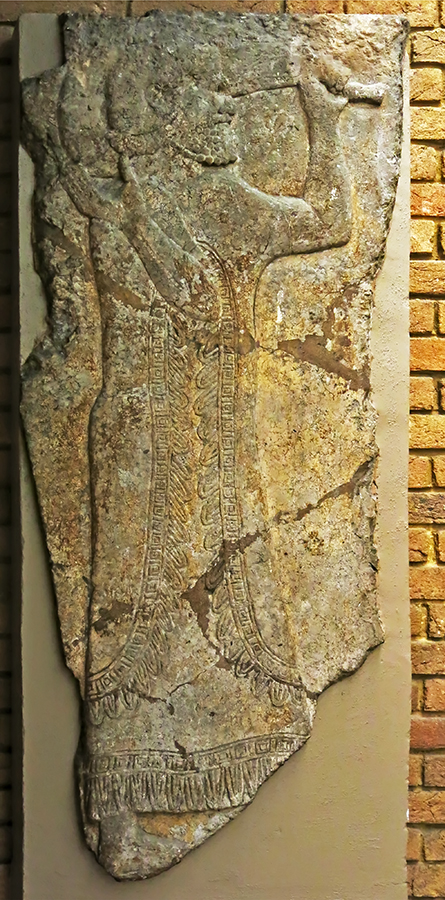
Reign of Sargon II, 722 BC – 705 BC
Attendant
Gypsum wall panel in relief: showing a man carrying a wine-skin, in a long fringed cloak, a foreigner. He may come from Syria or Turkey on the western fringes of the Assyrian Empire. This figure has frequently been commented upon, owing to the clumsy effect of the right arm, which is exaggerated by the conventional drawing of the left shoulder in advance in an impossible position.
Height 129 cm
Comes from the same room as slab 1847,0702.20 (BM. 118835).
Catalog: Gypsum alabaster, Palace of Sargon II, Khorsabad, Iraq, BM/Big number 118836
Photo: Don Hitchcock 2015
Source: Original, British Museum
Text: Card with the display at the British Museum, http://www.britishmuseum.org/, © Trustees of the British Museum, CC BY-NC-SA 4.0
King Sennacherib
Portrait of King Sennacherib
Reign 704 BC - 681 BC
This is a cast of a rock relief of Sennacherib from the foot of Cudi Dağı, near Cizre. The cast is exhibited in Landshut, Germany.
Photo: Timo Roller
Permission: Creative Commons Attribution 3.0 Unported license
The Siege of ...-alammu by the army of Sennacherib (704 BC - 681 BC)
(The full name is lost, only the last part survives, -alammu. The city probably lay in modern day Turkey or Iran. )
Wall relief of gypsum alabaster from the South West Palace (Nineveh), circa 700 BC - 692 BC .
This shows soldiers attacking a high fort with bows and arrows, but without siege engines.
This image shows the large standing shield used for such attacks, with a large handle, and wide enough to shelter a soldier and an archer from arrows.
The soldier held the standing shield upright and in place while carrying what may be a dagger or short sword, while the archer aimed and shot his arrows from its protection. Other archers without a shield bearer used local cover, from a more protected position where possible.
BM description: Stone wall panel relief in four parts: the system of fortifications of the city, ..._alammu, built on an artificial (?) mound, comprising independent towers surrounding the mound, and an acropolis with a double wall.
A strong gateway guarded the main approach up the incline. Archers shoot at the gate whilst spearmen work their way towards the walls. The Assyrians have already captured the towers, but have not yet completed the assault on the acropolis, and the outer wall is still being defended, though some of the garrison appear to be surrendering.
The towers are of two forms, one simple, the other stepped in such a way that an upper 'storey' is entered from the roof of a projecting extension of the lower room. The wall panel is inscribed. The dress of the inhabitants indicates that town was located in Turkey or Iran.
Reign of Sennacherib, 700 BC - 692 BC. Room XIV, the South-West Palace at Nineveh, Mesopotamia, modern-day Iraq.
Height 246 cm, length 583 cm
Catalog: Gypsum alabaster, BM/Big number 124785
Photo: Don Hitchcock 2015
Source: Original, British Museum
Text: Card with the display at the British Museum, http://www.britishmuseum.org/, © Trustees of the British Museum, CC BY-NC-SA 4.0
Siege of ...-alammu by the army of Sennacherib (704 BC - 681 BC)
The standing shield, highlighted here in a red oval, was far more flexible in use than single archers, who had to use whatever cover was available.
The two men behind a standing shield could choose the best place to either stand or kneel and shoot, depending on the height of the shield, even if this was right out in the open, but close to the enemy.
In this case, the shields appear to be made of wickerwork.
Photo and text: Don Hitchcock 2015
Source: Original, British Museum
This image shows an Assyrian soldier at left with a full size standing shield, a soldier with the smaller, more ubiquitous circular shield, and an archer on the right.
The standing shield was designed to rest on the ground, with the archer having much more protection than from a handheld small round shield, yet from a very mobile and relatively light device.
The standing shield was a two person device, one to hold the shield upright, and move it as necessary, and the other, an archer, to use it as protection while shooting arrows.
( This particular design (there are others) combines stiffness, strength and light weight by its curved but thin construction, perhaps achieved by the steaming of a suitable plank of wood. - Don )
Photo: Braun & Schneider (circa 1861 - 1880)
Permission: Public Domain
Proximal Source: Wikimedia Commons
Water Basin
Reign of Sennacherib, 704 BC - 681 BC
This water basin, originally cut from a single basalt block, was completely shattered when discovered. The waterbasin was located in one of the courtyards of the Temple of Ashur. The original fragments were utilised to reconstruct the waterbasin seen here.
On the corners and in the centre of each side are depictions of watergods holding overflowing waterjugs. Streams of water flow from the sky above, into the jug and downward to the earth below. Two priests wearing fish-skins hold small buckets to purify the central figure of the watergod. A cuneiform inscription, repeated several times, invokes the name of Sennacherib (704-681 BC). The interior of the basin is undecorated. Its location and decoration suggest that the waterbasin was used for cultic purification rites.
Height 117cm, length 3120 cm, breadth 3120 cm.
Catalog: Basalt, Ashur (Qal'at Sherqat), Quadrant i E 3 III, in the well of the east building of Sennacherib, accession number VA Ace 01835
Photo: Don Hitchcock 2015
Source and text: Pergamon Museum, Berlin, recherche.smb.museum
Relief Panels
Reign of Sennacherib, 704 BC - 681 BC
This representation found in the Southwest Palace of the Assyrian King Sennacherib (704 - 689 BC) shows armed soldiers marching to the left.
The Assyrian army, which was rigidly organised and extremely powerful consisted of four different units: chariotry, cavalry, foot-soldiers and pioneers.
Since the 8th century BC, non-Assyrian soldiers were recruited to reinforce the regular troops.
The bent tip decorating the two helmets to the right identifies these soldiers as mercenaries.
(left) height 179 cm, width 124 cm.
(right) height 190 cm, width 130 cm.
Catalog: (left) VA 00957, (right) VA 00958
Photo: Don Hitchcock 2015
Source and text: Nadia Cholidis, Pergamon Museum, Berlin, recherche.smb.museum
Relief Panels
Reign of Sennacherib, 704 BC - 681 BC
These orthostats, which were placed on the side walls of a ramp, show Assyrian officers and courtiers carrying a mobile throne. Only the decorated pole of the throne is preserved. The peculiar combination of throne and chariot is attested for the first time during the reign of Tiglath-Pileser III (745 - 727 BC). It represents a special development.
Upper image: height 174 cm, width 142 cm.
Lower image: height 154 cm, width 118 cm.
( The decorated pole is shown in the upper image, and consists of a curved object equipped with a carrying handle and decorated with a carved horse head - Don )
Catalog: upper image VA 00955, lower image VA 00956
Photo: Don Hitchcock 2015
Source and text: Nadia Cholidis, Pergamon Museum, Berlin, recherche.smb.museum
Reign of Sennacherib, 704 BC - 681 BC
Nineveh, wall panel, relief.
This monumental relief depicts several shield bearers and a group of musicians carrying diverse instruments. The rectangular drum with a string, which can still be found in modern Iraq and North Africa, is attested here for the first time. The same applies to the cymbals, which are made of two sound boxes with handles. At the end of the procession walks a richly decorated woman, who might have been carrying a round drum.
The cut of these orthostats suggests that the representation was situated on the side walls of a descending ramp, which obviously leads from the royal palace to the Ishtar Temple. The Assyrian king thus was able to approach the temple of the goddess directly on cultic occasions.
Catalog: Gypsum alabaster
Photo: Don Hitchcock 2015
Source and text: Pergamon Museum, Berlin, recherche.smb.museum
Reign of Sennacherib, 704 BC - 681 BC
Nineveh, wall panel, relief.
These panels are apparently not related to the rest of the relief panels in this room, which depict the siege of Lachish.
Review of prisoners.
Assyrian, circa 700 - 692 BC
Room XXXII, panels 7-8
The prisoners, who have probably been captured during one of Sennacherib's campaigns in Iran or eastern Turkey, are brought into the presence of the king, who will originally have been shown on a panel further to the right.
Gypsum wall panel relief showing a scene in three rows. In the upper row, some of the figures are male prisoners either with bound hands or with their hands up ready for being bound. Female prisoners carry small sacks, possibly containing severed heads. Ahead of them, soldiers with shorter tunics carry heads to the right, and these are dumped in a heap and recorded by two scribes. Behind the scribes are soldiers with large conical shields, as well as spears and short swords.
The middle row shows a column of deportees moving towards the right. As in the upper register, the males are either bound at the wrists or have their hands up ready to be bound, and two females carry sacks. One of the females has a child of three or four years with her. Two soldiers accompany the file of prisoners, and they meet soldiers with spears, wearing traditional conical helmets, and carrying spears, conical shields, and wearing short swords.
The lower row depicts helmeted soldiers carrying spears and short swords in scabbards, leading richly caparisoned horses, moving towards the left through a mountain landscape. Some small fragments from the bottom of the relief are missing.
BM 124902 (left): height 157 cm, width 221 cm, thickness 15 cm
BM 124903 (right): height 173 cm, width 175 cm, thickness 15 cm
Layard's description of the scenes depicted in Room XXXII (EE):
'The bas-reliefs on the walls of the two chambers XXXI and XXXII recorded the same campaign against a nation dwelling amidst a wooded and mountainous country, and in strongly fortified cities, which the Assyrians took by assault, using battering rams to make breaches in the walls, and scaling ladders to mount to the assault. The besieged defended themselves with arrows and stones, but their strongholds were captured, and a vast amount of spoil and captives fell into the hands of the conquerors. The men had short, bushy hair and beards, and wore an inner garment reaching to the knee, an outer cloak of skins or fur, and gaiters laced in front. The robes of the women were short; their hair hung low down their backs, and was then gathered up into one large curl'. ( Layard (1853) p. 462 )
Catalog: Gypsum alabaster, 124902-3
Photo: Don Hitchcock 2015
Source: Original, British Museum
Text: Card with the display at the British Museum, http://www.britishmuseum.org/, © Trustees of the British Museum, CC BY-NC-SA 4.0
Reign of Sennacherib, 704 BC - 681 BC
Siege of Lachish
Nineveh, South West Palace, Room XXXVI, panels , bas-relief, circa 700 BC - 692 BC.
Gypsum wall panel relief showing an assault on Lachish, Panel 5.
Here, at the back, long-range artillery are slinging stones and shooting arrows.
In front, storm-troopers prepare for the assault, some soldiers carrying what appear to be stones.
The siege begins.
Height 178 cm, width 229 cm, thickness 15 cm.
Catalog: Gypsum alabaster, 124904 (?)
Photo: Don Hitchcock 2015
Source: Original, British Museum
Text: Card with the display at the British Museum, http://www.britishmuseum.org/, © Trustees of the British Museum, CC BY-NC-SA 4.0
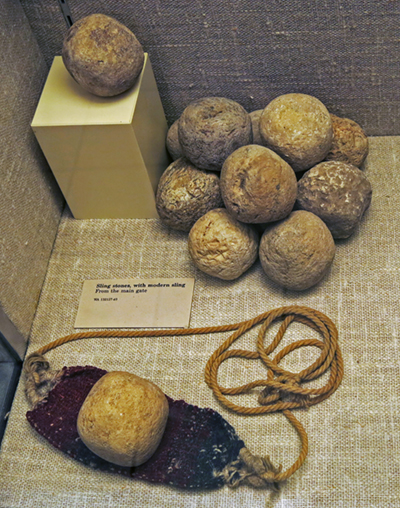
Reign of Sennacherib, 704 BC - 681 BC
Siege of Lachish
Sling stones, with modern sling, from the main gate.
Dimensions of typical sling stones:
132127: chert, height 64 mm, width 62 mm, weight 388 gm.
132129: chert, height 58 mm, width 62 mm, weight 360 gm.
132131: chert, height 62 mm, width 64 mm, weight 337 gm.
Catalog: 132127-40
( Note that the online catalog does not recognise the prefix WA as on the museum card, the number only must be input - Don )
Photo: Don Hitchcock 2015
Source: Original, British Museum
Text: Card with the display at the British Museum, http://www.britishmuseum.org/, © Trustees of the British Museum, CC BY-NC-SA 4.0
Reign of Sennacherib, 704 BC - 681 BC
Siege of Lachish
Nineveh, South West Palace, Room XXXVI, panels , bas-relief, circa 700 BC - 692 BC.
Gypsum wall panel relief showing an assault on Lachish, Panel 6.
These panels, with others to the right, show an important incident during Sennacherib's campaign of 701 BC, the capture of Lachish in the kingdom of Judah.
In front, storm-troopers prepare for the assault.
The siege begins.
Height 178 cm, width 229 cm, thickness 15 cm.
Catalog: Gypsum alabaster, 124905
Photo: Don Hitchcock 2015
Source: Original, British Museum
Text: Card with the display at the British Museum, http://www.britishmuseum.org/, © Trustees of the British Museum, CC BY-NC-SA 4.0
Reign of Sennacherib, 704 BC - 681 BC
Siege of Lachish
Nineveh, South West Palace, Room XXXVI, panel 6, bas-relief, circa 700 BC - 692 BC.
Gypsum wall panel relief showing an assault on Lachish. Siege engines lead the way up artificial ramps, Inside, men with ladles pour water to prevent them being set alight by torches thrown from walls. A procession of men and women stream out of town, ready for exile.
Some captives have been impaled on stakes outside of the city walls, shown with hanging heads, probably already dead.
( Note that the artificial ramps have been shown at impossibly steep angles to create an effect. Ramps at that angle would have been quite insurmountable to climb. See the actual ramp in the image immediately below - Don )
Height 168 cm, width 191 cm, thickness 15 cm.
Catalog: Gypsum alabaster, 124906
Photo: Don Hitchcock 2015
Source: Original, British Museum
Text: Card with the display at the British Museum, http://www.britishmuseum.org/, © Trustees of the British Museum, CC BY-NC-SA 4.0
Reign of Sennacherib, 704 BC - 681 BC
Siege of Lachish
Assyrian siege ramp.
Due to the steepness of the northern side of Lachish the Assyrian Army attacked from the south, where the Jewish defenders situated themselves on the walls. The Jewish defenders threw stones and shot arrows at the advancing Assyrians; the Assyrians started shooting arrows and stones themselves, creating a skirmish between the two armies.
Meanwhile, Assyrian military engineers built a ramp to the east of the main gate where Assyrian and Jewish troops began engaging in close combat. The Assyrians meanwhile brought siege engines to the ramp and broke the wall; the Jewish defenders could not hold the Assyrian army and retreated, with some attempting to escape from the other side of the hill.
Yosef Garfinkel of the Institute of Archaeology, Hebrew University of Jerusalem, Israel, identifies this siege ramp at Lachish as the only such known from the ancient Near East and the oldest in the world.
Photo: Wilson44691
Permission: Creative Commons Attribution-Share Alike 3.0 Unported license.
Proximal source and text: Wikipedia
Reign of Sennacherib, 704 BC - 681 BC
Siege of Lachish
Nineveh, South West Palace, Room XXXVI, wall panels 9-10, bas-relief.
Gypsum wall panel relief showing, on the left, the artificial ramps and a siege engine, used to batter down gates and destroy walls.
At the centre and to the right, a procession of prisoners move through a rocky landscape with vines, fig trees and olives in background.
The relief also shows booty from Lachish and from the governor's palace, including a bundle of scimitars, round shields, a chariot, a throne and incense burners.
Below, Judaean prisoners move in families, taking goods and animals into exile.
Officials regarded as responsible for the rebellion are flayed alive.
Height 257 cm, width 102 cm, thickness 15 cm
Catalog: Gypsum alabaster, 124907, 124908, 124909
Photo: Don Hitchcock 2015
Source: Original, British Museum
Text: Card with the display at the British Museum, http://www.britishmuseum.org/, © Trustees of the British Museum, CC BY-NC-SA 4.0
Reign of Sennacherib, 704 BC - 681 BC
Siege of Lachish
Nineveh, South West Palace, Room XXXVI, panels 11-13, bas-relief, circa 700 BC - 692 BC.
Sennacherib, on a magnificent throne, watches as prisoners are brought before him and sometimes executed.
There is a tent behind him, his chariot is in the foreground, and his bodyguard are stationed around.
The king's face has been deliberately disfigured, perhaps by an enemy soldier at the fall of Nineveh in 612 BC.
124910: Height 257 cm, width 135 cm, thickness 15 cm.
124911: Height 251 cm, width 178 cm, thickness 15 cm.
124912: Height 236 cm, width 135 cm, thickness 15 cm.
Catalog: Gypsum alabaster, WA 124910, 124911, 124912
Photo: Don Hitchcock 2015
Source: Original, British Museum
Text: Card with the display at the British Museum, http://www.britishmuseum.org/, © Trustees of the British Museum, CC BY-NC-SA 4.0
Reign of Sennacherib, 704 BC - 681 BC
Siege of Lachish
Nineveh, South West Palace, Room XXXVI, wall panels 14 - 16, bas-relief.
Gypsum wall panel relief: part of a sequence, in this case showing horses in Sennacherib's bodyguard at Lachish, with a camp including tents, servants and standard, circa 700 - 692 BC.
124913: Height 264 cm, width 112 cm, thickness 15 cm.
124914: Height 234 cm, width 117 cm, thickness 15 cm.
124915: Height 173 cm, width 61 cm, thickness 15 cm.
This gypsum panel is part of a series which decorated the walls of a room in the palace of King Sennacherib (reigned 704-681 BC) at his Assyrian capital of Nineveh. The story continues from the previous panel of the relief (no. 13).
These three surviving slabs complete the royal entourage. The right-hand end shows more cavalry and chariots waiting behind the king. It also shows an aerial view of the Assyrian camp with its oval wall and defensive towers at intervals shown flattened out. Other Assyrian camps shown on reliefs were sometimes round or rectangular. The camp seems to have been methodically planned with a road running through the middle.
There are two pavilions, like the one behind the king, and five open tents in which various activities such as servants working in the tents can be seen, including the amusing scene of two men gossiping over a drink. The pair of chariots in one corner of the camp have a standard in each of them; these are the chariots of the gods, sometimes seen charging in battle. On this occasion two priests in tall hats are performing a ceremony; an incense burner stands higher than the priests, and a sacrificial leg of meat sits on an altar.
Catalog: Gypsum alabaster, 124913, 124914, 124915
Photo: Don Hitchcock 2015
Source: Original, British Museum
Text: Card with the display at the British Museum, http://www.britishmuseum.org/, © Trustees of the British Museum, CC BY-NC-SA 4.0
Reign of Sennacherib, 704 BC - 681 BC
Siege of Lachish
An imaginative reconstruction of the capture of Lachish by Alan Sorrell.
Painting: Alan Sorrell
Rephotography: Don Hitchcock 2015
Source: Poster, British Museum
Text: Card with the display at the British Museum, http://www.britishmuseum.org/, © Trustees of the British Museum, CC BY-NC-SA 4.0
Reign of Sennacherib, 704 BC - 681 BC
Assyrian Warriors
Nineveh, South West Palace, bas-relief.
Gypsum wall panel: showing three pairs of Assyrian warriors facing right, each archer protected by a siege-shield. The scene is set against a mountain-scale pattern, suggesting mountainous country. The feet of the figures in the upper register are also present.
These archers, the front one of whom is beardless, possibly a eunuch, are each accompanied by a soldier whose duty it is to hold the tall shield in position and guard against any enemies who come too close.
( These are the full size shields, in this case apparently made of wickerwork - Don )
Circa 700 BC - 692 BC
Height 66 cm, width 104 cm, thickness 15 cm.
Catalog: Gypsum alabaster, 124776
Photo: Don Hitchcock 2015
Source: Original, British Museum
Text: Card with the display at the British Museum, http://www.britishmuseum.org/, © Trustees of the British Museum, CC BY-NC-SA 4.0
Reign of Sennacherib, 704 BC - 681 BC
Assyrian archers and slingers
Nineveh, South West Palace, bas-relief.
Gypsum wall panel showing two pairs of Assyrian archers and slingers at a siege, in mountainous country. Above and on the left are parts of fir trees. The arms of a third pair of slingers can be seen on the right.
Circa 700 BC - 692 BC
Length 94 cm, width 102 cm, depth 15 cm.
Catalog: Gypsum alabaster, 124775
Photo: Don Hitchcock 2015
Source: Original, British Museum
Text: Card with the display at the British Museum, http://www.britishmuseum.org/, © Trustees of the British Museum, CC BY-NC-SA 4.0
Reign of Sennacherib, 704 BC - 681 BC
Assyrian cavalry
Nineveh, South West Palace, bas-relief.
Gypsum wall panel relief depicting Assyrian cavalry leading their horses through mountainous country, armed with lances and bows, and wearing the same corselet as the infantry.
Circa 700 BC - 692 BC.
Height 64 cm, width 99 cm, depth 15 cm.
Catalog: Gypsum alabaster, 124777
Photo: Don Hitchcock 2015
Source: Original, British Museum
Text: Card with the display at the British Museum, http://www.britishmuseum.org/, © Trustees of the British Museum, CC BY-NC-SA 4.0
Reign of Sennacherib, 704 BC - 681 BC
Assyrian soldier and three lyre-players
Nineveh, South West Palace, bas-relief.
Circa 700 BC - 692 BC.
Gypsum wall panel relief showing an Assyrian soldier and three lyre-players, possibly Judaean prisoners, advancing towards the right in wooded, mountainous country.
The dress of the lyre players indicates that they came from somewhere to the west of Assyria, possibly Phoenicia. The scene recalls the Biblical lament (Psalm 137) referring to a later period, 'they that carried us away captive required of us a song'.
Layard's description of the scenes depicted in Room XLVII (JJ):
'The bas-relief still preserved the king in his chariot receiving the captives; musicians playing on harps before him; mountains and forests, and a castle whose name has not been identified or deciphered'.
Height 99 cm, width 102 cm.
Catalog: Gypsum alabaster, 124947
Photo: Don Hitchcock 2015
Source: Original, British Museum
Text: Card with the display at the British Museum, http://www.britishmuseum.org/, © Trustees of the British Museum, CC BY-NC-SA 4.0
Reign of Sennacherib, 704 BC - 681 BC
Battle Scene
Nineveh, South West Palace, bas-relief.
Circa 700 BC - 692 BC.
Gypsum wall panel relief: showing a battle scene. Assyrian cavalry are fighting archers in a wooded landscape. Above, deportees are led away towards the left.
Layard's descriptions of the scenes depicted in Court VI (I):
'In this series of bas-reliefs the history of an Assyrian conquest was more fully portrayed than in any other yet discovered, from the going out of the monarch to battle, to his triumphal return after a complete victory... The king, accompanied by his chariots and horsemen, and leaving his capital in the Assyrian plains, passed through a mountainous and wooded district. He does not appear to have been delayed by the siege of many towns or castles, but to have carried the war at once into the high country. His troops, cavalry and infantry, are represented in close combat with their enemies, pursuing them over hills and through valleys, beside streams, and in the midst of vineyards.
The Assyrian horsemen are armed with the spear and the bow, using both weapons whilst at full speed: their opponents seem to be all archers. The vanquished turn to ask for quarter; or, wounded, fall under the feet of the advancing horses, raising their hands imploringly to ward off the impending deathblow. The triumph follows. The king standing in his chariot, beneath the royal parasol, followed by long lines of dismounted warriors leading richly caparisoned horses, and by foot soldiers variously armed and accoutred, is receiving the captives and spoil taken from the conquered people.
First approach the victorious warriors, throwing the heads of the slain into heaps before the registering officers. They are followed by others leading, and urging onwards with staves, the prisoners - men chained together, or bound singly in fetters, and women, some on foot, carrying their children on their shoulders, and leading them by the hand, others riding on mules. The procession is finished by asses, mules, and flocks of sheep.
As on the bas-reliefs uncovered by Mr Ross, there is unfortunately no inscription by which the name of the conquered people can be determined. ... The mountains, valleys, and streams, the vines and dwarf oaks, probably indicate a region north of Assyria, in Armenia, Media, or Kurdistan, countries we know to have been invaded by the royal builder of the palace. The dress of the men consists of a short tunic; that of the women, of a shirt falling to the ankles, and cut low in front of the neck'. (Layard, 1853, pp. 70-1)
'The remaining slabs were covered from top to bottom with rows of warriors, spearmen, and archers, in their respective costumes, and in military array. Each slab must have contained several hundred minute figures, sculptured with great care and delicacy'. (Layard, 1849, II, pp. 134-5)
Height 122 cm, width 107 cm.
Catalog: Gypsum alabaster, 124952
Photo: Don Hitchcock 2015
Source: Original, British Museum
Text: Card with the display at the British Museum, http://www.britishmuseum.org/, © Trustees of the British Museum, CC BY-NC-SA 4.0
Reign of Sennacherib, 704 BC - 681 BC
Horses and grooms leaving Sennacherib's palace.
Nineveh, South-West Palace, Room L1 north, probably panels 37-38.
One of three adjoining slabs, circa 700 BC - 692 BC.
Width 152 - 158 cm (slab c), height 160 cm.
Forms part of set 1851.0902.14.a-c.
The arrangement of these slabs has been elucidated in Gadd, 'Stones of Assyria', pp. 168-70.
Catalog: Gypsum alabaster, 124795,c
Photo: Don Hitchcock 2015
Source: Original, British Museum
Text: Card with the display at the British Museum, http://www.britishmuseum.org/, © Trustees of the British Museum, CC BY-NC-SA 4.0
Reign of Sennacherib, 704 BC - 681 BC
Horses and grooms leaving Sennacherib's palace.
Nineveh, South-West Palace, room L1 north, panels 31-32.
Catalog: Gypsum alabaster, 124796
Photo: Don Hitchcock 2015
Source: Original, British Museum
Text: Card with the display at the British Museum, http://www.britishmuseum.org/, © Trustees of the British Museum, CC BY-NC-SA 4.0

Reign of Sennacherib, 704 BC - 681 BC
Prism of Sennacherib
The Taylor Prism, Nineveh.
Baked clay prism, octagonal, annals of Sennacherib, dated in the month of Abu in the eponymy of Ilu-issiya, 90 + 96 + 95 + 91 + 91 + 93 + 96 + 88 lines of inscription, Neo-Assyrian.
691 BC.
Diameter 14 cm, height 38 cm.
Sennacherib's Annals are the annals of the Assyrian king Sennacherib. They are found inscribed on a number of artefacts, and the final versions were found in three clay prisms inscribed with the same text: the Taylor Prism is in the British Museum, the Oriental Institute Prism in the Oriental Institute of Chicago, and the Jerusalem Prism is in the Israel Museum in Jerusalem.
The Taylor Prism is one of the earliest cuneiform artefacts analysed in modern Assyriology, having been found a few years before the modern deciphering of cuneiform.
The annals themselves are notable for describing Sennacherib's siege of Jerusalem during the reign of king Hezekiah. This event is recorded in several books contained in the Bible including Isaiah chapters 36 and 37; 2 Kings 18:17; 2 Chronicles 32:9. The invasion is mentioned by Herodotus, who does not refer to Judea and says the invasion ended at Pelusium on the edge of the Nile Delta.
The prisms contain six paragraphs of cuneiform written in Akkadian. They are hexagonal in shape, made of red baked clay, and stand 38.0 cm high by 14.0 cm wide. They were created during the reign of Sennacherib in 689 BC (Chicago) or 691 BC (London, Jerusalem).
The Taylor prism is thought to have been found by Colonel Robert Taylor (1790–1852) in 1830 at Nineveh, which was the ancient capital of the Assyrian Empire under Sennacherib, before its initial excavation by Botta and Layard more than a decade later. Although the prism remained in Iraq until 1846, in 1835 a paper squeeze was made by the 25-year-old Henry Rawlinson, and a plaster cast was taken by Pierre-Victorien Lottin in circa 1845. The original was later thought to have been lost, until it was purchased from Colonel Taylor's widow in 1855 by the British Museum. (Colonel Taylor may have been the father of John George Taylor, who, himself, became a noted Assyrian explorer and archaeologist.)
Another version of this text is found on what is known as the Sennacherib Prism, now in the Oriental Institute. It was purchased by James Henry Breasted from a Baghdad antiques dealer in 1919 for the Oriental Institute. The Jerusalem prism was acquired by the Israel Museum at a Sotheby's auction in 1970. It was only published in 1990.
The three known complete examples of this inscription are nearly identical, with only minor variants, although the dates on the prisms show that they were written sixteen months apart (the Taylor and Jerusalem Prisms in 691 BC and the Oriental Institute prism in 689 BC). There are also at least eight other fragmentary prisms preserving parts of this text, all in the British Museum, and most of them containing just a few lines.
The Chicago text was translated by Daniel David Luckenbill and the Akkadian text, along with a translation into English, is available in his book The Annals of Sennacherib (University of Chicago Press, 1924).
Translation:
Column I
Sennacherib, the great king, the mighty king, king of the universe, king of Assyria, king of the four quarters (of the earth); the wise ruler (lit. shepherd, "pastor"), favorite of the great gods, guardian of the right, lover of justice; who lends support, who comes to the aid of the needy, who turns (his thoughts) to pious deeds; perfect hero, mighty man; first among all princes, the powerful one who consumes the insubmissive, who strikes the wicked with the thunderbolt; the god Assur, the great mountain, an unrivaled kingship has entrusted to me, and above all those who dwell in palaces, has made powerful my weapons; from the upper sea of the setting sun to the lower sea of the rising sun, all humankind (the black-headed race) he has brought in submission at my feet and mighty kings feared my warfare -- leaving their abodes and flying alone, like the sudinnu, the bird of the cave (? cliffs), to (some) inaccessible place.
In my first campaign I accomplished the defeat of Merodach-baladan, king of Babylonia, together with the army of Elam, his ally, in the plain of Kish. In the midst of that battle he forsook his camp, and made his escape alone; (so) he saved his life. The chariots, horses, wagons, mules, which he left behind at the onset of battle, my hands seized. Into his palace, which is in Babylon, joyfully I entered. I opened his treasure-house:-gold, silver, vessels of gold and silver, precious stones of every kind (name) goods and property without limit (number), heavy tribute, his harem, (his) courtiers and officials, singers, male and female, all of his artisans, as many as there were, the servants of his palace, I brought out, I counted as spoil. In the might of Assur my lord, 75 of his strong walled cities, of Chaldea, and 420 small cities of their environs (within their borders), I surrounded, I conquered, their spoil I carried off. The Arabs, Aramaeans, and Chaldeans, who were in Erech, Nippur, Kish, Harsagkalamma, Kutha and Sippar, together with the citizens, the rebels (lit. sinners), I brought out, as booty I counted. On my return (march) the Tu'muna Rihihu, Yadakku, Ubudu Kibre, Malahu, Gurumu, Ubulu, Damunu, Gambulu Hindaru, Ru'ua, Bukudu, Hamranu, Hagaranu, Nabatu, Li'tau, Aramaeans (who were) not submissive, all of them I conquered. 208,000 people, great and small, male and female, horses, mules, asses, camels, cattle and sheep, without number, a heavy booty, I carried off to Assyria. In the course of my campaign, I received from Nabu-belshumate, governor of the city of Hararate, gold, silver, great musukkani-trees, asses, camels, cattle and sheep, as his onerous contribution. The warriors of Hirimme, wicked enemies, I cut down with the sword. Not one escaped. Their corpses I hung on stakes, surrounding the city (with them). That district (province) I reorganized: One ox, 10 lambs, 10 homers of wine, 20 homers of dates, its choicest, (as gifts) for the gods of Assyria, my lords, I established for all time.
In my second campaign, Assur my lord, encouraged me, and against the land of the Kassites and the land of the Yasubigallai, who from of old had not been submissive to the kings, my fathers, I marched. In the midst of the high mountains I rode on horseback where the terrain was difficult, and had my chariot drawn up with ropes: where it became too steep, I clambered up on foot like the wild-ox. The cities of Bit-Kilamzah, Hardishpi and Bit-Kubatti, their strong, walled cities, I besieged, I captured. People, horses, mules, asses, cattle and sheep, I brought out from their midst and counted as booty. And their small cities, which were numberless, I destroyed, I devastated, I turned into ruins. The houses of the steppe, (namely) the tents, wherein they dwelt, I set on fire and turned them into (a mass of) flames. I turned round, and made that Bit-Kilamzah into a fortress, I made its walls stronger than they had ever been before,
Column II
and settled therein people of the lands my hands had conquered. The people of the land of the Kassites and the land of the Yasubigallai, who had fled before my arms, I brought down out of the mountains and settled them in Hardishpi and Bit-Kubatti. Into the hand(s) of my official, the governor of Arrapha, I placed (lit. counted) them. I had a stela made, and the might of my conquering hand which I had established upon them, I had inscribed thereon. In the midst of the city I set it up. The front of my yoke I turned (that is, I turned about) and took the road to the land of the Elippi. Before me (my approach) Ispabara, their king, forsook his strong cities, his treasure-houses (cities), and fled to distant (parts). Over the whole of his wide land I swept like a hurricane. The cities Marubishti and Akkuddu, his royal residence-cities, together with 34 small cities of their environs, I besieged, I captured, I destroyed, I devastated, I burned with fire. The people, great and small, male and female, horses, mules, asses, camels, cattle and sheep, without number, I carried off. I brought him to naught, I diminished his land. Sisirtu and Kummahlum, strong cities, together with the small cities of their environs, the district (province) of Bit-Barrfi in its totality, I cut off from his land and added it to the territory (lit. border) of Assyria. Elenzash I turned into the royal city and stronghold of that district. I changed its former name, calling its (new) name Kar-Sennacherib. Peoples of the lands my hands had conquered I settled therein. To my official, the governor of Harhar, I handed it over (counted it). Thus I extended my land. On my return, I received the heavy tribute of the distant Medes, whose name no one among the kings, my fathers, had (ever) heard. To the yoke of my rule I made them submit.
In my third campaign I went against the Hittite-land. Lule, king of Sidon, -the terrifying splendor (lit. terrors of splendors) of my sovereignty overcame him and far off into the midst of the sea he fled. (There) he died. Great Sidon, Little Sidon, Bit-Zitti, Zaribtu, Mahalliba, Ushu, Akzib, Akko, his strong, walled cities, where there were supplies (lit. fodder and drinking places), for his garrisons,-the terrors of the weapon of Assur, my lord, overpowered them and they bowed in submission at my feet. Tuba'lu I seated on the royal throne over them, and tribute, gifts) for my majesty, I imposed upon him for all time, without ceasing. From Menachem, the Shamsimurunite, Tuba'lu, the Sidonite, Abdi-liti, the Arvadite, Uru-milki, the Gublite, Mitinti, the Ashdodite, Budu-ilu, the Beth-Ammonite, Kammusu-nadbi, the Moabite, Malik-rammu, the Edomite, kings of Amurru, all of them, numerous presents, as their heavy tribute, they brought before me for the fourth time, and kissed my feet. But Sidka, king of Ashkelon, who had not submitted to my yoke,-the gods of his father-house, himself, his wife, his sons, his daughters, his brothers, the seed of his father-house, I tore away and brought to Assyria. Sharru-lu-dari, son of Rukibti, their former king, I set over the people of Ashkelon and I imposed upon him the payment of tribute (in the form of) presents to my majesty. He accepted (lit. bore) my yoke. In the course of my campaign, Beth-Dagon, Joppa, Banaibarka, Asuru, cities of Sidka, who had not speedily bowed in submission at my feet, I besieged, I conquered, I carried off their spoil. The officials,` nobles and people of Ekron, who had thrown Padi, their king, bound by (lit. lord of) oath and curse of Assyria, into fetters of iron and had given him over to Hezekiah, the Jew,-he kept him in confinement like an enemy, they (lit. their heart) became afraid, and called upon the Egyptian kings, the bowmen, chariots and horses of the king of Meluhha (Ethiopia), a countless host, and these came to their aid. In the neighborhood of Eltekeh, their ranks being drawn up before me,
Column III
they offered battle. (Trusting) in the aid of Assur, my lord, I fought with them and brought about their defeat. The Egyptian charioteers and princes, together with the charioteers of the Ethiopian king, my hands took alive in the midst of the battle. Eltekeh (and) Timnah I besieged, I captured and took away their spoil. I drew near to Ekron and slew the governors and nobles who had committed sin (that is, rebelled), and hung their bodies on stakes around the city. The citizens who sinned and treated (Assyria) lightly, I counted as spoil. The rest of them, who were not guilty (carriers) of sin and contempt, for whom there was no punishment, I spoke their pardon. Padi, their king, I brought out of Jerusalem, set him on the royal throne over them and imposed upon him my kingly tribute. As for Hezekiah, the Jew, who did not submit to my yoke, 46 of his strong, walled cities, as well as the small cities in their neighborhood, which were without number,-by levelling with battering-rams (?) and by bringing up siege-engines (?), by attacking and storming on foot, by mines, tunnels and breaches (?), I besieged and took (those cities). 200,150 people, great and small, male and female, horses, mules, asses, camels, cattle and sheep, without number, I brought away from them and counted as spoil. Himself, like a caged bird I shut up in Jerusalem his royal city. Earthworks I threw up against him, the one coming out of the city-gate, I turned back to his misery. The cities of his, which I had despoiled, I cut off from his land and to Mitinti, king of Ashdod, Padi, king of Ekron, and Silli-bel king of Gaza, I gave. And (thus) I diminished his land. I added to the former tribute, and laid upon him the giving (up) of their land, (as well as) imposts-gifts for my majesty. As for Hezekiah, the terrifying splendor of my majesty overcame him, and the Urbi (Arabs) and his mercenary (?) troops which he had brought in to strengthen Jerusalem, his royal city, deserted him (lit. took leave). In addition to the 30 talents of gold and 800 talents of silver, (there were) gems, antimony, jewels (?), large sandu-stones, couches of ivory, house-chairs of ivory, elephant hide, ivory (lit. elephant's "teeth") ebony (?), boxwood (?), all kinds of valuable (heavy) treasures, as well as his daughters, his harem, his male and female musicians, (which) he had (them) bring after me to Nineveh, my royal city. To pay tribute and to accept (lit. do) servitude, he dispatched his messengers.
In my fourth campaign Assur, my lord, gave me courage, and I mustered my numerous armies and gave the command to proceed against Bit-Yakin. In the course of my campaign I accomplished the overthrow of Shuzubi, the Chaldean, -who sat in the midst of the swamps, - at Bitutu. That one,-the terror (lit. ague, chills) of my battle fell upon him, and broke his courage (lit. tore his heart); like a criminal (?) he fled alone, and his place was seen no more. The front of my yoke I turned and to Bit-Yakin I took the way. That (same) Merodach-baladan, whose defeat I had brought about in the course of my first campaign, and whose forces I had shattered, -the roar of my mighty arms and the onset of my terrible battle he feared and he gathered together the gods of his whole land in their shrines, and loaded them into ships and fled like a bird to Nagite-rakki, which is in the middle of the sea. His brothers, the seed of his father-house, whom he had left by the sea-shore, together with the rest of the people of his land, I brought out of Bit-Yakin, (from) the midst of the swamps and canebrakes, and counted as spoil. I turned about and ruined and devastated his cities: I made them like ruin-heaps. Upon his ally, the king of Elam, I poured out terror. On my return, I placed on his (Merodach-Baladan's) royal throne, Assur-nadin-shum, my oldest son, offspring of my loins (knees). I put him in charge of the wide land of Sumer and Akkad.
Translation excerpted from The Annals of Sennacherib, Daniel David Luckenbill, (Chicago: University of Chicago Press, 1924) pp. 23-35.
Proximal source for the translation: www.u.arizona.edu/~afutrell/w%20civ%2008/prism.html
Photo: Don Hitchcock 2015
Catalog: Baked clay, 103000
Source: Original, British Museum
Text: Card with the display at the British Museum, http://www.britishmuseum.org/, © Trustees of the British Museum, CC BY-NC-SA 4.0
Additional text: Wikipedia
King Esarhaddon
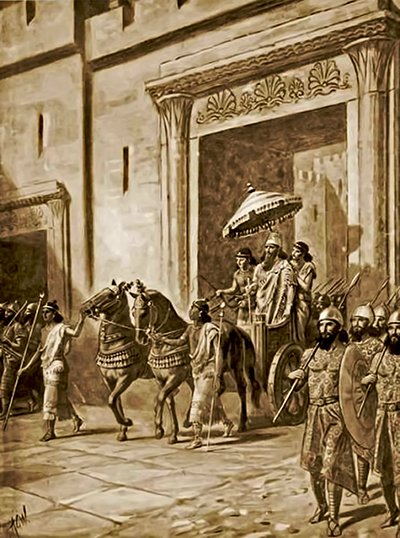
Recognition of King Esarhaddon/Asarhaddon of Assyria as King of Nineveh.
Reign 680 BC - 669 BC
Esarhaddon was the king of the Neo-Assyrian Empire from the death of his father Sennacherib in 680 BC to his own death in 669. The third king of the Sargonid dynasty, Esarhaddon is most famous for his conquest of Egypt in 671 BC, which made his empire the largest the world had ever seen, and for his reconstruction of Babylon, which had been destroyed by his father.
After a very difficult ascension to the throne, Esarhaddon was plagued by paranoia and mistrust for his officials, governors and male family members until the end of his reign. As a result of this paranoia, most of the palaces used by Esarhaddon were high-security fortifications located outside of the major population centres of the cities.
Also perhaps resulting from his mistrust for his male relatives, Esarhaddon's female relatives, such as his mother Naqiʾa and his daughter Serua-eterat, were allowed to wield considerably more influence and political power during his reign than women had been allowed in any previous period of Assyrian history.
Despite a relatively short and difficult reign, and being plagued by paranoia, depression and constant illness, Esarhaddon remains recognised as one of the greatest and most successful Assyrian kings. He quickly defeated his brothers in 680, completed ambitious and large-scale building projects in both Assyria and Babylonia, successfully campaigned in Media, the Arabian Peninsula, Anatolia, the Caucasus, and the Levant, defeated and conquered Lower Egypt, and ensured a peaceful transition of power to his two heirs Ashurbanipal and Shamash-shum-ukin after his death.
Photo: A.C. Weatherstone
Source: Hutchinson (1915)
Text: Adapted from Wikipedia
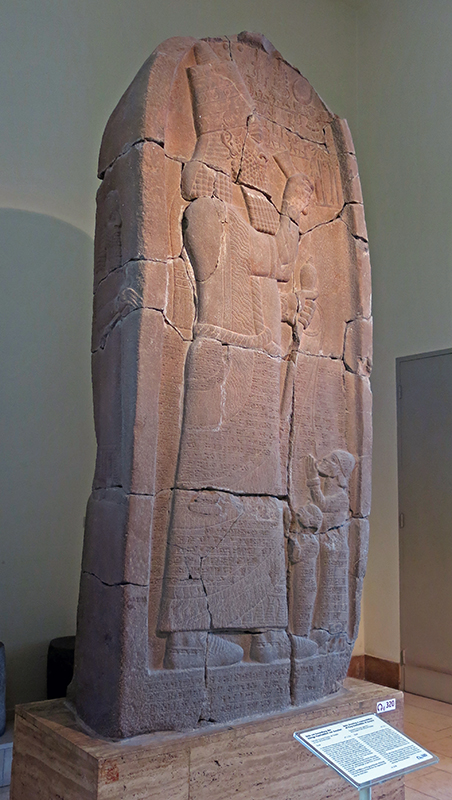
King Esarhaddon/Asarhaddon of Assyria
671 BC
Victory stele of King Asarhaddon of Assyria over Egypt showing a representation of King Esarhaddon of Assyria, excavated in the inner gate-room of the citadel of Sam`al/Zincirli (Turkey), (now Sendschirli).
During his campaigns against Egypt, Esarhaddon of Assyria conquered and subjected numerous Syrian city-states including Sam`al. The commemorative stele depicts a
super-human sized Esarhaddon with his right hand raised, worshipping his gods. The gods, in the upper right hand side, are shown in human form riding their associated
animal or symbolically. The king wears the beribboned, decorated royal crown. In his left hand he holds both the mace and two ropes.
The ropes end with rings through the lips of two prisoners. The kneeling smaller
figure appears to depict the Egyptian crown prince. The supplicating, standing figure, is likely that of a Syrian city-state ruller.
On the left side of the stele is the figure of king Shamash-shum-ukin, later king of Babylon, and on the right side, Assurbanipal, the heir apparent of Assyria. A cuneiform inscription covering the lower half of the front of the stele and completely covering the reverse reports the victorious campaigns of king Esarhaddon.
Inscription:
'Whoever removes this stela from its place, erases my written name, and writes his own name there, may his manhood feminize Ishtar, mistress of battle and combat, and make him sit down bound at the feet of his enemies."
This curse formula ends the inscription that covers the front and back of the stele. The monument was commissioned by the Assyrian king Asarhaddon, who guided the destiny of Assyria at the beginning of the 7th century BC. His foreign policy was marked by the conflict with Egypt for supremacy in Syria-Palestine. Only the 2nd campaign against Taharka in 671 BC brought the hoped-for decision in his favour.
This stele found in Sam'al, in southeastern Turkey, was to record this victory for posterity. After plundering the royal treasuries, Asarhaddon returned to Nineveh with most of his soldiers. While Taharka had managed to escape, his family and court were led into exile. It may be considered ironic that Asarhaddon did not survive a third campaign to the land along the Nile. In the long run this area could not be held anyway; already under Psammetich I Upper Egypt regained its independence in 655 BC.
The front of the stele shows the ruler in monumental size with royal insignia and two conquered adversaries kneeling down before him. At head height are various deity symbols and cult images in a reduced scale. On the narrower sides, Asarhaddon's sons are depicted as a novelty: Assurbanipal, the last important ruler of the Assyrians, and Shamash-shum-ukin, who was to take the throne of Babylon.
The subjugated enemies, bound hand and foot, are held by a rope leading to a ring drawn through the lower lip. Judging by the costume, it could be the Egyptian crown prince and a rebellious Syrian city prince. Baal of Tyre or Abdi-milkutti of Sidon, who had fallen from grace and been beheaded a few years earlier, could also be considered.
The good state of preservation of the stele, which was worked from a very hard stone, is to be owed to a catastrophic fire, which destroyed the princely seat probably still in the 7th century BC completely. Sealed by falling mud-brick walls, the image and inscription survived until they were found in 1888 by the German excavators Robert Koldewey and Felix von Luschan. [Nadja Cholidis]
Height 322 cm, width 135 cm, thickness 62 cm, weight circa 8000 kg.
Catalog: Basalt, Pergamon Museum, Level 1, Museum of the Ancient Near East, Room 3, VA 02708
Photo: Don Hitchcock 2015
Source and text: Pergamon Museum, Berlin, recherche.smb.museum
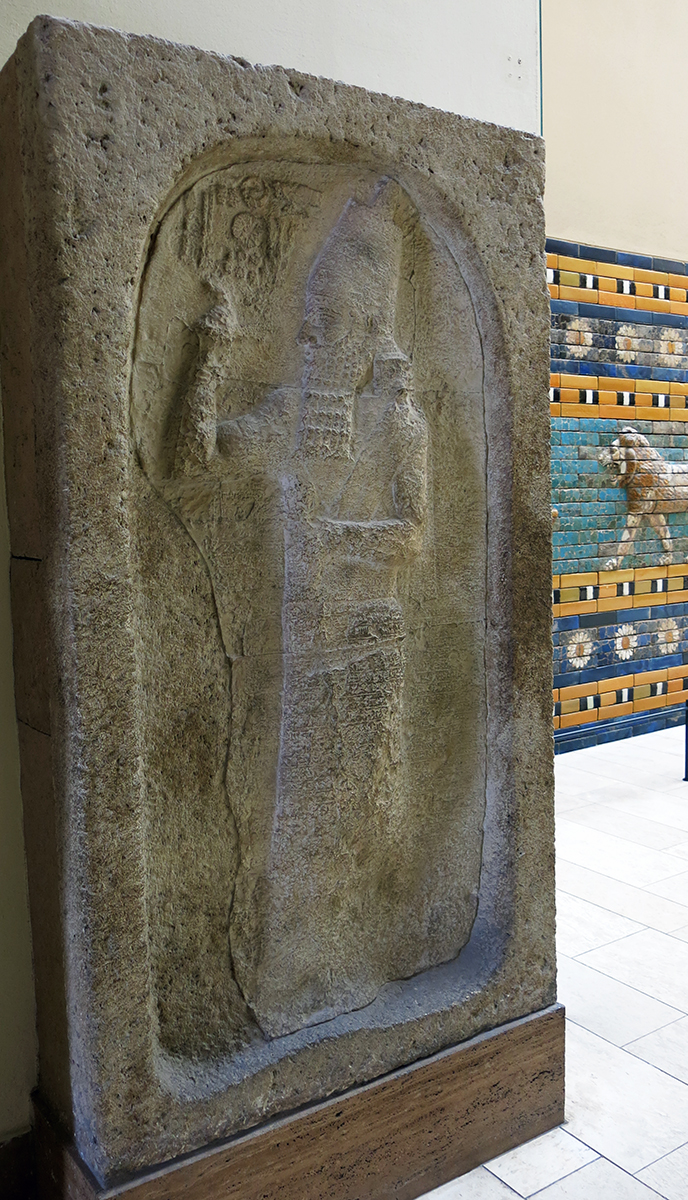
( I believe this to be a stele of King Esarhaddon/Asarhaddon of Assyria, circa 671 BC - Don )
Photo: Don Hitchcock 2015
Source: Pergamon Museum, Berlin
God Seal
Engraved cylinder seal.
Dated to Esarhaddon (680 BC – 669 BC)
Height 125 mm, diameter 32 mm, weight 300 gm.
Catalog: Lapis Lazuli, VA Bab 00647
Photo: Don Hitchcock 2015
Source and text: Pergamon Museum, Berlin, recherche.smb.museum
God Seal
Engraved cylinder seal.
Dated to Esarhaddon (680 BC – 669 BC)
This massive lapis lazuli cylinder was found together with beads, scarabs and precious ornaments mixed up with raw material, carefully hidden by the last owner, probably a Parthian manufacturer of beads, beneath the floor of his house.
The storm god Adad, standing on a stylized pedestal, is shown with bolts of lightning in his hands, a lion-dragon on a leash lying at his feet. His garment is decorated with the image of a ziggurat and three star-discs one below the other, which are depicting gold or silver pendants.
The initial Neo-Babylonian inscription, 'Seal of the god Adad', was supplemented at first by the addition 'Property of the god Marduk … of Esangila'.
The second Assyrian dedication 'To the god Marduk, great lord, his lord, Esarhaddon, king of the universe, king of Assyria, has given [the seal] for his life' suggests that the seal was at one point misappropriated from the treasury of Esangila and that it was Esarhaddon (680-669 B.C.) who reversed the sacrilege.
The technique - positive carved inscriptions, raised relief - substantiates that the cylinder was never used for sealing, although very few impressions of god's seals are known. [Nadja Cholidis]
Height 125 mm, diameter 32 mm, weight 300 gm.
Catalog: Lapis Lazuli, VA Bab 00647
Photo credit: Staatliche Museen zu Berlin, Vorderasiatisches Museum / Olaf M. Teßmer CC BY-NC-SA 4.0
Source and text: Pergamon Museum, Berlin, recherche.smb.museum

Stele protecting a royal land grant (kudurru) of Shamash-shuma-ukin.
Place of discovery within Mesopotamia unknown.
Black limestone.
Circumferential deity symbols, including an enfeoffment scene and inscription.
667 BC - 648 BC (reign of Shamash-shuma-ukin)
Shamash-shum-ukin was the son of the Neo-Assyrian king Esarhaddon and his appointed successor as king of Babylon, ruling Babylonia from 668 BC to his death in 648 BC.
Despite being the eldest living son of Esarhaddon at the time, Shamash-shum-ukin was designated as the heir to Babylon in 672 BC and in his stead his younger brother Ashurbanipal was designated as the heir to Assyria. Despite documents from Esarhaddon suggesting that the two brothers were intended to have equal power, Shamash-shum-ukin only acceded to the Babylonian throne months after Ashubanipal had become king and throughout his reign could only make decisions and issue orders if these were also approved and verified by Ashurbanipal.
Shamash-shum-ukin assimilated well into Babylonia, despite being ethnically and culturally Assyrian. His royal inscriptions are far more 'quintessentially Babylonian' than those of other Assyrian rulers of southern Mesopotamia, using Babylonian imagery and rhetoric to an unprecedented extent. He participated in the Babylonian New Year's festival and is recorded as partaking in other Babylonian traditions. The Statue of Marduk, the main cult image of Babylon's patron deity Marduk, was returned to Babylon in 668 BC at Shamash-shum-ukin's coronation, having been stolen from the city by his grandfather Sennacherib twenty years prior.
After resentment and hostility had grown between the brothers for some years, Shamash-shum-ukin rebelled against his younger brother in 652 BC. Despite successfully raising several allies, a coalition of enemies of Assyria, to his cause, Shamash-shum-ukin's rebellion proved disastrous. After enduring a two-year siege by Ashurbanipal of Babylon, the city fell in 684 BC and Shamash-shum-ukin died, and although the exact circumstances of his death are unclear, it may be that Shamash-shum-ukin committed suicide by making a pyre of his palace, treasury, and concubines. After his defeat and death there is evidence of a large-scale damnatio memoriae campaign, with images of the king being mutilated, erasing his face.
Height 240 mm, width 145 mm, thickness 110 mm, weight calculated as 7 kg.
Catalog: Limestone, Pergamon Museum, Level 1, Museum of the Ancient Near East, Room 6, VA 03614
Photo: Don Hitchcock 2015
Source and text: Pergamon Museum, Berlin, recherche.smb.museum
Additional text: Wikipedia
Stele protecting a royal land grant (kudurru).
Nippur (?)
Fragment of a document stone (Kudurru)
13th/12th century BC.
Height 355 mm, width 420 mm, thickness 200 mm, weight calculated as 55 kg.
Catalog: Limestone, Pergamon Museum, Level 1, Museum of the Ancient Near East, Room 6, VA 00213
Photo: Don Hitchcock 2015
Source and text: Pergamon Museum, Berlin, recherche.smb.museum
King Ashurbanipal
Reign of King Ashurbanipal, 669 BC - 631 BC
Modern sculpture of King Ashurbanipal
Ashurbanipal, also known as the Ashurbanipal Monument or the Statue of Ashurbanipal, is a bronze sculpture by Fred Parhad, an artist of Assyrian descent. It is located in the Civic Center of San Francisco, California, in the United States. The 460 cm statue depicting the Assyrian king of the same name was commissioned by the Assyrian Foundation for the Arts and presented to the City of San Francisco in 1988 as a gift from the Assyrian people. The sculpture reportedly cost $100 000 and was the first 'sizable' bronze statue of Ashurbanipal. It is administered by the City and County of San Francisco and the San Francisco Arts Commission.
Photo: Almonroth
Permission: Public Domain in the USA, otherwise Creative Commons Attribution-Share Alike 3.0 Unported license.
Proximal source and text: Wikipedia
This is an excellent resource for information about The 3000 Year Old Library of Ashurbanipal:
www.youtube.com/watch?v=xsulFNLHhio
Reign of King Ashurbanipal, 669 BC - 631 BC
Sky Map
Fragment of a circular clay tablet with depictions of constellations. The reverse is uninscribed. Section of a sphere or instrument for astrological calculations. The flat side is inscribed with mathematical figures and descriptions.
Findspot: Iraq, Kouyunjik
Diameter: 141 mm, thickness 32 mm.
In this stylised map the sky has been divided into eight sections. It represents the night sky of 3-4 January 650 BC over Nineveh. The rectangular shape at the top has been identified as the constellation known today as Gemini and the stars contained with an oval shape are the Pleiades. The two triangles in the lower right mark the bright stars of Pegasus.
Text above: www.britishmuseum.org/, © Trustees of the British Museum, CC BY-NC-SA 4.0
( In researching this circular tablet, I came across a conflicting version of the text recorded on this tablet and its translation.
The tablet has been described by Seifert & Lemke (2019) as recording a meteor impact, but there are large discrepancies in the record of its age, the time of observation that it refers to, and the translation of the writing on the tablet.
The essential contents of Seifert & Lemke (2019) were published in an earlier paperback, and have been debunked comprehensively by Jeff Medkeff and Martin Rundkvist at: www.skeptic.com/eskeptic/09-02-04/#feature , and the Seifert & Lemke (2019) paper published on ResearchGate should be disregarded.
- Don )
Catalog: Ceramic, K.8538 ( The period is required in this case, you should use K.8538 to access the item easily (one of five shown) on the BM website. Using just 8538 will also find it, but as part of a page of 48 items - Don )
Photo: British Museum, www.britishmuseum.org/, © Trustees of the British Museum, Creative Commons Attribution-NonCommercial-ShareAlike 4.0 International (CC BY-NC-SA 4.0) license.
Source: Original, British Museum
Text: www.britishmuseum.org/, © Trustees of the British Museum, CC BY-NC-SA 4.0
Additional text: Seifert & Lemke (2019), and www.skeptic.com/eskeptic/09-02-04/#feature
This is another version of the star map above, reoriented to agree with the BM image. It appears to be a well made sketch or facsimile of the BM image. However the fine details of the BM image appear to have been enhanced but altered subtly.
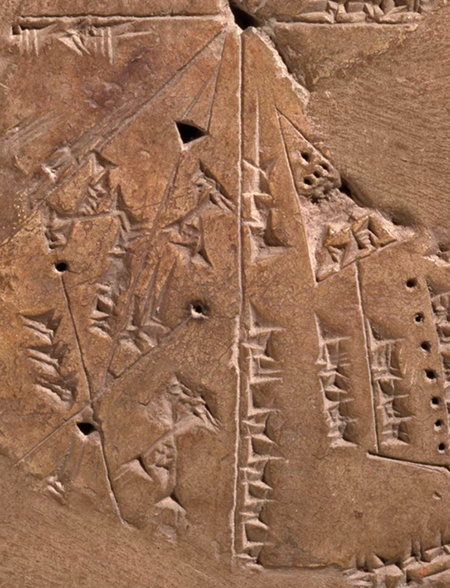
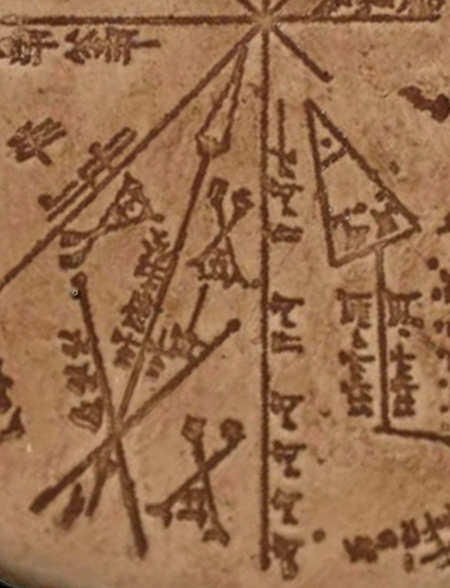
Looking at the fine detail, the sketch or facsmile appears to have changed the actual format of many of the original impressions to symbols.
Photo left: British Museum, www.britishmuseum.org/, © Trustees of the British Museum, Creative Commons Attribution-NonCommercial-ShareAlike 4.0 International (CC BY-NC-SA 4.0) license.
Photo right and above: Sergeyziegler
Permission: Creative Commons Attribution-Share Alike 4.0 International license
Proximal source: Wikimedia commons
Reign of King Ashurbanipal, 669 BC - 631 BC
Protective spirits with raised daggers and maces.
Ashurbanipal was the king of the Neo-Assyrian Empire from 669 BCE to his death in 631. He is generally remembered as the last great king of Assyria. Inheriting the throne as the favoured heir of his father Esarhaddon, Ashurbanipal's 38-year reign was among the longest of any Assyrian king. Though sometimes regarded as the apogee of ancient Assyria, his reign also marked the last time Assyrian armies waged war throughout the ancient Near East and the beginning of the end of Assyrian dominion over the region.
Assyrian, about 645 BC - 635 BC. From Niniveh, North Palace, Room S, door d, panel 1.
These figures are not fighting one another but guarding against evil forces, which may come from any direction. This kind of spirit was known as Ugallu, or 'Great Lion'.
Height 150 cm, width 135 cm, depth 13 cm
Catalog: Gypsum alabaster, Niniveh, North Palace, Room S, door d, panel 1, BM/Big number 118911
Photo: Don Hitchcock 2015
Source: Original, British Museum
Text: Card with the display at the British Museum, http://www.britishmuseum.org/, © Trustees of the British Museum, CC BY-NC-SA 4.0
Reign of King Ashurbanipal, 669 BC - 631 BC
Wall panel, relief
Circa 645 BC - 635 BC
Gypsum alabaster wall panel relief in two parts, showing the netting of deer in partly wooded, hilly terrain. A herd of deer hunted from the left discover that a net has been cast across their escape route between two wooded hills. The trappers are not visibly armed, but one on the right is holding an ensnared, exhausted and possibly wounded deer by the antlers.
( The deer is somewhat obscured by the net, but plainly discernible. As always, click on the small image above, the 'thumbnail' on this page, to see the full size image. - Don )
(left) height 71 cm, width 102 cm, (right) height 76 cm, width 66 cm,
A pair with 1856,0909.46.b (BM.124871.c)
Catalog: Gypsum alabaster, Niniveh, North Palace, BM/Big number 124871,a (right), and 124871,c (left). Both are shown in the BM image: BM/Big number 124882
Photo: Don Hitchcock 2015
Source: Original, British Museum
Text: Card with the display at the British Museum, http://www.britishmuseum.org/, © Trustees of the British Museum, CC BY-NC-SA 4.0
Reign of King Ashurbanipal, 669 BC - 631 BC
Wall panel, relief
Circa 645 BC - 635 BC, Niniveh, North Palace, Room S.
This is part of the 'hunting gazelle' wall relief lower register in gypsum alabaster.
Ashurnasirpal II is shown waiting in a pit with a bow to shoot the leading gazelle down. His assistant is holding out two arrows ready, with a quiver. (BM 124872 is written on the panel at the left corner)
Catalog: Gypsum alabaster, part of the group of images shown at BM/Big number 124882, and given the individual BM/Big number 124872
Photo: Don Hitchcock 2015
Source: Original, British Museum, http://www.britishmuseum.org/, © Trustees of the British Museum, CC BY-NC-SA 4.0
Text: Card with the display at the British Museum, http://www.britishmuseum.org/, © Trustees of the British Museum, CC BY-NC-SA 4.0
Reign of King Ashurbanipal, 669 BC - 631 BC
Wall panel, relief
Circa 645 BC - 635 BC, Niniveh, North Palace, Room S, panels 13-16, bottom row.
This is part of the 'hunting gazelle' wall relief in gypsum alabaster.
Gypsum wall panel relief showing the hunting of gazelle. A herd of gazelle is disturbed by huntsmen. One looks around (centre panel, BM 124874), tries to escape, and is led into ambush (leftmost panel, BM 124873). King Ashurnasirpal is waiting in a hide, ready to shoot the leader down, one corner of this panel (shown in its entirety in the entry above) may be seen on the left.
( It is important to realise that these wall reliefs tell a story.
They are not a moment in time, but can easily represent a whole day or a whole month.
In the leftmost full panel here, BM 124873, we can see two arrows sent by King Ashurnasirpal flying towards the gazelle, one of these misses, and the panel records the moment that the gazelle is hit by a third arrow (or perhaps the one shown in flight at the left). The stories can be told from either left to right or right to left. On the right panel, BM 124874, we can see the start of the gazelle hunt, with gazelles feeding, looking after their young, and one gazelle turning its head in alarm to see the approaching hunter - Don )
Catalog: Gypsum alabaster, part of the group of images shown at BM/Big number 124882, and given the individual BM/Big numbers 124873, 124874
Photo: Don Hitchcock 2015
Source: Original, British Museum, http://www.britishmuseum.org/, © Trustees of the British Museum, CC BY-NC-SA 4.0
Text: Card with the display at the British Museum, http://www.britishmuseum.org/, © Trustees of the British Museum, CC BY-NC-SA 4.0
Reign of King Ashurbanipal, 669 BC - 631 BC
Close up of mounted soldiers
Circa 645 BC - 635 BC, Niniveh, North Palace, Room S.
These spearmen taking part in the lion hunt are shown riding with just a leather saddle cloth, and thus no stirrups. Although each horse is fitted with reins, bridle, and bit, the riders are controlling the horses by their posture, and possibly in this case by their left hand touching the horse's head. Riding without reins or stirrups is still used today to improve communication between horse and rider, and to develop the skills of the rider.
However, stirrups give horseback riders stability, and their development by the Jin dynasty of China, circa 266 AD – 316 AD, revolutionised the way wars were fought. The balance provided by stirrups allows the mounted soldier to move faster, and to strike with more deadly force.
Catalog: Gypsum alabaster, 124874
Photo: Don Hitchcock 2015
Source: Original, British Museum, http://www.britishmuseum.org/, © Trustees of the British Museum, CC BY-NC-SA 4.0
Text: Don Hitchcock
Reign of King Ashurbanipal, 669 BC - 631 BC
Wall panel, relief
Circa 645 BC - 635 BC, Niniveh, North Palace, Room S.
Gypsum wall panel relief. In the middle row is a lion hunt on horseback; Ashurbanipal drives a spear into one lion's mouth (BM 124875) but another, which has been hit by arrows and left for dead, leaps up to maul the king's spare horse; attendants gallop to the rescue from the left (BM 124874).
On the top row, the king shoots an arrow (BM 124876), hitting a previously released lion in the head (BM 124877), and then on the left dispatches it with a sword (BM 124875).
For over a millennium before these reliefs, it seems that the killing of lions was reserved in Mesopotamia for royalty, and kings were often shown in art doing so. There may have been a religious dimension to the activity. A surviving letter on a clay tablet records that when a lion entered a house in the provinces, it had to be trapped and taken by boat to the king. The Asiatic lion, today only surviving in a small population in India, is generally smaller than the African variety, and much later records show that their killing at close quarters, as depicted in the reliefs, was not an impossible feat. When the sword is used, it seems likely that, as in relatively recent times, the actual technique was that 'the lion-killer wrapped his left arm in a huge quantity of goats'-hair yarn or tent-cloth' and tempted the lion to attack this, while the sword in the right hand despatched him. This padded defence is never depicted. More often, the king shoots arrows at the lion; if these fail to stop him and he leaps, the huntsmen close beside the king use their spears to dispatch the lion.
Catalog: Gypsum alabaster, part of the group of images shown at BM/Big number 124882, and given the individual BM/Big numbers 124874, 124875, 124876
Photo: Don Hitchcock 2015
Source: Original, British Museum, http://www.britishmuseum.org/, © Trustees of the British Museum, CC BY-NC-SA 4.0
Text: Card with the display at the British Museum, http://www.britishmuseum.org/, © Trustees of the British Museum, CC BY-NC-SA 4.0
Additional text: Wikipedia
Reign of King Ashurbanipal, 669 BC - 631 BC
Circa 645 BC - 635 BC, Niniveh, North Palace, Room S.
Ashurbanipal drives a spear into a lion's mouth, a closeup from the image above of panels 124874, 124875, 124876.
We can see here what is known as the 'Assyrian rosette' on Ashurnasirpal's wrist, and a decorative arm band. Both are long-lived parts of Royal attire, as can be seen on a closeup of a protective spirit on a wall relief carved nearly two hundred years earlier, see the image below.
Catalog: Gypsum alabaster, BM 124875
Photo: Don Hitchcock 2015
Source: Original, British Museum, http://www.britishmuseum.org/, © Trustees of the British Museum, CC BY-NC-SA 4.0
Text: Card with the display at the British Museum, http://www.britishmuseum.org/, © Trustees of the British Museum, CC BY-NC-SA 4.0
Additional text: Wikipedia, Don Hitchcock
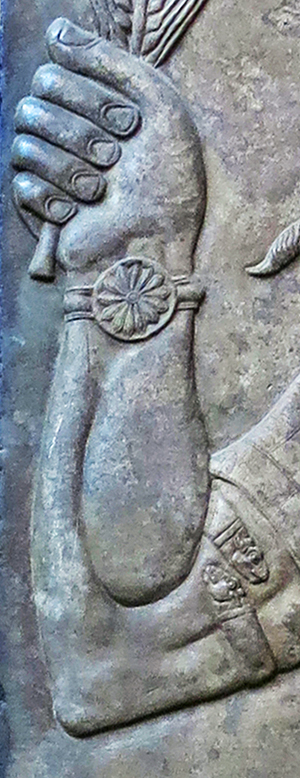
Reign of King Ashurnasirpal II (883-859 BC)
Assyrian rosette and arm band.
This close up is from a gypsum alabaster wall panel depicting a protective spirit in relief.
It shows clearly the Assyrian rosette on his wrist, and his armlets have animal-head terminals. This carving from nearly two hundred years earlier than the image of Ashurbanipal above with similar jewellery demonstrates the longevity of these symbols.
Catalog: Gypsum alabaster, pigmented, Nimrud, BM/Big number 124561
Photo: Don Hitchcock 2015
Source: Original, British Museum
Text: Don Hitchcock
Reign of King Ashurbanipal, 669 BC - 631 BC
Wall panel, relief
Circa 645 BC - 635 BC, Niniveh, North Palace, Room S.
Gypsum wall panel relief, BM 124876, BM 124877, BM 124878. The bottom row shows King Ashurbanipal galloping forward (BM 124876), shooting at wild asses or onagars; one of the horsemen behind him has spare arrows and the other has a spare mount (BM 124875); asses are shot or pulled down by dogs; one is lassoed alive, probably for breeding (BM 124882).
In the next episode of the lion hunt, the king has killed both lions; some attendants admire them and others, on hands and knees in disgrace, probably allowed their horses to lag too far behind the king. The top row shows Ashurbanipal on foot, killing a lion with an arrow. The lion has been released from a cage made of undressed timber by a small person, possibly a child, who has his own cage of sawn timber on top of the lion cage to hide in; the lion advances on the king and is hit by an arrow. The bottom row shows king Ashurbanipal galloping forward, shooting at wild asses (onagers); one of the horsemen behind him has spare arrows and the other has a spare mount ( see BM 124875 above - Don ).
Catalog: Gypsum alabaster, part of the group of images shown at BM/Big number 124882, and given the individual BM/Big numbers 124876, 124877, 124878
Photo: Don Hitchcock 2015
Source: Original, British Museum, http://www.britishmuseum.org/, © Trustees of the British Museum, CC BY-NC-SA 4.0
Text: Card with the display at the British Museum, http://www.britishmuseum.org/, © Trustees of the British Museum, CC BY-NC-SA 4.0
Reign of King Ashurbanipal, 669 BC - 631 BC
A lion is released from its cage
( Here we can see a child who has been given the important but safe job of releasing the lion when called upon to do so. This would be a valuable 'blooding' part of the child's upbringing as either a royal child, or as the child of one of the king's trusted hunters, learning his craft.
At first glance it might seem that the gate lifted up from the guiding channels at the entrance of the cage is too short, but we can imagine a design where the channels end one third the way down the entrance, then there is an opening for the middle third, too small for the lion to exit, and the lower third is covered in, in the same way as the sides.
Thus once the gate is lifted, the opening would be quite deep enough for the lion to step outside to the open air.
This image is a close up of the image above from the panels 124876, 124877, 124878.
- Don )
Catalog: Gypsum alabaster, 124876, 124877, 124878
Photo: Don Hitchcock 2015
Source: Original, British Museum, http://www.britishmuseum.org/, © Trustees of the British Museum, CC BY-NC-SA 4.0
Text: Don Hitchcock
Reign of King Ashurbanipal, 669 BC - 631 BC
Wall panel, relief
Circa 645 BC - 635 BC, Niniveh, North Palace, Room S.
Gypsum wall panel relief, BM 124878, BM 124879, BM 124880, BM 124881, BM 124882.
Three panels are missing their top two registers, but in the top register on the left, King Ashurbanipal fires arrows, with attendants waiting with spare arrows, and, indeed, spare bows.
On the lowest register, dogs continue to harry the asses, and one is lassoed alive, using a doubled rope, probably for breeding (BM 124882).
BM 124882 has all three registers, and the top register shows three servants leading a saddled horse. The middle register shows three soldiers, leading a horse which has an ornate set of decorations and tasselled saddle, ready for the king. These two registers have been described as courtiers watching the lion hunts.
Catalog: Gypsum alabaster, part of the group of images shown at BM/Big number 124882, and given the individual BM/Big numbers 124878, 124879, 124880, 124881, 124882
Photo: Don Hitchcock 2015
Source: Original, British Museum, http://www.britishmuseum.org/, © Trustees of the British Museum, CC BY-NC-SA 4.0
Text: Card with the display at the British Museum, http://www.britishmuseum.org/, © Trustees of the British Museum, CC BY-NC-SA 4.0
Reign of King Ashurbanipal, 669 BC - 631 BC
The King's Horse
Circa 645 BC - 635 BC, Niniveh, North Palace, Room S.
( Horses were vital for transport and war, and the king's horses were pampered pets, ornately 'dressed' when on public display.
Here two archers and a spear carrier stand in front of one of the king's horses, which has costly and beautiful 'tack' in the form of an ornate saddle with tassels, a costly rope possibly of gold, and cockades on its head.
As is still the case with some modern horses shown in dressage competitions, the tail of the horse has been carefully prepared and braided in a complex style.
This image is a close up of the image above from the panel 124882 - Don )
Catalog: Gypsum alabaster, part of the group of images shown at BM/Big number 124882, and given the individual BM/Big numbers 124878, 124879, 124880, 124881, 124882
Photo: Don Hitchcock 2015
Source: Original, British Museum, http://www.britishmuseum.org/, © Trustees of the British Museum, CC BY-NC-SA 4.0
Text: Don Hitchcock
Reign of King Ashurbanipal, 669 BC - 631 BC
Wall panel, relief
Circa 645 BC - 635 BC, Niniveh, North Palace, Room S.
Gypsum wall panel in low relief, described by the BM as being from Panel 4. Circa 645 BC - 635 BC
BM 124885
( So far as I can tell, this catalog number is only for the double fragment at the top of this image. On the right is the still intact BM 124858, and I have not been able to identify the other two fragments, apparently related to BM 124885. However, to my eyes, these four fragments were not originally as physically close to BM 124858 as this arrangement by the curators might suggest - Don )
Royal lion hunt. Fragments showing preparations for the hunt. Armourers string and test the king's bow and arrows. A servant is carrying guards that are to be worn on the king's left forearm and fingers, to protect them when he is shooting.
Another servant collects spears. All the equipment is to be handed up to the king and his attendants in the chariot to the right.
Height 58 cm, width 64 cm. ( These dimensions only make sense when applied to the top left hand rectangular fragment, ignoring the irregular fragment attached to it - Don )
Catalog: Gypsum alabaster, BM 124885
Photo: Don Hitchcock 2015
Source: Original, British Museum, http://www.britishmuseum.org/, © Trustees of the British Museum, CC BY-NC-SA 4.0
Text: Card with the display at the British Museum, http://www.britishmuseum.org/, © Trustees of the British Museum, CC BY-NC-SA 4.0
Reign of King Ashurbanipal, 669 BC - 631 BC
Wall panel, relief
Gypsum wall panel in low relief. Circa 645 BC - 635 BC, Niniveh, North Palace, Room E, panel 5.
Gypsum wall panel relief depicting a harpist and lyre player, one a woman wearing a fillet of great beads, the other a youth(?), wearing a feather headdress, with a tame lion beneath palms and cypresses.
Height 168 cm.
Curator's comment:
Moortgat, 'Die Kunst des Alten Mesopotamien' p.106, makes the interesting suggestion that this scene represents the power that music exerts over wild beasts, a kind of Orpheus motif, which is also to be seen on an unfinished 'kudurru' from Susa, and that it may be of Iranian inspiration. It is, however, found on pottery from Palestine (Loud, 'Megiddo' II, pl.76) and on a seal from North Syria (Rimmer, 'Ancient musical instruments of Western Asia in the Department of Western Asiatic Antiquities, the British Museum', fig.6 and pl.VIIIa). Part of BM 127370.
Catalog: Gypsum alabaster, BM 118916
Photo: Don Hitchcock 2015
Source: Original, British Museum, http://www.britishmuseum.org/, © Trustees of the British Museum, CC BY-NC-SA 4.0
Text: Card with the display at the British Museum, http://www.britishmuseum.org/, © Trustees of the British Museum, CC BY-NC-SA 4.0
Reign of King Ashurbanipal, 669 BC - 631 BC
Wall panel, relief
Circa 645 BC - 635 BC, Niniveh, North Palace, Room S.
Gypsum wall panel in low relief, circa 645 BC - 635 BC. This is described by the BM as being Panels 5, 6, and 7, with the two wooded knoll panels being 8 and 9.
(from left) Grooms lead horses towards a screened enclosure, within which the royal chariot is being prepared for the hunt. King Ashurbanipal is handed a bow.
Men are struggling to push one of the horses into position while another horse is having his harness tightened. King Ashurbanipal is already in the chariot, and reaches back to receive a bow which is being handed up to him. Soldiers protecting the arena are ready for duty.
Dimensions:
Leftmost panel, 124858:
Height 160 cm, width 127 cm.
Second panel, 124859
Height 157 cm, width 127 cm.
Third panel, 124860
Height 155 cm, width 122 cm.
Fourth panel, 124861:
Height 155 cm, width 114 cm.
Curator's comments: See also 1856,0909.15 (BM.124850) In set with BM.124859-124870 (all 1856,0909.16).
Catalog: Gypsum alabaster, 124858, 124859, 124860, 124861
Photo: Don Hitchcock 2015
Source: Original, British Museum, http://www.britishmuseum.org/, © Trustees of the British Museum, CC BY-NC-SA 4.0
Text: Card with the display at the British Museum, http://www.britishmuseum.org/, © Trustees of the British Museum, CC BY-NC-SA 4.0
Reign of King Ashurbanipal, 669 BC - 631 BC
Close up of preparing the horses and chariot
Circa 645 BC - 635 BC, Niniveh, North Palace, Room S.
Men are struggling to push one of the horses into position while another horse is having his harness tightened. King Ashurbanipal is already in the chariot, and reaches back to receive a bow which is being handed up to him. The horses have decorative loops braided into the ends of their tails. One of the reins to the rear horse has been shortened with a knot similar to the modern 'alpine butterfly loop'.
King Ashurbanipal's face has been intentionally disfigured, like that of Sennacherib on his monuments, probably when the united armies of the Medes and Babylonians destroyed the palace.
The wooden wheels of the chariot are superbly made. Eight spoke wheels began to be used from the period of Tiglat-Pileser (745-727 BC) to the period of Ashurbanipal (669-631 BC).
Thus, the endurance of the chariots when coping with high speeds on the battlefield, and their durability under conditions of rough terrain had increased. In addition, the outer surface of the wooden circle in contact with the ground was often covered with an iron protective ring. This particular example uses strengthening quadrilateral wooden inserts to the ring of the wheel, as well as the by then standard eight spokes. Also, there appear to be iron rivets installed on the outer surface of the wheel, rather than the use of the superior method, an iron ring.
Catalog: Gypsum alabaster, 124858, 124859
Photo: Don Hitchcock 2015
Source: Original, British Museum, http://www.britishmuseum.org/, © Trustees of the British Museum, CC BY-NC-SA 4.0
Text: Card with the display at the British Museum, http://www.britishmuseum.org/, © Trustees of the British Museum, CC BY-NC-SA 4.0
Additional text: Don Hitchcock, arkeonews.net/chariots-in-neo-assyrian-army/
Reign of King Ashurbanipal, 669 BC - 631 BC
Wall panel, relief
Circa 645 BC - 635 BC, Niniveh, North Palace, Room S.
Gypsum wall panel in low relief, circa 645 BC - 635 BC
On the left, Assyrians rush up a wooded knoll, either in fright or to get a better view of the lion hunt. The hill is crowned by a building, or stela, through which we can see another picture of the royal lion hunt; further to the right is a scene where lions are hit by the king's arrows, collapse and die. There are keepers with dogs stationed on the edge of the arena to deter lions from escaping. Behind them, on the left, beside the wooded knoll, a row of soldiers with high shields are ready to stop any lion who tries to break free.
The wooded knoll is decribed by the BM as being made up of Panels 8 and 9.
Dimensions:
Leftmost panel, 124861:
Height 155 cm, width 114 cm.
Second panel, 124862
Height 152 cm, width 119 cm.
Third panel, 124863
Height 155 cm, width 119 cm.
Fourth panel, 124864
Height 158 cm, width 127 cm.
Fifth panel, 124865
Height 158 cm, width 119 cm.
Curator's comments: See also 1856,0909.15 (BM.124850) In set with BM.124859-124870 (all 1856,0909.16).
Catalog: Gypsum alabaster, 124861, 124862, 124863, 124864, 124865
Photo: Don Hitchcock 2015
Source: Original, British Museum, http://www.britishmuseum.org/, © Trustees of the British Museum, CC BY-NC-SA 4.0
Text: Card with the display at the British Museum, http://www.britishmuseum.org/, © Trustees of the British Museum, CC BY-NC-SA 4.0
Reign of King Ashurbanipal, 669 BC - 631 BC
Close up of a wounded lion
Circa 645 BC - 635 BC, Niniveh, North Palace, Room S.
This image shows a lion grievously wounded with four arrows, one of which has come from beneath as the lion attempted to attack the king's chariot.
Close up of the image immediately above.
Catalog: Gypsum alabaster, 124863, 124864
Photo: Don Hitchcock 2015
Source: Original, British Museum, http://www.britishmuseum.org/, © Trustees of the British Museum, CC BY-NC-SA 4.0
Text: Don Hitchcock
Reign of King Ashurbanipal, 669 BC - 631 BC
Wall panel, relief
Circa 645 BC - 635 BC, Niniveh, North Palace, Room S.
Gypsum wall panel in low relief, circa 645 BC - 635 BC
A lion hunt is depicted. The king shown in high, distinctive hat races around the arena in his chariot. He shoots arrows at a succession of lions; one arrow in mid-air follows a wounded lion. Meanwhile, attendants with spears, in the king's chariot, ward off another wounded lion, attacking from behind.
Dimensions:
Leftmost panel, 124865
Height 158 cm, width 119 cm.
Second panel, 124866
Height 160 cm, width 231 cm.
Third panel, 124867
Height 163 cm, width 114 cm.
Fourth panel, 124868
Height 163 cm, width 173 cm.
Curator's comments: See also 1856,0909.15 (BM.124850) In set with BM.124859-124870 (all 1856,0909.16).
Catalog: Gypsum alabaster, 124865, 124866, 124867, 124868
Photo: Don Hitchcock 2015
Source: Original, British Museum, http://www.britishmuseum.org/, © Trustees of the British Museum, CC BY-NC-SA 4.0
Text: Card with the display at the British Museum, http://www.britishmuseum.org/, © Trustees of the British Museum, CC BY-NC-SA 4.0
Reign of King Ashurbanipal, 669 BC - 631 BC
Wall panel, relief
Circa 645 BC - 635 BC, Niniveh, North Palace, Room S.
This is a closeup of the image above, in which we may see Ashurbanipal loosing an arrow at a distant lion, while another attempts to mount his chariot, but is fended off by attendants with spears.
Gypsum wall panel in low relief, circa 645 BC - 635 BC
Catalog: Gypsum alabaster, 124866, 124867, 124868
Photo: Don Hitchcock 2015
Source: Original, British Museum, http://www.britishmuseum.org/, © Trustees of the British Museum, CC BY-NC-SA 4.0
Text: Card with the display at the British Museum, http://www.britishmuseum.org/, © Trustees of the British Museum, CC BY-NC-SA 4.0
Reign of King Ashurbanipal, 669 BC - 631 BC
Wall panel, relief
Circa 645 BC - 635 BC, Niniveh, North Palace, Room S.
Gypsum wall panel in low relief, circa 645 BC - 635 BC
A lion is released from its cage by a small person or child, who has his own small cage on top of the lion cage. Horsemen prepare to drive or lure a lion towards Ashurbanipal's chariot. On the right a line of soldiers with high shields rings the arena make sure that the lions do not escape.
Dimensions:
Leftmost panel, 124869
Height 165cm, width 122 cm.
Second panel, 124870
Height 165 cm, width 91 cm.
Curator's comments: See also 1856,0909.15 (BM.124850) In set with BM.124859-124870 (all 1856,0909.16).
Catalog: Gypsum alabaster, 124869, 124870
Photo: Don Hitchcock 2015
Source: Original, British Museum, http://www.britishmuseum.org/, © Trustees of the British Museum, CC BY-NC-SA 4.0
Text: Card with the display at the British Museum, http://www.britishmuseum.org/, © Trustees of the British Museum, CC BY-NC-SA 4.0
Reign of King Ashurbanipal, 669 BC - 631 BC
Wall panel, relief
Circa 645 BC - 635 BC, Niniveh, North Palace, Room S.
This shows the superb display of the panels above in the British Museum.
Photo: Don Hitchcock 2015
Source: Original, British Museum, http://www.britishmuseum.org/, © Trustees of the British Museum, CC BY-NC-SA 4.0
Text: Card with the display at the British Museum, http://www.britishmuseum.org/, © Trustees of the British Museum, CC BY-NC-SA 4.0
Reign of King Ashurbanipal, 669 BC - 631 BC
Lion Hunt, wall panel, relief
Circa 645 BC - 635 BC, Niniveh, North Palace.
Gypsum wall panel in low relief, circa 645 BC - 635 BC
(Leftmost panel, BM 124850)
(Second panel, BM 124851)
Ashurbanipal with pointed hat, races through the arena in his chariot. A lion he has shot pursues the chariot and jumps up at the back. Two attendants hold it back with spears while the king draws a sword to kill it.
(Third panel, BM 124852)
In front, another lion has just received its first arrow in the face, and stands on its hind legs, with both front legs spread in the air in agony. One lion lies dead on the upper part of the panel.
(Fourth panel, BM 124853)
The two horses of the king's chariot jump over a dead lion, controlled by an assistant to the king.
Curator's comments:
In set with BM.124904-124915 (all 1856,0909.14)
In set with BM.124851-124857 (all 1856,0909.15)
Dimensions:
Leftmost panel, 124850
Height 160 cm, width 170 cm.
Second panel, 124851
Height 160 cm, width 163 cm.
Third panel, 124852
Height 160 cm, width 109 cm.
Fourth panel, 124853
Height 160 cm, width 114 cm.
Catalog: Gypsum alabaster, 124850, 124851, 124852, 124853
Photo: Don Hitchcock 2015
Source: Original, British Museum, http://www.britishmuseum.org/, © Trustees of the British Museum, CC BY-NC-SA 4.0
Text: Card with the display at the British Museum, http://www.britishmuseum.org/, © Trustees of the British Museum, CC BY-NC-SA 4.0
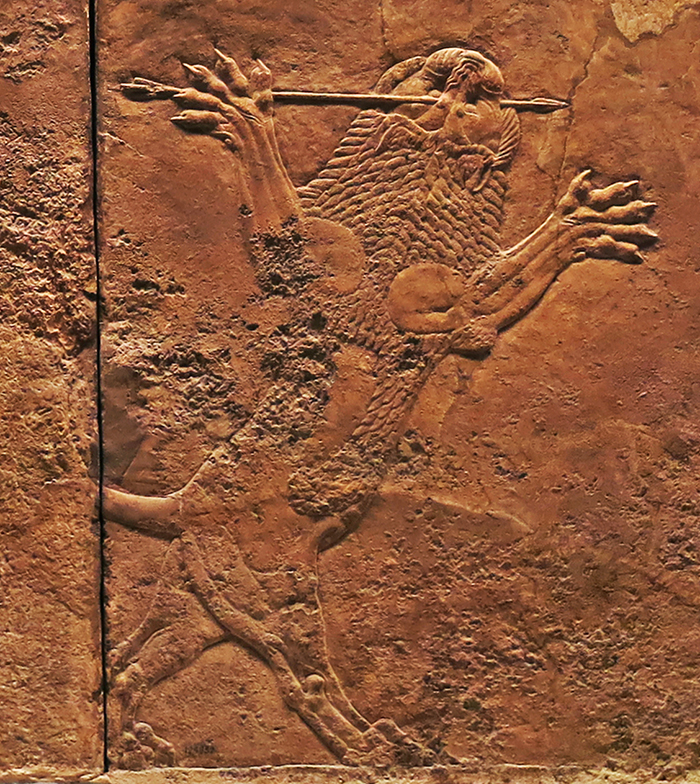
Reign of King Ashurbanipal, 669 BC - 631 BC
Close up of a wounded lion
The lions caught up in the lion hunt were subject to horrific injuries.
Catalog: Gypsum alabaster, 124851, 124852
Photo: Don Hitchcock 2015
Source: Original, British Museum, http://www.britishmuseum.org/, © Trustees of the British Museum, CC BY-NC-SA 4.0
Text: Don Hitchcock
Reign of King Ashurbanipal, 669 BC - 631 BC
Lion Hunt, wall panel, relief
Gypsum wall panel in low relief, circa 645 BC - 635 BC, Niniveh, North Palace, Room C.
(Leftmost panel, BM 124853)
The two horses of the king's chariot jump over a dead lion, controlled by an assistant to the king.
(Second panel, BM 124854)
The king has grabbed a spear from an attendant and drives it into a wounded lion that is biting the wheel of the chariot. One attendant holds the royal bow, while another holds a spear ready.
( Marked WA 124852-5 on the museum card, but the BM catalog online only recognises the numbers 124852, 124853, 124854, 124855 as individual searches, as just the number, and without the WA prefix - Don )
(Third, fourth, and fifth panels, BM 124855, BM 124856, BM 124857)
Lions are released from cages into the arena, one by one, and men on horses drive or lure them to the king's chariot; the king shoots them; death agonies are realistically shown. Some tails were originally carved too long and have been shortened.
At BM 124856, upper register, a lioness is shown in her death throes, struck by three arrows, one of which has caused her to lose strength in her rear legs. This superb though horrifying image is deservedly famous for its artistry, and is often reproduced.
Curator's comments:
In set with BM.124904-124915 (all 1856,0909.14)
In set with BM.124851-124857 (all 1856,0909.15)
Dimensions:
Leftmost panel, 124853
Height 160 cm, width 114 cm.
Second panel, 124854
Height 160 cm, width 124 cm.
Third panel, 124855
Height 160 cm, width 132 cm.
Fourth panel, 124856
Height 160 cm, width 124cm.
Fifth panel, 124857
Height 160 cm, width 163 cm.
Catalog: Gypsum alabaster, 124853, 124854, 124855, 124856, 124857
Photo: Don Hitchcock 2015
Source: Original, British Museum, http://www.britishmuseum.org/, © Trustees of the British Museum, CC BY-NC-SA 4.0
Text: Card with the display at the British Museum, http://www.britishmuseum.org/, © Trustees of the British Museum, CC BY-NC-SA 4.0
Reign of King Ashurbanipal, 669 BC - 631 BC
Wounded Lioness
At BM 124856, upper register, a lioness is shown in her death throes, struck by three arrows, one of which has caused her to lose strength in her rear legs. This superb though horrifying image is deservedly famous for its artistry, and is often reproduced.
Catalog: Gypsum alabaster, 124856
Photo: Don Hitchcock 2015
Source: Original, British Museum, http://www.britishmuseum.org/, © Trustees of the British Museum, CC BY-NC-SA 4.0
Text: Don Hitchcock
Reign of King Ashurbanipal, 669 BC - 631 BC
Lion Hunt, wall panel, relief
Gypsum wall panel in low relief, circa 645 BC - 635 BC, Niniveh, North Palace, Room C.
(Leftmost panel, BM 124857)
Lions are released from cages into the arena, one by one, and men on horses drive or lure them to the king's chariot.
(lower left fragment, BM 124883)
Part of a lion cage, with an enraged penned lion inside.
(Upper middle fragment, BM unknown)
Parts of four servants are visible, carrying a dead lion on their shoulders, with the two left hands shown at the spine of the lion belonging to the two rearmost men.
(lower right fragment, BM 124921 )
Gypsum wall panel relief: fragment of lowest register showing six servants carrying a dead lion. Unfinished at the right because of the corner which originally abutted it. Nothing certain is known about the position of this piece. It may have been a sculptor's trial piece.
Curator's comments:
In set with BM.124904-124915 (all 1856,0909.14)
In set with BM.124851-124857 (all 1856,0909.15)
Dimensions:
Leftmost panel, 124857
Height 160 cm, width 163 cm.
Lower right fragment, BM 124921
Height 53 cm, width 71 cm.
Lower left fragment, BM 124883
Height 64 cm, width 69 cm
Catalog: Gypsum alabaster, 124857, 124921, 124883
Photo: Don Hitchcock 2015
Source: Original, British Museum, http://www.britishmuseum.org/, © Trustees of the British Museum, CC BY-NC-SA 4.0
Text: Card with the display at the British Museum, http://www.britishmuseum.org/, © Trustees of the British Museum, CC BY-NC-SA 4.0
Reign of King Ashurbanipal, 669 BC - 631 BC
Huntsmen with hounds, relief
Huntsmen with hounds in a garden from Nineveh, North Palace, Room E, panel 13.
Circa 645 BC - 635 BC.
Catalog: Gypsum alabaster, 118915
Photo: Don Hitchcock 2015
Source: Original, British Museum, http://www.britishmuseum.org/, © Trustees of the British Museum, CC BY-NC-SA 4.0
Text: Card with the display at the British Museum, http://www.britishmuseum.org/, © Trustees of the British Museum, CC BY-NC-SA 4.0
King Ashur-etil-ilani
Reign of King Ashur-etil-ilani , 630 BC - 623 BC
Brick.
Fired clay brick; Ashur-etel-ilani; cuneiform inscription on face in seven lines.
Length: 33 cm, thickness 9 cm, width 32 cm.
The spread of inscriptions by Ashur-etil-ilani in Babylonia suggest that he exercised the same amount of control in the southern provinces as his father Ashurbanipal had, having a vassal king (Kandalanu) but exercising actual political and military power there himself. His inscriptions are known from all the major cities, including Babylon, Dilbat, Sippar and Nippur. Too few inscriptions of Ashur-etil-ilani survive to make any certain assumptions about his character.
Excavations of his palace at Kalhu, one of the more important cities in the empire and a former capital, may indicate that he was less boastful than his father as it had no reliefs or statues similar to those that his predecessors had used to illustrate their strength and success. There are no records of Aššur-etil-ilāni ever conducting a military campaign or going on a hunt. His Kalhu palace was quite small with unusually small rooms by Assyrian royal standards.
Catalog: Ceramic, 90188
Photo: Original, British Museum, http://www.britishmuseum.org/, © Trustees of the British Museum, CC BY-NC-SA 4.0
Text: Card with the display at the British Museum, http://www.britishmuseum.org/, © Trustees of the British Museum, CC BY-NC-SA 4.0
King Sin-shar-ishkun
Reign of King Sin-shar-ishkun, 622 BC - 612 BC
Cuneiform tablet: letter of Sin-sharra-ishkun to Nabopolassar
This tablet is a later copy of a letter from the last days of the Assyrian empire. In it, the last Assyrian king, Sin-sharra-ishkun, appears to reach out to the Babylonian king Nabopolassar, recognising the latter's rule and pleading to retain his own kingdom.
The letter represents a great reversal in fortunes: despite frequent rebellions, Babylonia had for centuries been held under Assyrian rule, and at the beginning of his reign Sin-shar-ishkun himself seems to have had some success in suppressing a rebellion there. By the time this letter was written the tide had turned, and, incredibly, Sin-sharra-ishkun repeatedly addresses Nabopolassar as 'the king my lord.'
We do not have the Babylonian king’s answer in the form of a letter, but he must have rejected its terms: over the following years a coalition led by Babylonia and Media, a state in western Iran, destroyed the Assyrian capitals, and Nabopolassar, ruling from Babylon, came to inherit most of Assyria’s former empire. This letter may have been a response to another surviving piece of correspondence, in which Nabopolassar threatens (or perhaps declares) war, and a desperate attempt by Sin-sharra-ishkun to persuade Nabopolassar to switch allegiances, abandoning his alliance with Media for one with Assyria.
The tablet itself is a copy dating to the second century B.C., but the original letter was written over four-hundred years earlier in the late seventh century B.C.; its preservation and copying show that it must have been regarded as historically important even in antiquity.
The tablet is not complete and is made up of the following fragments in the Metropolitan's collection: 86.11.370a, c-e and 86.11.383c-e.
Dimensions: 10 × 15.3 × 3.6 cm
Seleucid Period, ca. 2nd century BCE
Catalog: Clay, Mesopotamia, probably from Babylon (modern Hillah), Seleucid Period, 2nd Century BC, 86.11.370a, c–e
Photo and text: metmuseum.org
Permission: Public Domain
Reign of Sin-shar-ishkun, 622 BC - 612 BC
The Fall of Nineveh, 612 BC
Probably John Martin's Large Mezzotint 1829-30 colored by hand. The painting was in Cairo in property of the last Pharaoh Faruk and disappeared after the riots in 1952.
On taking the throne in 622 BC, Sin-shar-ishkun was immediately faced by the revolt of one of his brother's chief generals, who attempted unsuccessfully to usurp the throne for himself. This failed attempt on the throne contributed to instability, and Sin-shar-ishkun lost control of Babylonia to Nabopolassar, who consolidated his power and formed the Neo-Babylonian Empire, restoring Babylonian independence after more than a century of Assyrian rule. This Neo-Babylonian Empire, and the newly formed Median Empire under Cyaxares, then invaded the Assyrian heartland.
In 614 BC, the Medes captured and sacked Assur, the ceremonial and religious heart of the Assyrian Empire, and in 612 BC their combined armies attacked, brutally sacked, and razed Nineveh, the Assyrian capital.
What doomed Assyria might have been the lack of an effective defensive plan for the Assyrian heartland, which had not been invaded in five hundred years, combined with having to face an enemy which aimed to outright destroy Assyria rather than simply conquer it.
Artist: John Martin, 1829
Photo: むーたんじょ
Permission: Creative Commons Attribution-Share Alike 4.0 International license.
Proximal source and text: Wikipedia
Ashur-uballit II
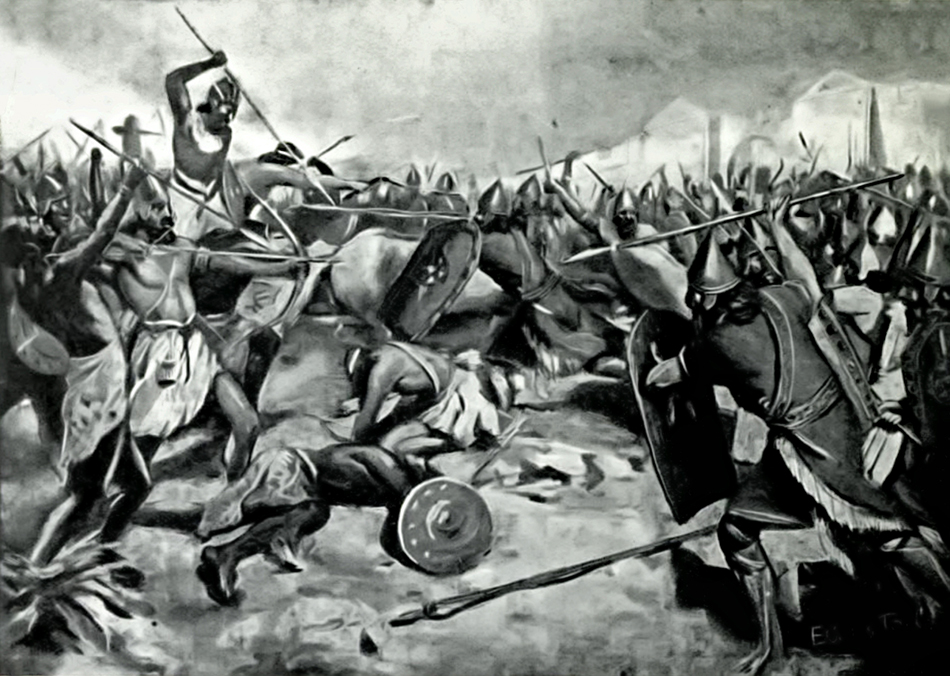
Reign of King Ashur-uballit II, 612 BC - 609 BC
Ashur-uballit II was the final ruler of Assyria, ruling from his predecessor Sin-shar-ishkun's death at the Fall of Nineveh in 612 BC to his own defeat at Harran in 609 BC. He was possibly the son of Sin-shar-ishkun and likely the same person as a crown prince mentioned in inscriptions at the Assyrian capital of Nineveh in 626 and 623 BC. Over the course of Sin-shar-ishkun's reign, the Neo-Assyrian Empire had been irreversibly weakened. However, Ashur-uballit rallied what remained of the Assyrian army at Harran where, bolstered by an alliance with Egypt, he ruled for three years. His identification as 'king of Assyria' comes from Babylonian sources. Contemporary Assyrian inscriptions suggest that the Assyrians saw Ashur-uballit as their legitimate ruler, but continued to refer to him as 'crown prince' seeing as he could not undergo the traditional Assyrian coronation ceremony at Assur and thus hadn't formally been bestowed with the kingship by the Assyrian chief deity, Ashur. His rule at Harran came to an end when the city was seized by Medo-Babylonian forces in 610 BC. Ashur-uballit's attempt at retaking it in 609 BC was repulsed whereafter he is no longer mentioned in contemporary chronicles, signalling the end of the ancient Assyrian monarchy.
Photo of the Battle of Carchemish, 605 BC, above, from Hutchinson (1915)
Permission: Public Domain
The End of the Assyrian Empire
The Battle of Carchemish 605 BC
Battle of Carchemish was fought about 605 BC between the armies of Egypt allied with the remnants of the army of the former Assyrian Empire against the armies of Babylonia, allied with the Medes, Persians, and Scythians. This was while Nebuchadnezzar was commander-in-chief and Nabopolassar was still king of Babylon. Nebuchadnezzar became king right after this battle.
The dominant event in world politics at the time we are concerned with is the disappearance of Assyria.
Thus our first task must be to ascertain in which year it was that the last Assyrian king, Ashur-uballit II, finally succumbed to the relentless onslaught of the Medes and Babylonians. What we do know is that Ashur-uballit was still in the field in 608, whereas three years later, at the time of the Battle of Carchemish, Assyria was no more. In 610 Ashur-uballit had to evacuate his capital Harran, and in 609 his attempt to retake it had failed disastrously, although he was reinforced by a strong contingent of Egyptian troops.
The text is rather badly damaged at this point, but it seems that after the Battle of Harran the territories still under the control of Ashur-uballit were extensively ravaged by the Babylonians. The Babylonian king resumed the campaign at the very beginning of the year 608/7, but, unfortunately, with the statement to that effect the tablet comes to an end. Nevertheless, this much is clear, that after the disastrous events of 609 the position of Ashur-uballit must have been to such an extent critical that it would be somewhat surprising if he survived the campaign of 608.
It so happens that a further argument can be adduced to render the date 608 for the downfall of Ashur-uballit, if not certain, at least very probable. We know that after the failure of the Assyro-Egyptian army to retake Harran in the preceding year, the Egyptian pharaoh, Necho II, resolved on a supreme effort and in 608 led an army in person to the rescue of his ally, Ashur-uballit II. But although this expedition is mentioned in several sources, nowhere is it said that it culminated in a battle between the Egyptians and the Assyrians on one side, the Medes and the Babylonians on the other.
Since this would have been a struggle between the four greatest military powers of the day, it would indeed be surprising that no mention of it had survived. There is some reason to believe that Necho may never have reached the Euphrates.
Text: Jeremia and the death of Josiah, by M. B. Rowton, https://www.journals.uchicago.edu/doi/epdf/10.1086/371028
Assyrians after Assyria
In 612 BC, after a prolonged civil war, Assyria's two former vassals, the Babylonians and the Medes, conquered and destroyed Nineveh, the capital of the Neo-Assyrian Empire. The great city went up in flames, never to regain its former status. Three years later the same rebels razed Assyria's Western metropolis, Harran, crushing the last-ditch resistance of Assyria's last king,Ashur-uballit II. This event sealed the fate of the Assyrian Empire, and that is where the story of Assyria usually ends in history books.Text above:
What happened to the Assyrians after the fall of Assyria? This is a question that is not easy to answer for two reasons. Firstly, the issue has hardly been touched by Assyriologists. Most of them seem to tacitly agree with the idea of a more or less total wipe-out, as suggested by Sidney Smith in 1925: 'The disappearance of the Assyrian people will always remain a unique and striking phenomenon in ancient history. Other, similar kingdoms and empires have indeed passed away but the people have lived on... No other land seems to have been sacked and pillaged so completely as was Assyria.'
Secondly, in contrast to the abundance of information from the imperial period, information on post-empire Assyria and Assyrians is scanty and scattered. The near-total lack of information from Assyria itself would seem to support the idea of a genocide, which also seems to be supported by ancient eye-witness testimonies. When the Greek historian Xenophon 200 years after Nineveh's fall passed through the Assyrian heartland and visited the sites of two great Assyrian cities, he found nothing but ruin and could not retrieve much about them from the nearby villagers. The territory where these deserted cities lay was now Median, and the Greeks assumed that their former inhabitants had likewise been Medes.
Yet it is clear that no such thing as a wholesale massacre of all Assyrians ever happened. It is true that some of the great cities of Assyria were utterly destroyed and looted - archaeology confirms this - some deportations were certainly carried out, and a good part of the Assyrian aristocracy was probably massacred by the conquerors. However, Assyria was a vast and densely populated country, and outside the few destroyed urban centres life went on as usual.
This is proved by a recently discovered post-imperial archive from the Assyrian provincial capital Dur-Katlimmu, on the Chabur river, which contains business documents drawn up in Assyrian cuneiform more than a decade after the fall of Nineveh. Apart from the fact that these documents are dated by the regal years of a Babylonian king, Nebuchadnezzar II, nothing in their formulation or external appearance would suggest that they were not written under the Assyrian Empire. Another small archive discovered in Assur, written in a previously unknown, presumably Mannean variety of cuneiform, proves that Assyrian goldsmiths still worked in the city in post-empire times, though now under Median command.
Moreover, over a hundred Assyrians with distinctively Assyrian names have recently been identified in economic documents from many Babylonian sites dated between 625 and 404 BC, and many more Assyrians undoubtedly remain to be identified in such documents. We do not know whether these people were deportees or immigrants from Assyria; their families may have settled in Babylonia already under the Assyrian rule. In any case, they unequivocally prove the survival of many Assyrians after the empire and the continuity of Assyrian identity, religion and culture in post-empire times. Many of these names contain the divine name Ashur, and some of the individuals concerned occupied quite high positions: one Pan-Ashur-lumur was the secretary of the crown prince Cambyses under Cyrus II in 530 BC.
Dr. Simo Parpola, University of Helsinki
The Neo-Assyrian Text Corpus Project (State Archives of Assyria)
Presented at The Assyrian National Convention in Los Angeles, September 4, 1999
Published in the Journal of Assyrian Academic Studies, Vol. XIII No. 2, 1999
References
- Belser C., 1894: 'Babylonische Kudurru-Inschriften', in F. Delitzsch, Paul Haupt (ed.). Beiträge zur Assyriologie, II., J. C. Hinrichs. pp. 187–203. “Grenzstein” no. 103
- Braun & Schneider, circa 1861 and 1880: The History of Costume, Zur Geschichte der Kostüme, München.
-
Damen M., 2006: The Neo-Assyrians, Three lectures,
www.usu.edu/markdamen/ane/lectures/8.1.pdf,
www.usu.edu/markdamen/ane/lectures/8.2.pdf,
www.usu.edu/markdamen/ane/lectures/8.3.pdf
( These lectures are a valuable introduction to Neo-Assyrian history, and are highly recommended - Don ) - Garfinkel Y., Carroll J., Pytlik M., Mumcuoglu M., 2021: Constructing the Assyrian siege ramp at Lachish: Texts, Iconography, Archaeology and Photogrammetry, Oxford Journal of Archaeology (9999), 2021
- Hutchinson, 1915: Hutchinson's Story of the Nations , London, Hutchinson & Co.
- King L., 1915: Bronze reliefs from the gates of Shalmaneser, King of Assyria, B.C. 860-825, 80 plates, London.
- Layard A., 1849: The Monuments of Nineveh from drawings made on the spot, 100 plates, London.
- Layard A., 1853: A second series of the Monuments of Nineveh including bas-reliefs from the Palace of Sennacherib and Bronzes from the ruins of Nimroud, 71 plates, London.
- Sanders D., 2015: Advances in Virtual Heritage – Conditions and Caveats, ResearchGate, Conference Paper, October 2015, DOI: 10.1109/DigitalHeritage.2015.7419588
- Seifert J., Lemke F., 2019: the Sumerian K8538 Tablet, the great meteor impact devastating Mesopotamia - a 2019 Translation Addendum, ResearchGate, February 2019.
- Thompson R., 1929: The Excavations on the Temple of Nabû at Nineveh, Archaeologia 77, pp. 103-148.
- Ussishkin D., 2004: The Renewed Archaeological Excavations at Lachish (1973–1994), Tel Aviv
Back to Don's Maps
 Back to Archaeological Sites
Back to Archaeological Sites
